 |
||
|
HOME
|
US Navy -
ships
|
US Navy - air
units
|
USMC - air
units
|
International
Navies
|
Weapon Systems
|
Special Reports |
||
|
US Navy - Aircraft Carrier CVN 69 - USS Dwight D. Eisenhower |
||
|
||
| 04/25 | ||
|
Type, class: Aircraft
Carrier - CVN; Nimitz class Builder: Newport News Shipbuilding, Newport News, Virginia, USA STATUS: Awarded: June 30, 1970 Laid down: August 15, 1970 Launched: October 11, 1975 Commissioned: October 18, 1977 IN SERVICE Homeport: Naval Station Norfolk, Virginia Namesake: Dwight D. Eisenhower (1890-1969), 34th President of the USA Ships Motto: GREATER EACH DAY Technical Data: see: INFO > Nimitz class Aircraft Carrier - CVN |
||
|
Deployments / Carrier Air Wings embarked / major maintenance periods: November 1977 - December 1977 with Carrier Air Wing 1 (CVW-1) - shakedown cruise January 1979 - July 1979 with Carrier Air Wing 7 (CVW-7) - Mediterranean Sea April 1980 - December 1980 with Carrier Air Wing 7 (CVW-7) - Mediterranean Sea / Indian Ocean August 1981 - October 1981 with Carrier Air Wing 7 (CVW-7) - Northern Atlantic Ocean January 1982 - July 1982 with Carrier Air Wing 7 (CVW-7) - Mediterranean Sea January 1983 - April 1983 with Carrier Air Wing 7 (CVW-7) - Caribbean Sea April 1983 - December 1983 with Carrier Air Wing 7 (CVW-7) - Mediterranean Sea May 1984 - June 1984 with Carrier Air Wing 7 (CVW-7) - Caribbean Sea, Northern Atlantic October 1984 - May 1985 with Carrier Air Wing 7 (CVW-7) - Mediterranean Sea July 1985 - August 1985 with Carrier Air Wing 7 (CVW-7) - Caribbean Sea October 1985 - April 1987 - Complex Overhaul (COH) at Newport News Shipbuilding & Dry Dock, Virginia February 1988 - August 1988 with Carrier Air Wing 7 (CVW-7) - Mediterranean Sea April 1989 - May 1989 with Carrier Air Wing 7 (CVW-7) - exercise Solid Shield 89 January 1990 - February 1990 with Carrier Air Wing 7 (CVW-7) - Fleet Exercise 1-90 March 1990 - September 1990 with Carrier Air Wing 7 (CVW-7) - Mediterranean Sea, Gulf September 1991 - April 1992 with Carrier Air Wing 7 (CVW-7) - Mediterranean Sea January 1993 - November 1993 - Drydocking Selected Restricted Availability (DSRA) at Norfolk Naval Shipyard, Virginia October 1994 - April 1995 with Carrier Air Wing 3 (CVW-3) - Mediterranean Sea October 1995 - January 1997 - Complex Overhaul (COH) at Newport News Shipbuilding & Dry Dock, Virginia June 1998 - December 1998 with Carrier Air Wing 17 (CVW-17) - Mediterranean Sea February 2000 - August 2000 with Carrier Air Wing 7 (CVW-7) - Mediterranean Sea, Gulf May 2001 - March 2005 - Refueling and Complex Overhaul (RCOH) at Newport News Shipbuilding & Dry Dock, Virginia October 2006 - May 2007 with Carrier Air Wing 7 (CVW-7) - Mediterranean Sea, Gulf February 2009 - July 2009 with Carrier Air Wing 7 (CVW-7) - Mediterranean Sea, Arabian Sea January 2010 - July 2010 with Carrier Air Wing 7 (CVW-7) - Mediterranean Sea, Arabian Sea June 2012 - December 2012 with Carrier Air Wing 7 (CVW-7) - Mediterranean Sea, Gulf February 2013 - July 2013 with Carrier Air Wing 7 (CVW-7) - Mediterranean Sea, Arabian Sea September 2013 - August 2015 - Drydocking Selected Restricted Availability (DSRA) at Norfolk Naval Shipyard, Virginia June 2016 - December 2016 with Carrier Air Wing 3 (CVW-3) - Mediterranean Sea, 5th Fleet AOR August 2017 - March 2019 - Planned Incremental Availability (PIA) at Norfolk Naval Shipyard, Virginia January 2020 - August 2020 with Carrier Air Wing 3 (CVW-3) - 5th and 6th Fleet AOR February 2021 - July 2021 with Carrier Air Wing 3 (CVW-3) - 5th and 6th Fleet AOR August 2021 - December 2022 - Planned Incremental Availability (PIA) at Norfolk Naval Shipyard, Virginia October 2023 - July 2024 with Carrier Air Wing 3 (CVW-3) - Mediterranean Sea January 2025 - ? - Planned Incremental Availability (PIA) at Norfolk Naval Shipyard, Virginia |
||
| images | ||
 arriving at Portsmouth Naval Shipyard, Virginia for a Planned Incremental Availability (PIA) - January 8, 2025  arriving at Portsmouth Naval Shipyard, Virginia for a Planned Incremental Availability (PIA) - January 8, 2025  departing Naval Station Norfolk, Virginia for a Planned Incremental Availability (PIA) at Portsmouth Naval Shipyard, Virginia - January 8, 2025  departing Naval Station Norfolk, Virginia for a Planned Incremental Availability (PIA) at Portsmouth Naval Shipyard, Virginia - January 8, 2025  carrier qualifications - Atlantic Ocean - September 2024  ordnance transfer - Atlantic Ocean - August 2024  ordnance transfer - Atlantic Ocean - August 2024  returning to Naval Station Norfolk, Virginia after a nine month deployment - July 14, 2024  returning to Naval Station Norfolk, Virginia after a nine month deployment - July 14, 2024  returning to Naval Station Norfolk, Virginia after a nine month deployment - July 14, 2024  with CVW-3 embarked - Mediterranean Sea - June 2024  with CVW-3 embarked - Mediterranean Sea - June 2024  with CVW-3 embarked - Naval Support Activity Souda Bay, Crete, Greece - June 2024  with CVW-3 embarked - Suez Canal - May 2024  with CVW-3 embarked - Mediterranean Sea - May 2024  with CVW-3 embarked - Mediterranean Sea - May 2024  with CVW-3 embarked - Naval Support Activity Souda Bay, Crete, Greece - April 2024  with CVW-3 embarked - Gulf of Aden - December 2023  with CVW-3 embarked - Arabian Gulf - December 2023 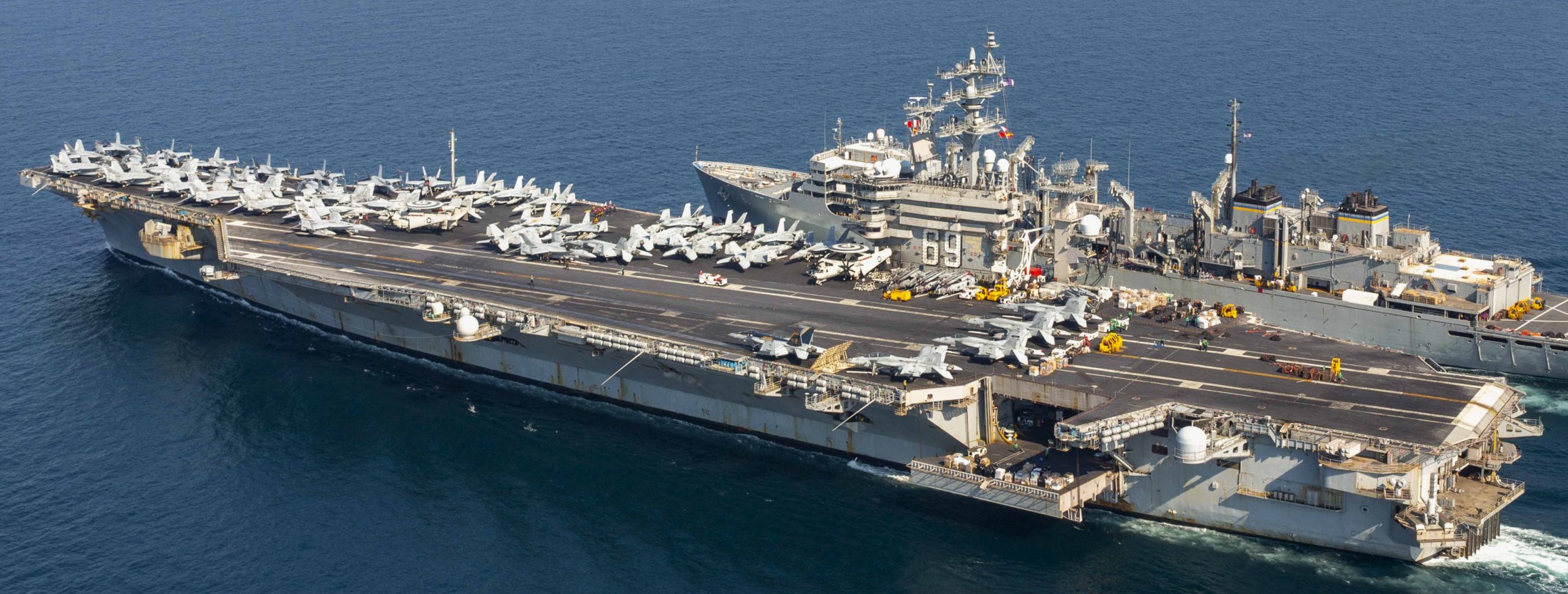 with CVW-3 embarked - 5th Fleet AOR - December 2023 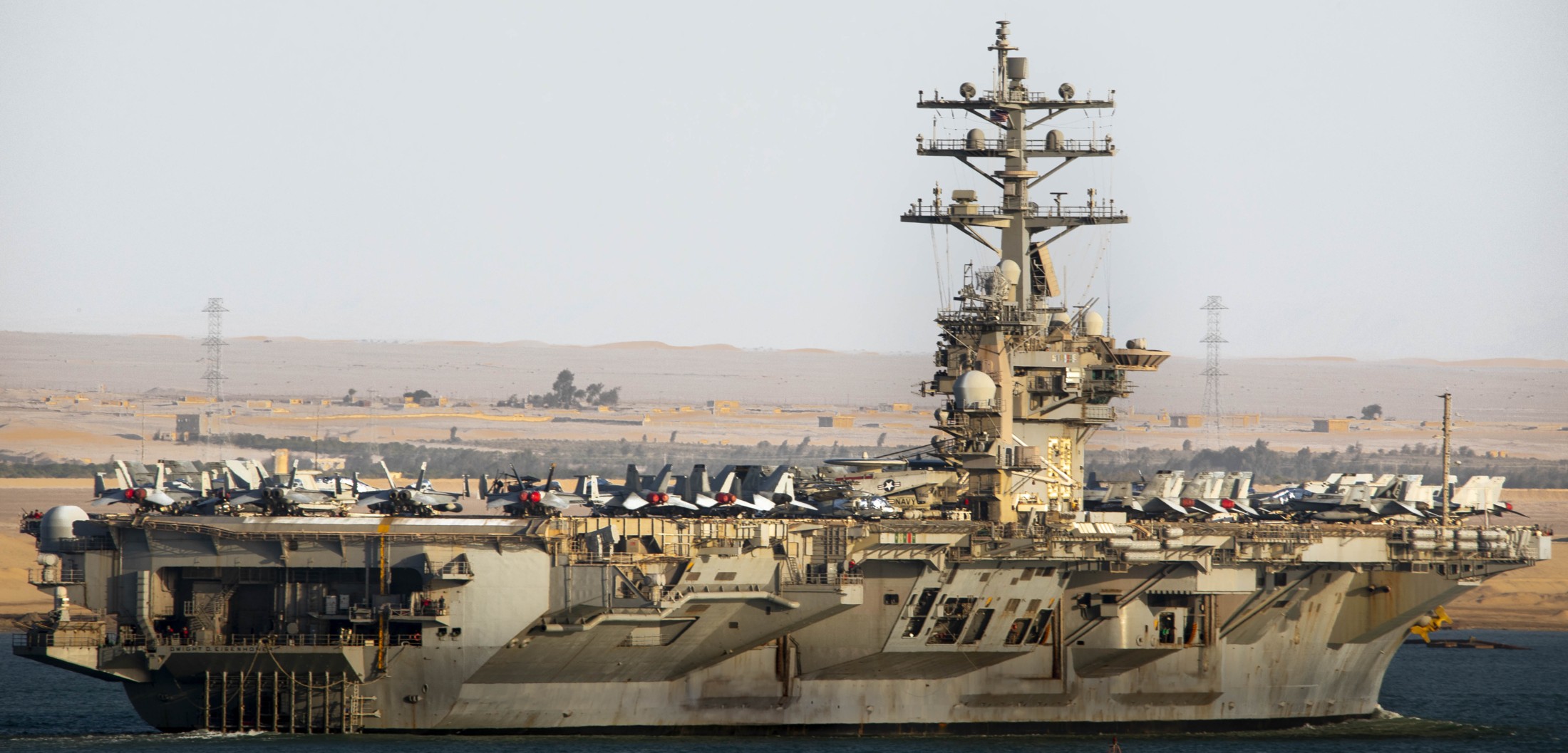 with CVW-3 embarked - Suez Canal (north to south) - November 4, 2023 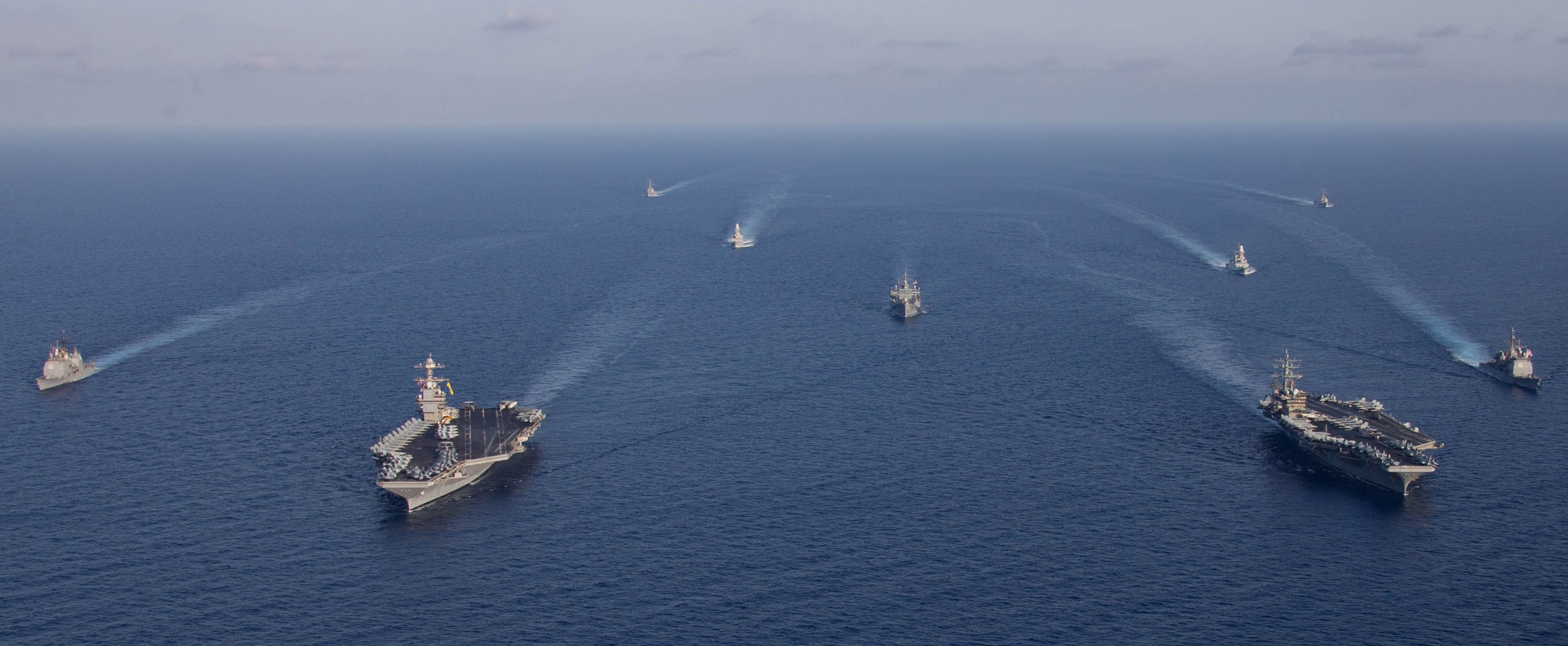 Ships from the Gerald R. Ford and Dwight D. Eisenhower Carrier Strike Groups (CSG), U.S. Sixth Fleet command ship USS Mount Whitney (LCC 20), and Italian Navy frigates Carlo Margottini (F 592) and Virginio Fasan (F 591) sail in formation in the Mediterranean Sea, November 3, 2023. Gerald R. Ford Carrier Strike Group ships: USS Gerald R. Ford (CVN 78), USS Normandy (CG 60), USS Ramage (DDG 61) and USS Paul Ignatius (DDG 117). Dwight D. Eisenhower Carrier Strike Group ships: USS Dwight D. Eisenhower (CVN 69), USS Philippine Sea (CG 58), USS Gravely (DDG 107) and USS Mason (DDG 87) 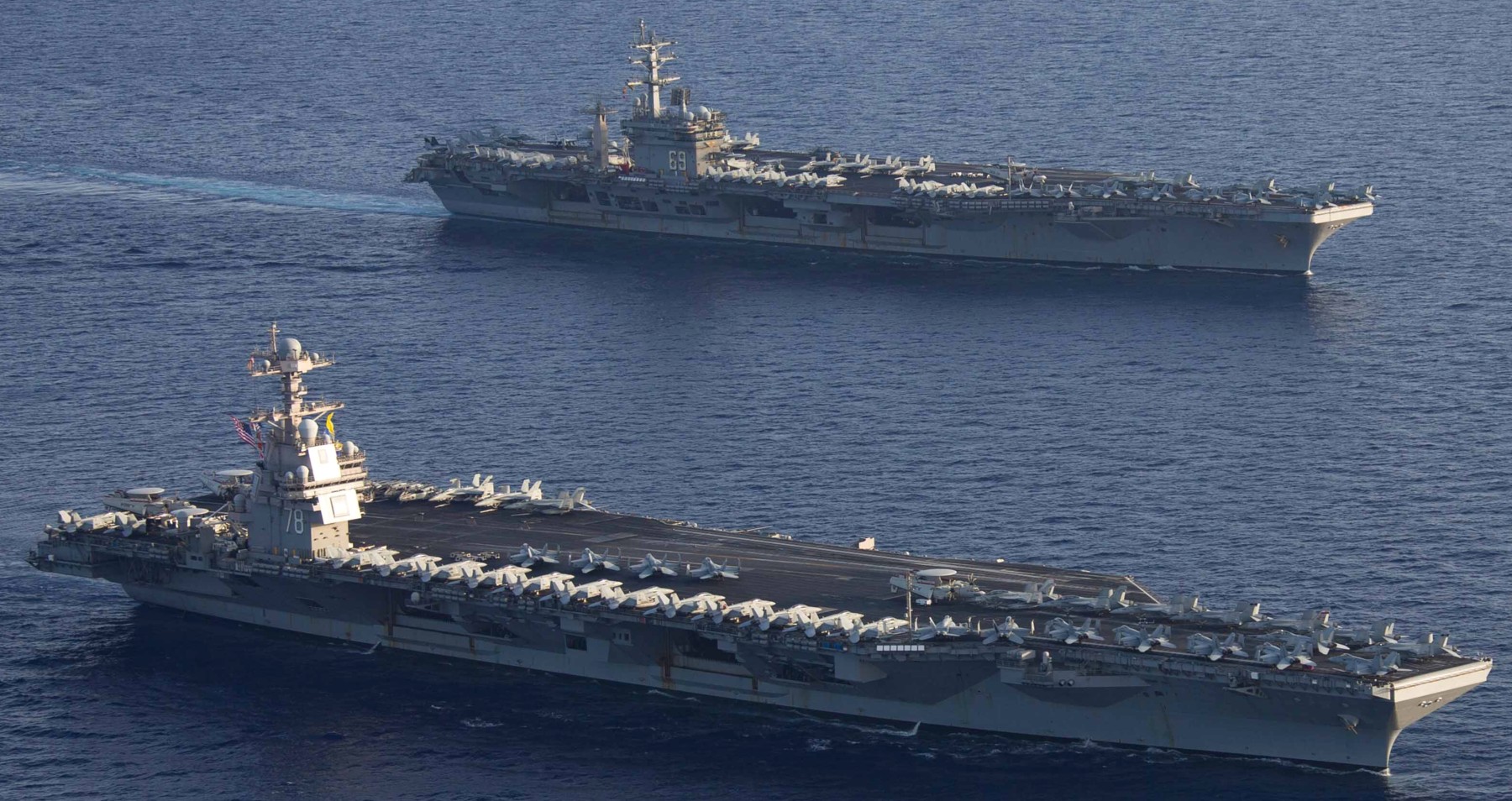 with USS Gerald R. Ford (CVN 78) - Mediterranean Sea - November 3, 2023 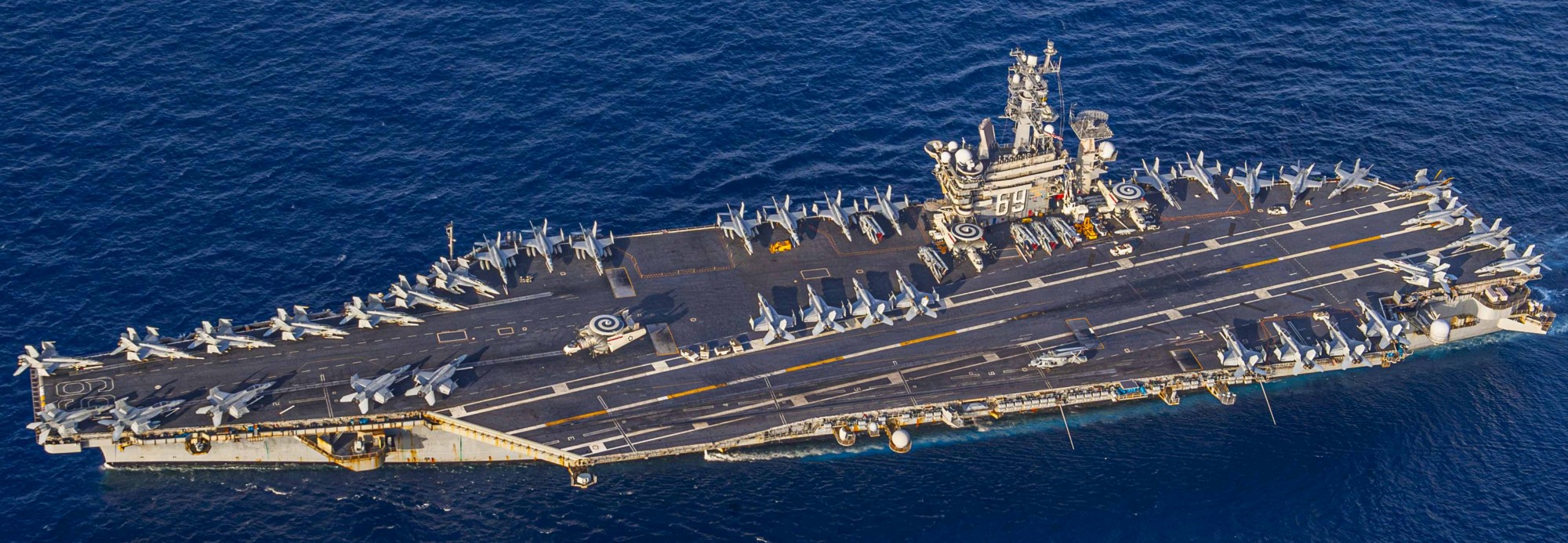 with CVW-3 embarked - Mediterranean Sea - November 3, 2023 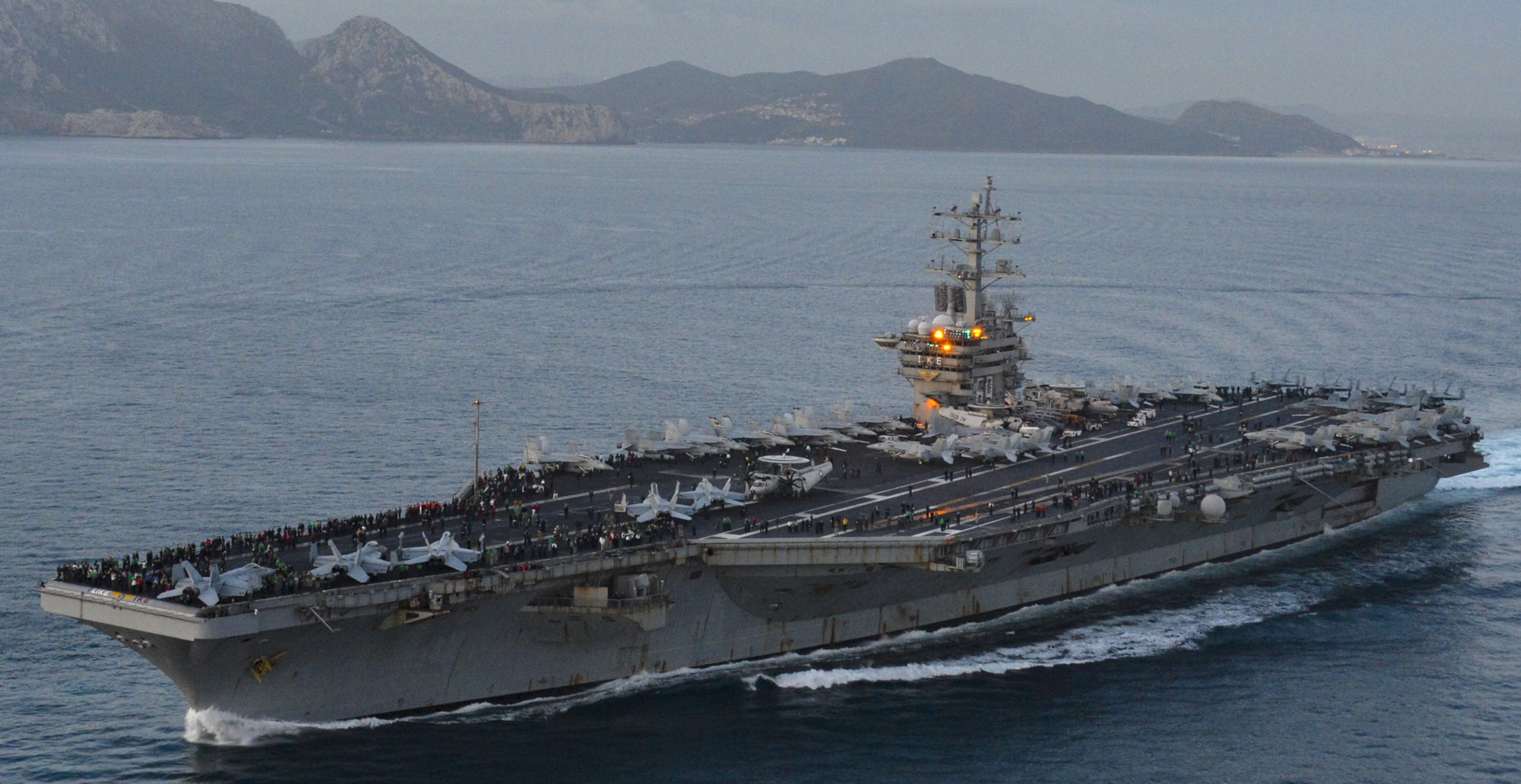 with CVW-3 embarked - Strait of Gibraltar - October 28, 2023 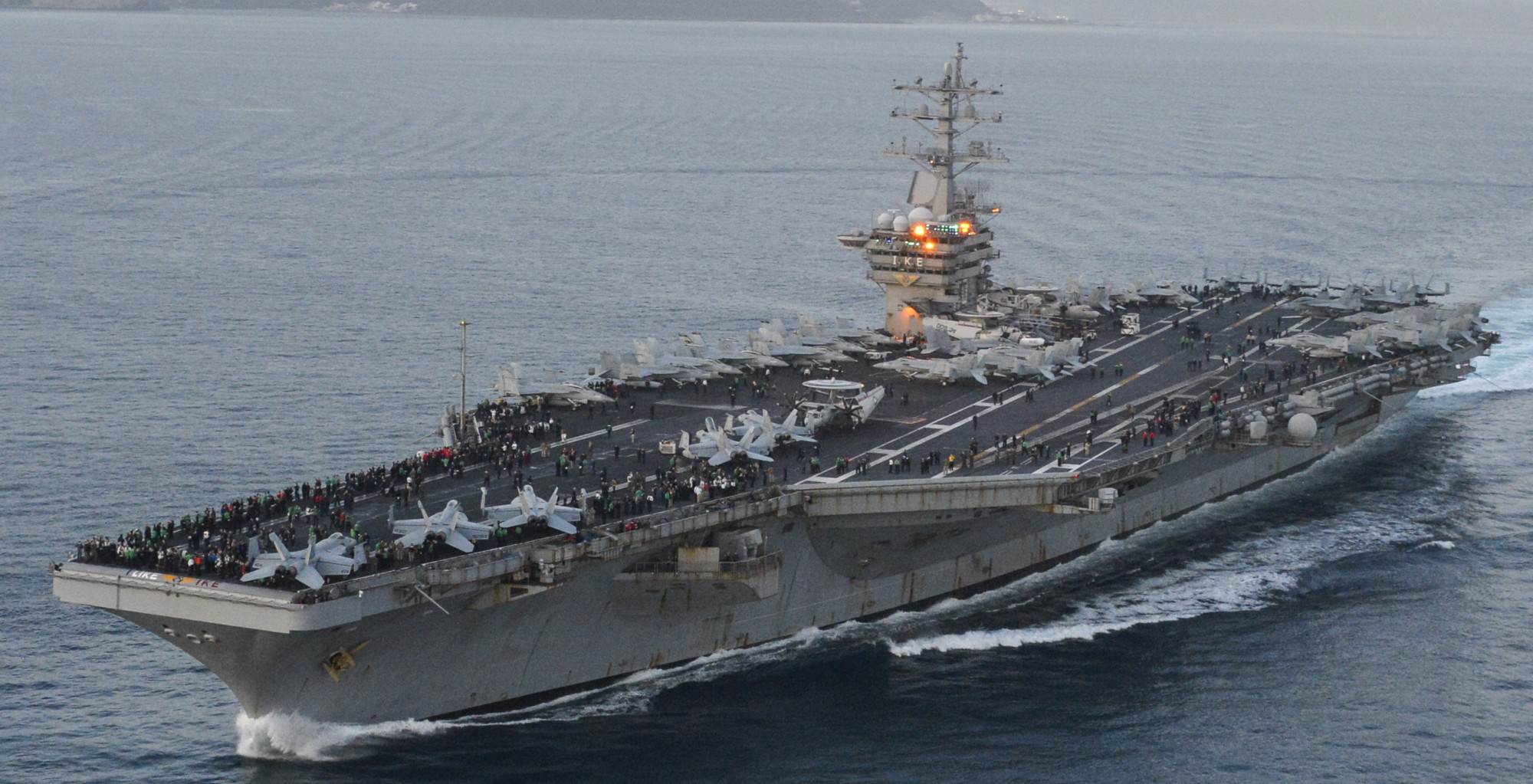 with CVW-3 embarked - Strait of Gibraltar - October 28, 2023 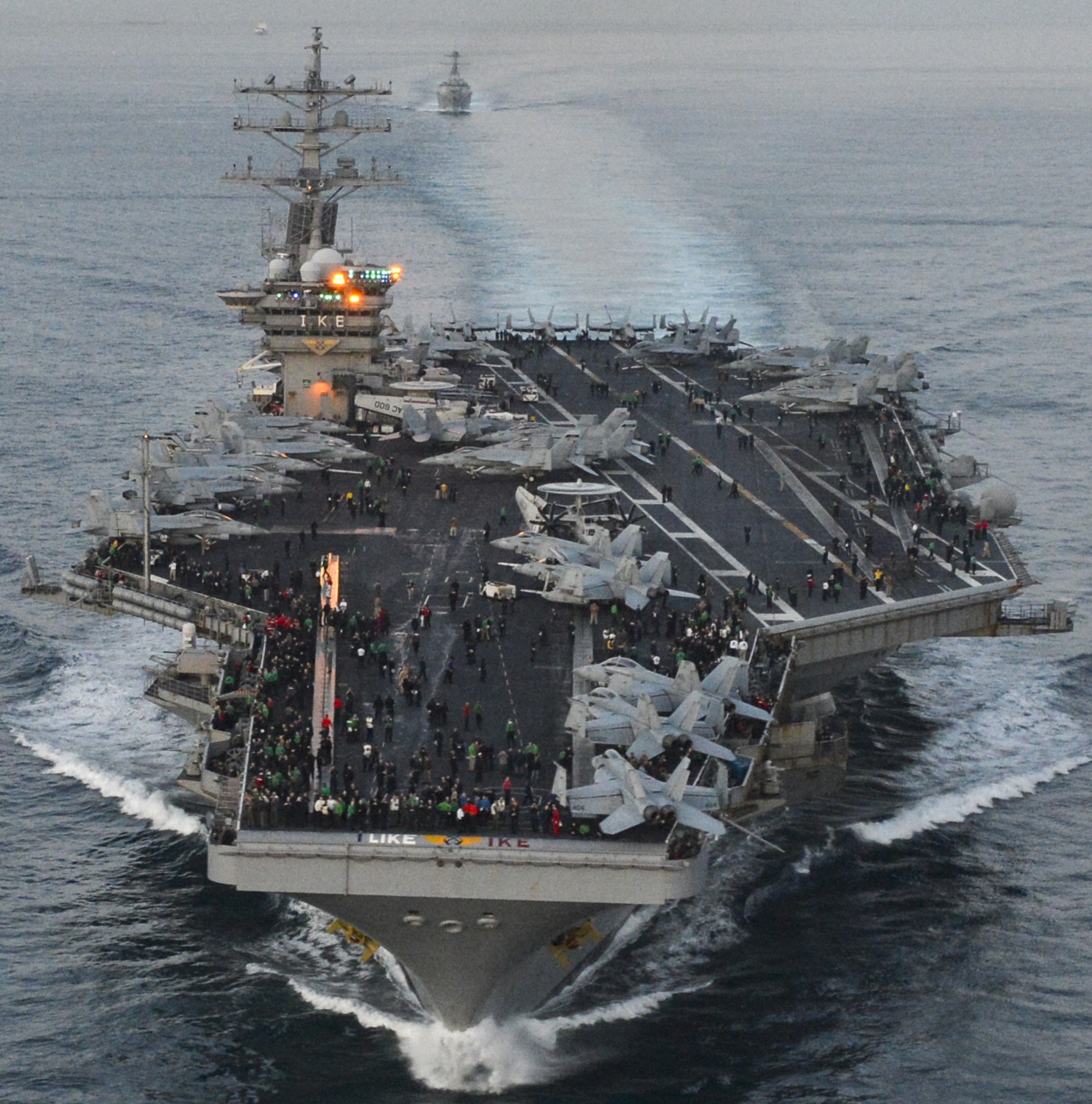 with CVW-3 embarked - Strait of Gibraltar - October 28, 2023 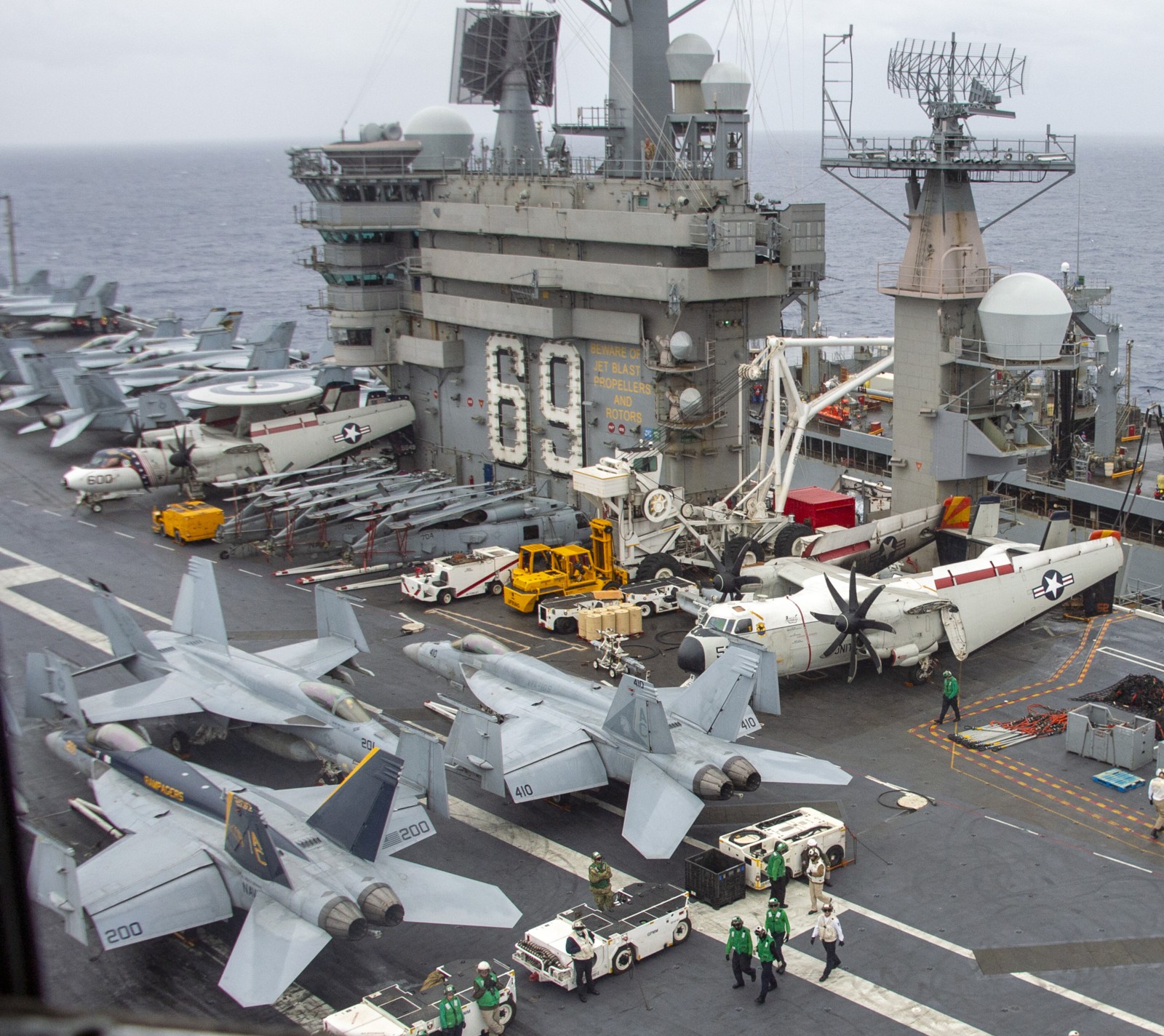 with CVW-3 embarked - Atlantic Ocean - October 2023  departing Naval Station Norfolk, Virginia - October 14, 2023 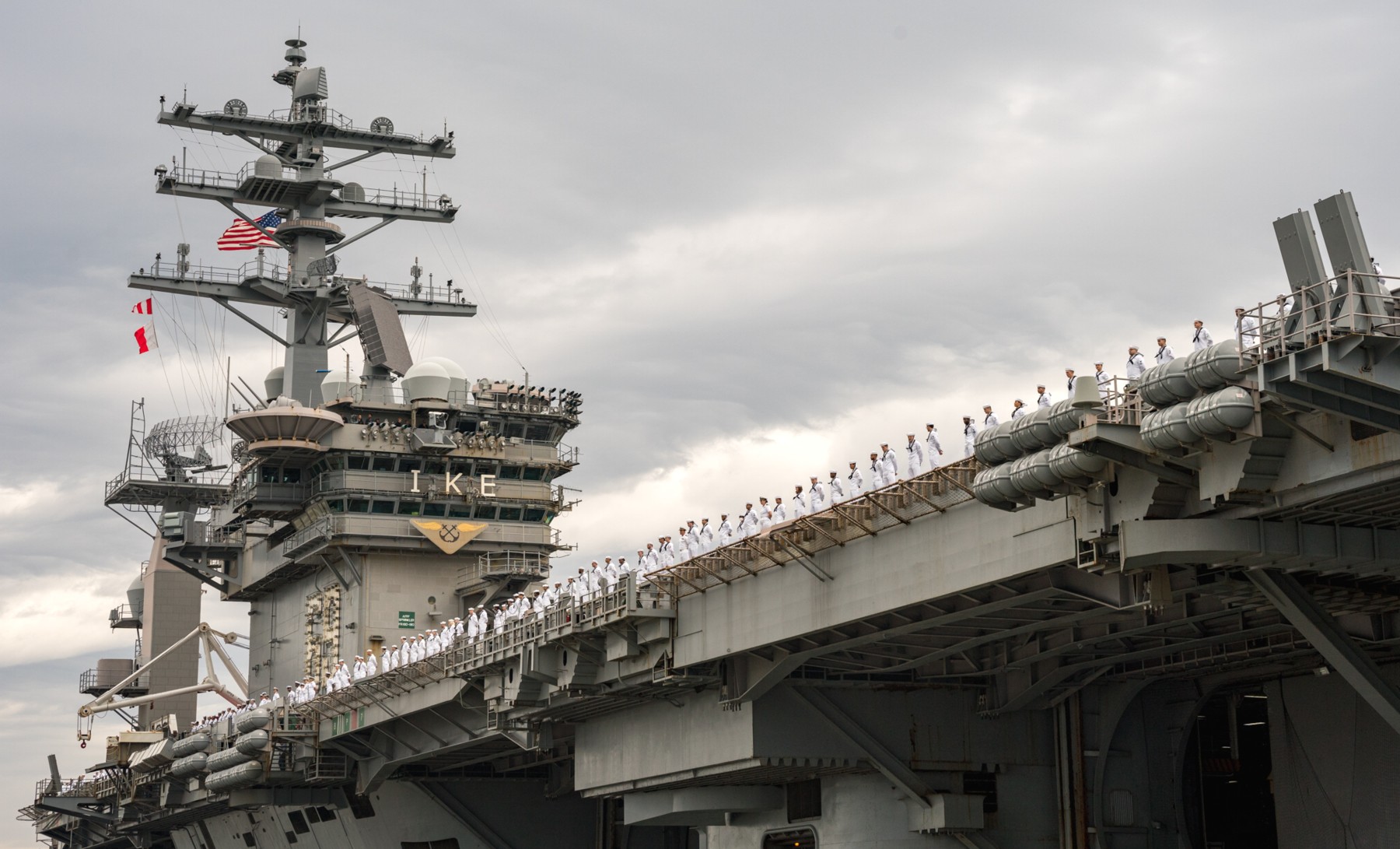 departing Naval Station Norfolk, Virginia - October 14, 2023 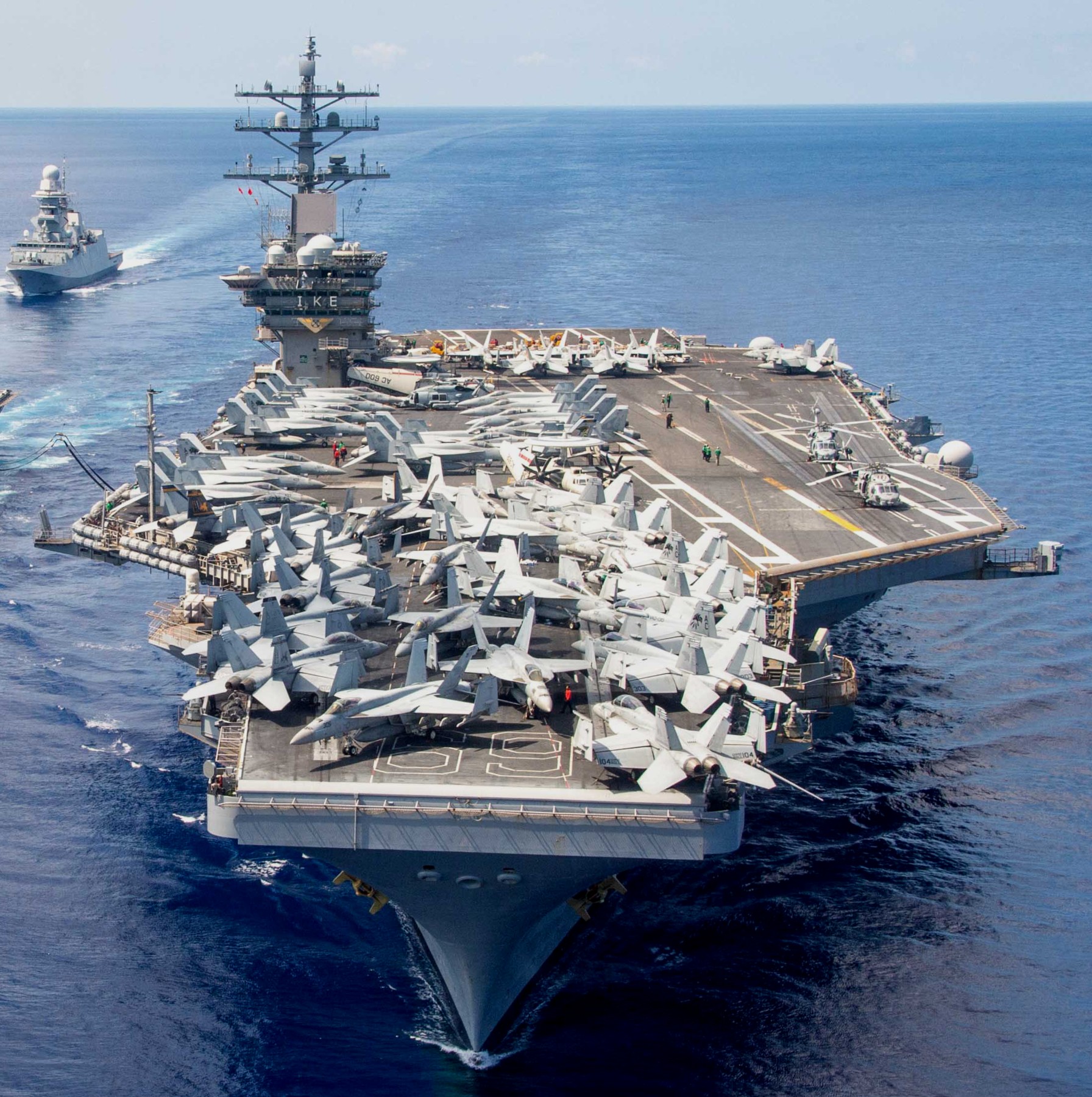 with CVW-3 embarked - COMPTUEX - Atlantic Ocean - July 2022 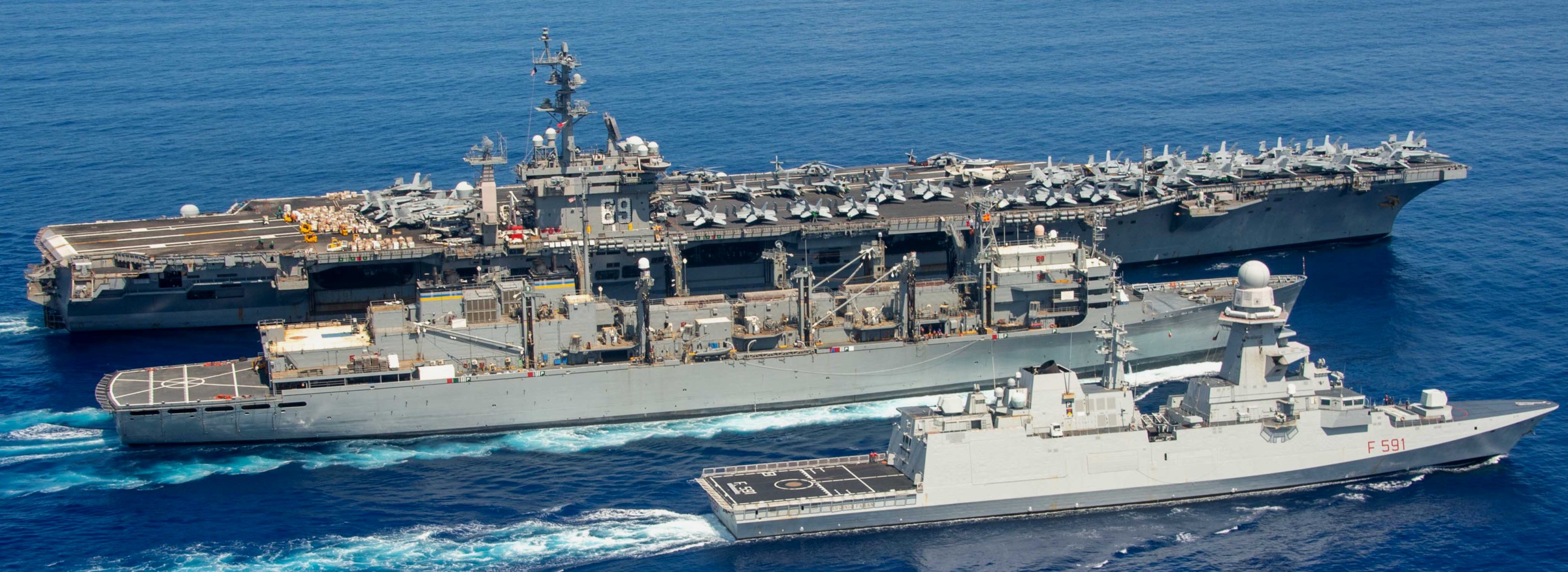 with CVW-3 embarked - COMPTUEX - Atlantic Ocean - July 2022 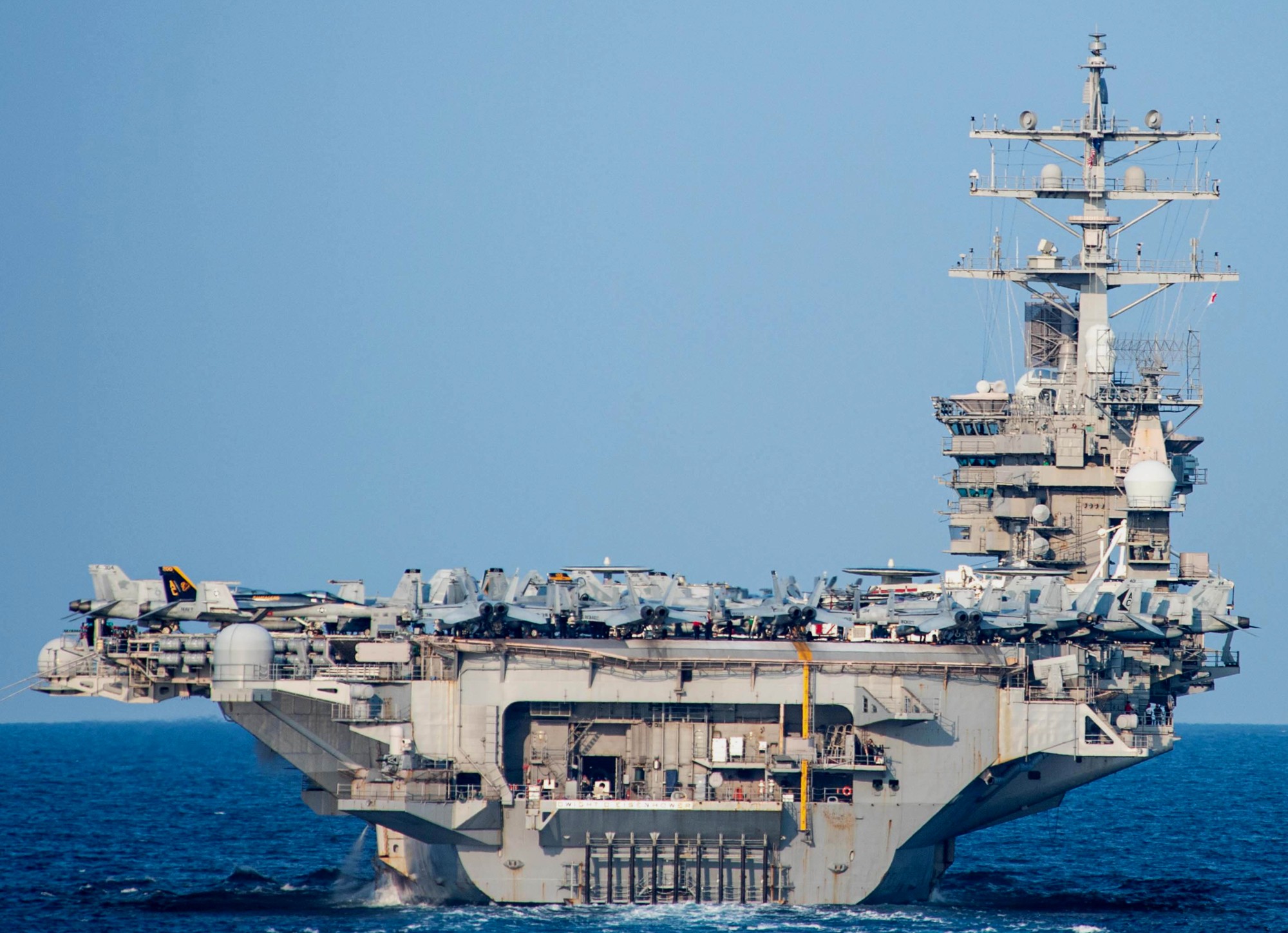 with CVW-3 embarked - COMPTUEX - Atlantic Ocean - July 2022 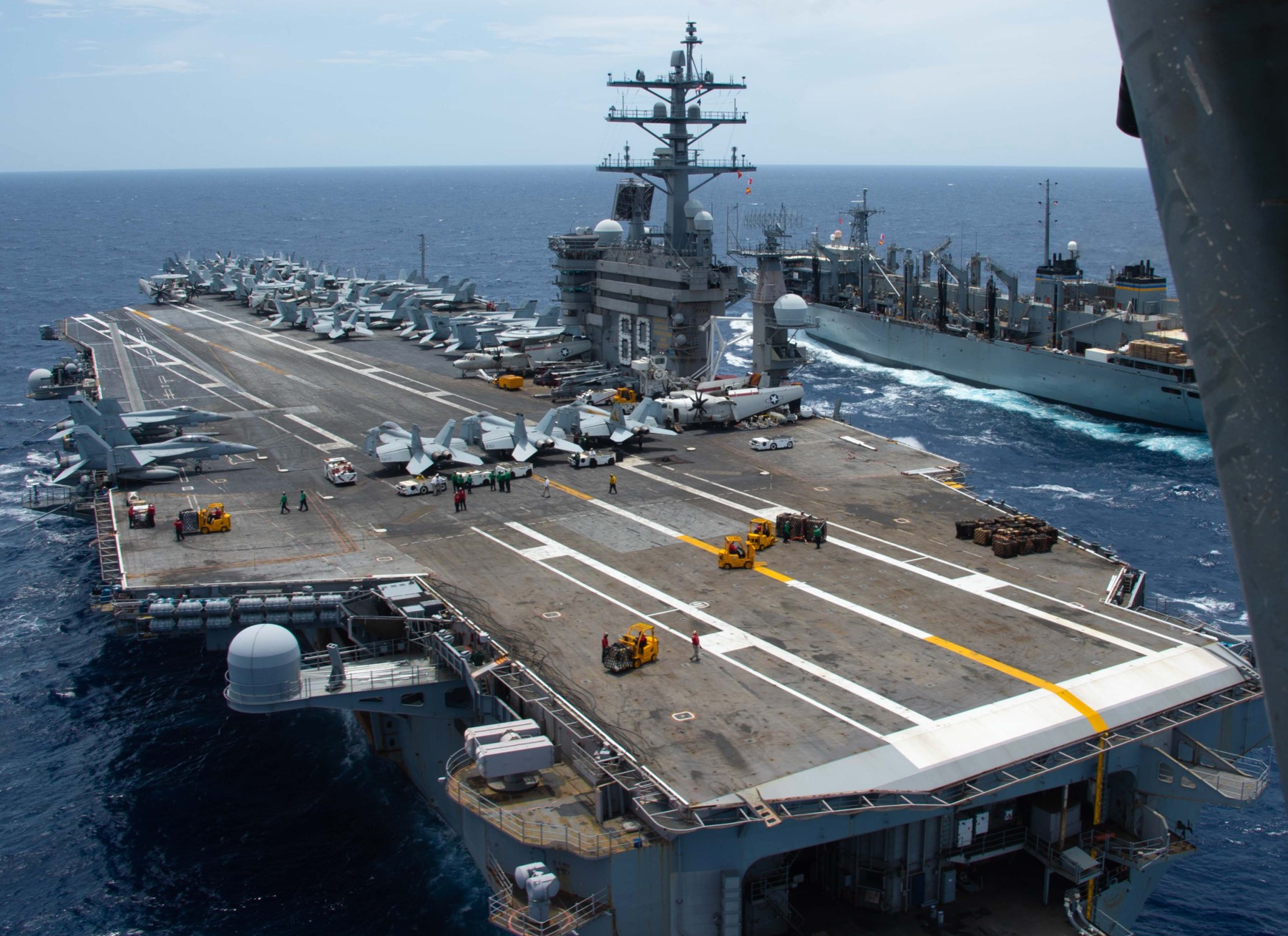 with CVW-3 embarked - COMPTUEX - Atlantic Ocean - June 2022 August 2021 - December 2022: Planned Incremental Availability (PIA) at Norfolk Naval Shipyard, Portsmouth, Virginia  arriving at Norfolk Naval Shipyard, Virginia for a Planned Incremental Availability (PIA) - August 2021 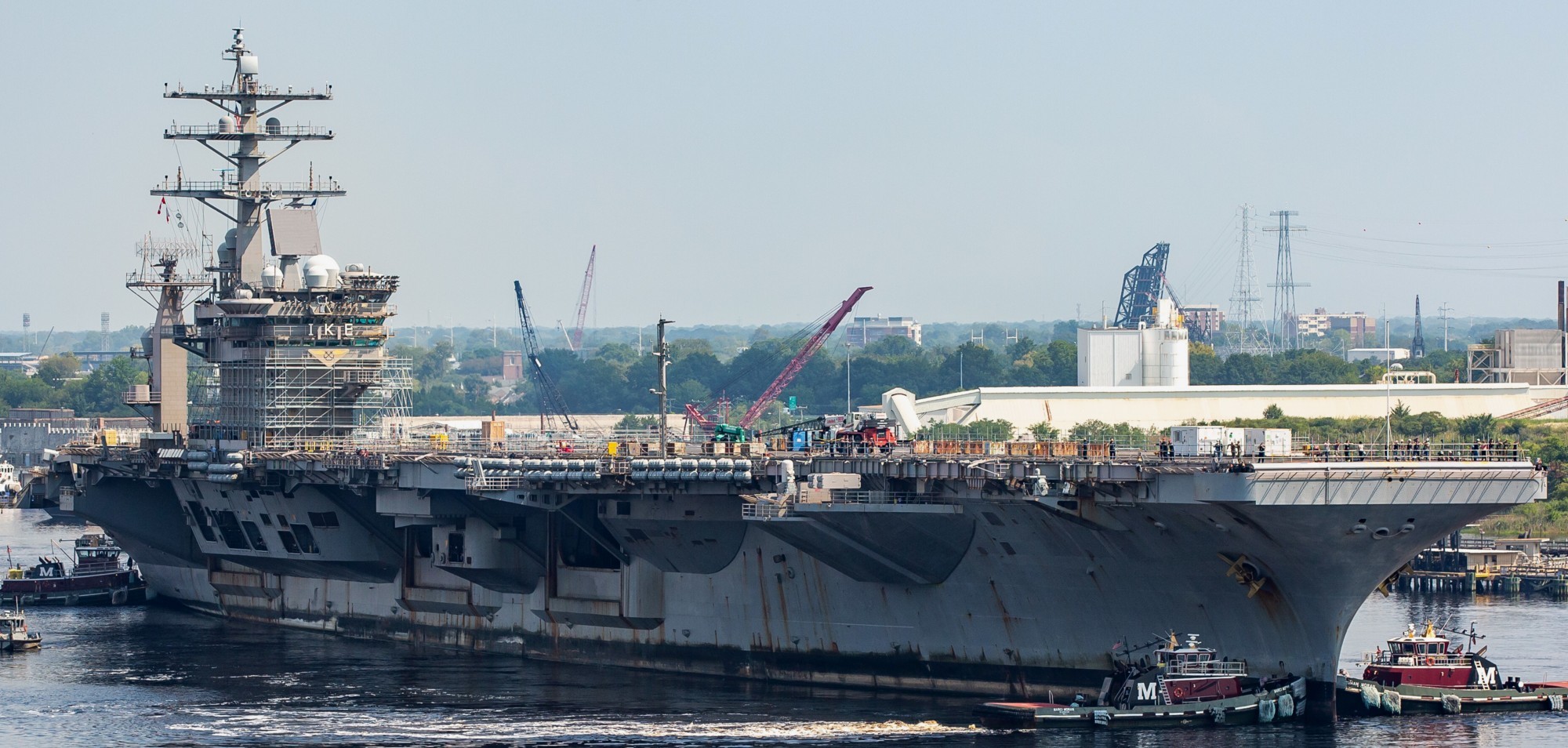 on her way to Norfolk Naval Shipyard, Virginia for a Planned Incremental Availability (PIA) - August 2021 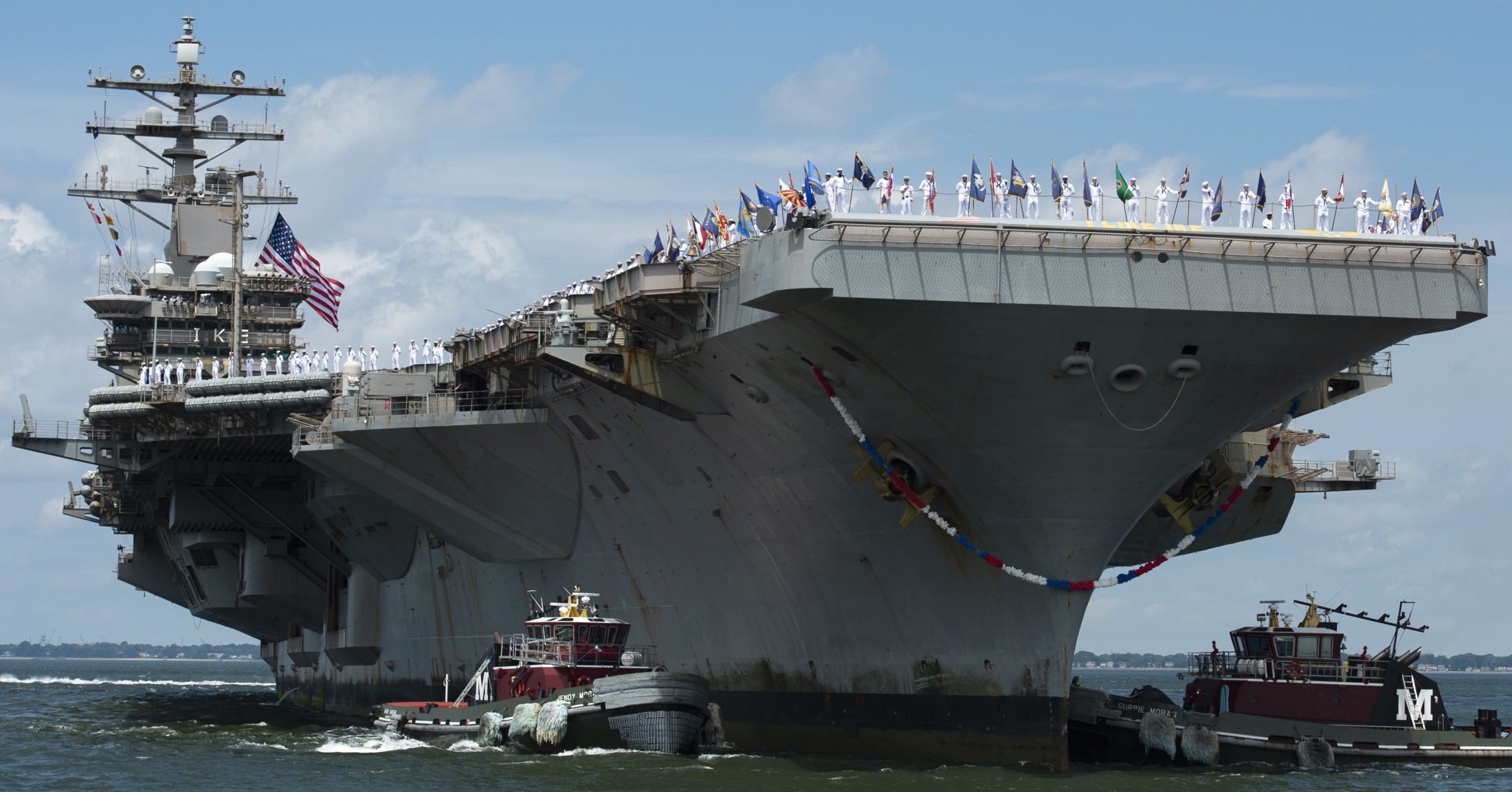 returning to Naval Station Norfolk, Virginia - July 18, 2021  with CVW-3 embarked - Arabian Sea - April 2021 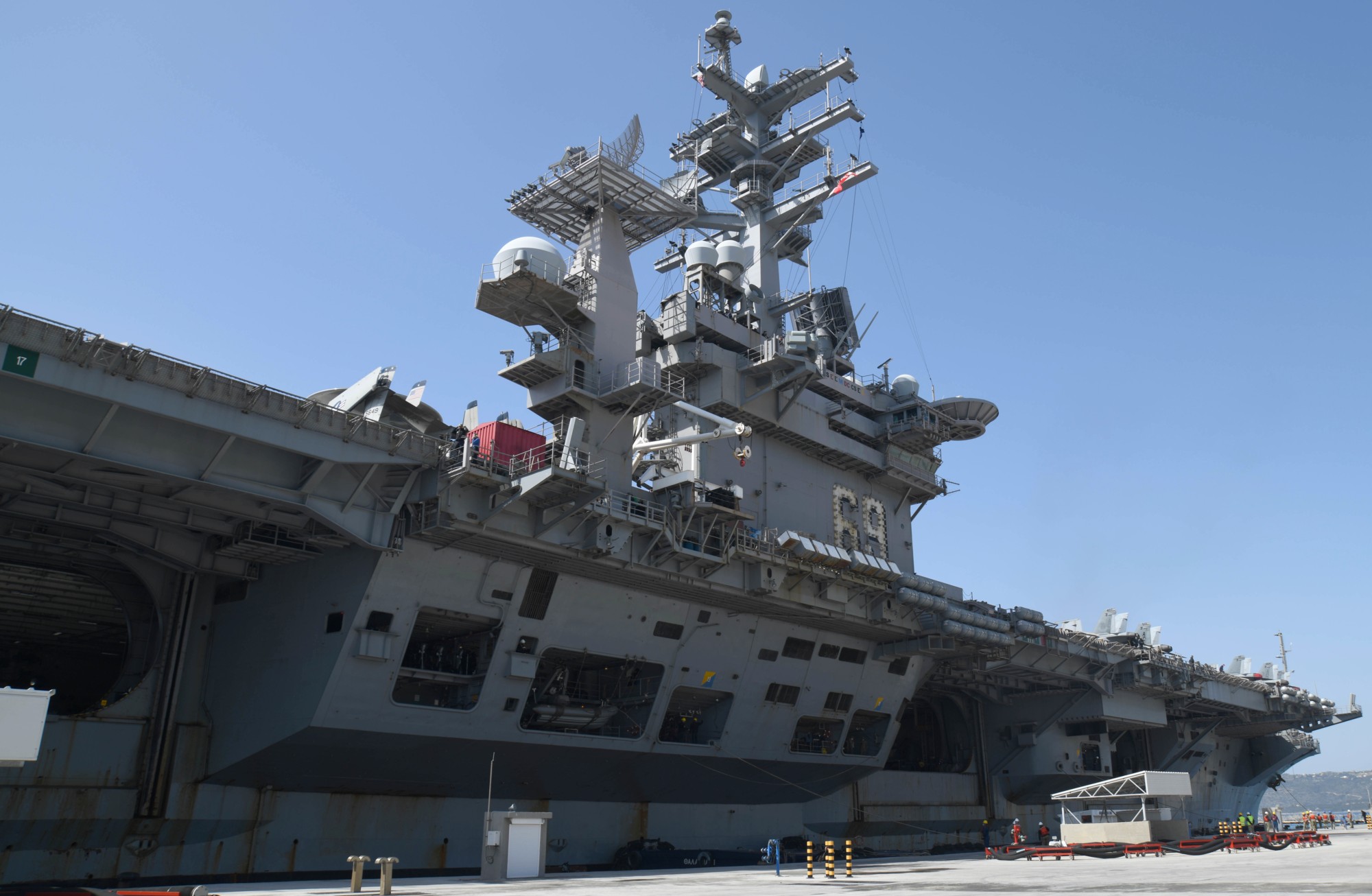 with CVW-3 embarked - Naval Support Activity Souda Bay, Crete, Greece - March 2021  with CVW-3 embarked - Naval Support Activity Souda Bay, Crete, Greece - March 2021 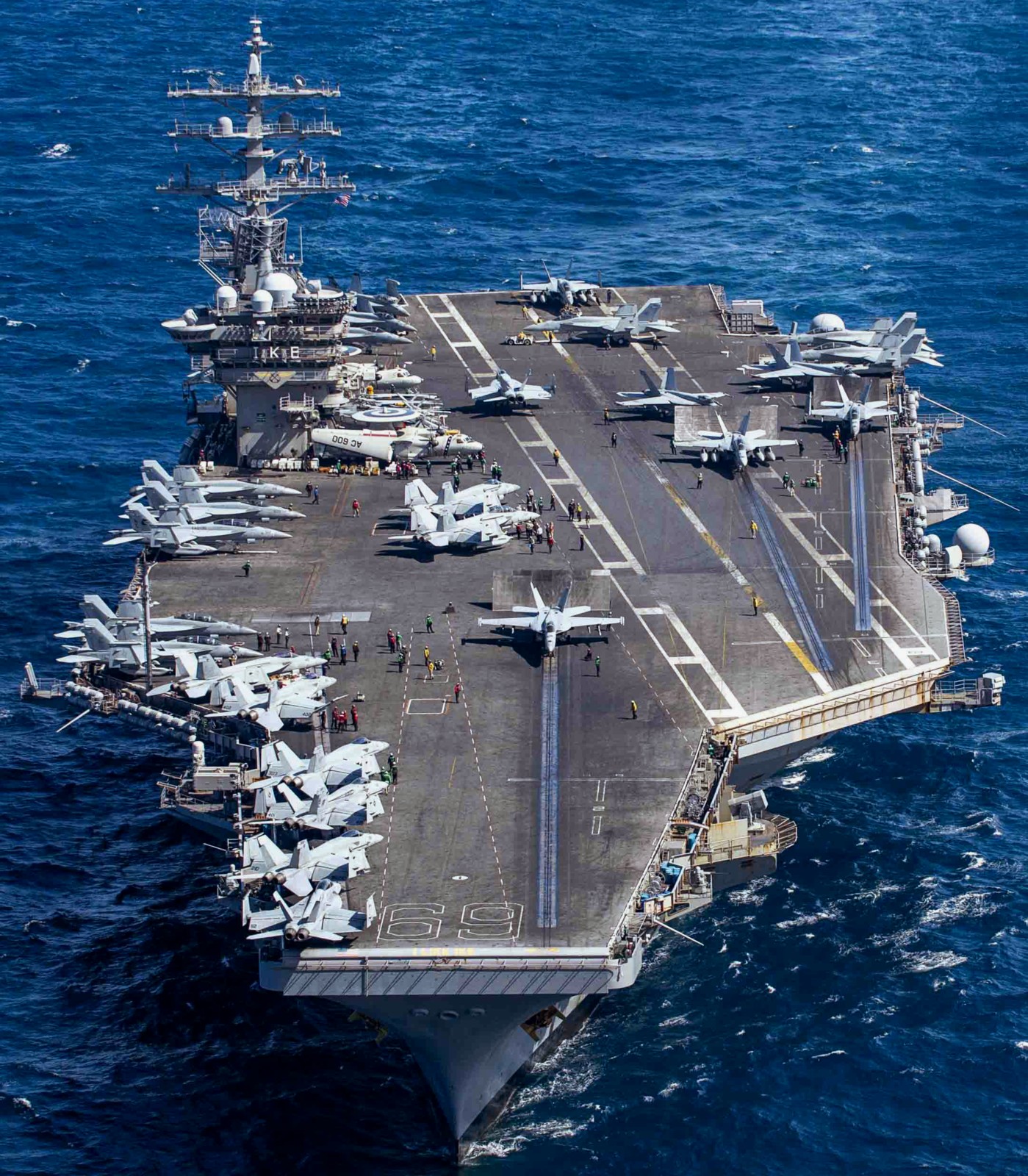 with CVW-3 embarked - Mediterranean Sea - March 2021 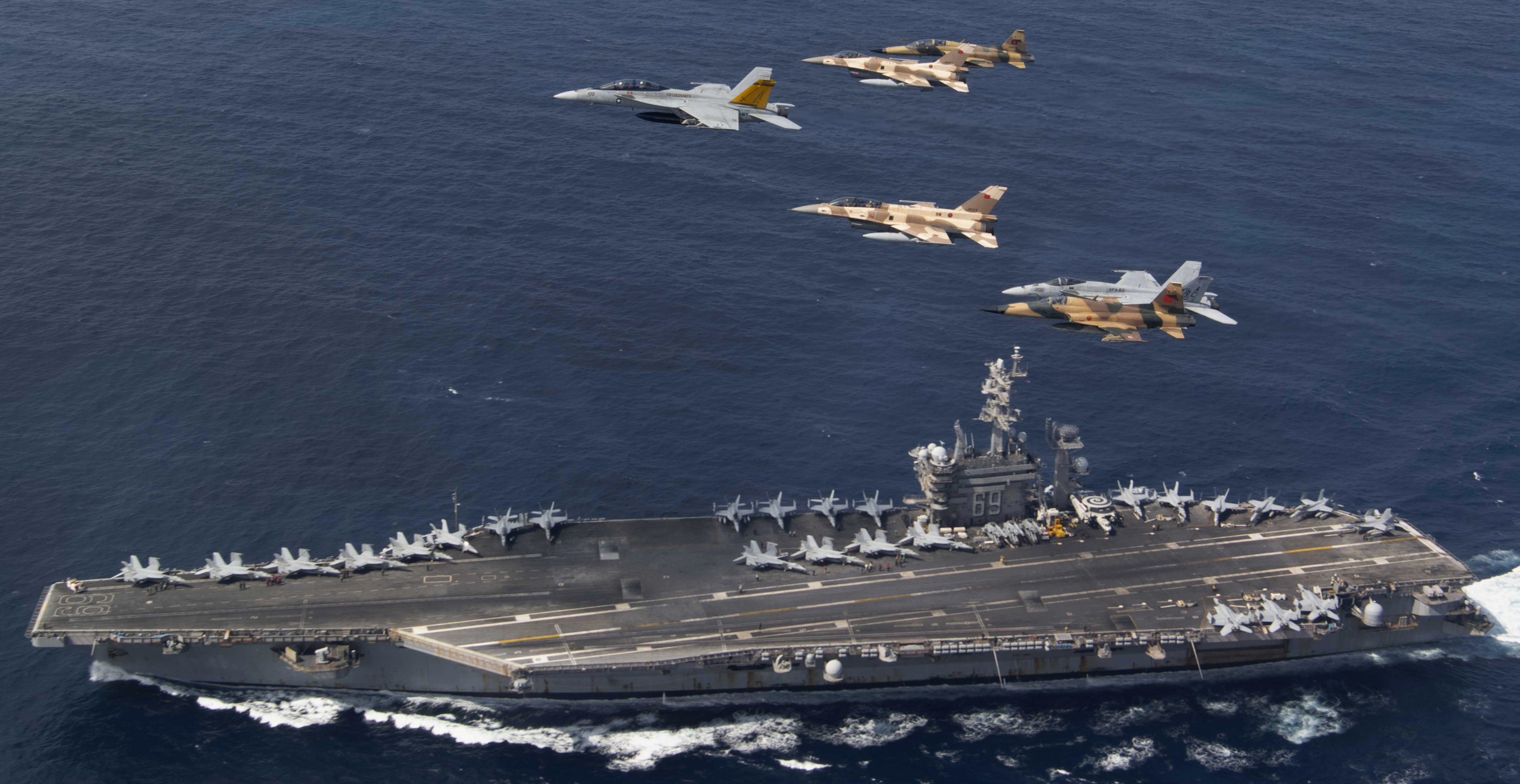 aircraft of the Royal Moroccan Air Force in formation with aircraft from CVW-3 - Atlantic Ocean - March 2021 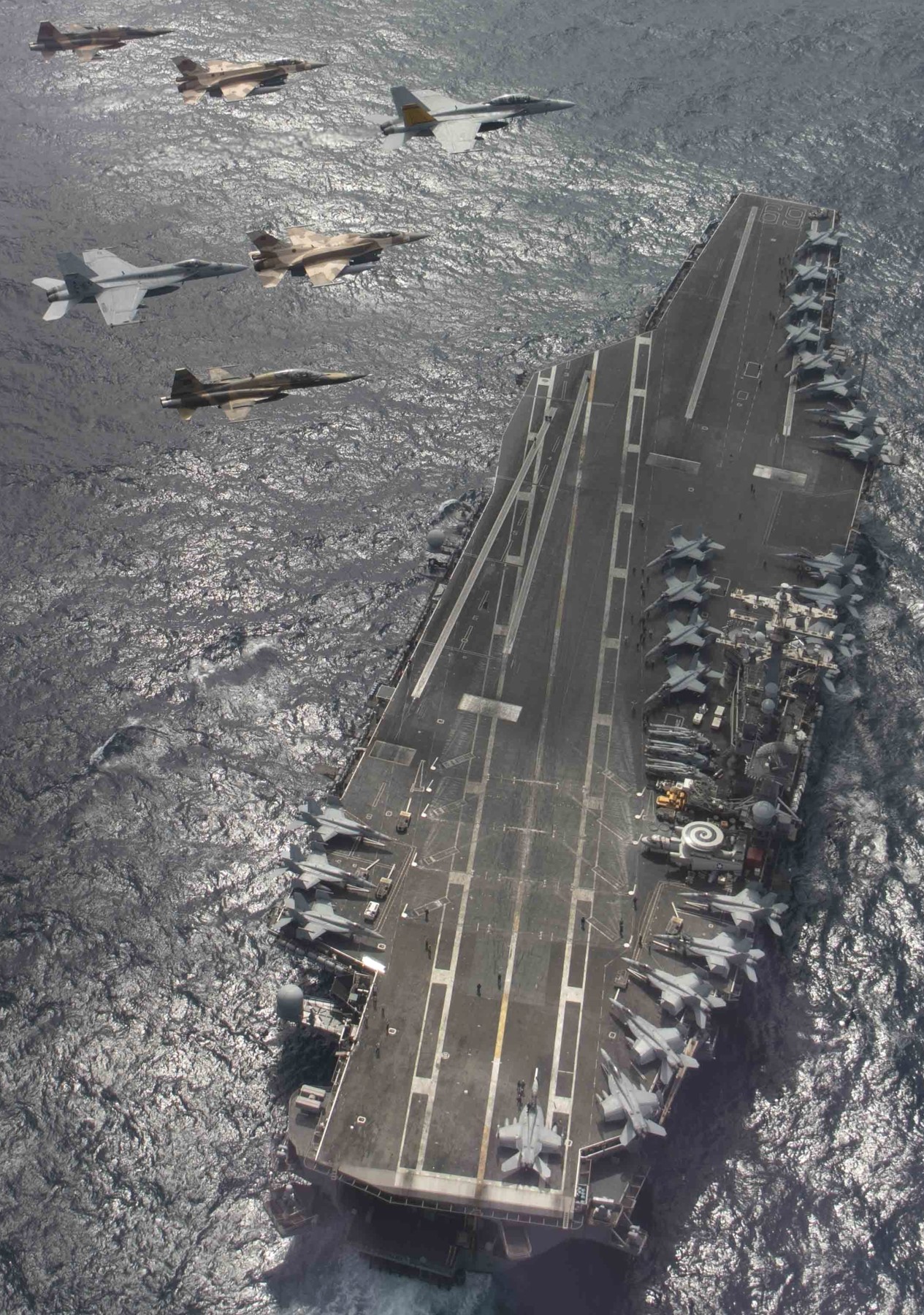 aircraft of the Royal Moroccan Air Force in formation with aircraft from CVW-3 - Atlantic Ocean - March 2021  with CVW-3 embarked - Atlantic Ocean - February 2021 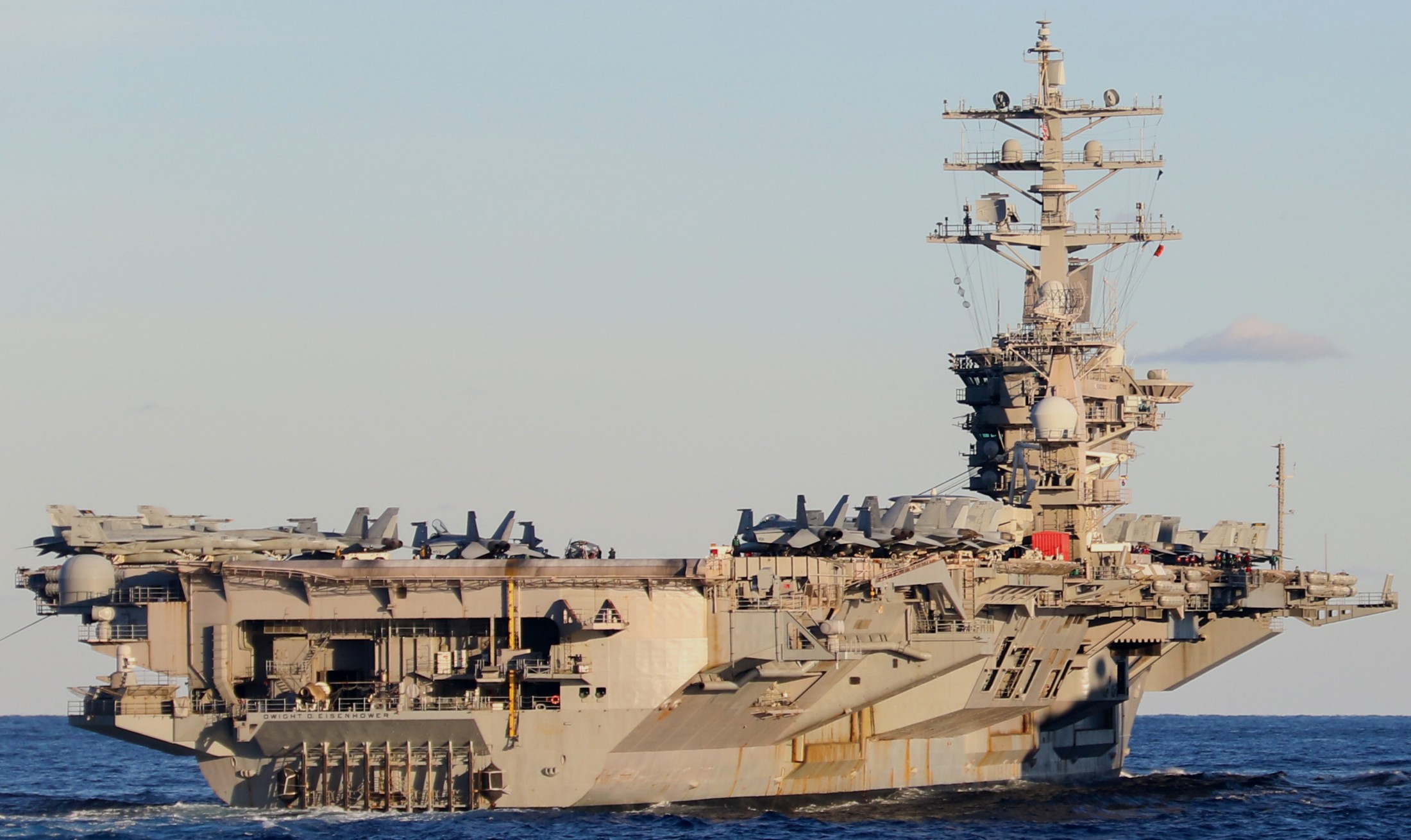 with CVW-3 embarked - Atlantic Ocean - January 2021 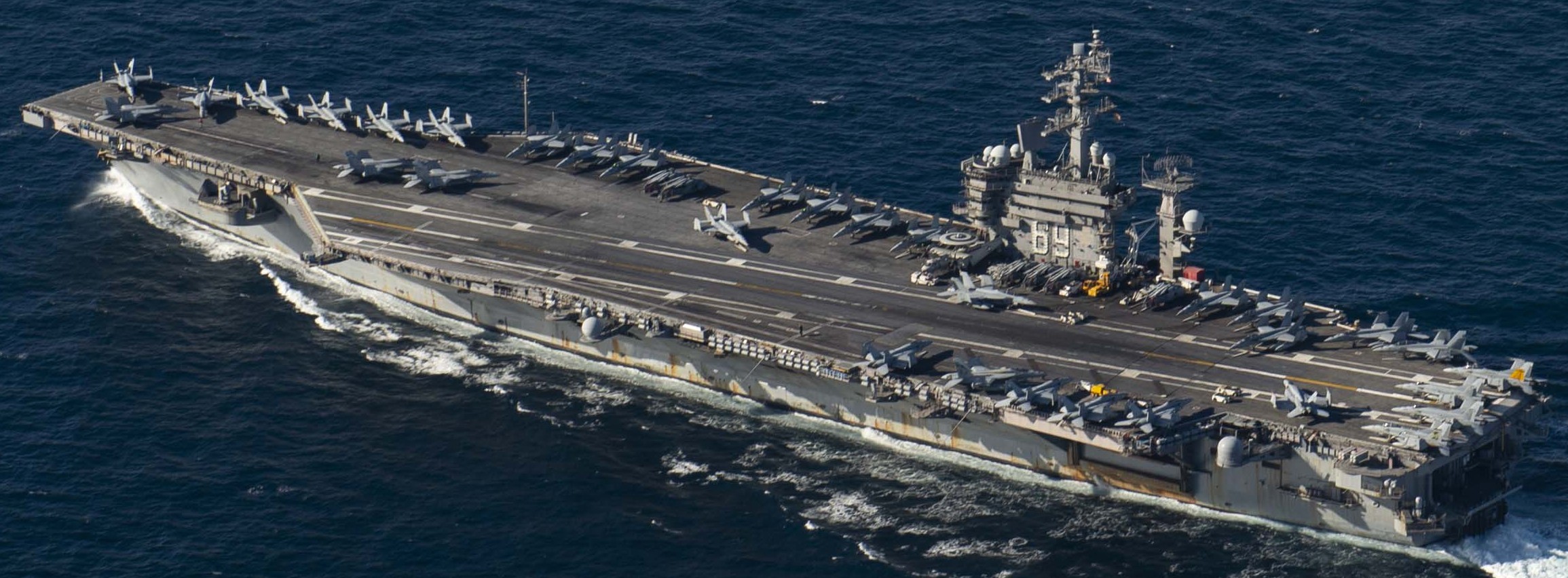 with CVW-3 embarked - COMPTUEX - Atlantic Ocean - January 2021 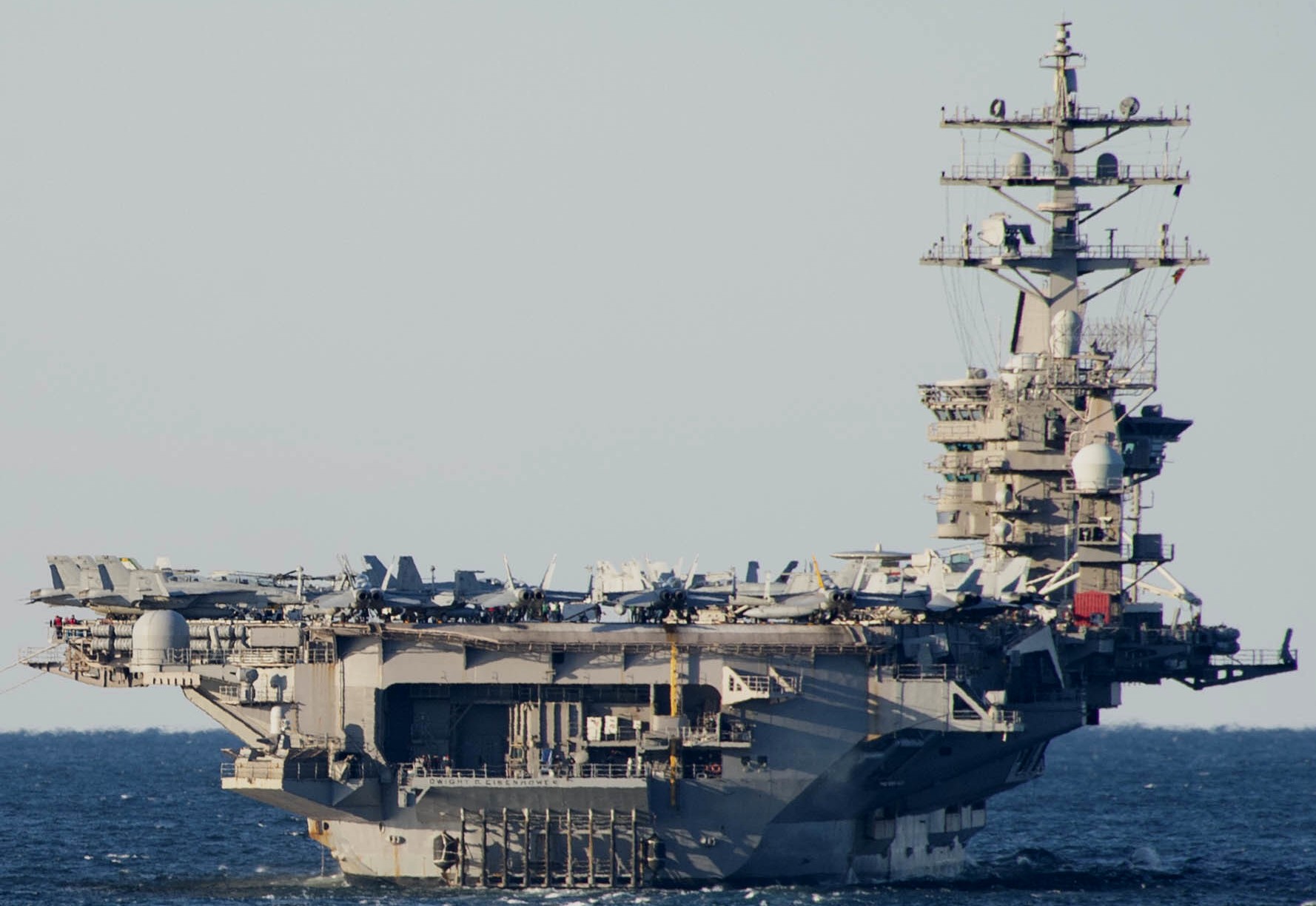 with CVW-3 embarked - COMPTUEX - Atlantic Ocean - January 2021  Atlantic Ocean - December 2020 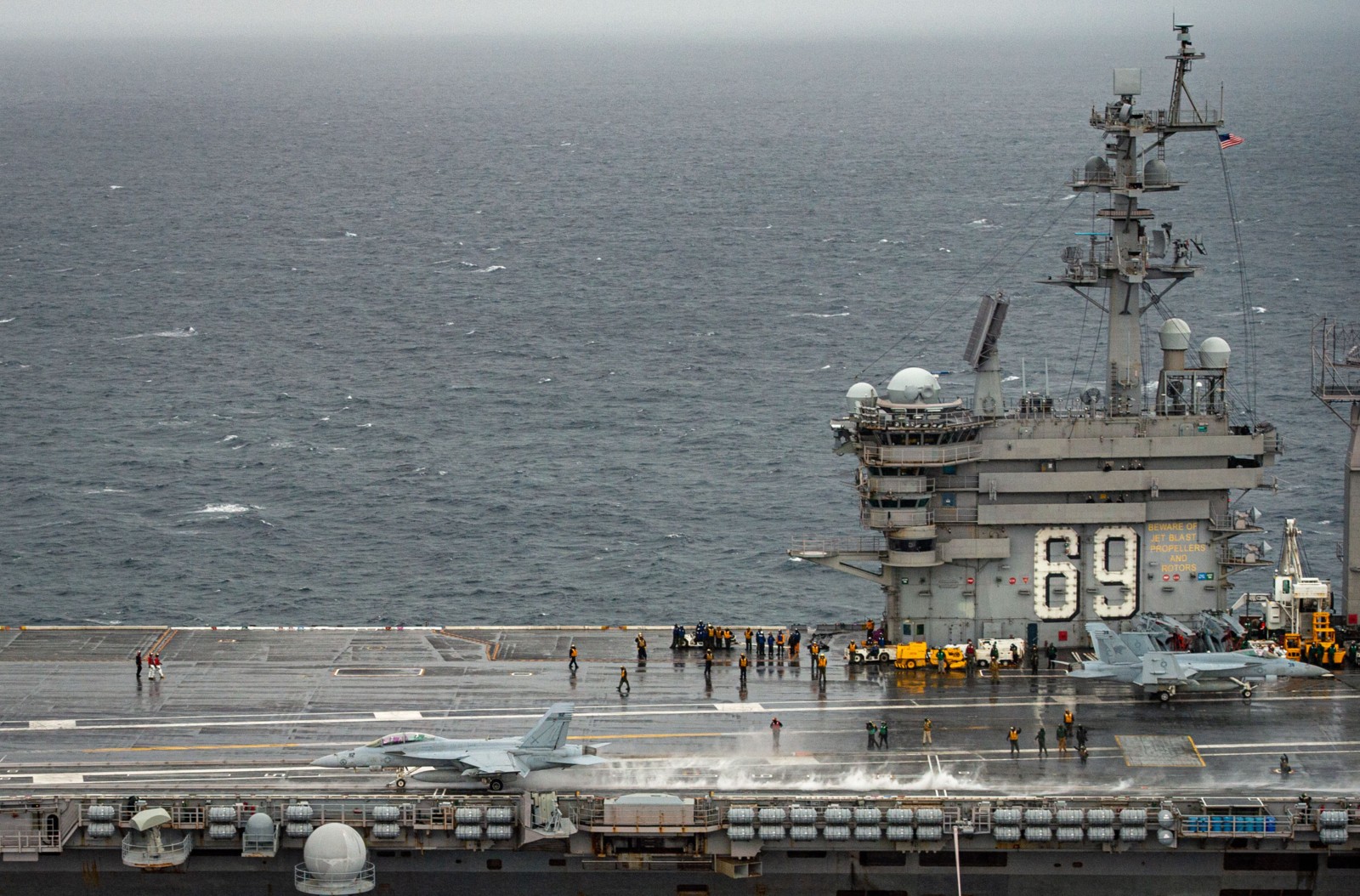 Atlantic Ocean - December 2020 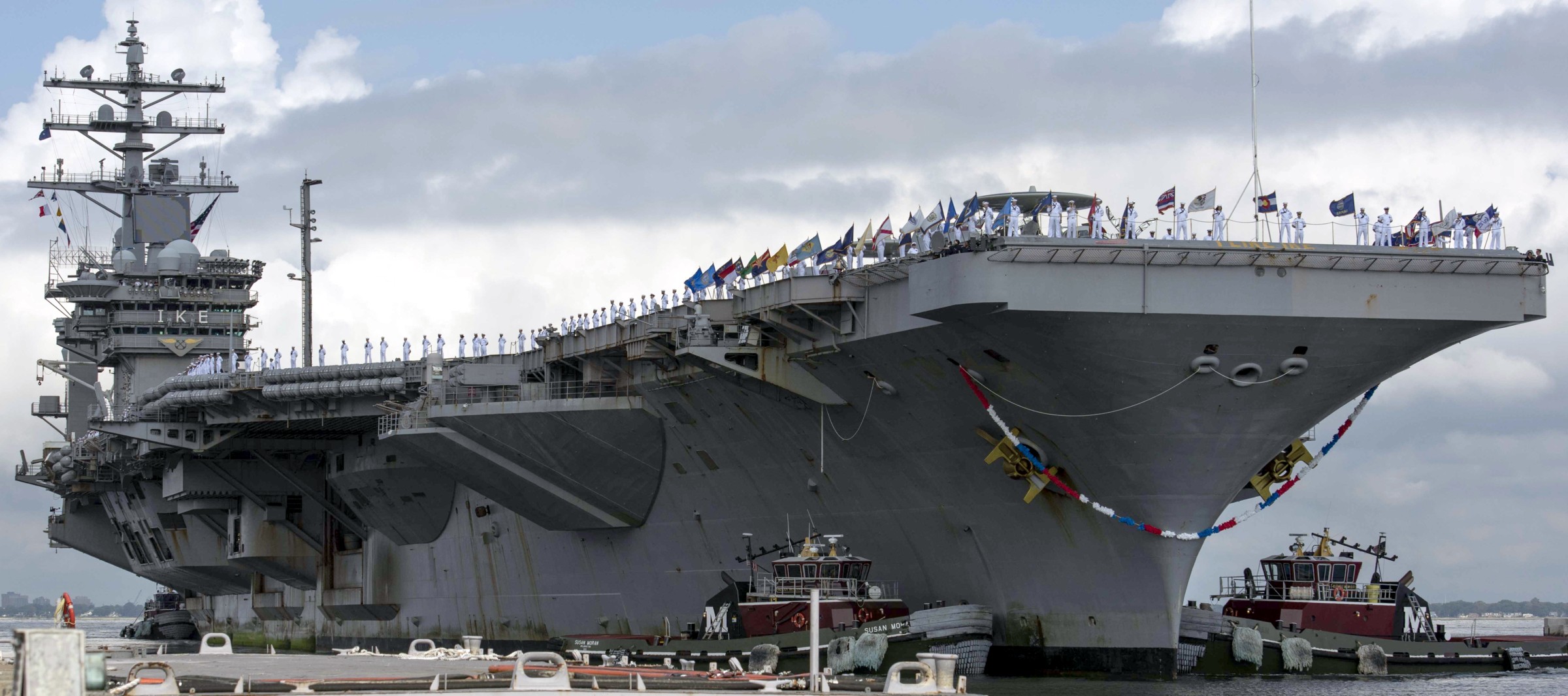 returning to Naval Station Norfolk, Virginia - August 9, 2020 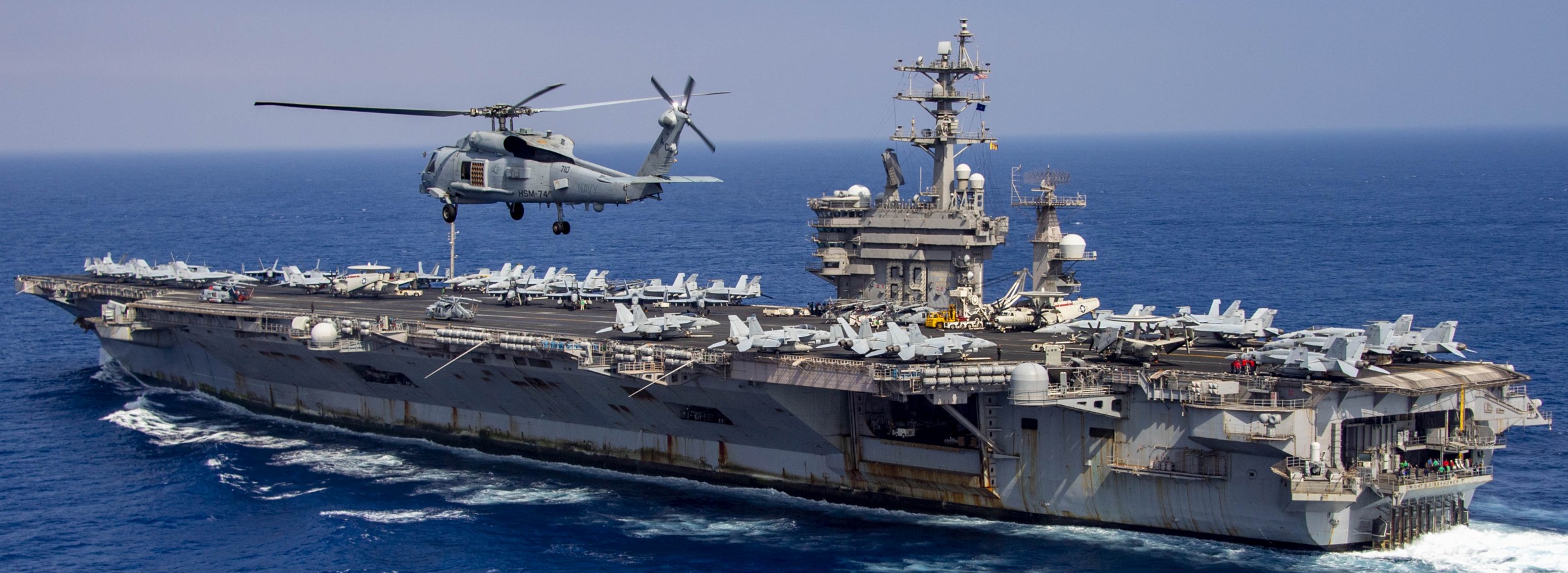 with CVW-3 embarked - Strait of Gibraltar - July 2020 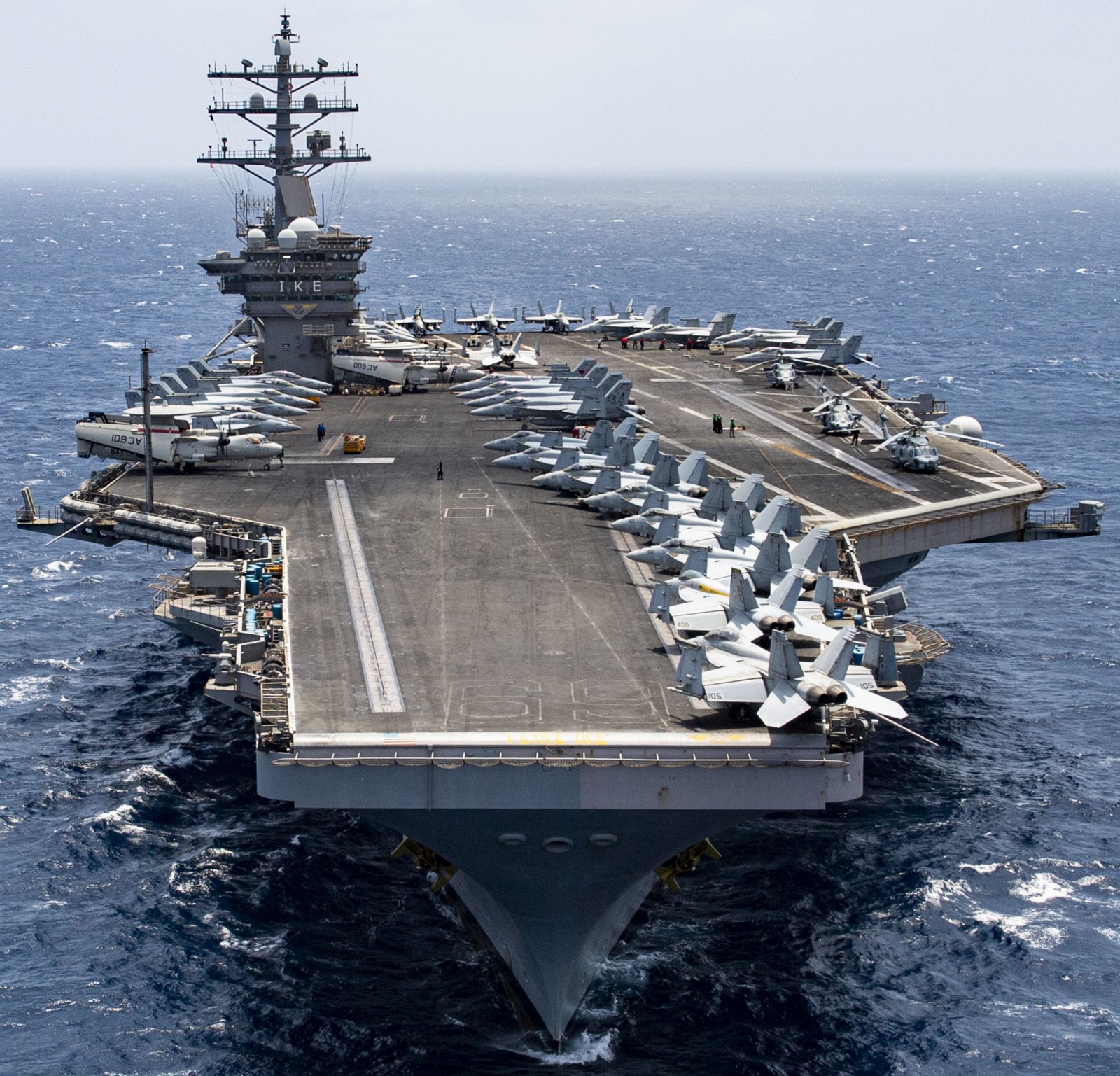 with CVW-3 embarked - Arabian Gulf - June 2020  with CVW-3 embarked - Arabian Sea - April 2020 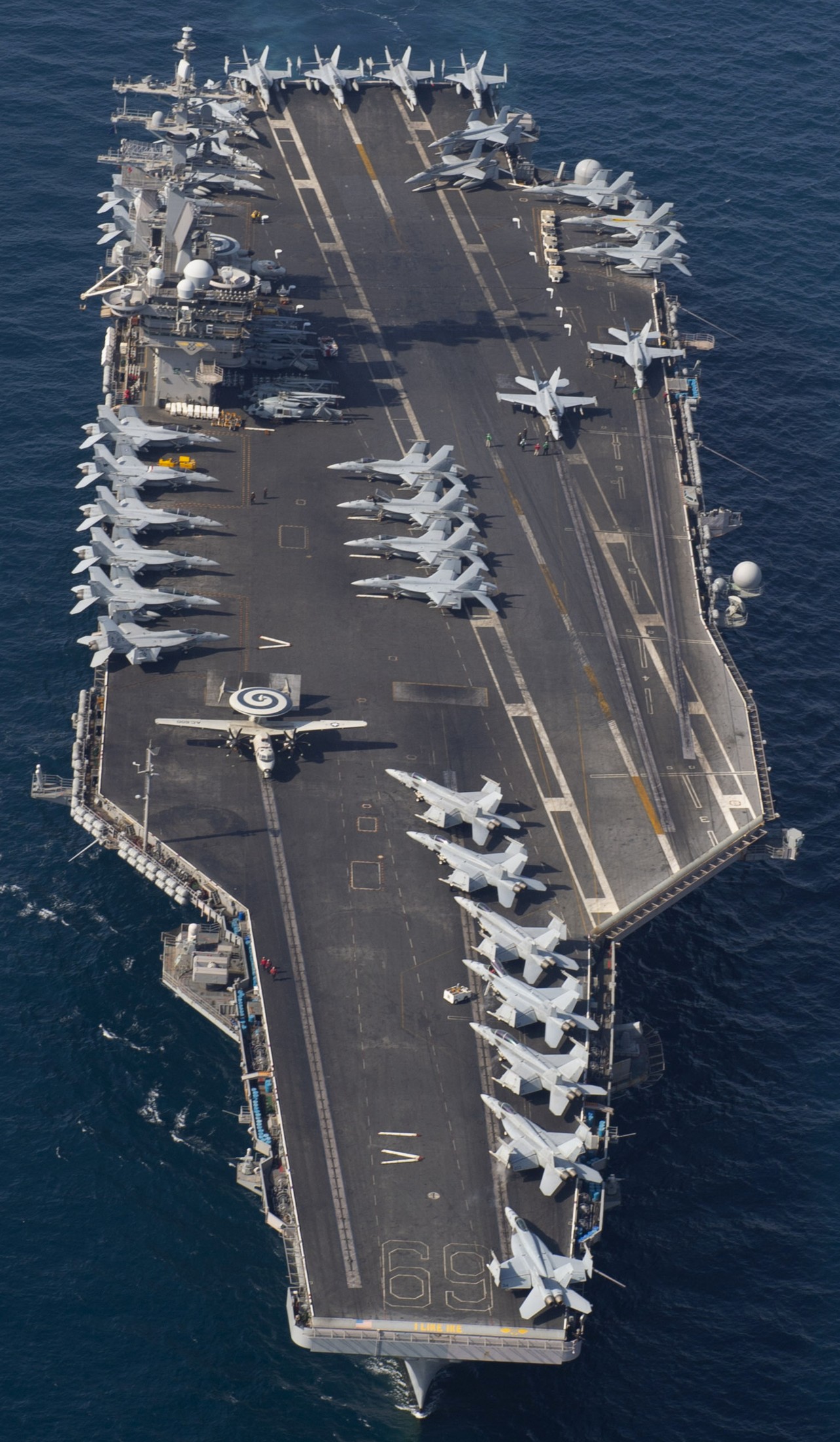 with CVW-3 embarked - Arabian Sea - April 2020 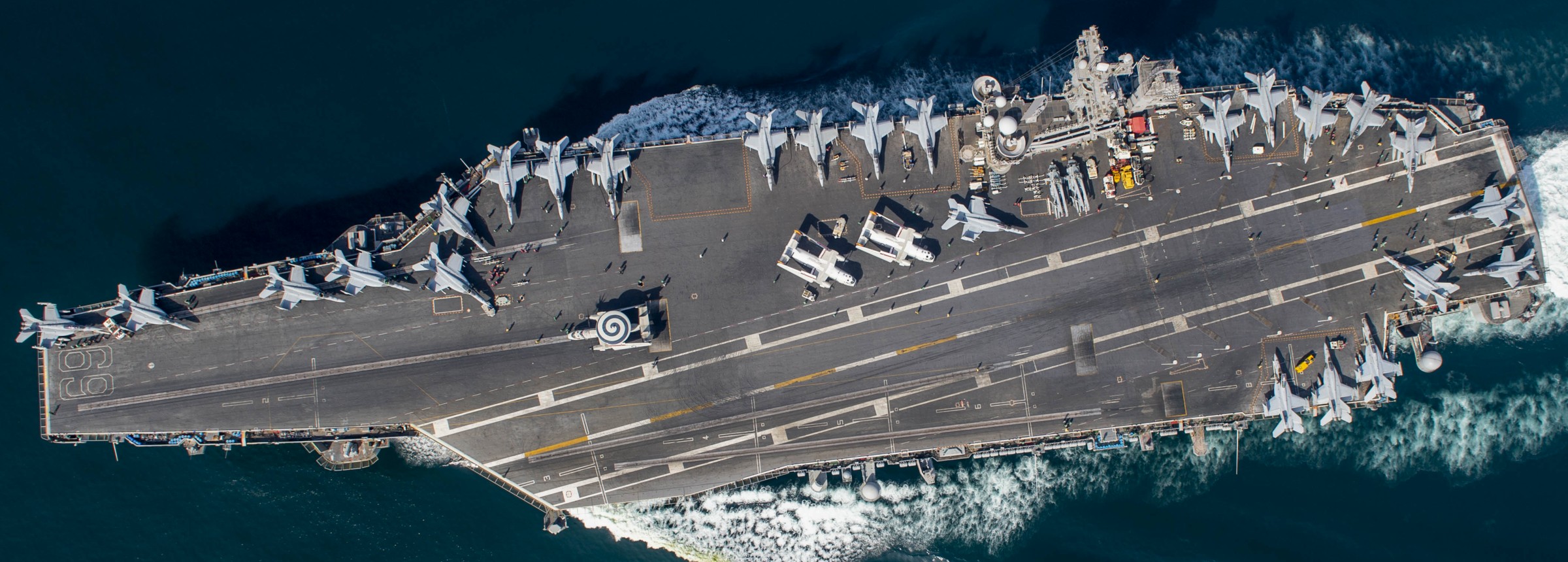 with CVW-3 embarked - Arabian Sea - March 2020 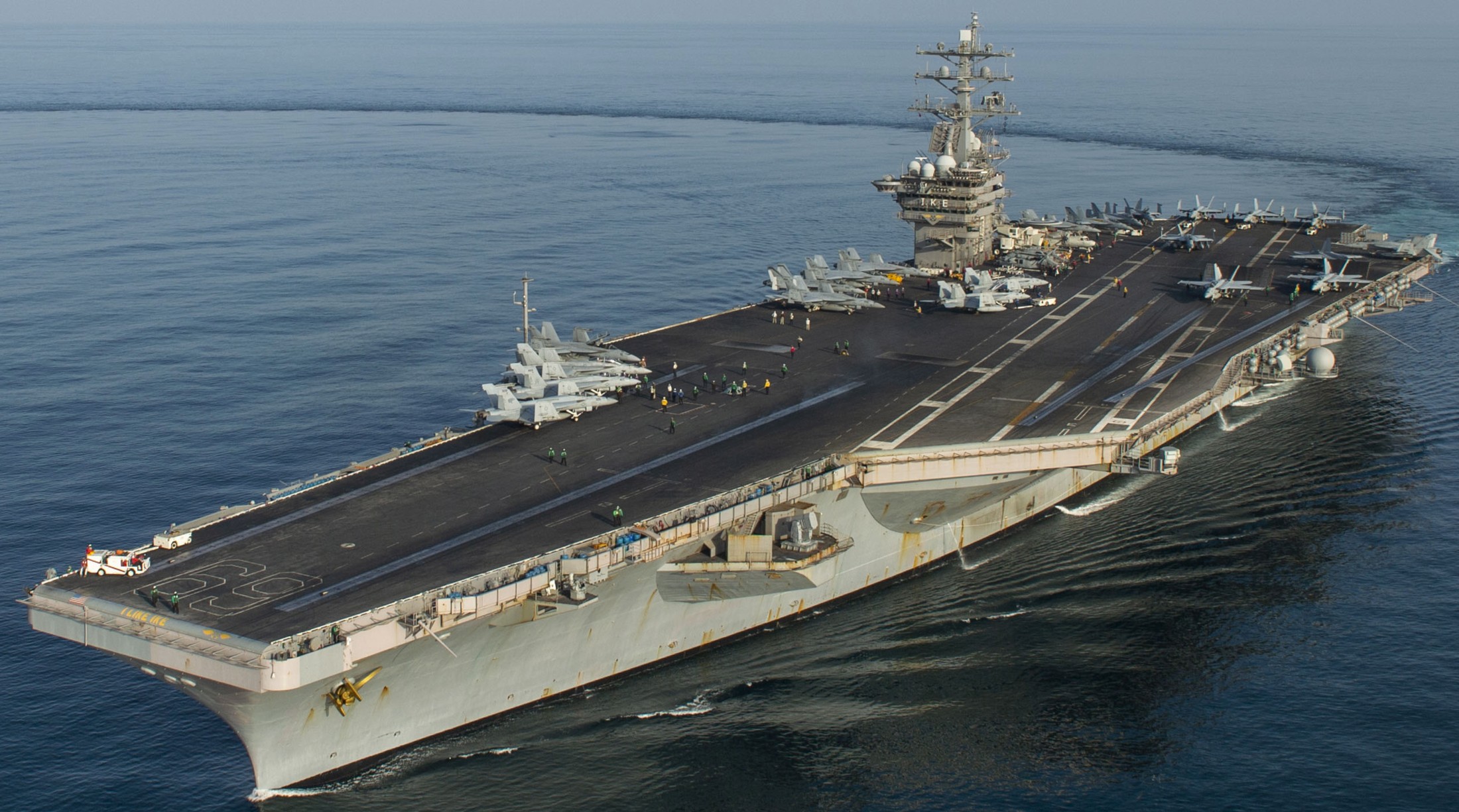 with CVW-3 embarked - Arabian Sea - March 2020 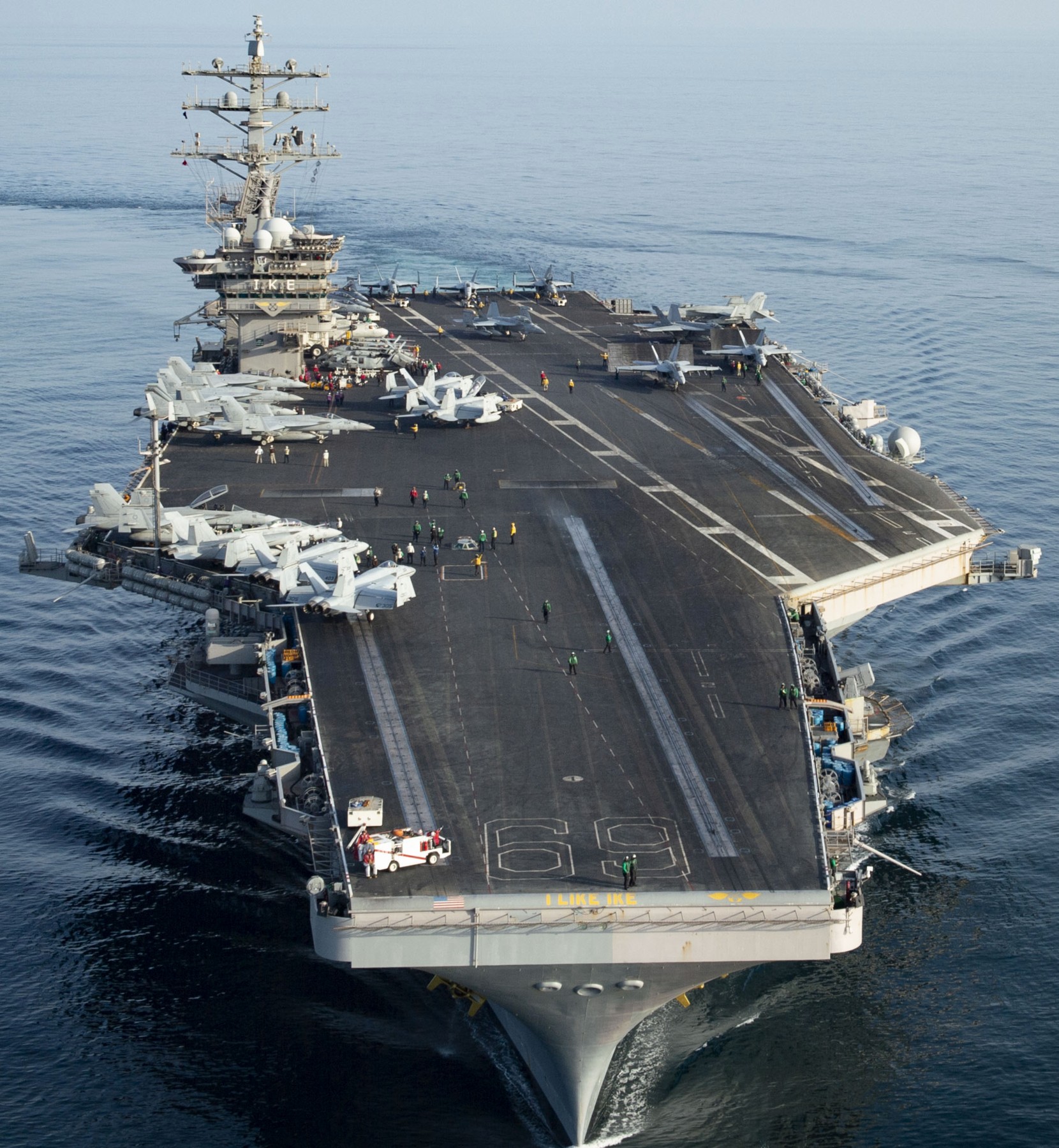 with CVW-3 embarked - Arabian Sea - March 2020 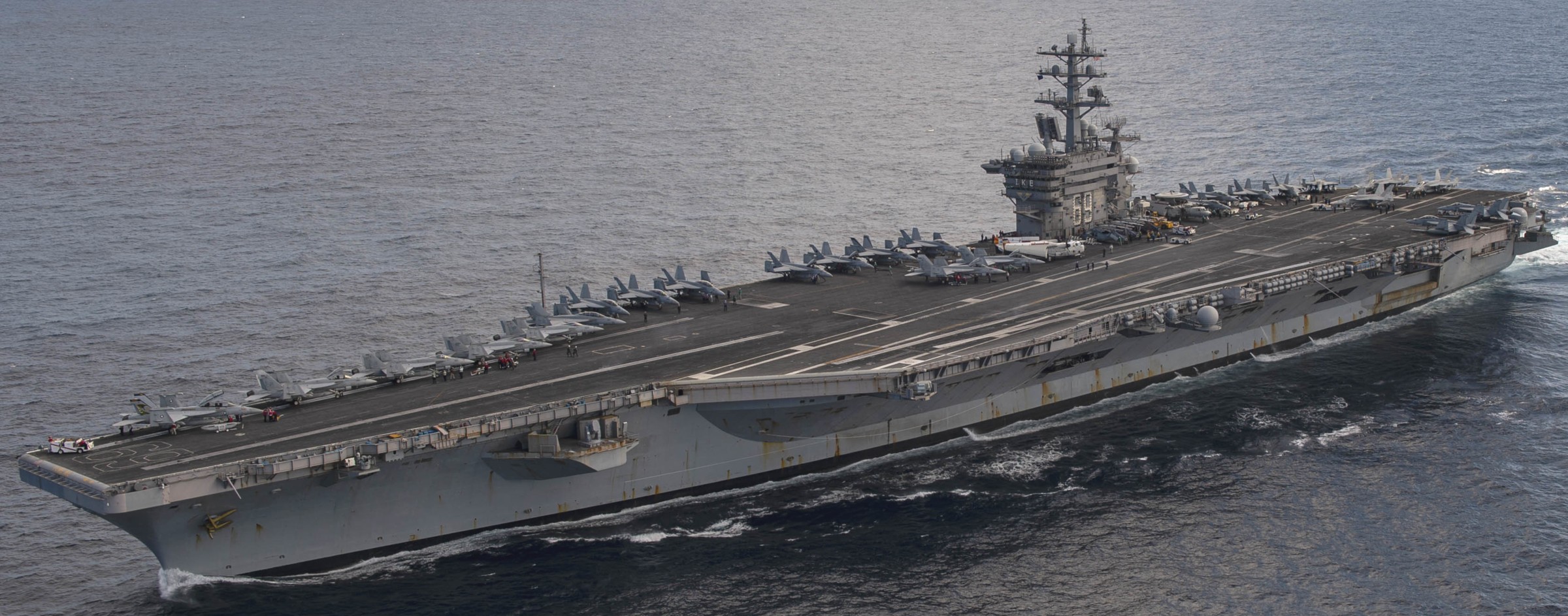 with CVW-3 embarked - Arabian Sea - March 2020  with CVW-3 embarked - Arabian Sea - March 2020 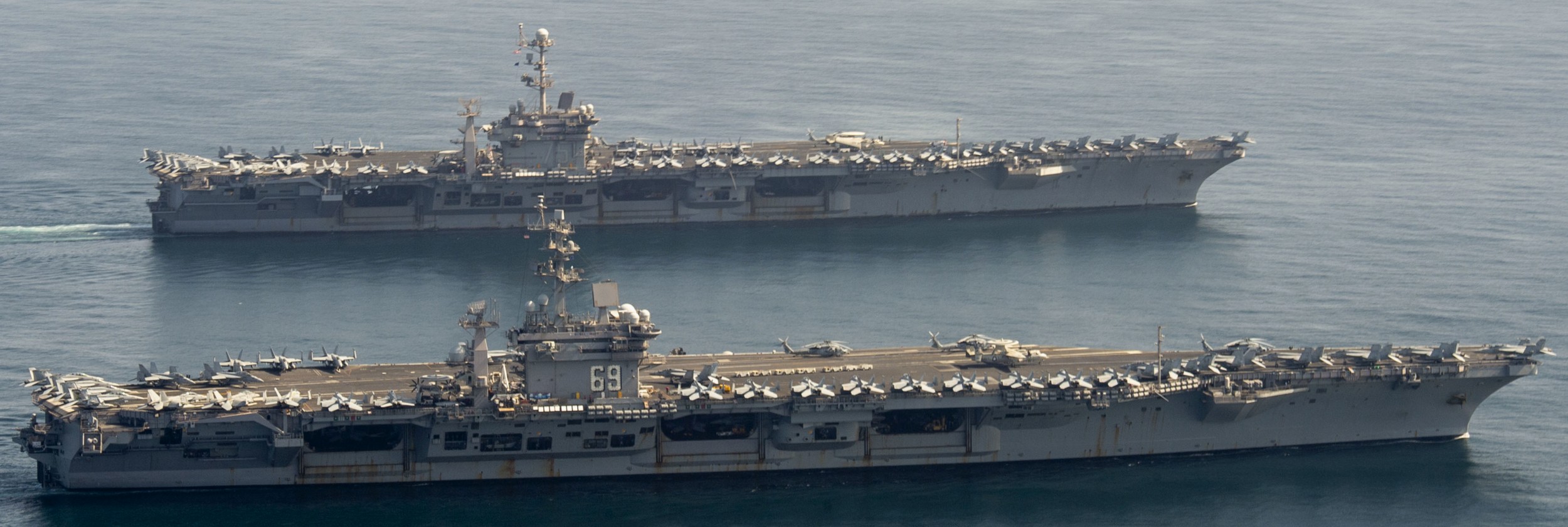 with CVW-3 embarked - alongside USS Harry S. Truman (CVN 75) - Arabian Sea - March 2020 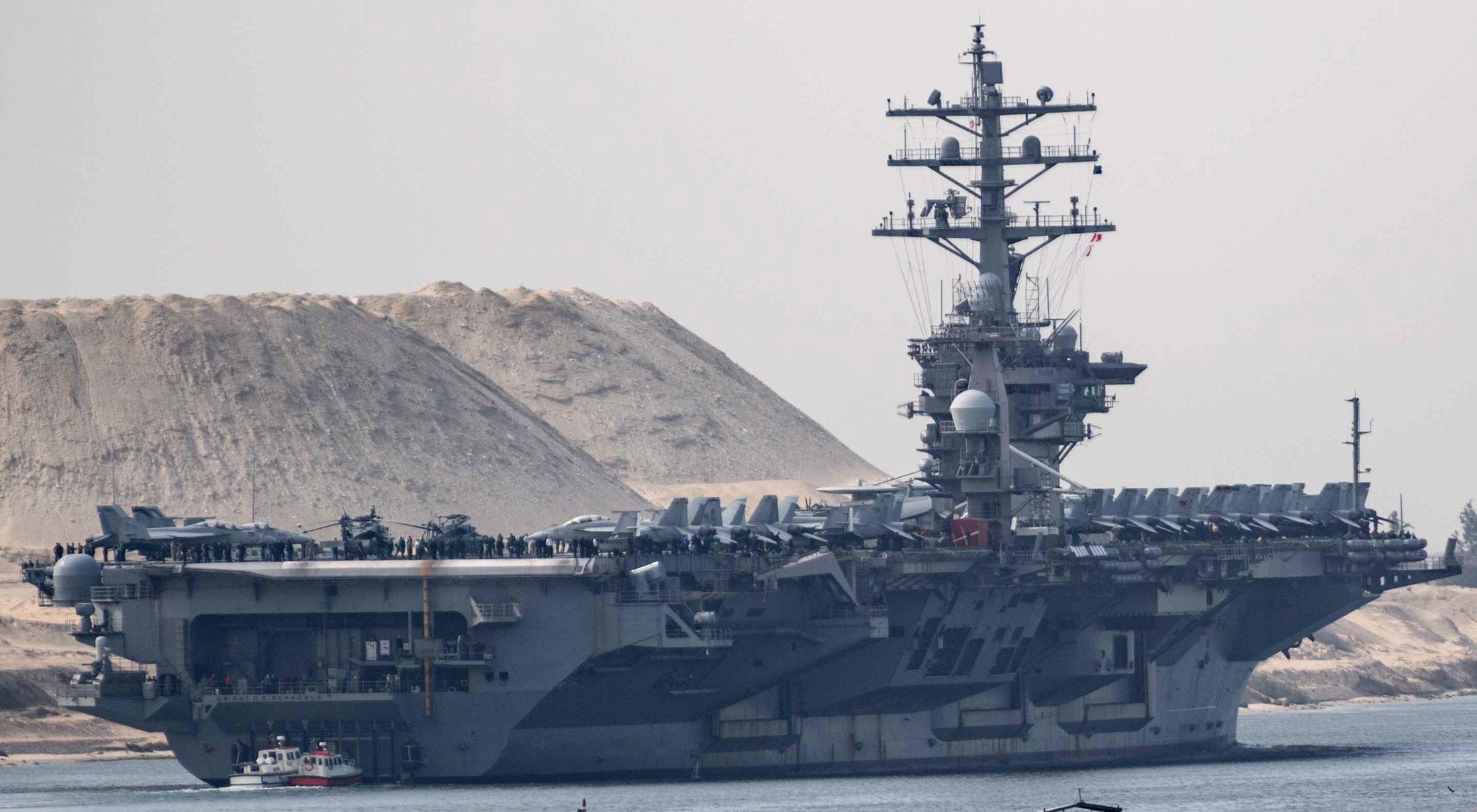 with CVW-3 embarked - Suez Canal - March 2020 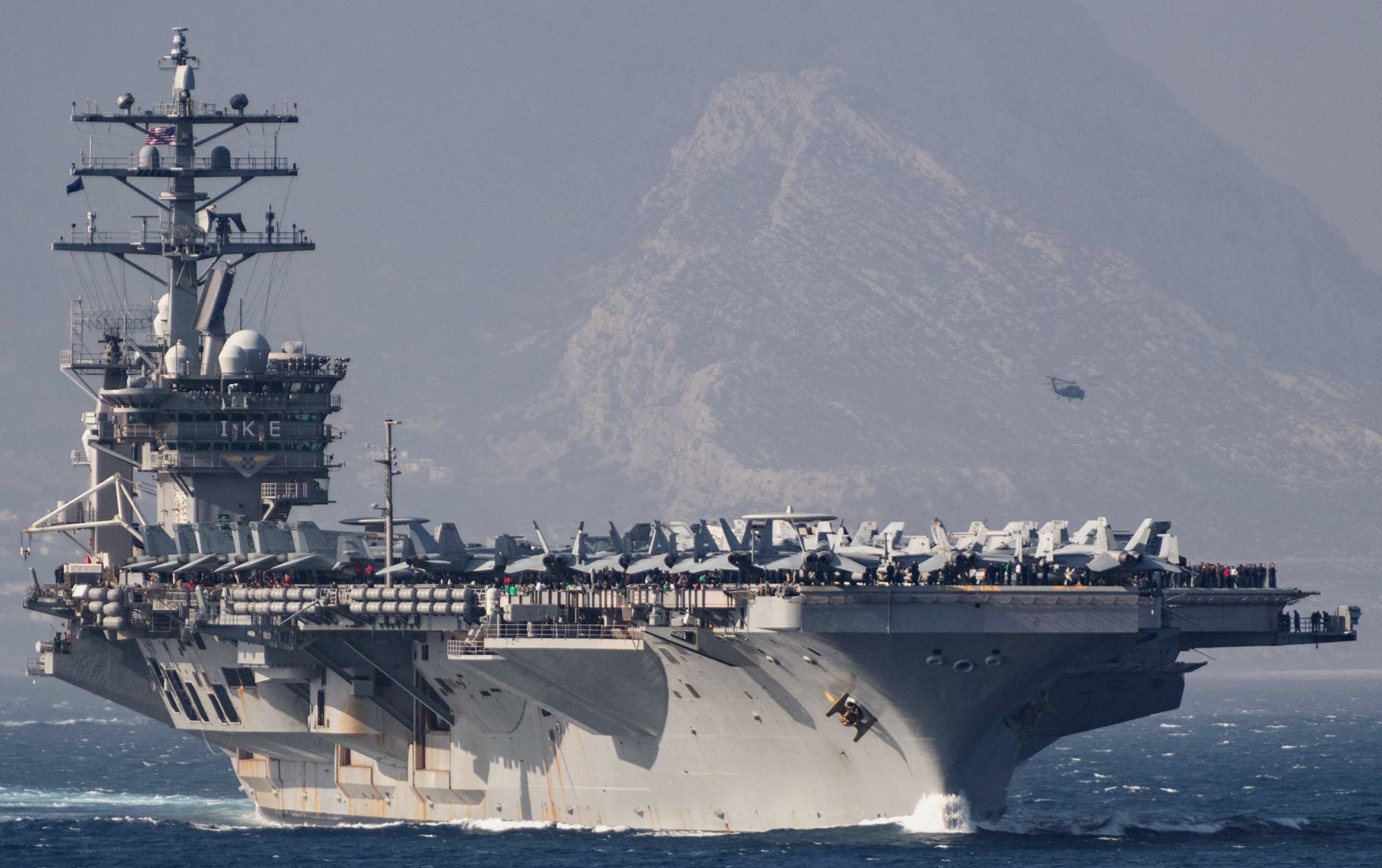 with CVW-3 embarked - Strait of Gibraltar - February 2020 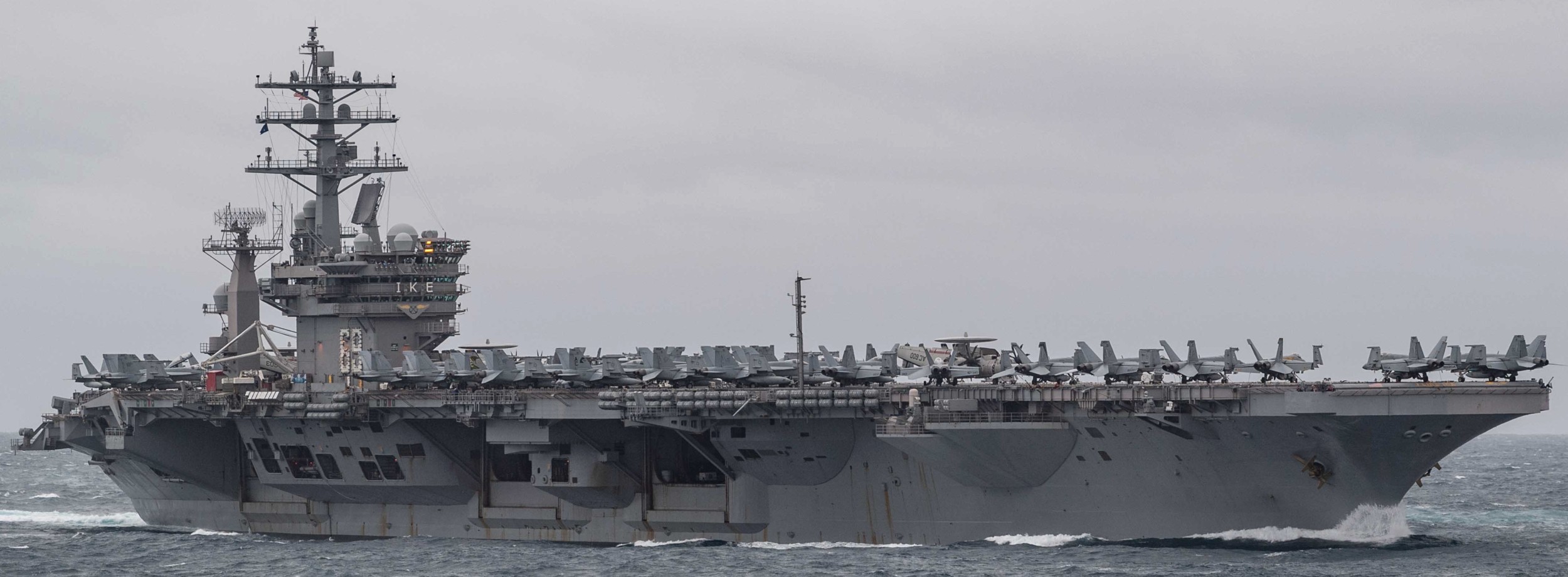 with CVW-3 embarked - Atlantic Ocean - January 2020 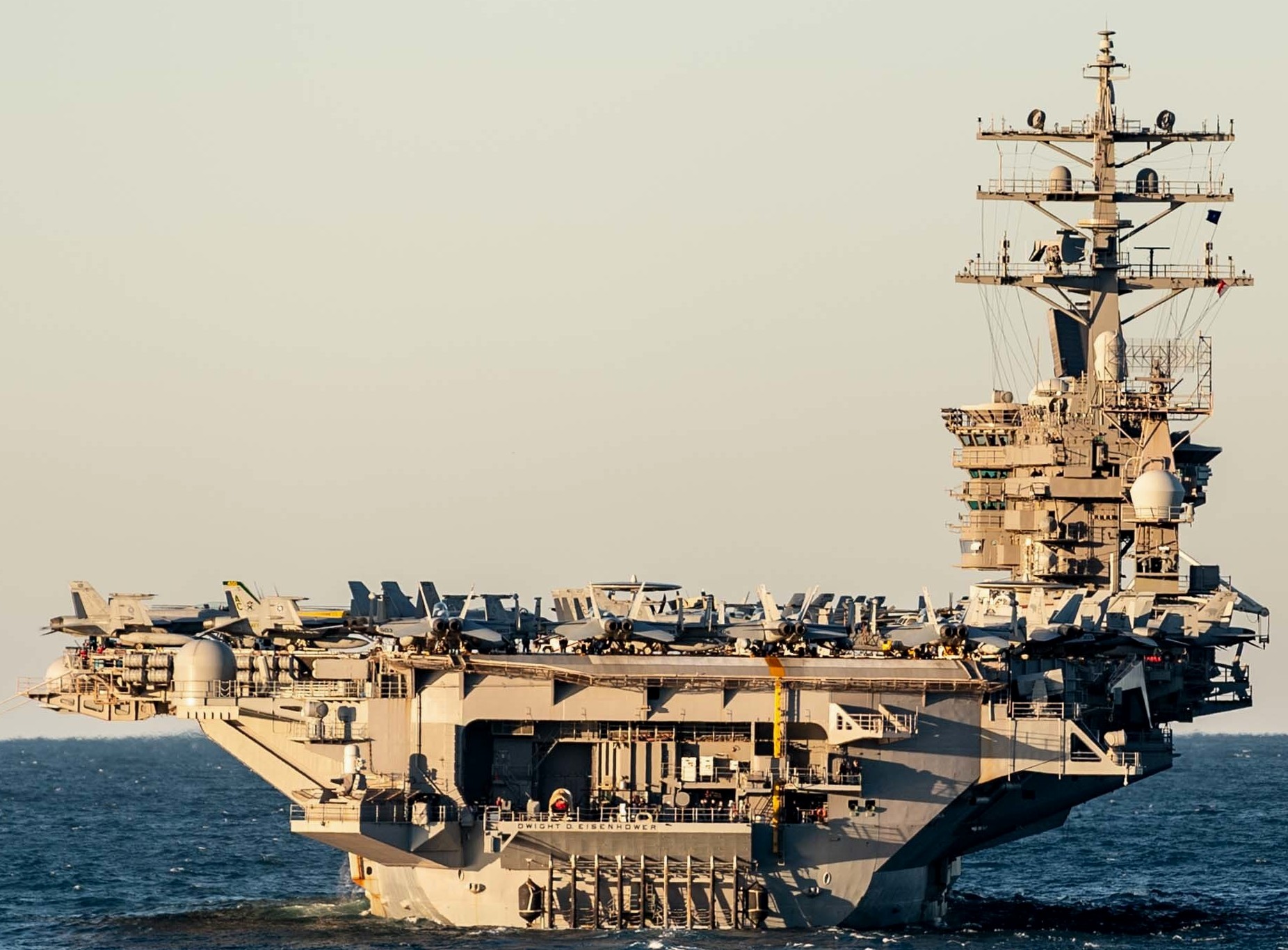 with CVW-3 embarked - Atlantic Ocean - January 2020 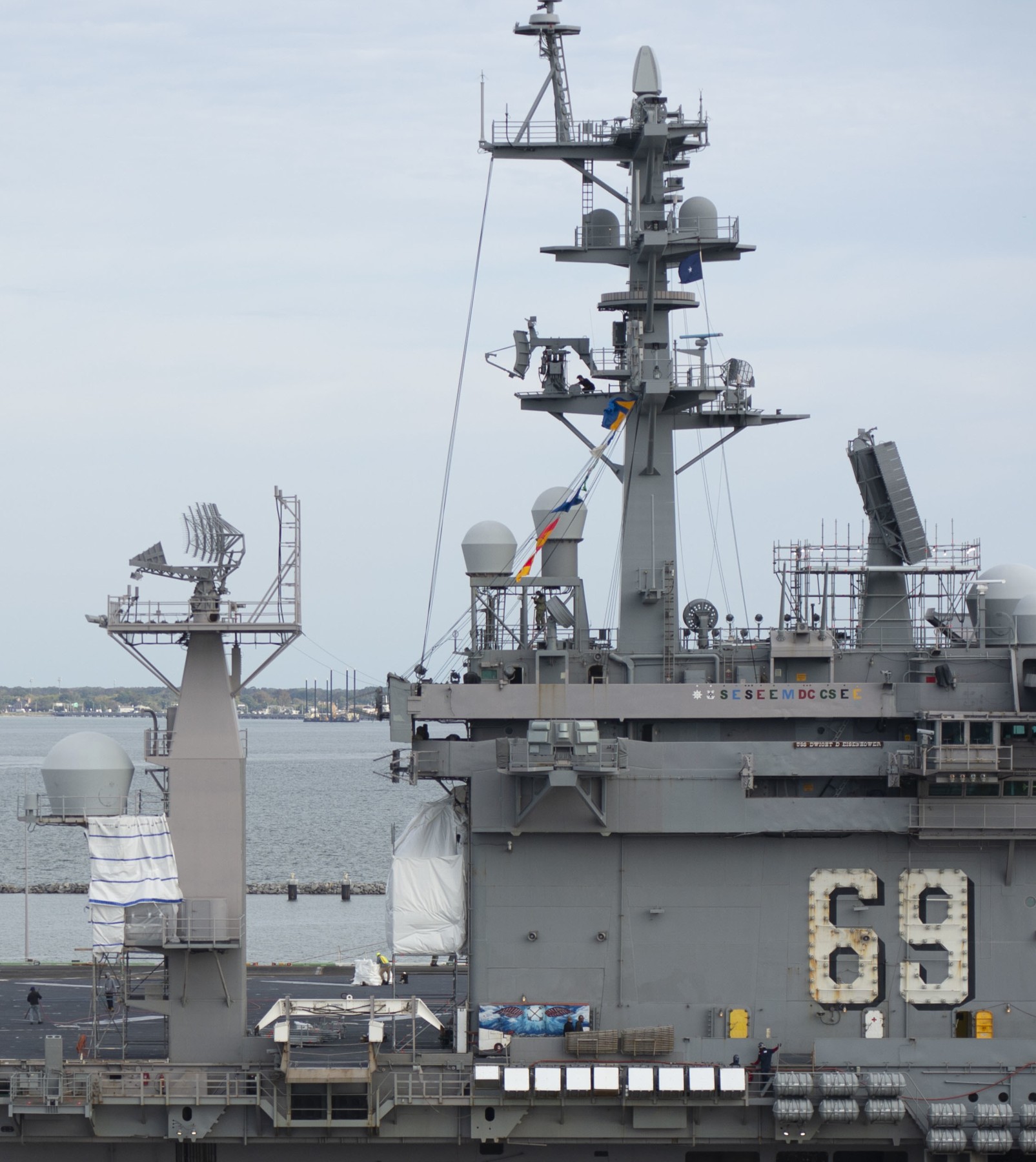 Naval Station Norfolk, Virginia - October 2019 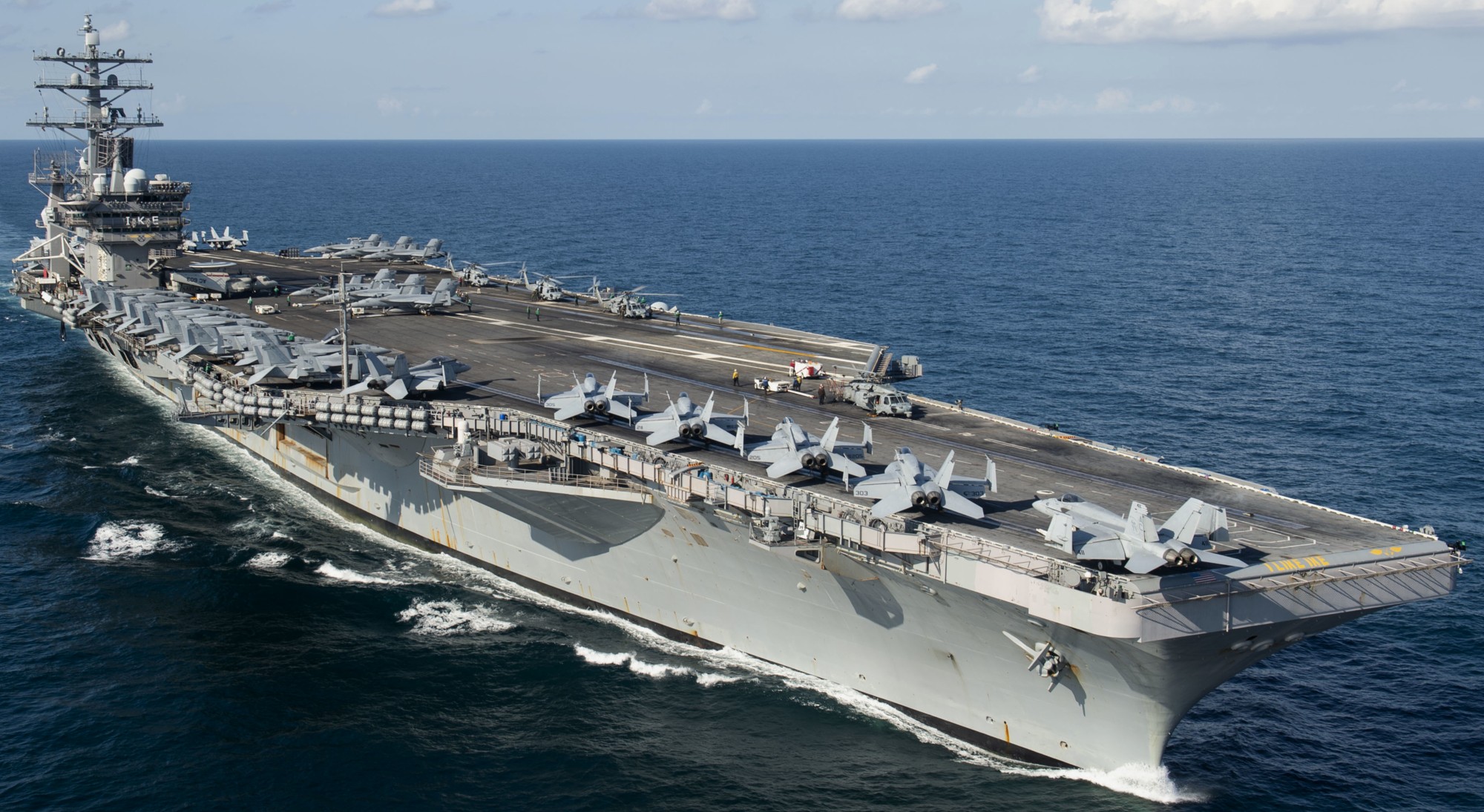 with CVW-3 embarked - Tailored Ship's Training Availability and Final Evaluation Problem (TSTA/FEP) - Atlantic Ocean - September 2019 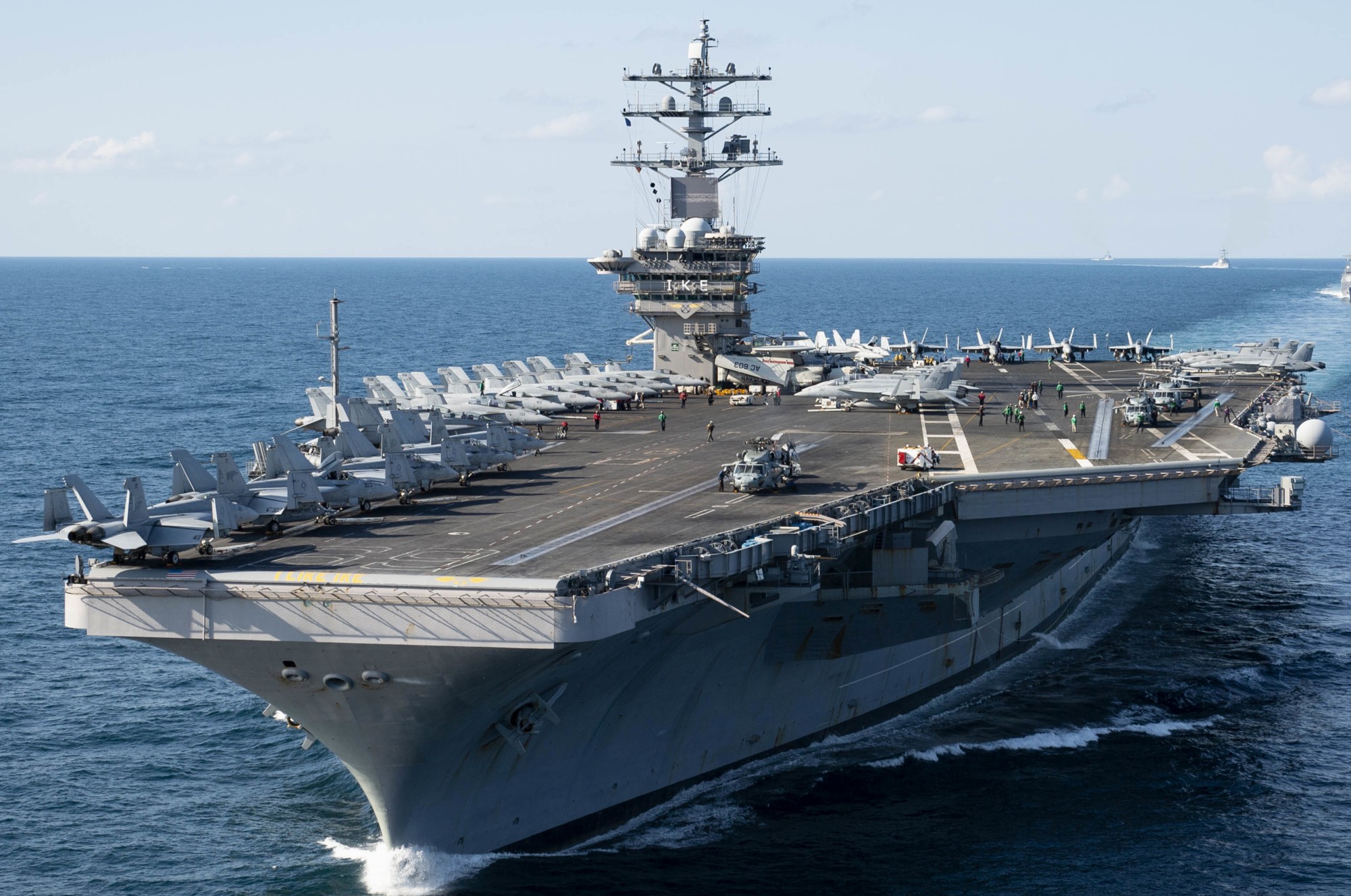 with CVW-3 embarked - Tailored Ship's Training Availability and Final Evaluation Problem (TSTA/FEP) - Atlantic Ocean - September 2019 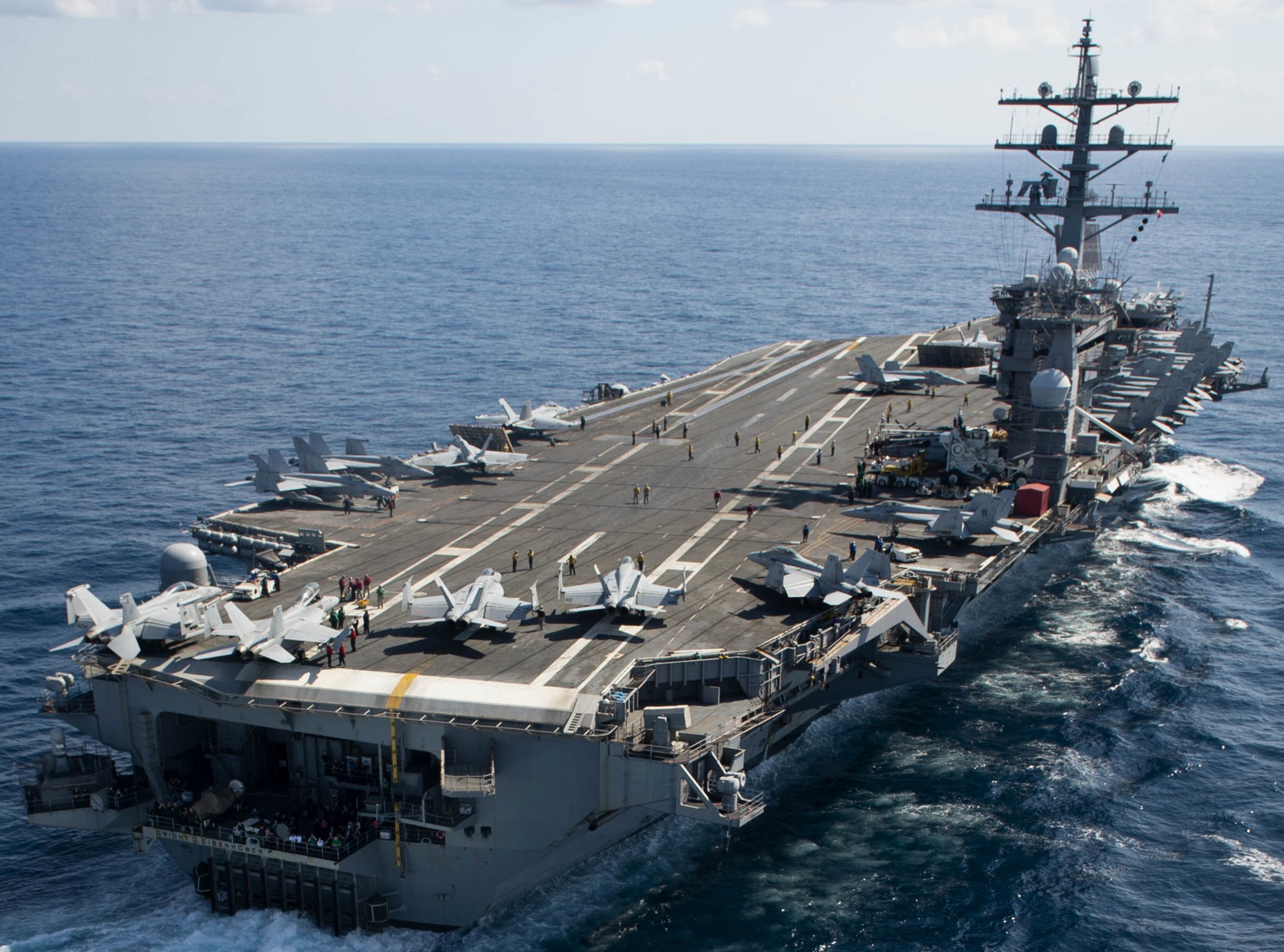 with CVW-3 embarked - Tailored Ship's Training Availability and Final Evaluation Problem (TSTA/FEP) - Atlantic Ocean - September 2019 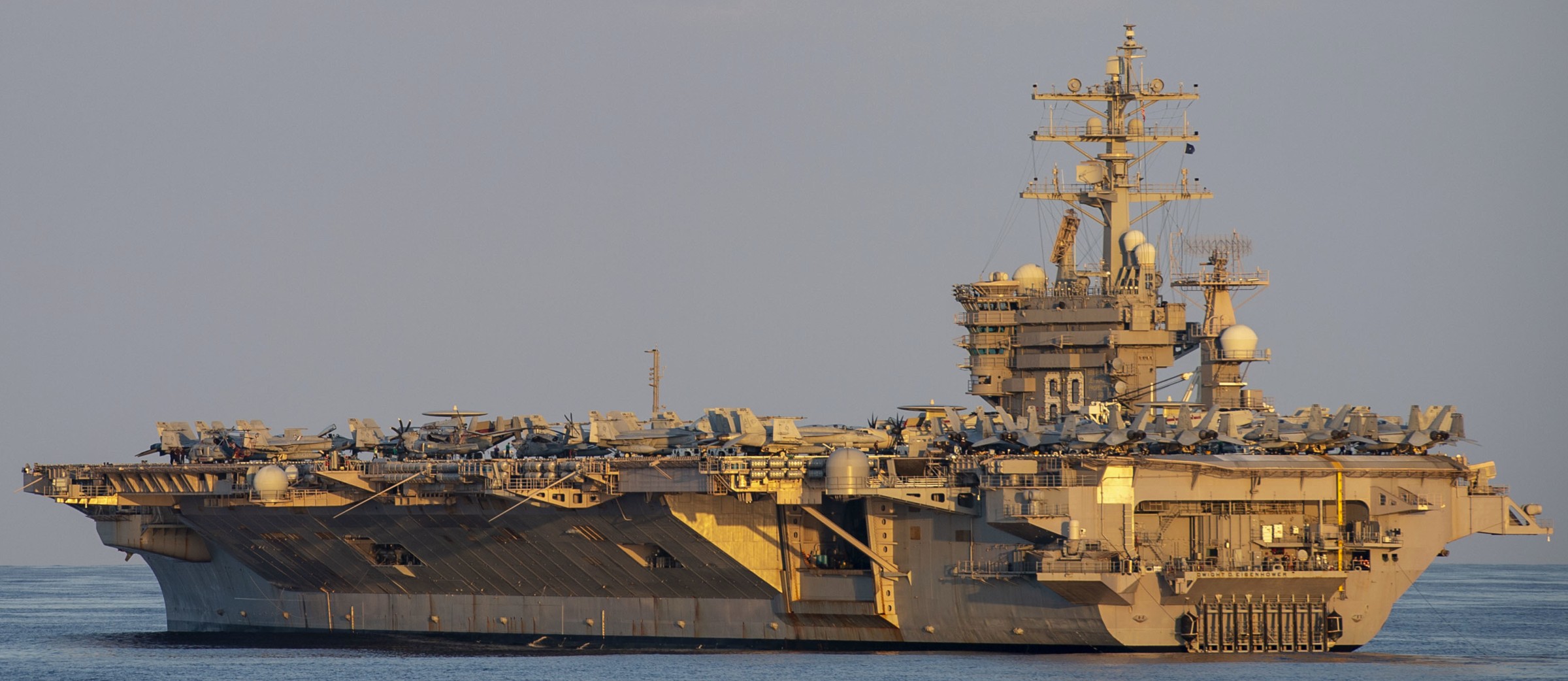 with CVW-3 embarked - Tailored Ship's Training Availability and Final Evaluation Problem (TSTA/FEP) - Atlantic Ocean - September 2019 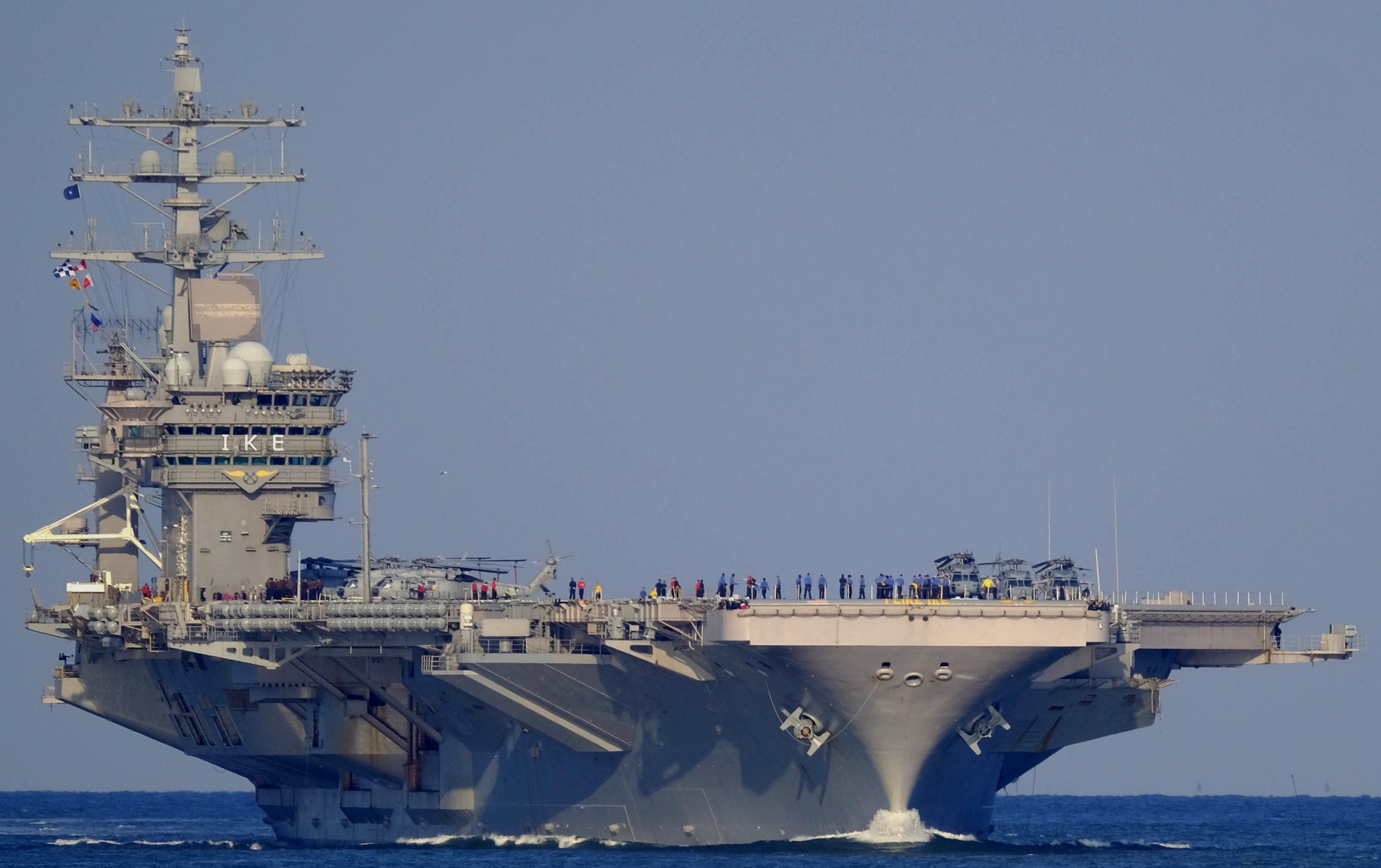 returning to Naval Station Norfolk, Virginia after Hurricane Dorian - September 7, 2019  returning to Naval Station Norfolk, Virginia after Hurricane Dorian - September 7, 2019  returning to Naval Station Norfolk, Virginia after Hurricane Dorian - September 7, 2019  departing Naval Station Norfolk, Virginia in preparation for Hurricane Dorian - September 4, 2019 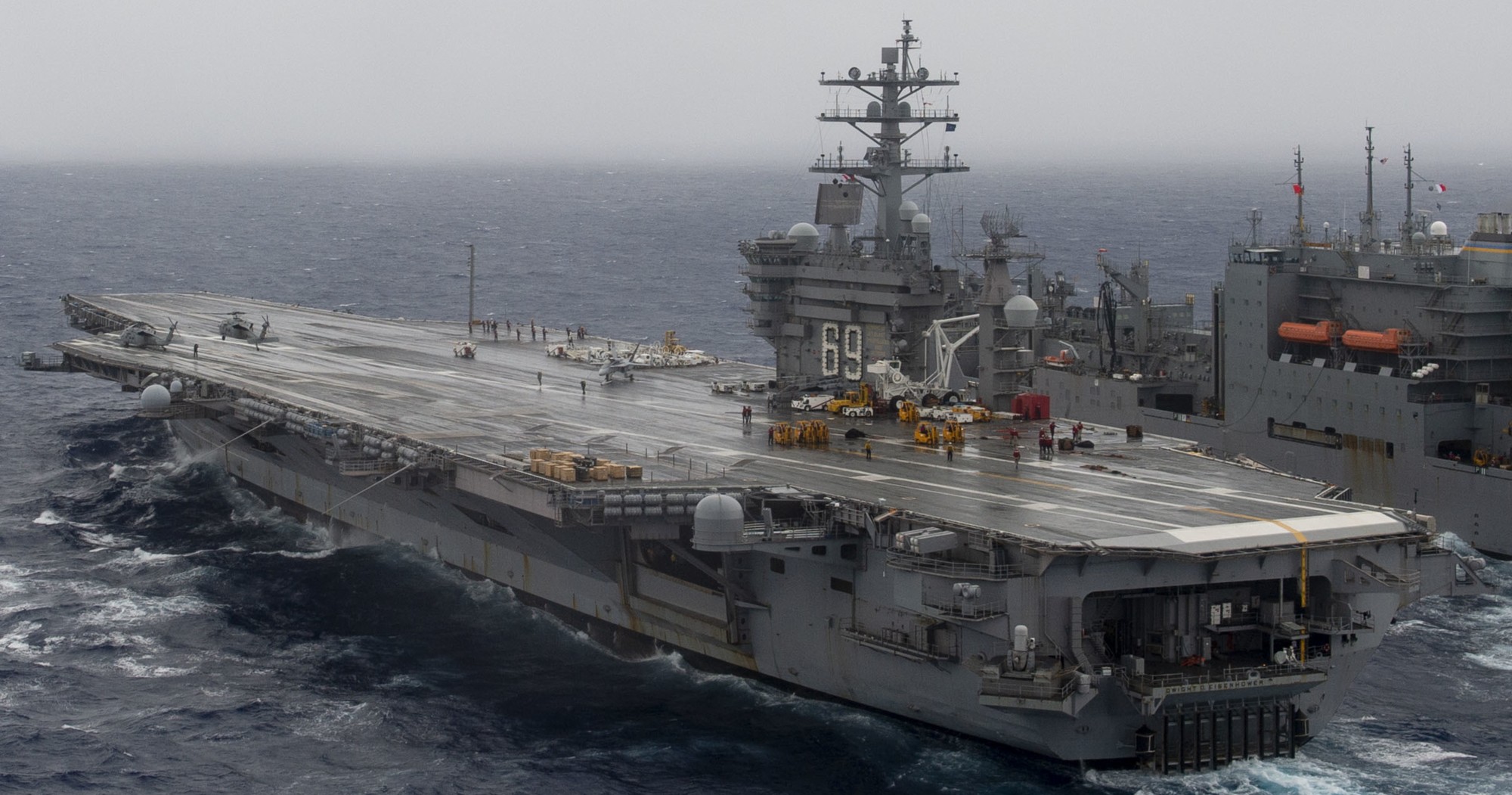 ammunition onload - Atlantic Ocean - August 2019  ammunition onload - Atlantic Ocean - August 2019  ammunition onload - Atlantic Ocean - August 2019 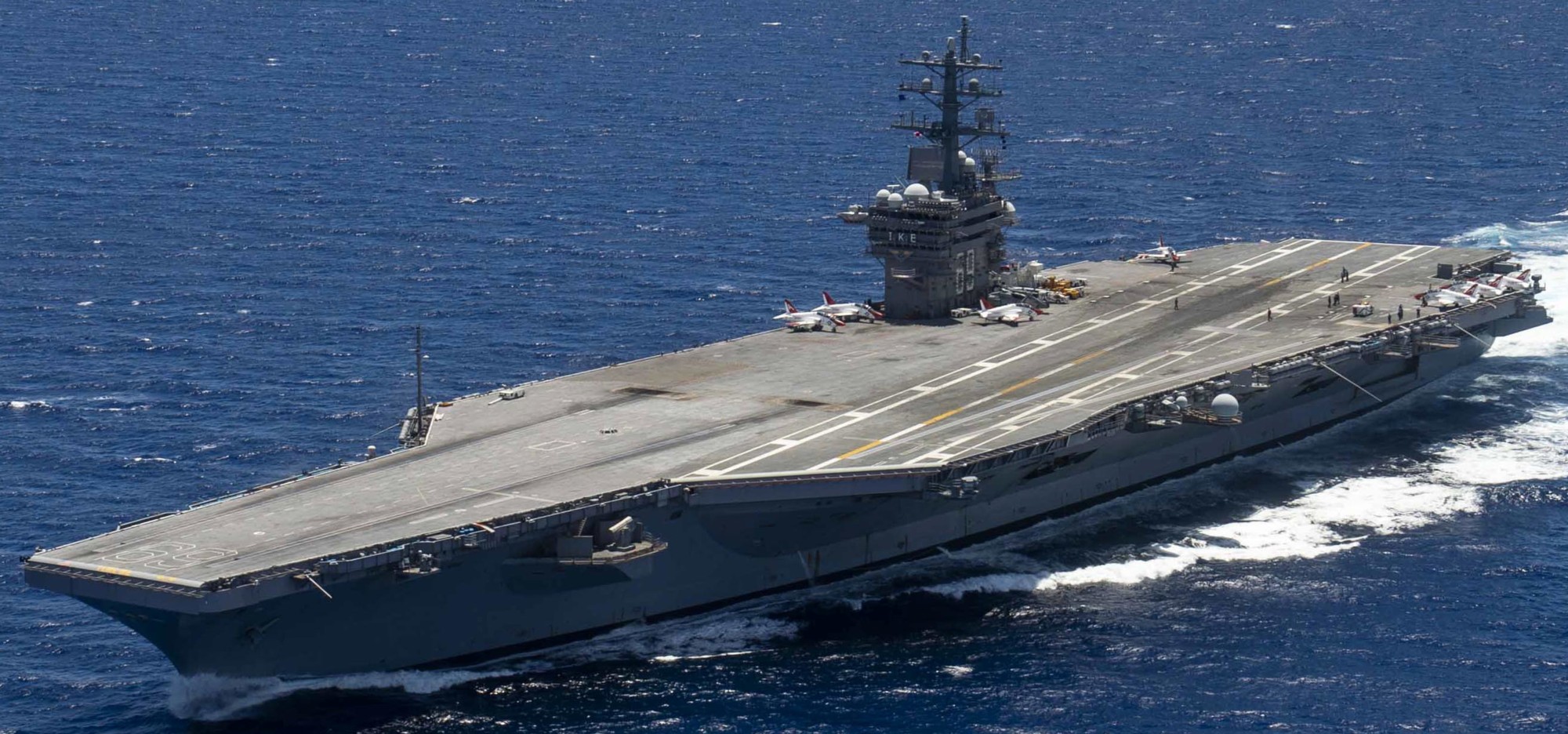 carrier qualifications - Atlantic Ocean - July 2019 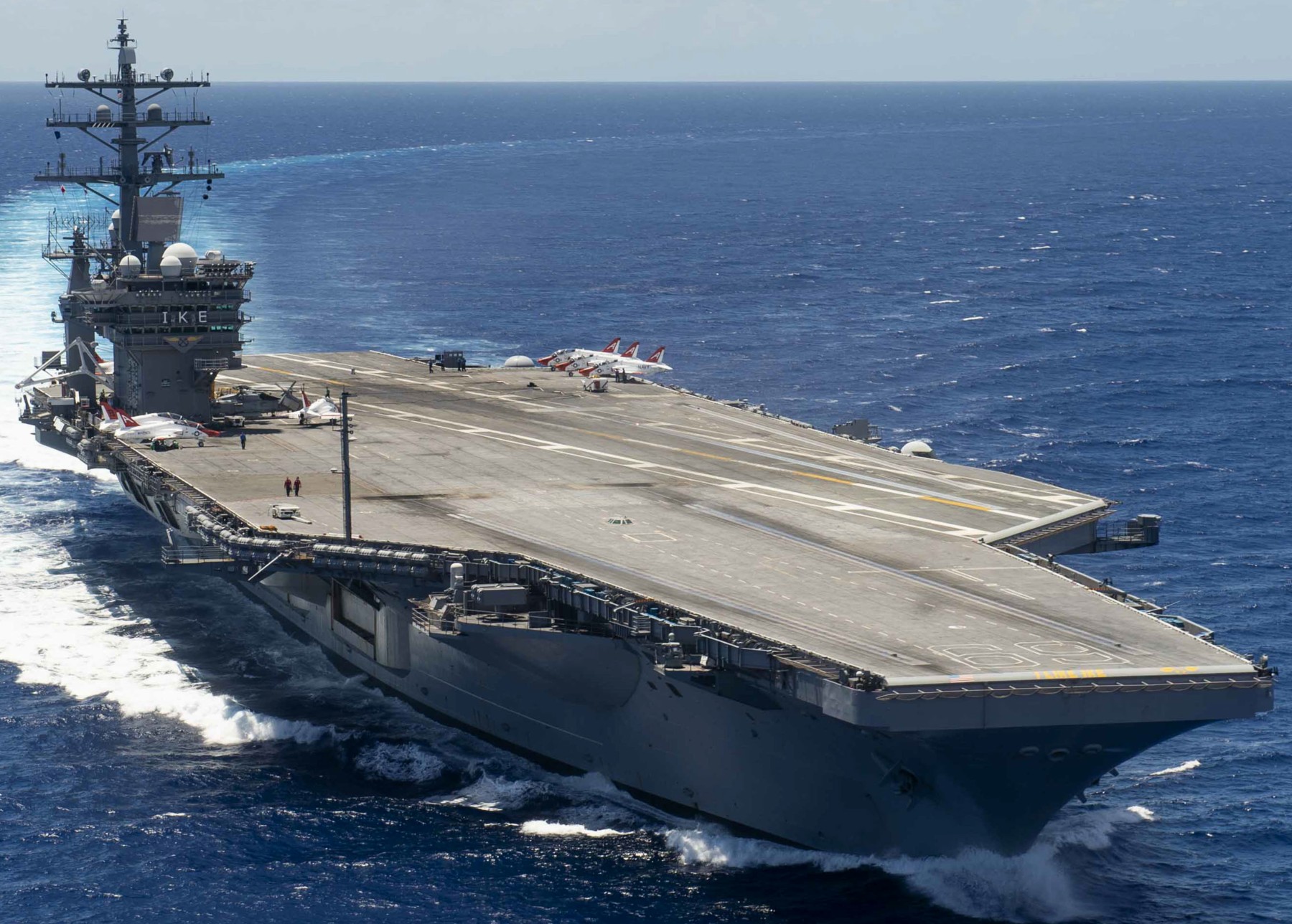 carrier qualifications - Atlantic Ocean - July 2019  carrier qualifications - Atlantic Ocean - July 2019  carrier qualifications - Atlantic Ocean - July 2019 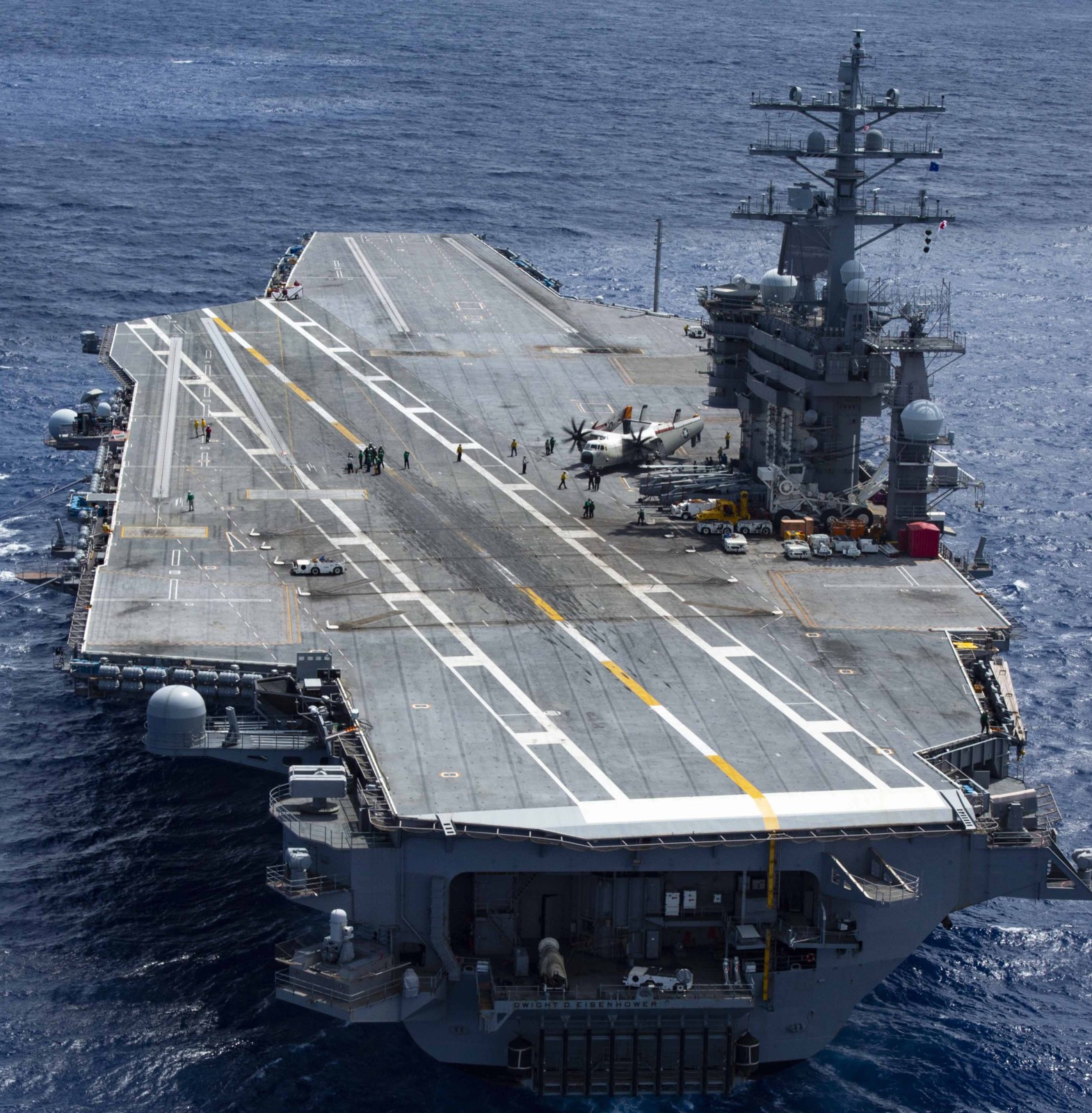 carrier qualifications - Atlantic Ocean - June 2019 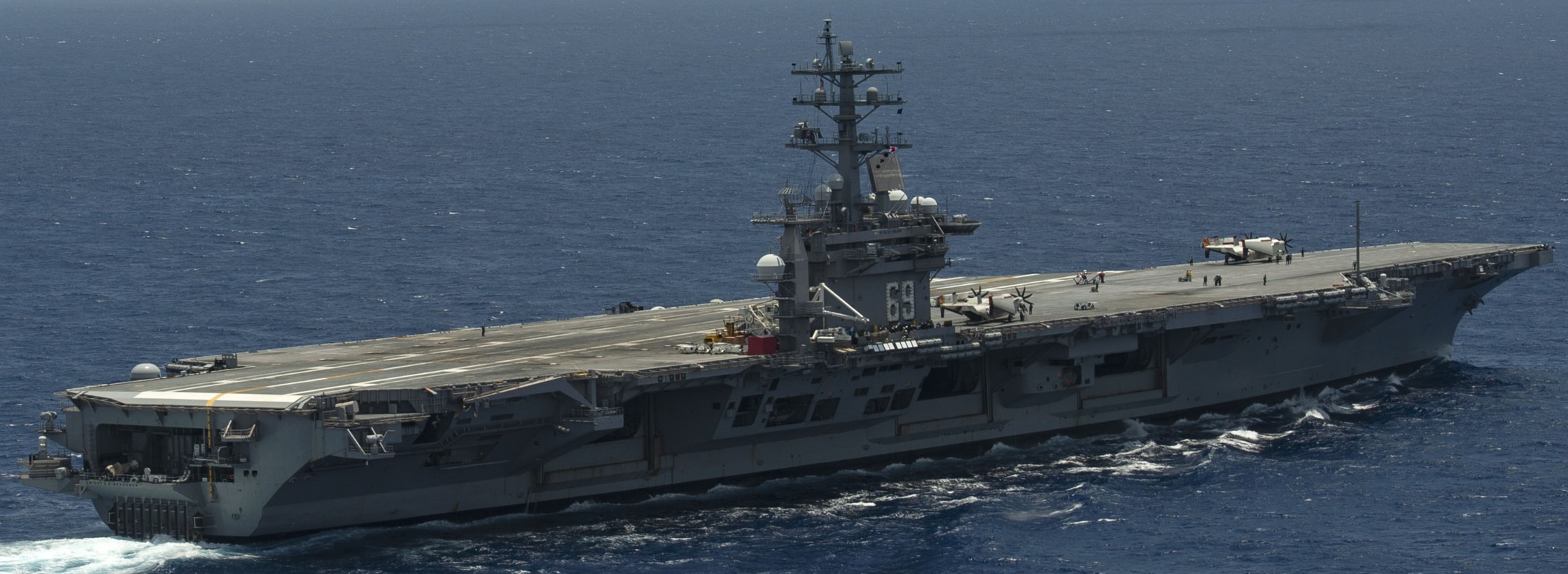 carrier qualifications - Atlantic Ocean - June 2019 Planned Incremental Availability (PIA) at Norfolk Naval Shipyard, Virginia / August 2017 - March 2019 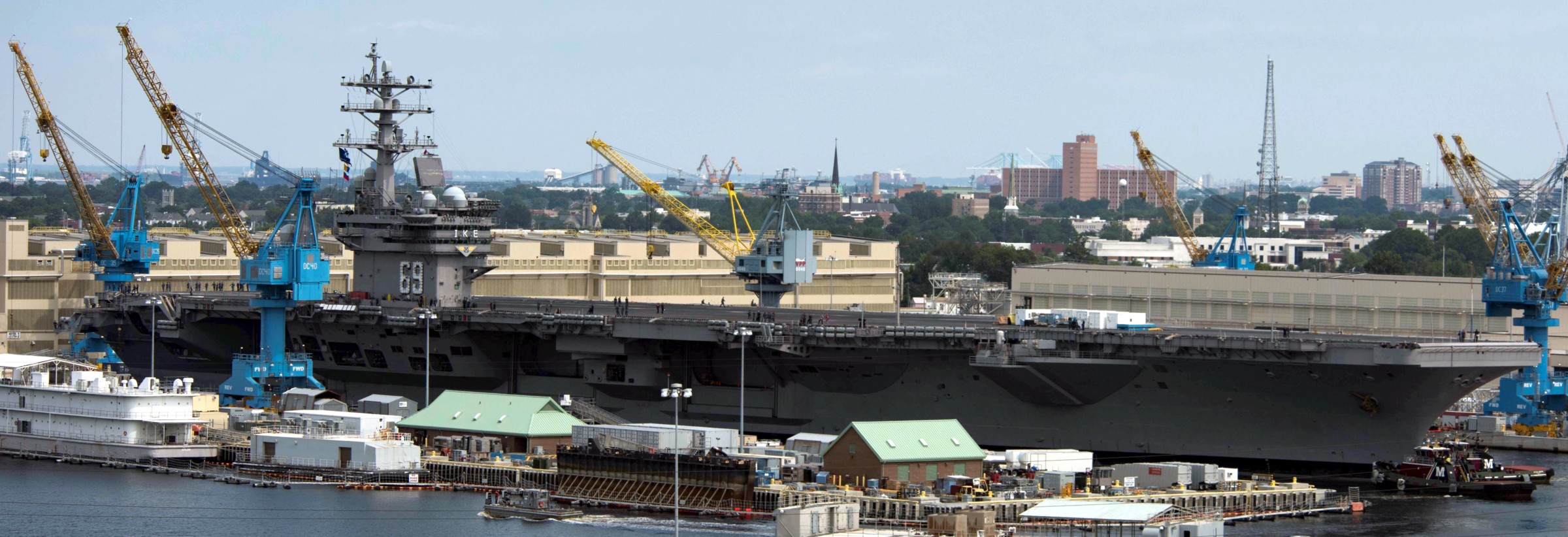 USS Dwight D. Eisenhower (CVN 69) arrives at Norfolk Naval Shipyard in Portsmouth, Virginia. The ship is preparing for a planned incremental availability (PIA) - August 5, 2017 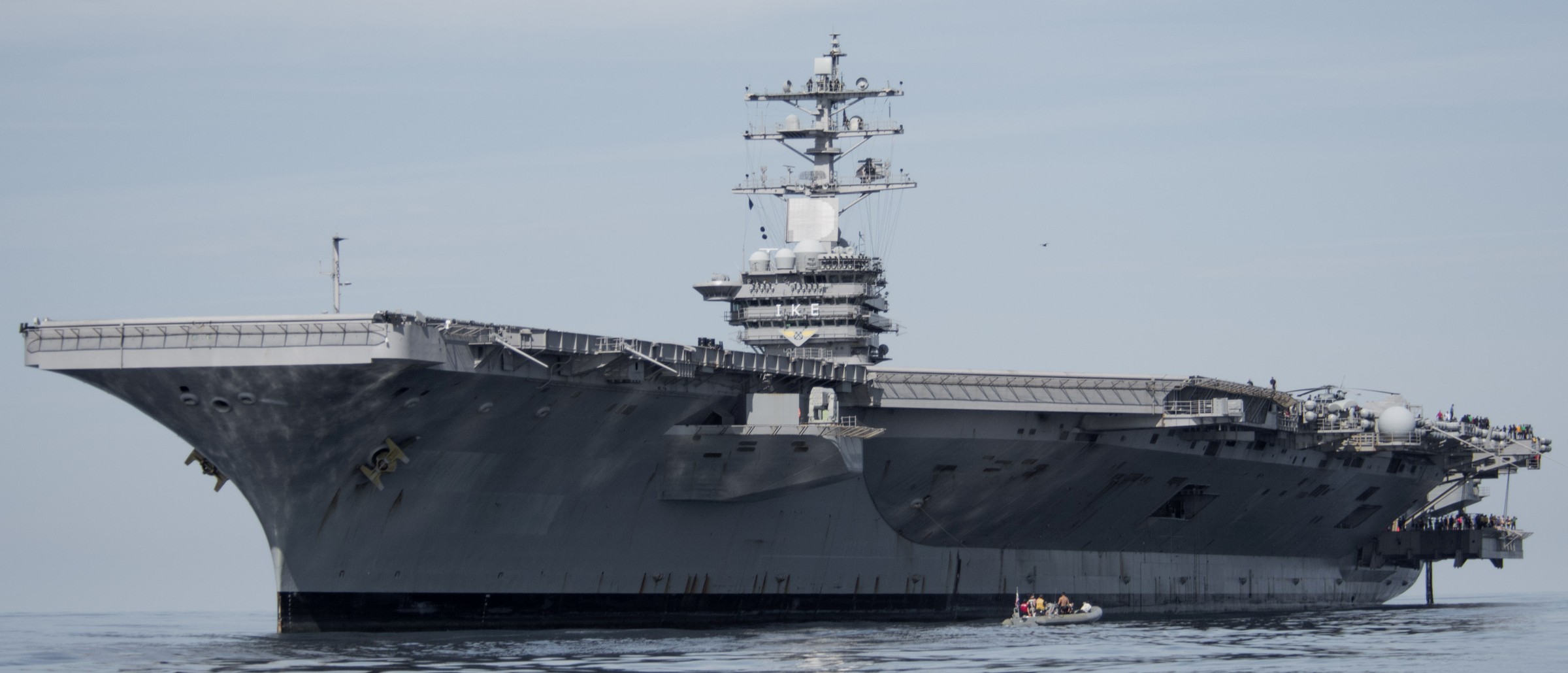 Atlantic Ocean - August 2017 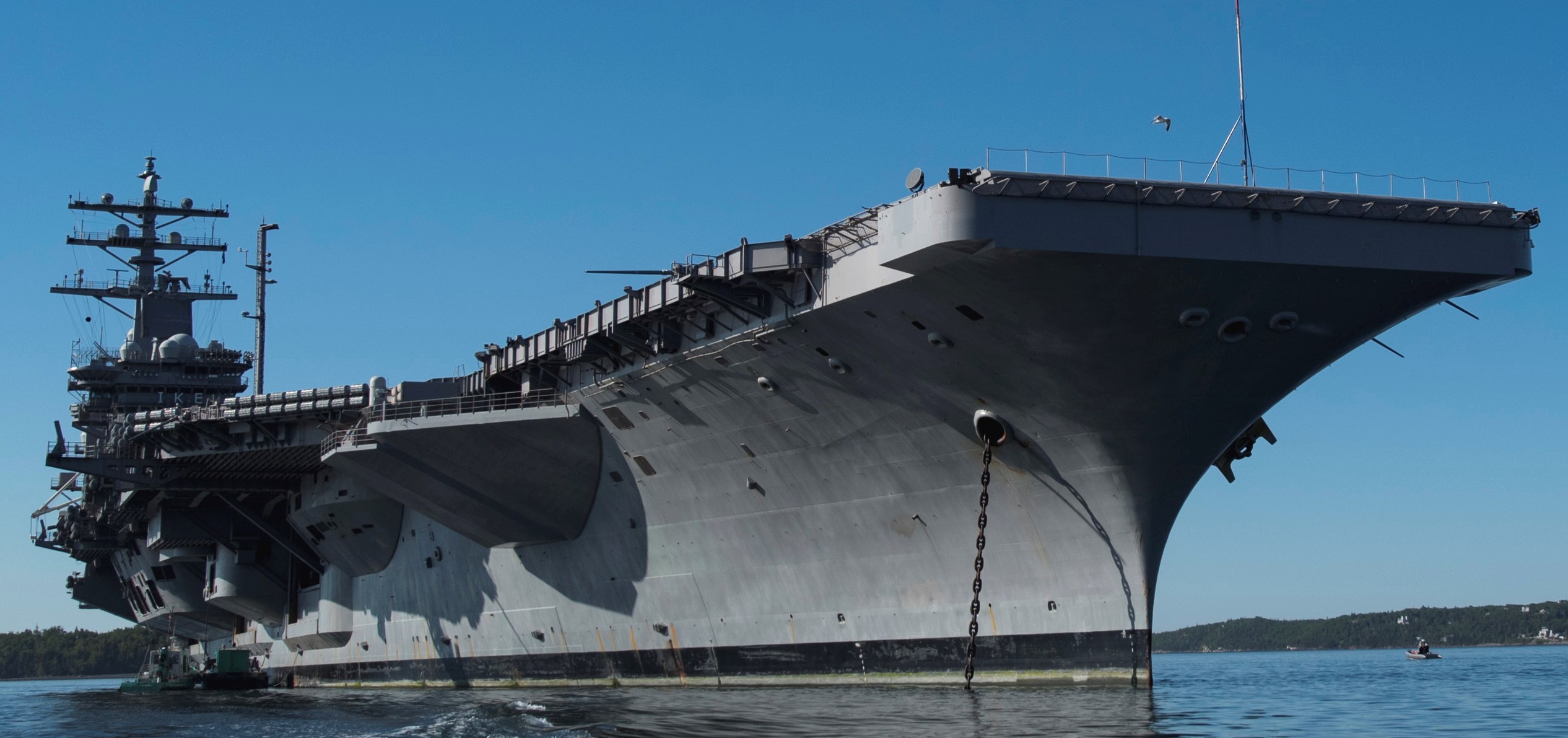 Halifax, Nova Scotia, Canada - June 2017 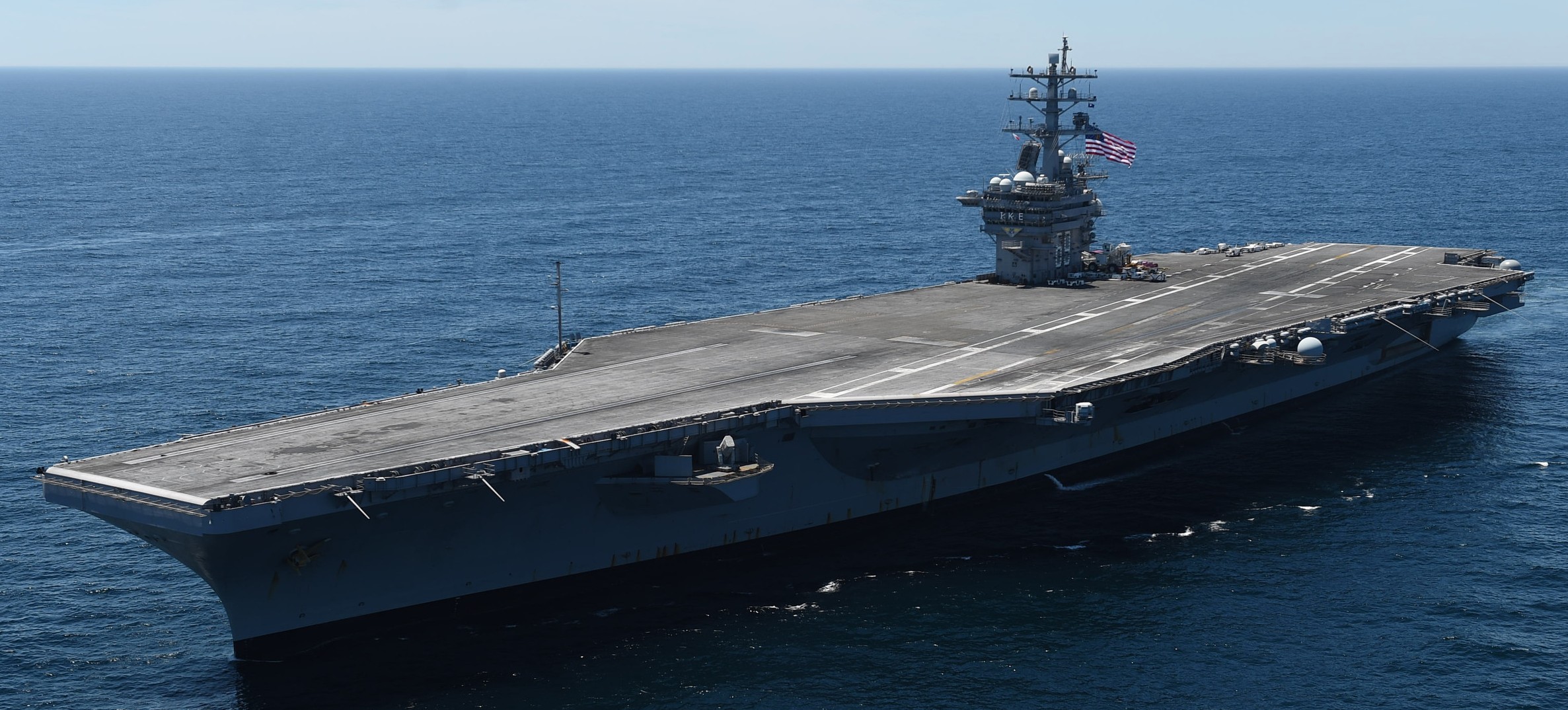 Atlantic Ocean - June 2017 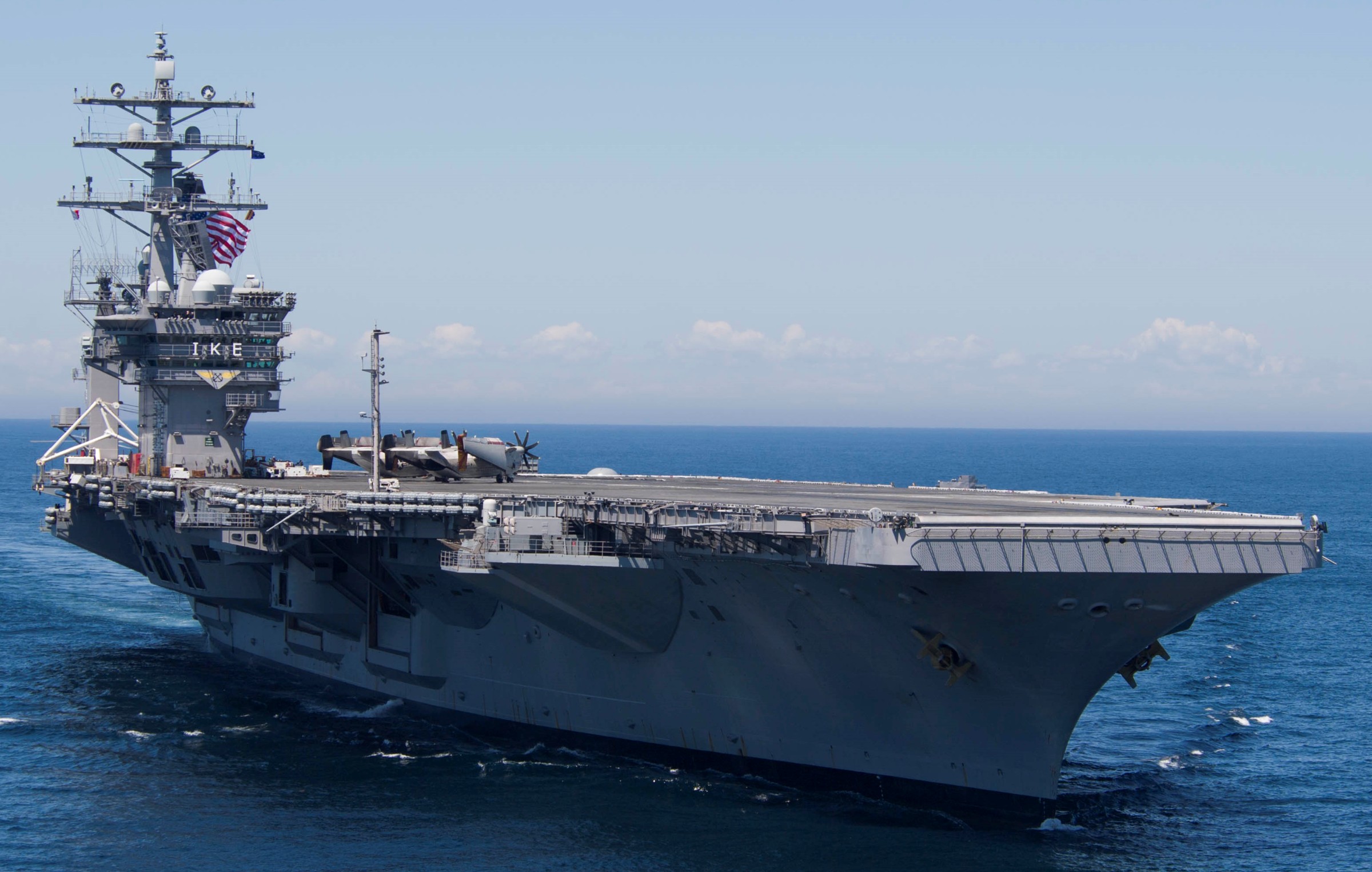 Atlantic Ocean - June 2017 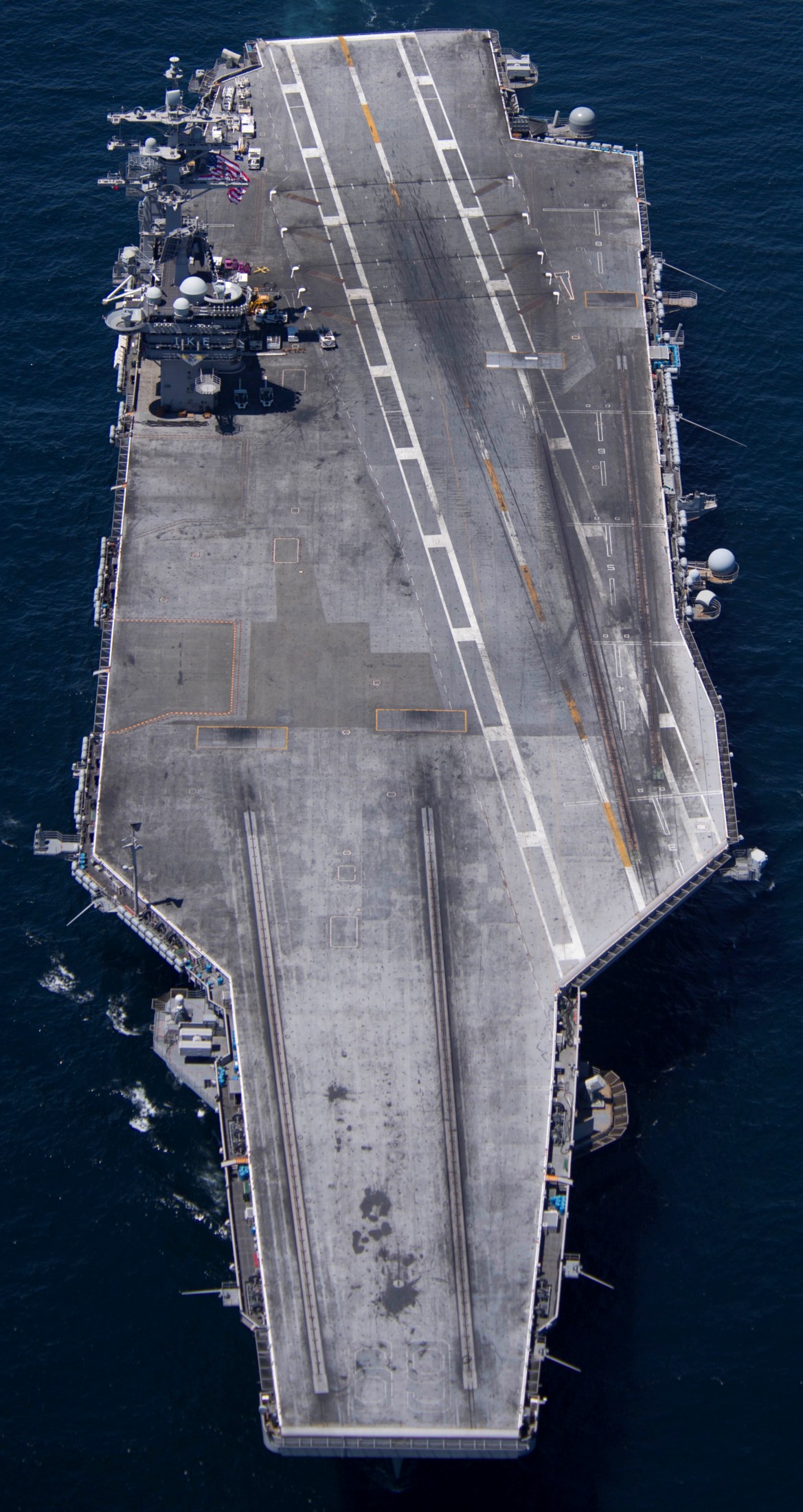 Atlantic Ocean - June 2017 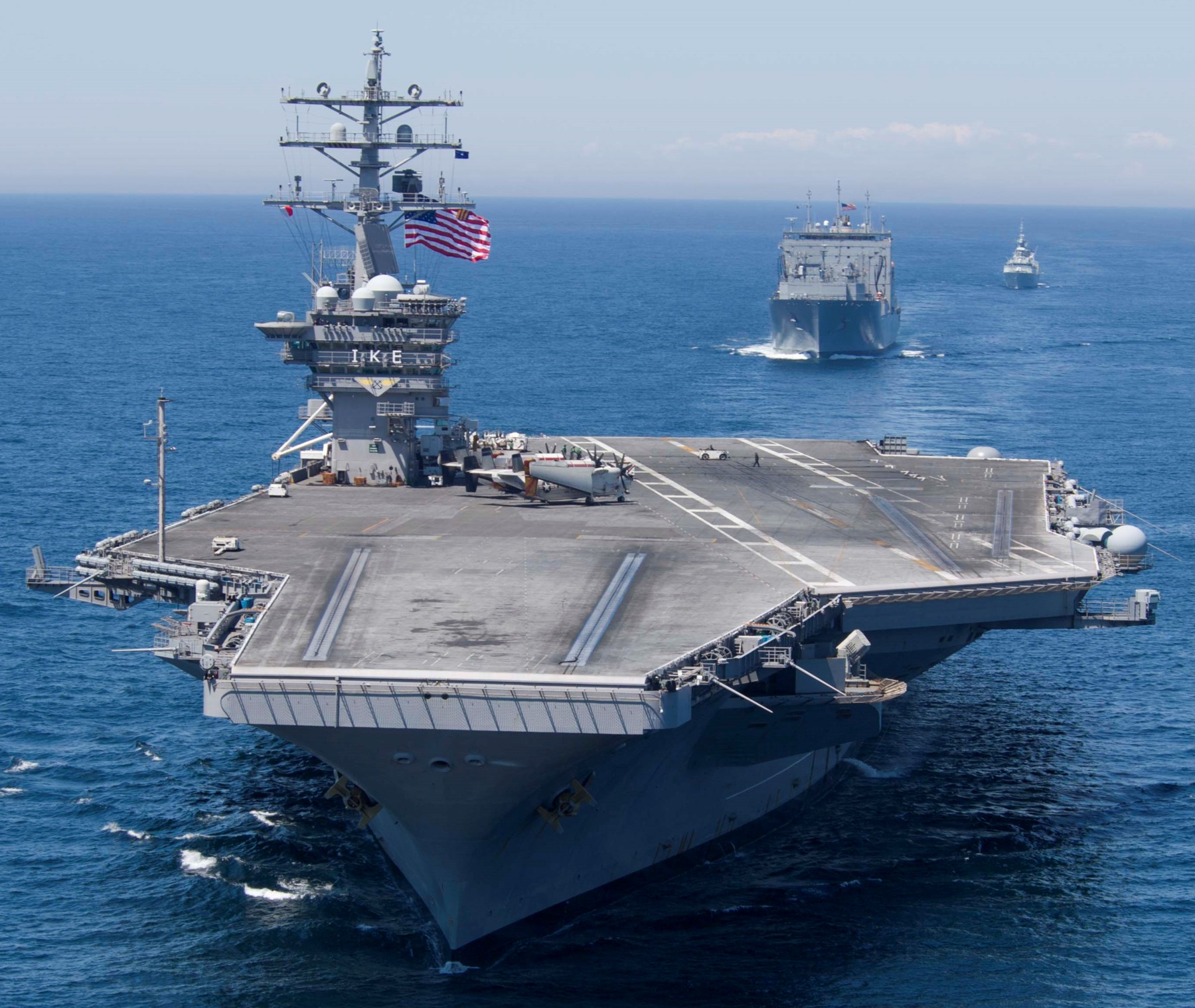 Atlantic Ocean - June 2017 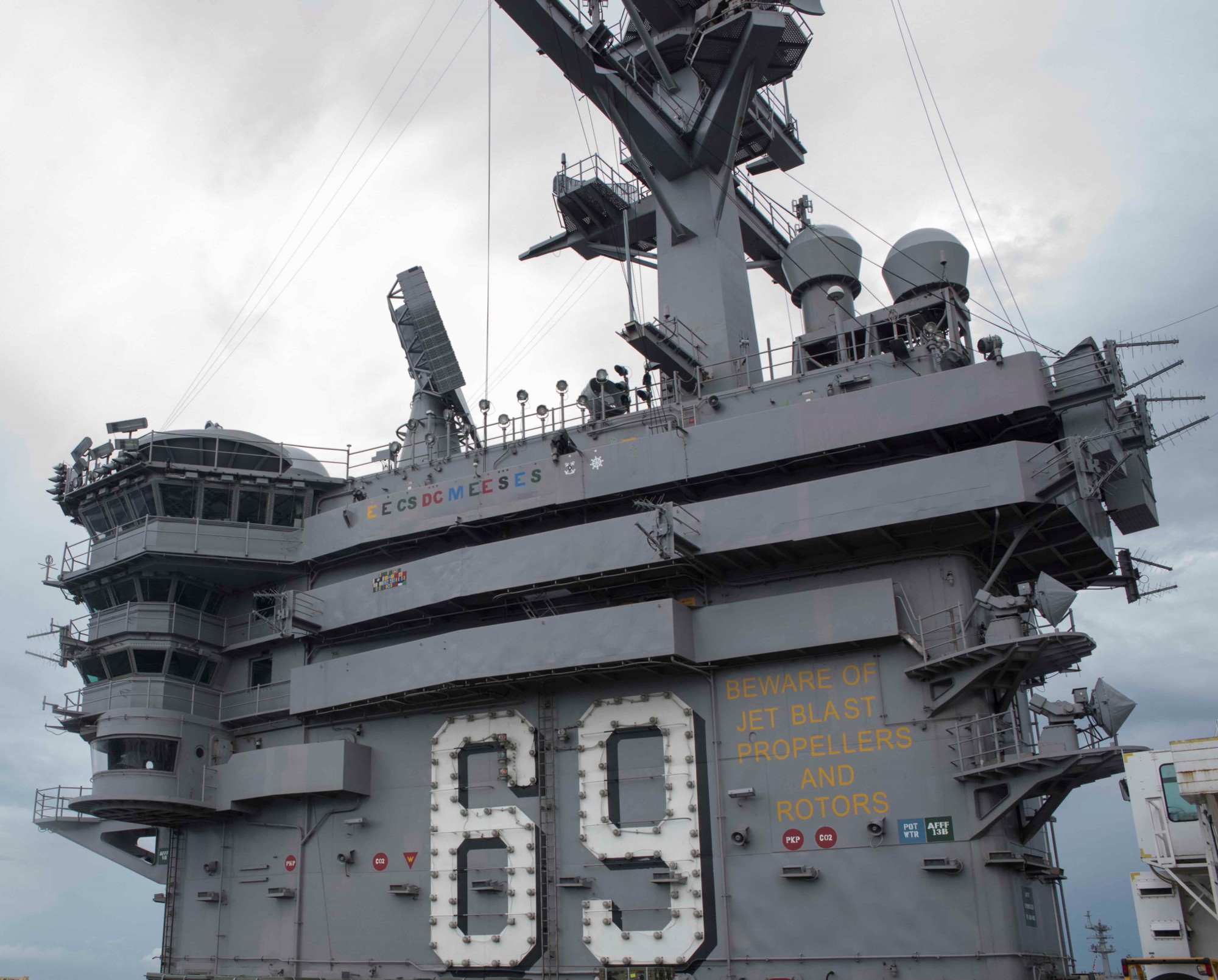 Norfolk, Virginia - June 2017 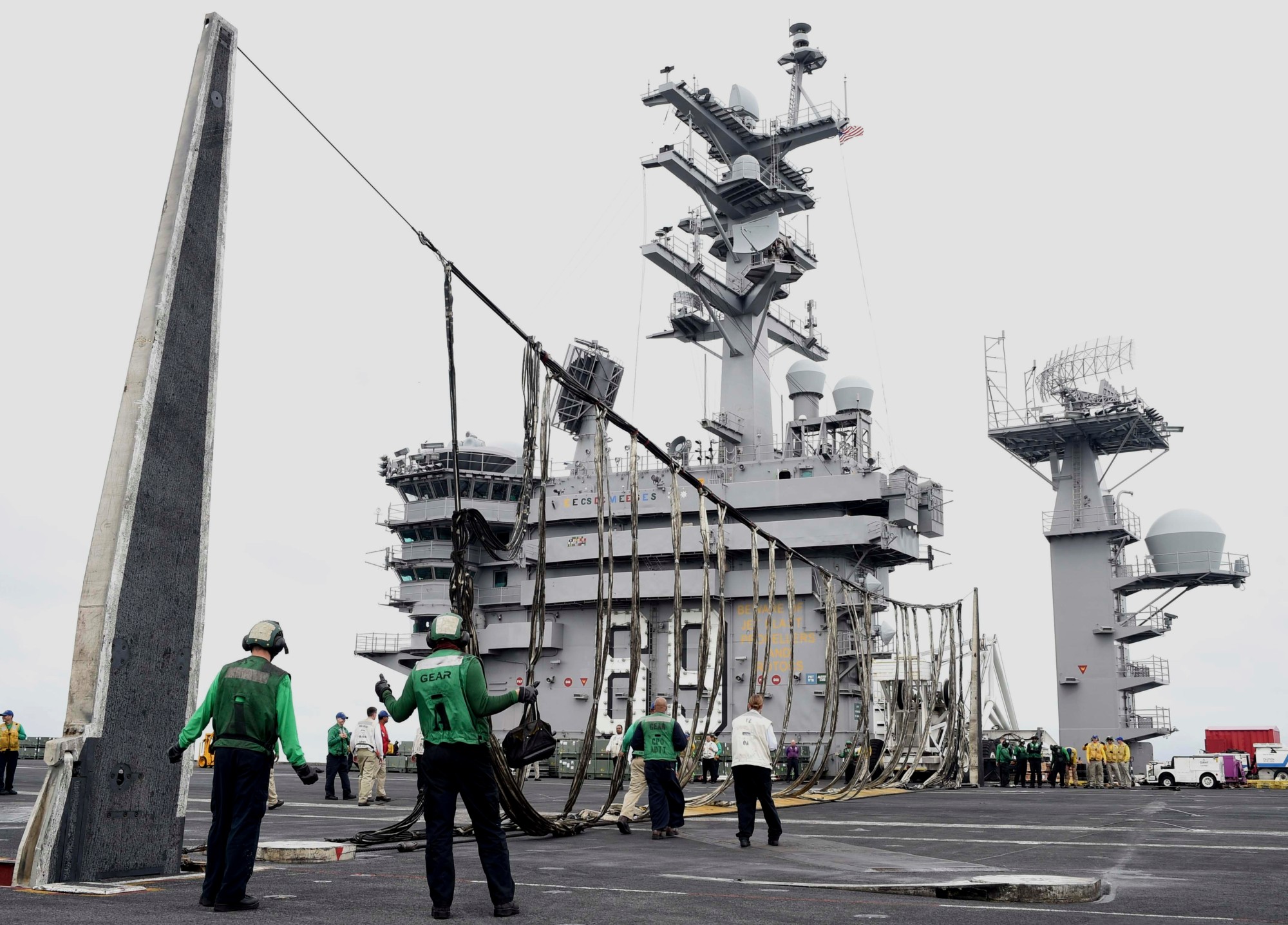 emergency aircraft barricade exercise - June 2017 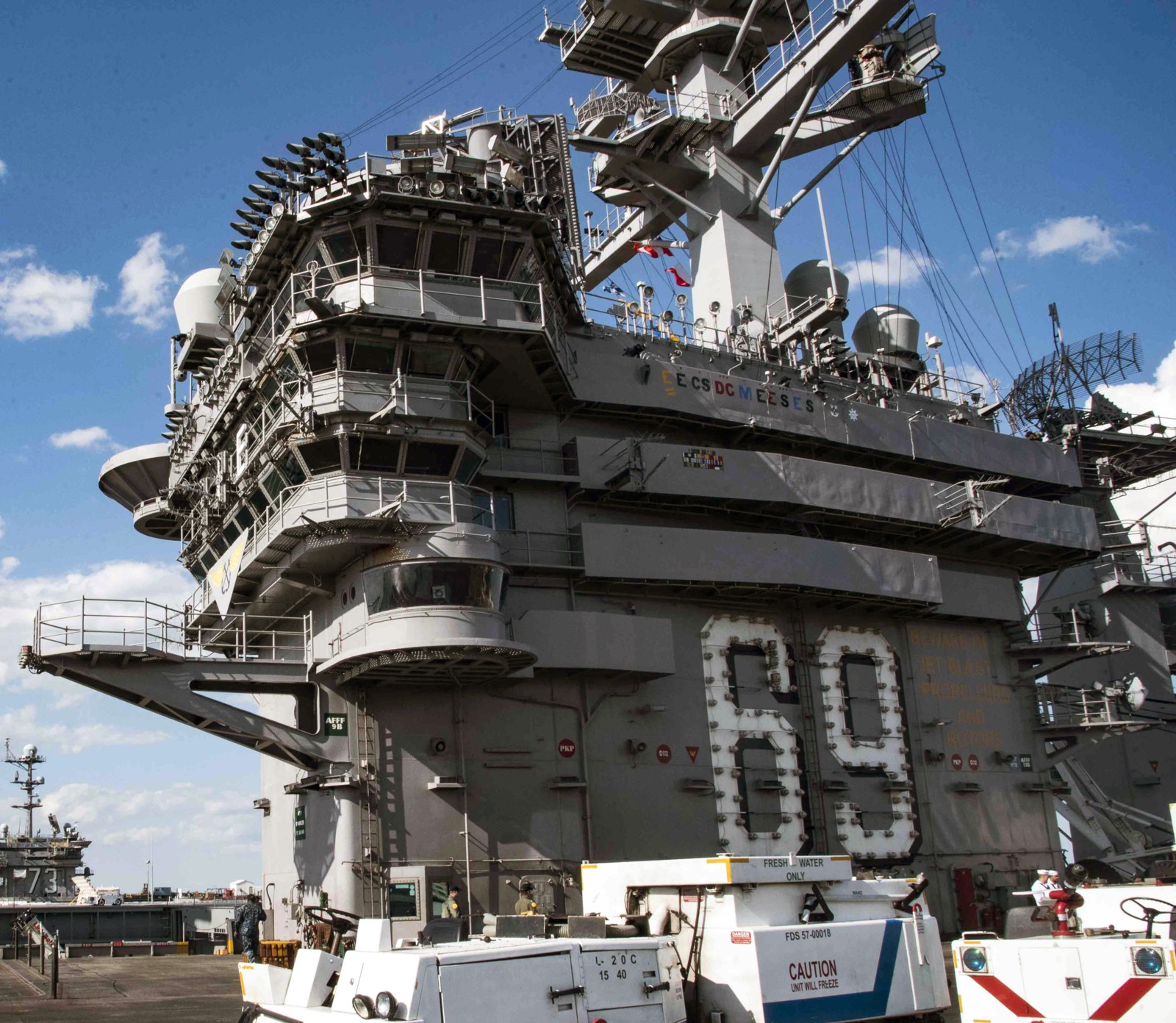 May 2017 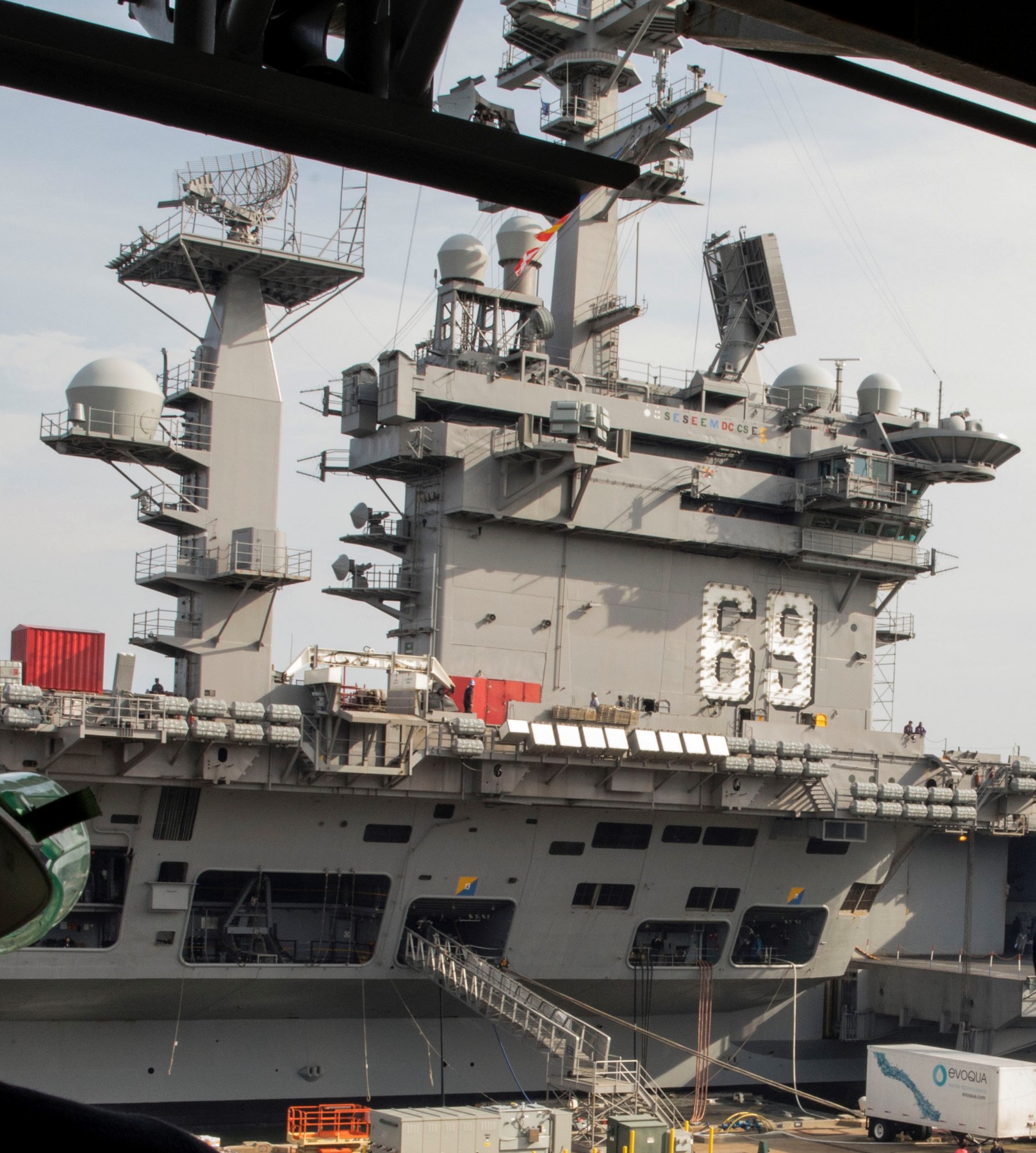 March 2017 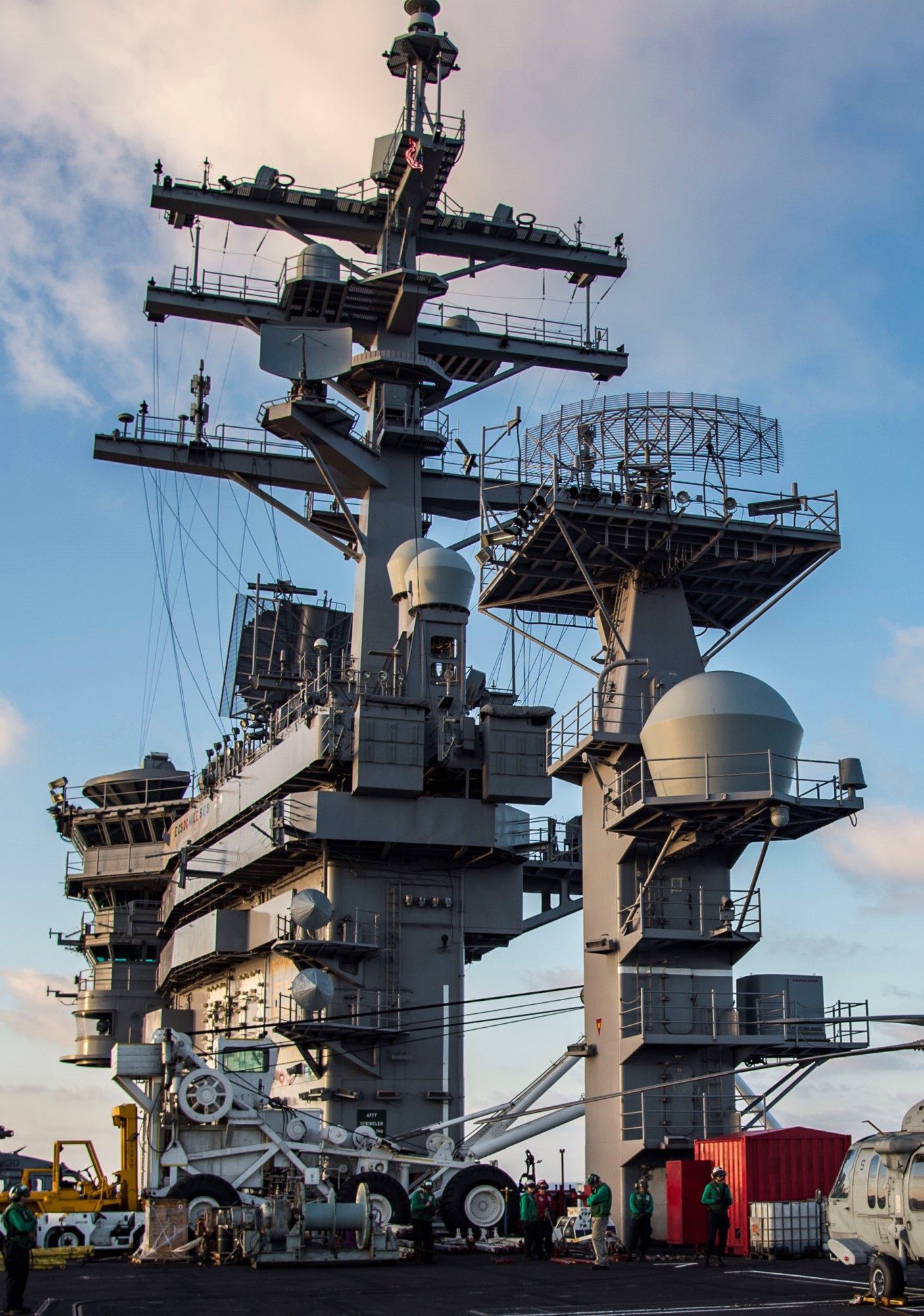 February 2017 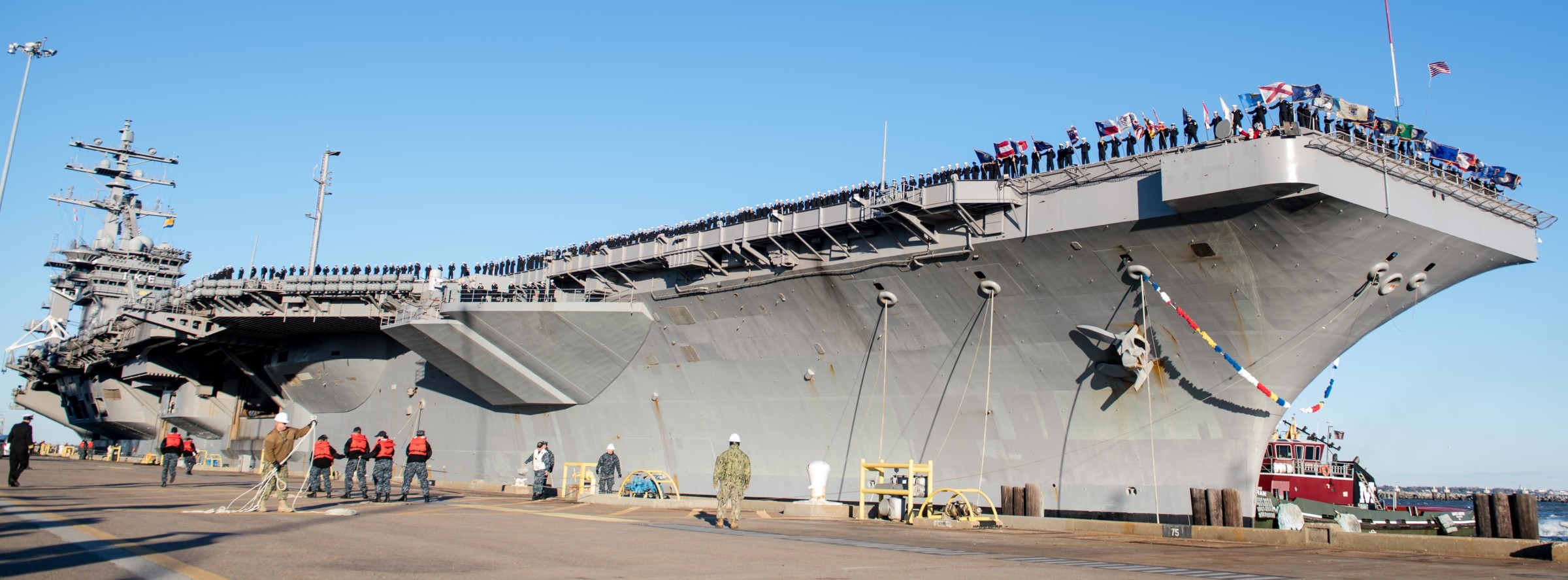 returning to Naval Station Norfolk, Virginia - December 2016 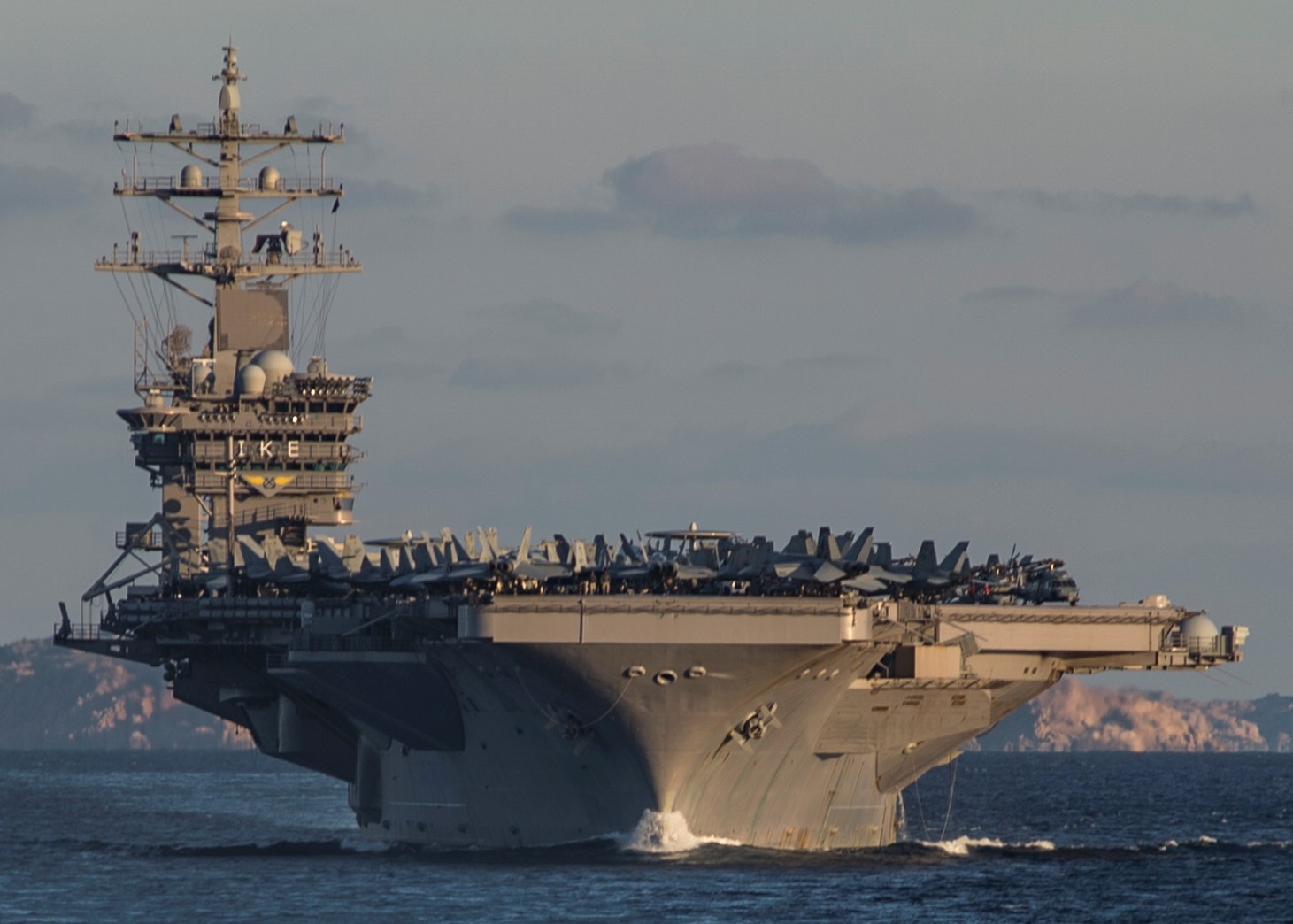 with CVW-3 embarked - Mediterranean Sea - December 2016  with CVW-3 embarked - Mediterranean Sea - December 2016  with CVW-3 embarked - 5th Fleet AOR - November 2016 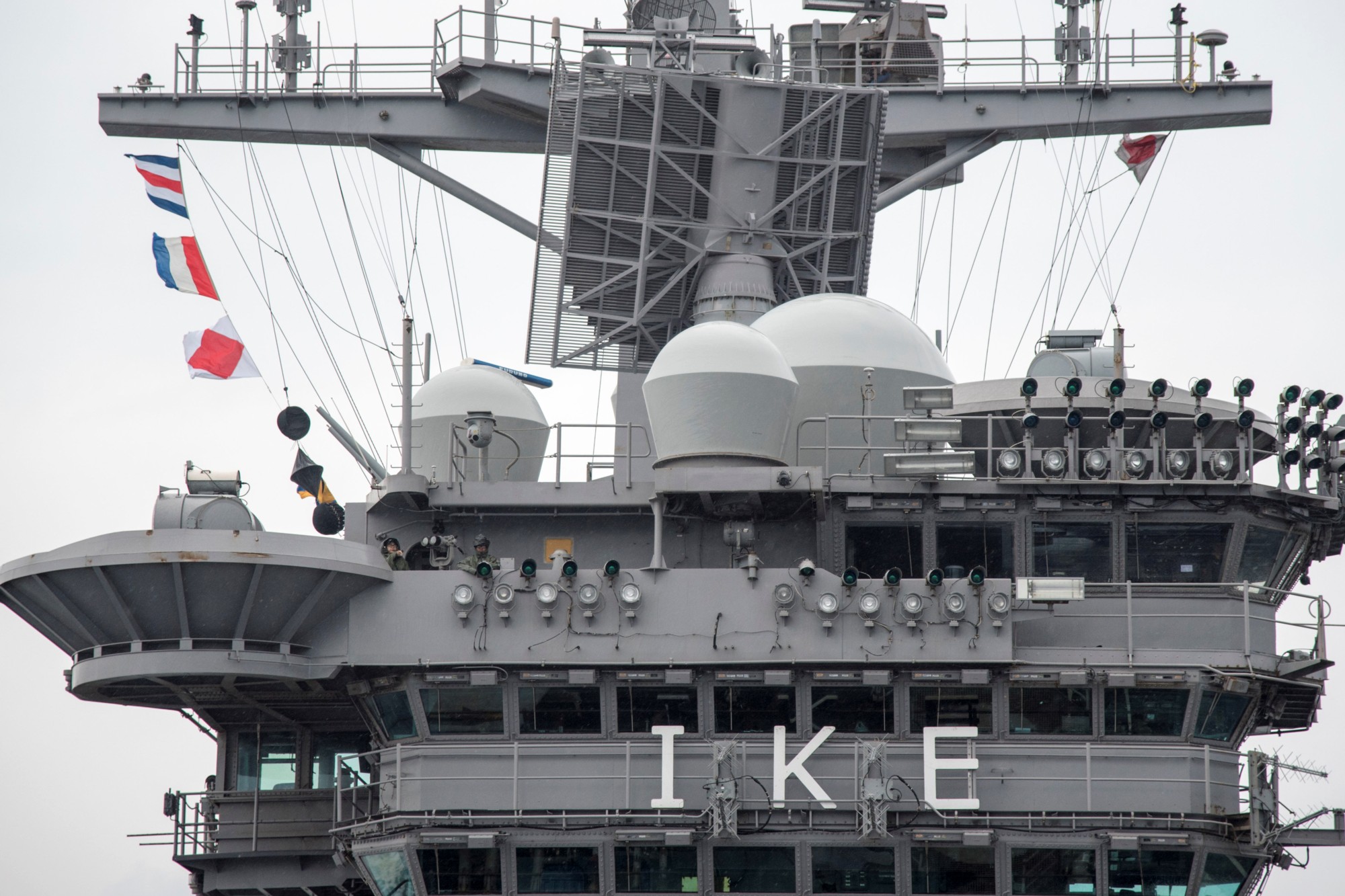 5th Fleet AOR - November 2016 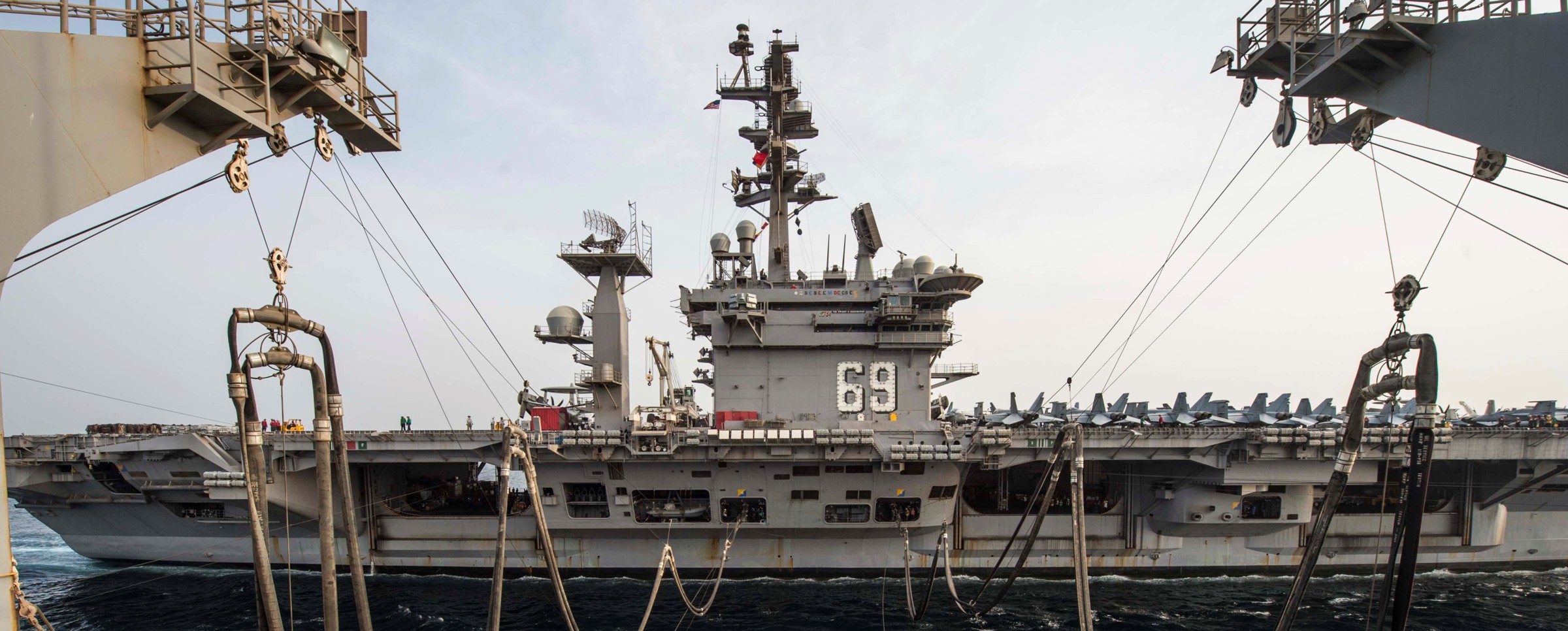 with CVW-3 embarked - Arabian Gulf - November 2016 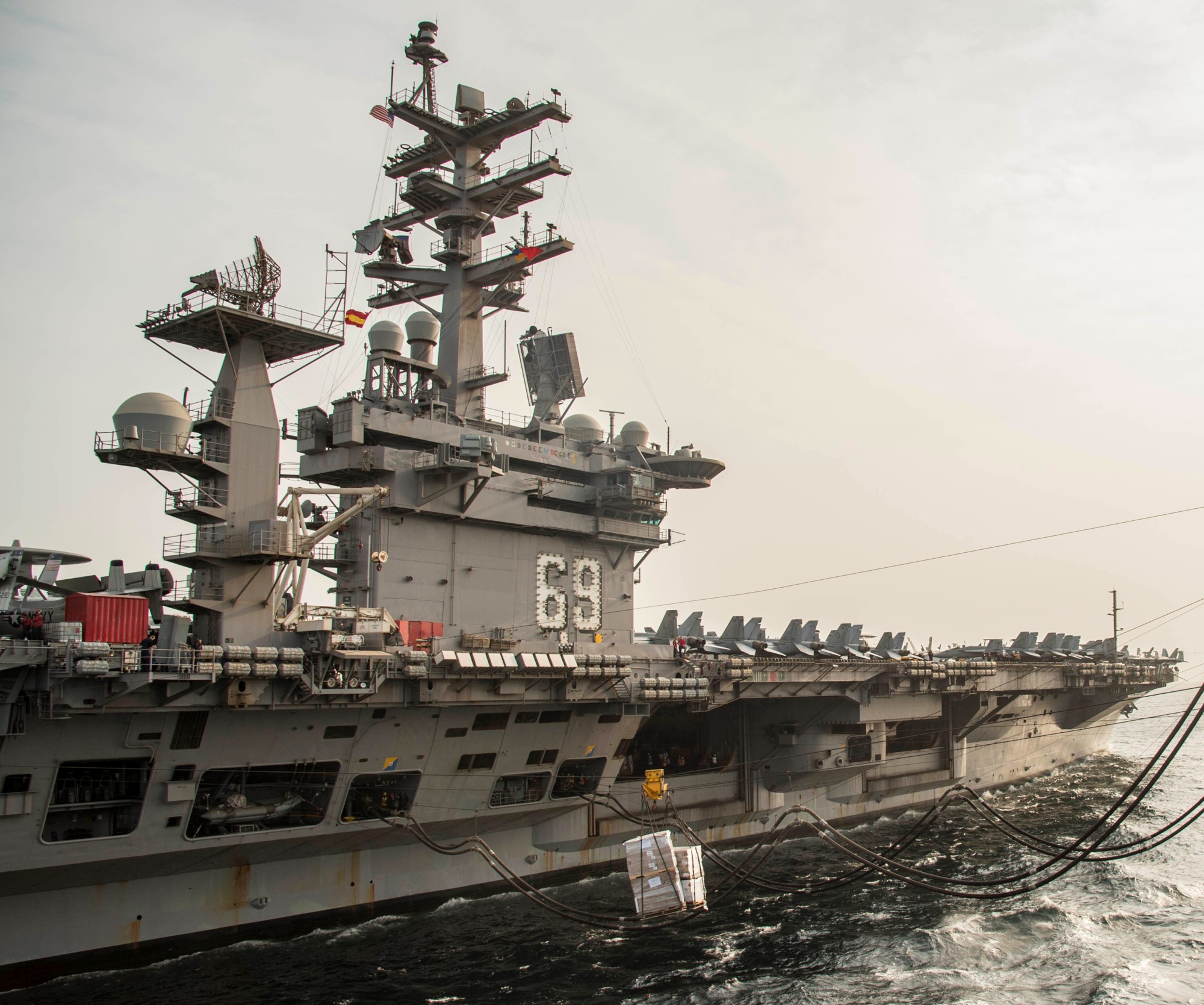 with CVW-3 embarked - Arabian Gulf - November 2016 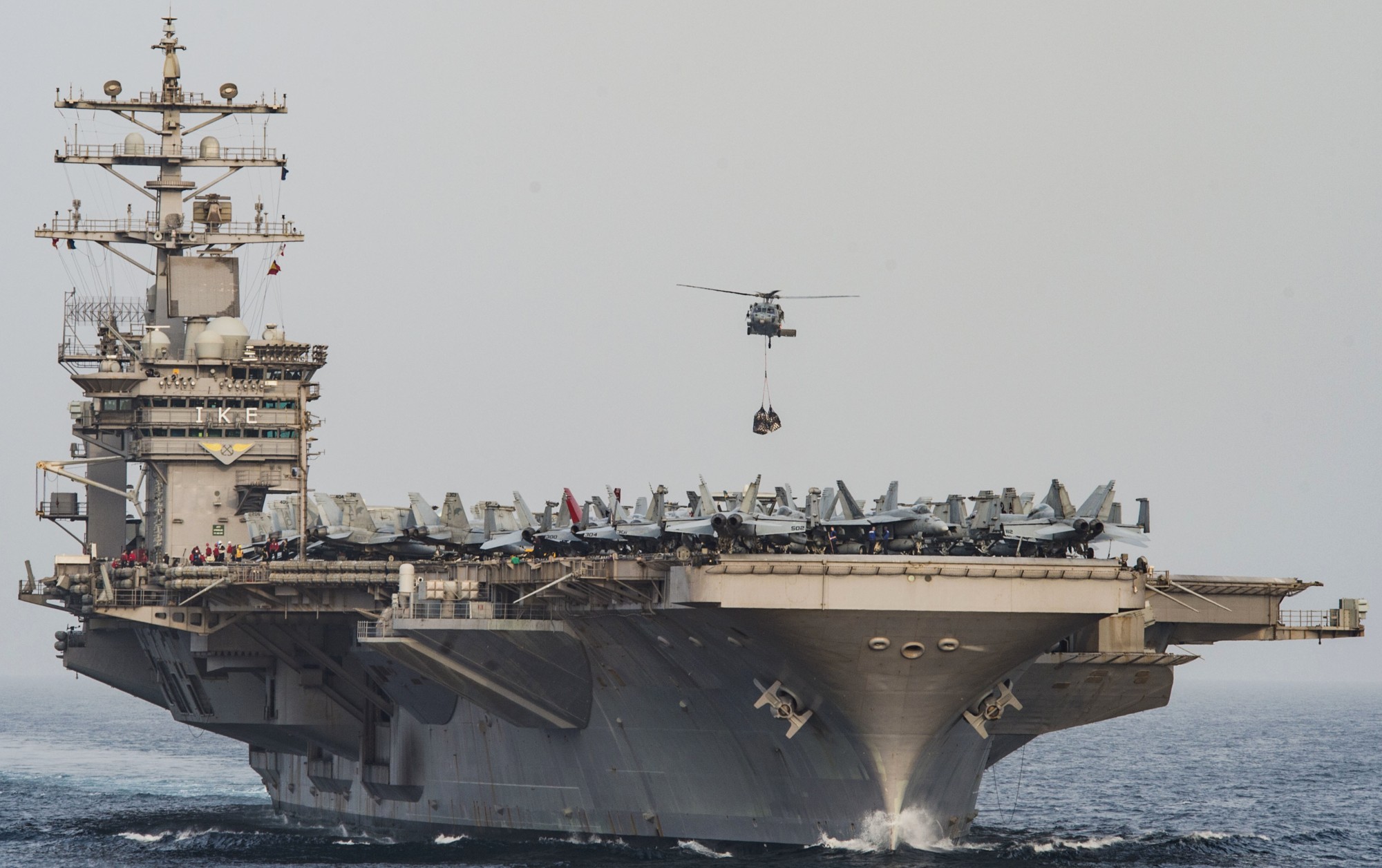 with CVW-3 embarked - Arabian Gulf - November 2016 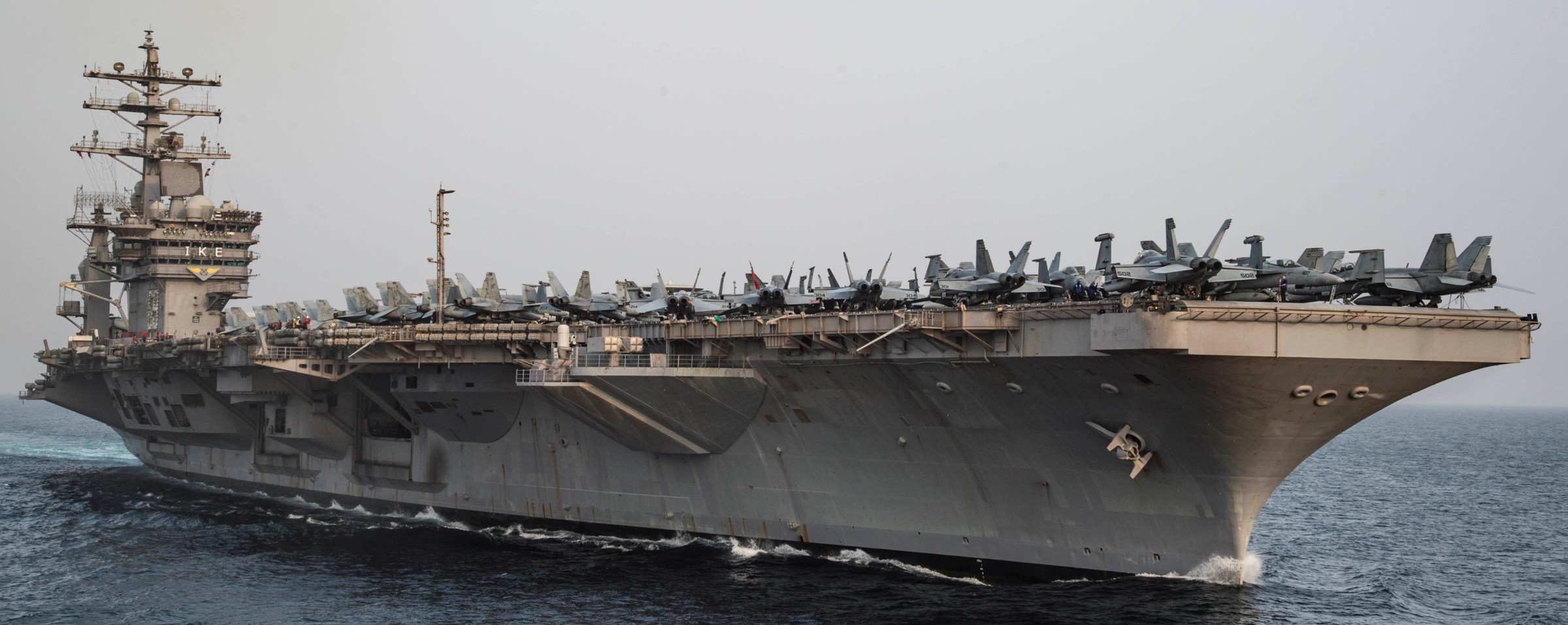 with CVW-3 embarked - Arabian Gulf - November 2016 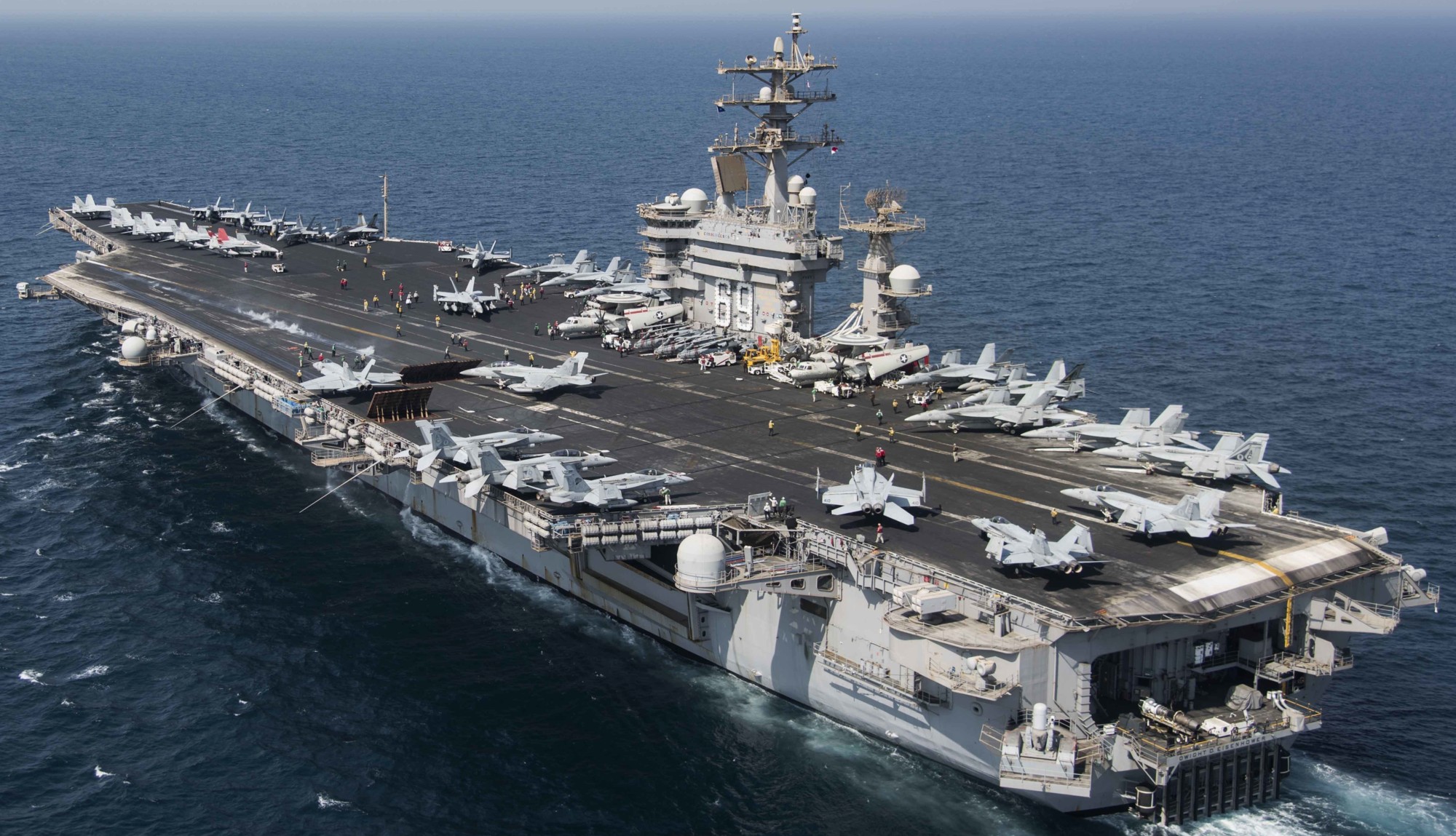 with CVW-3 embarked - Arabian Gulf - October 2016 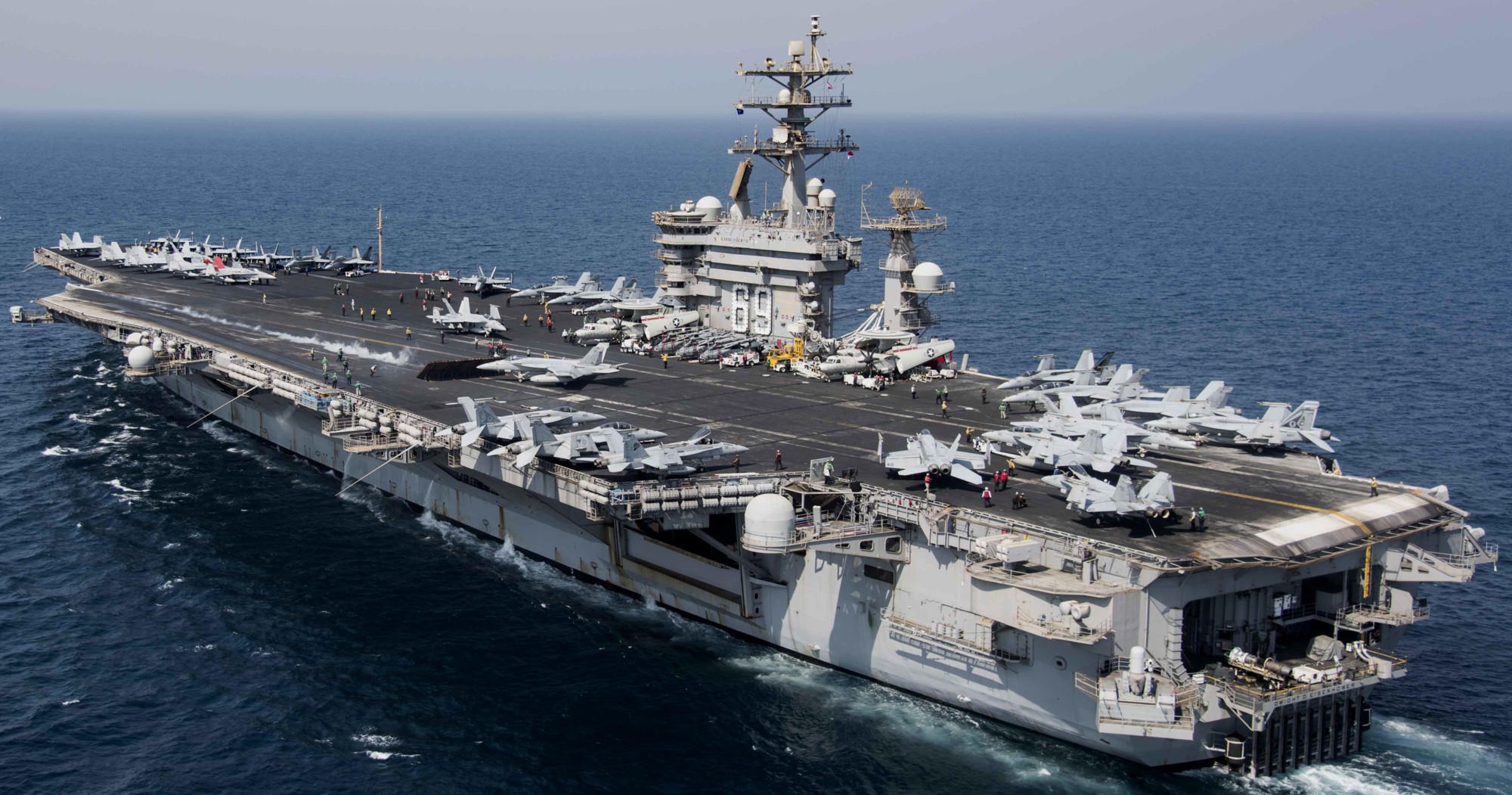 with CVW-3 embarked - Arabian Gulf - October 2016 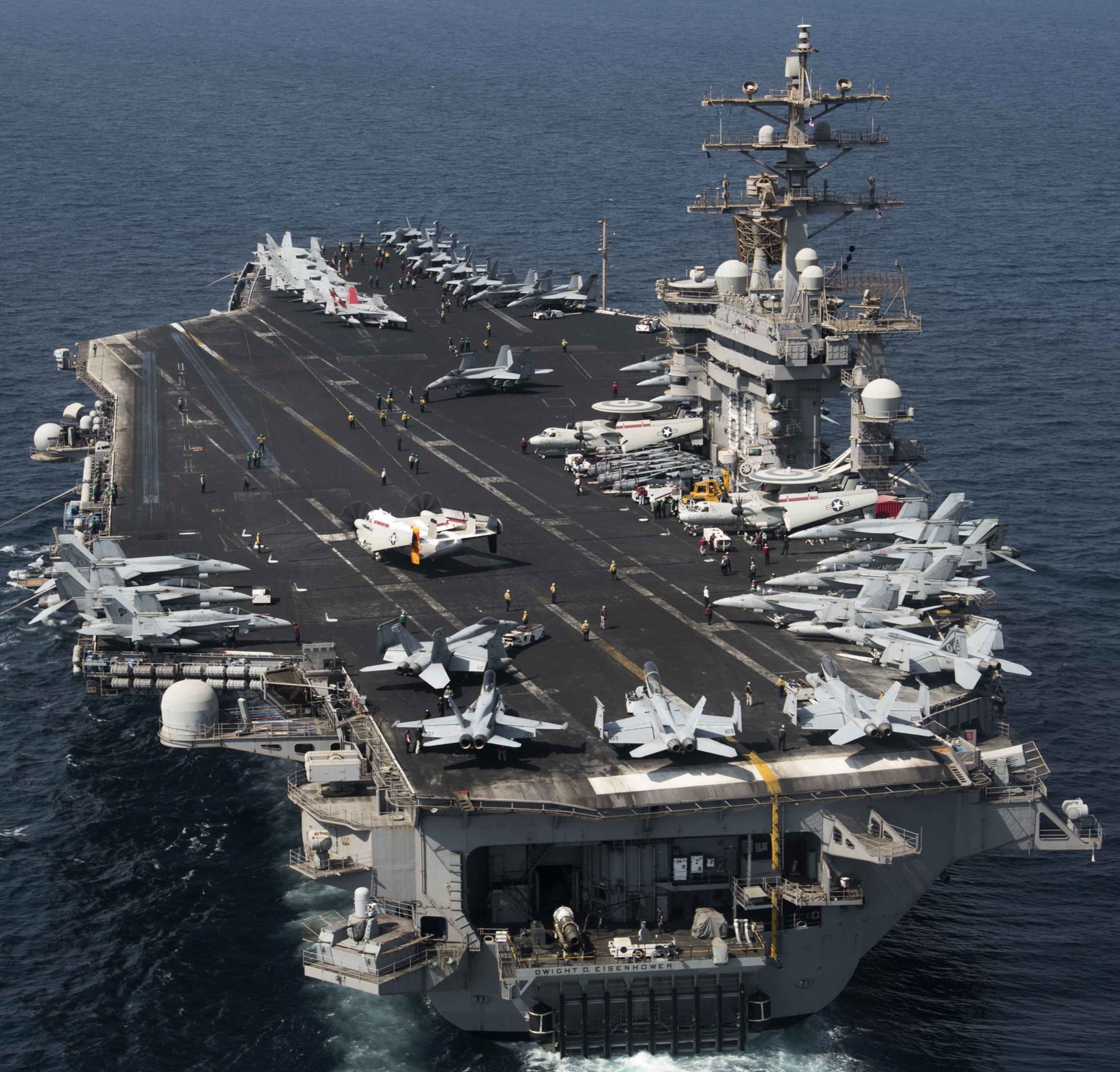 with CVW-3 embarked - Arabian Gulf - October 2016 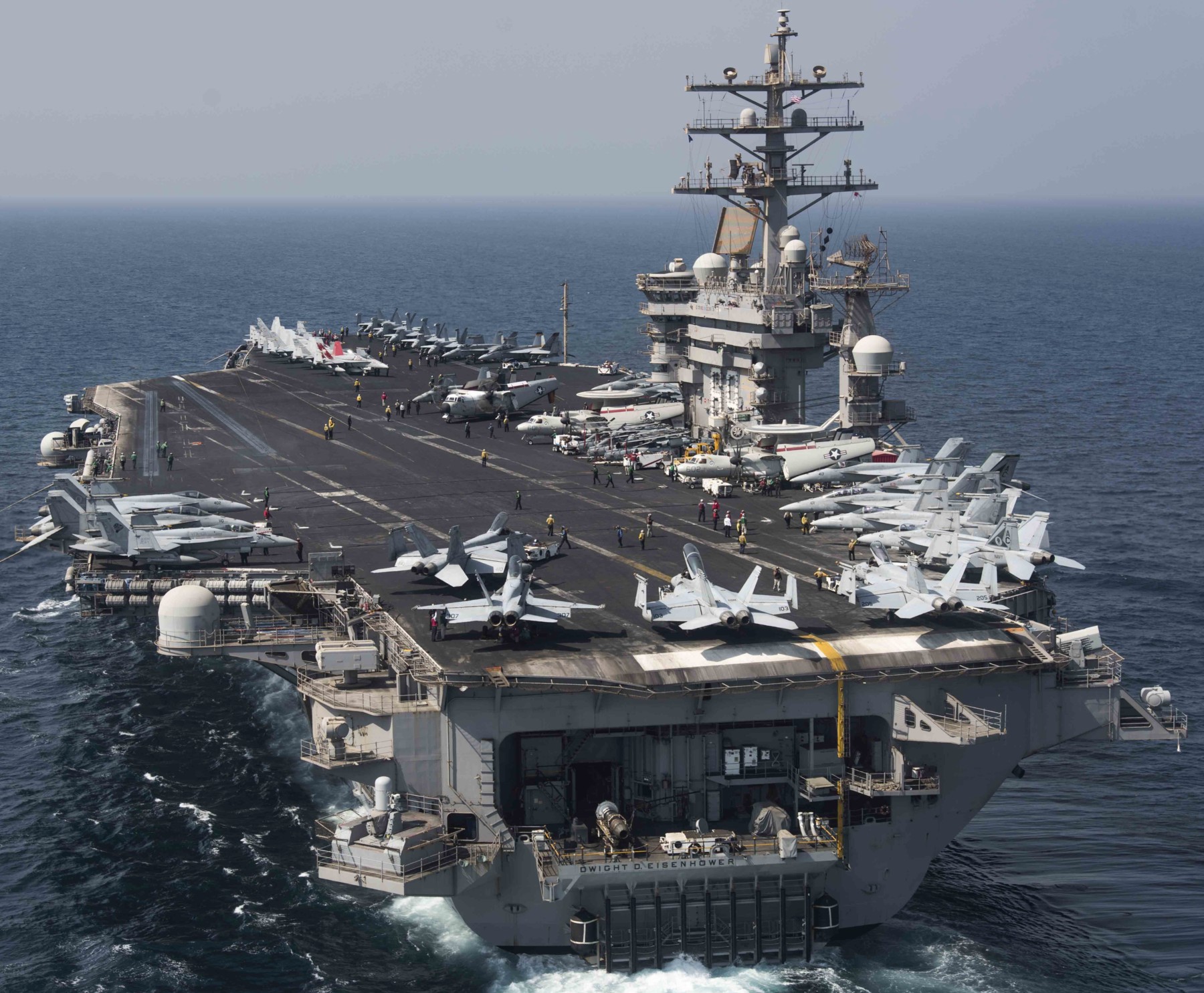 with CVW-3 embarked - Arabian Gulf - October 2016  with CVW-3 embarked - Arabian Gulf - October 2016 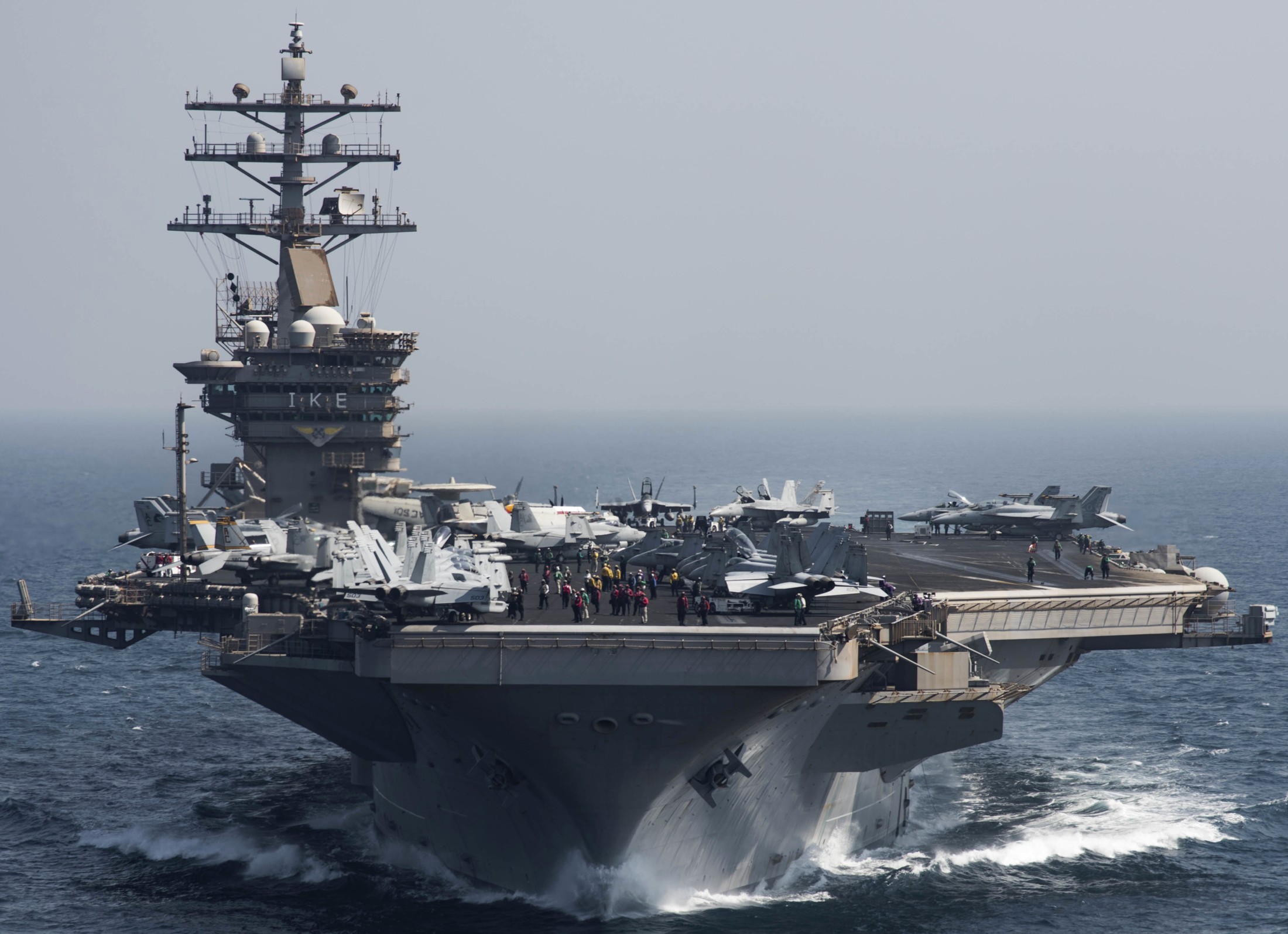 with CVW-3 embarked - Arabian Gulf - October 2016 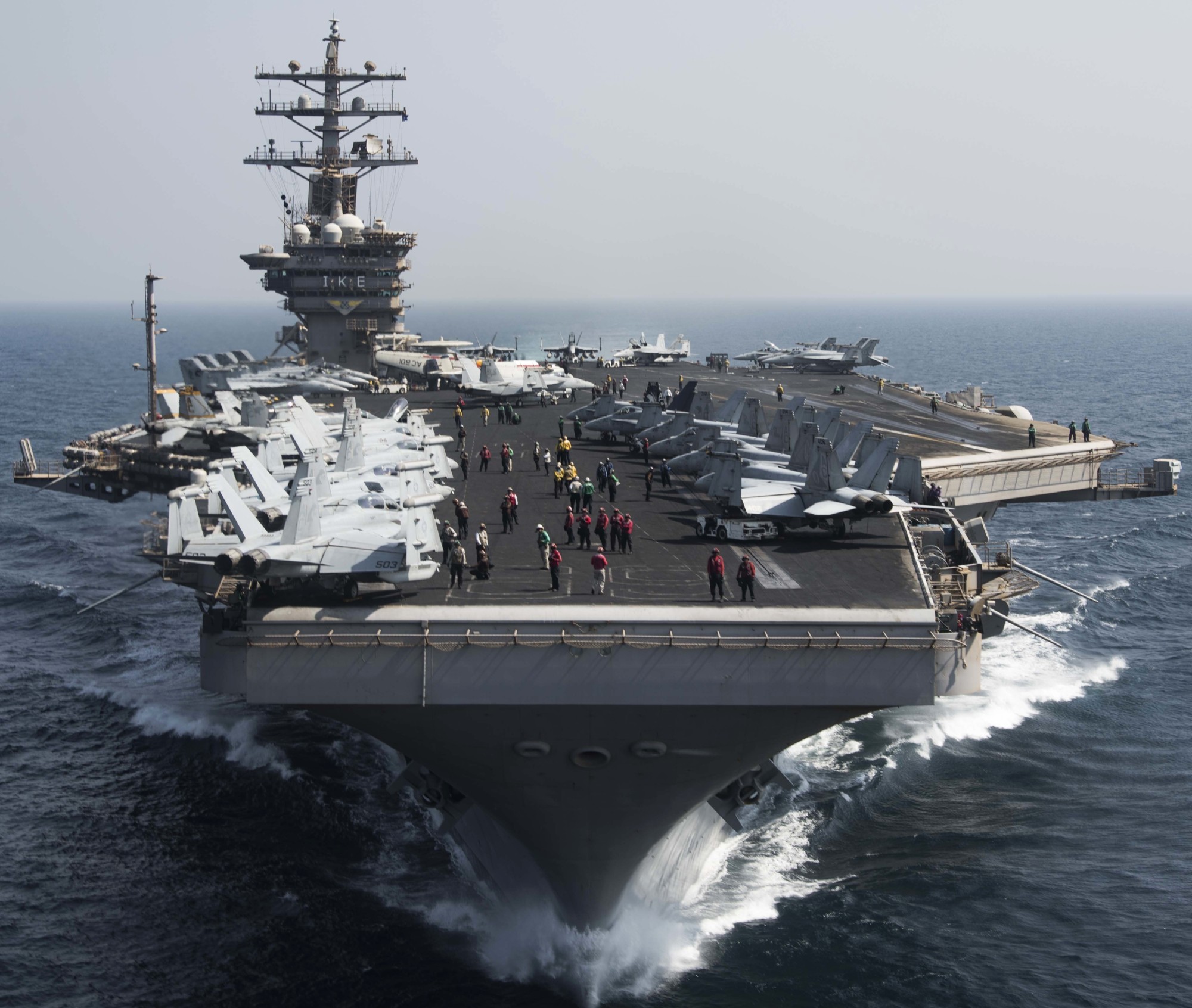 with CVW-3 embarked - Arabian Gulf - October 2016 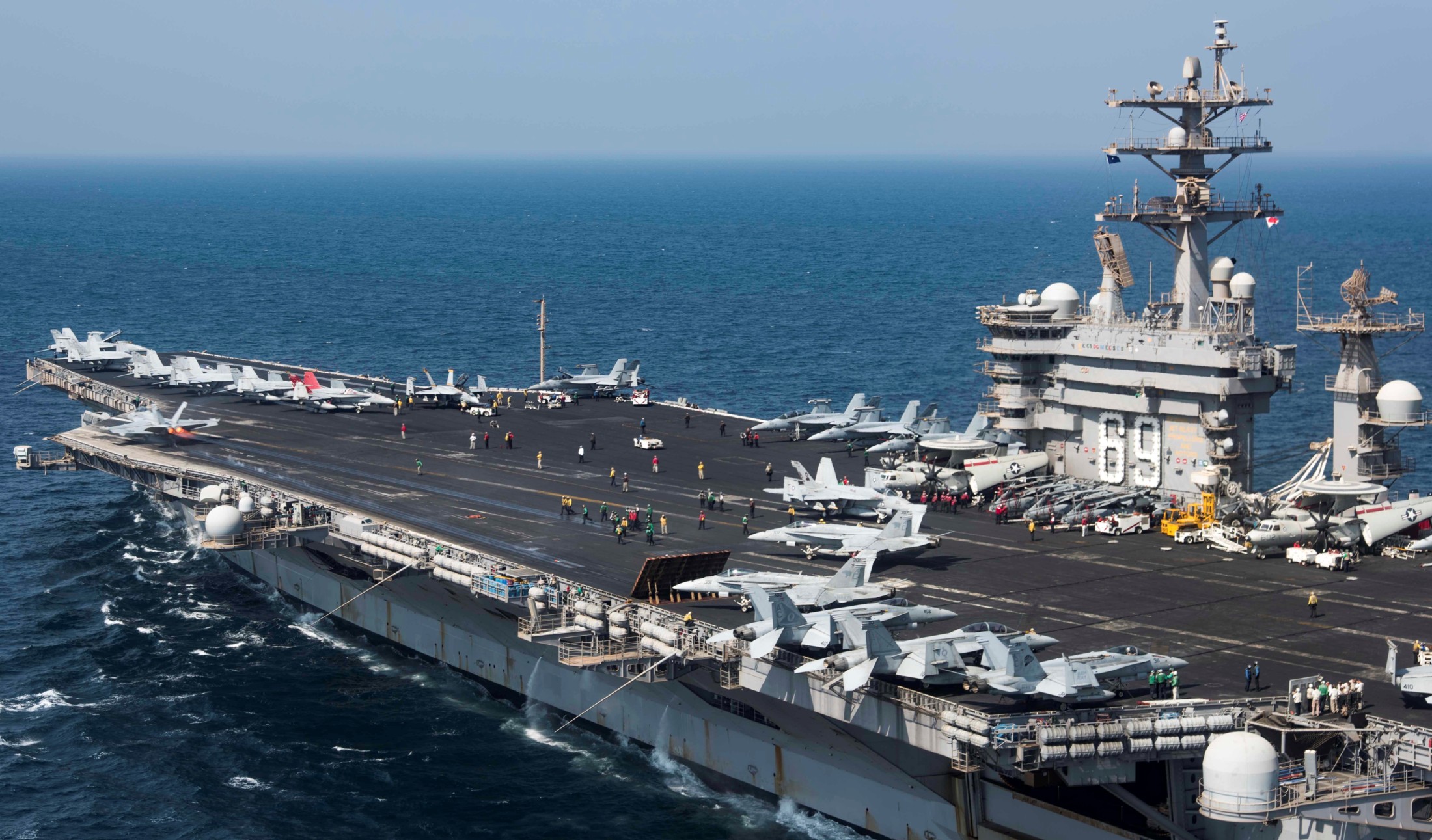 with CVW-3 embarked - Arabian Gulf - October 2016 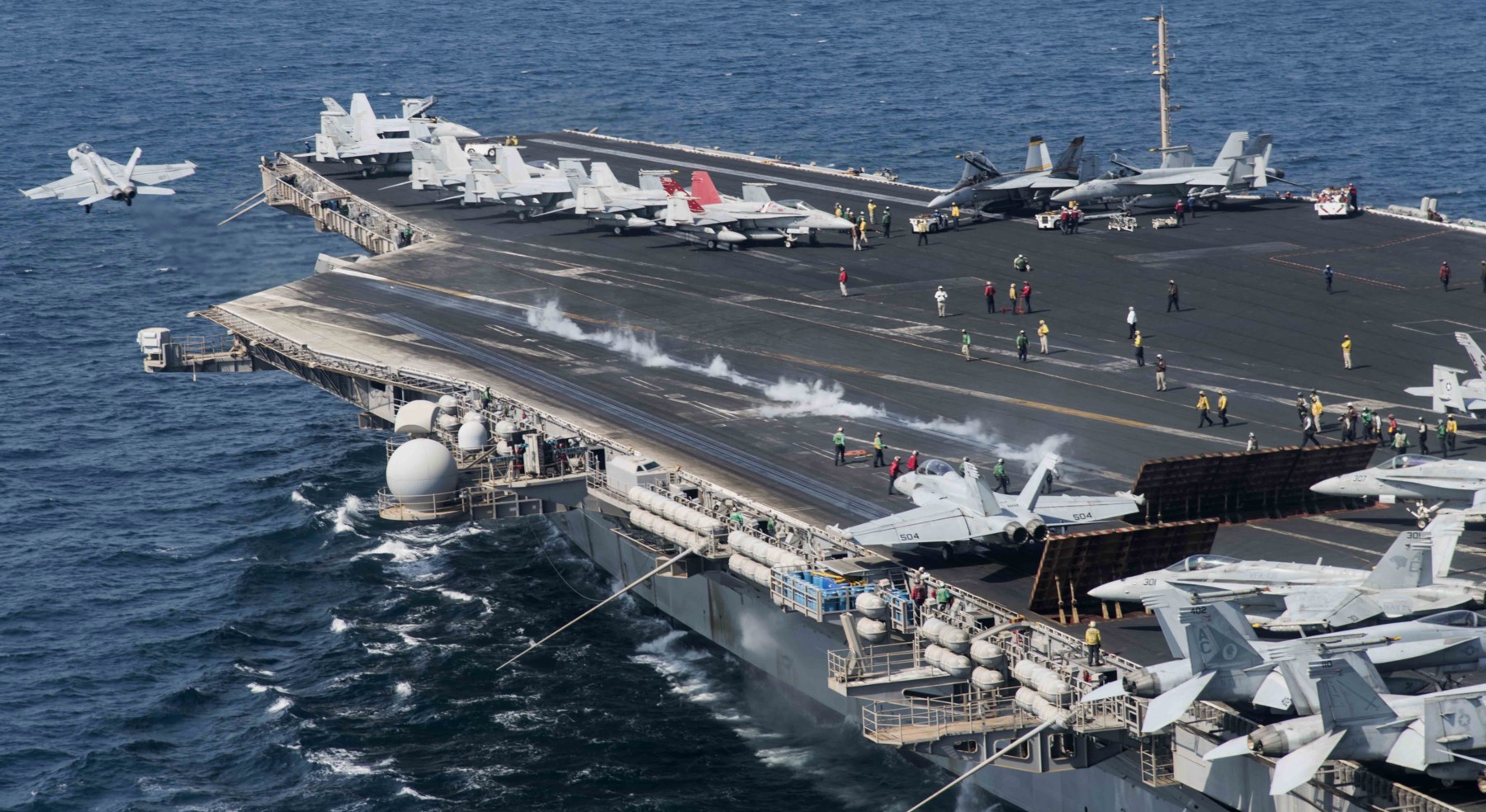 with CVW-3 embarked - Arabian Gulf - October 2016 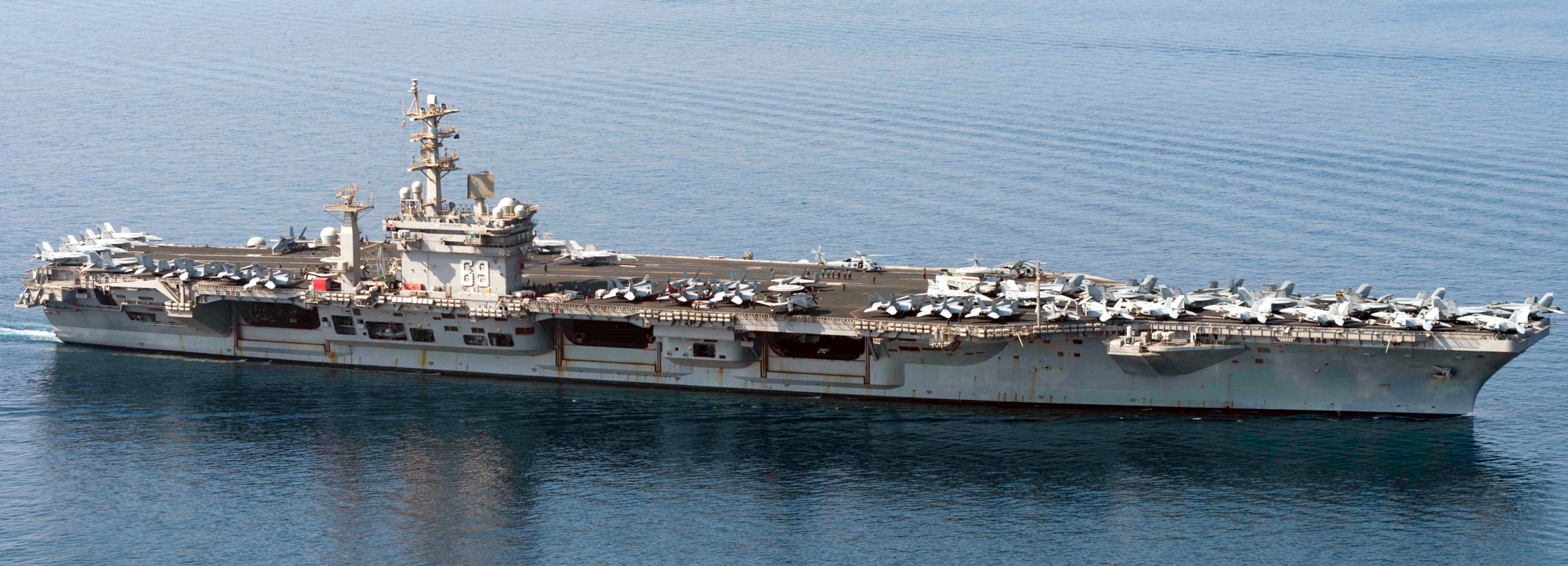 with CVW-3 embarked - August 2016  with CVW-3 embarked - August 2016 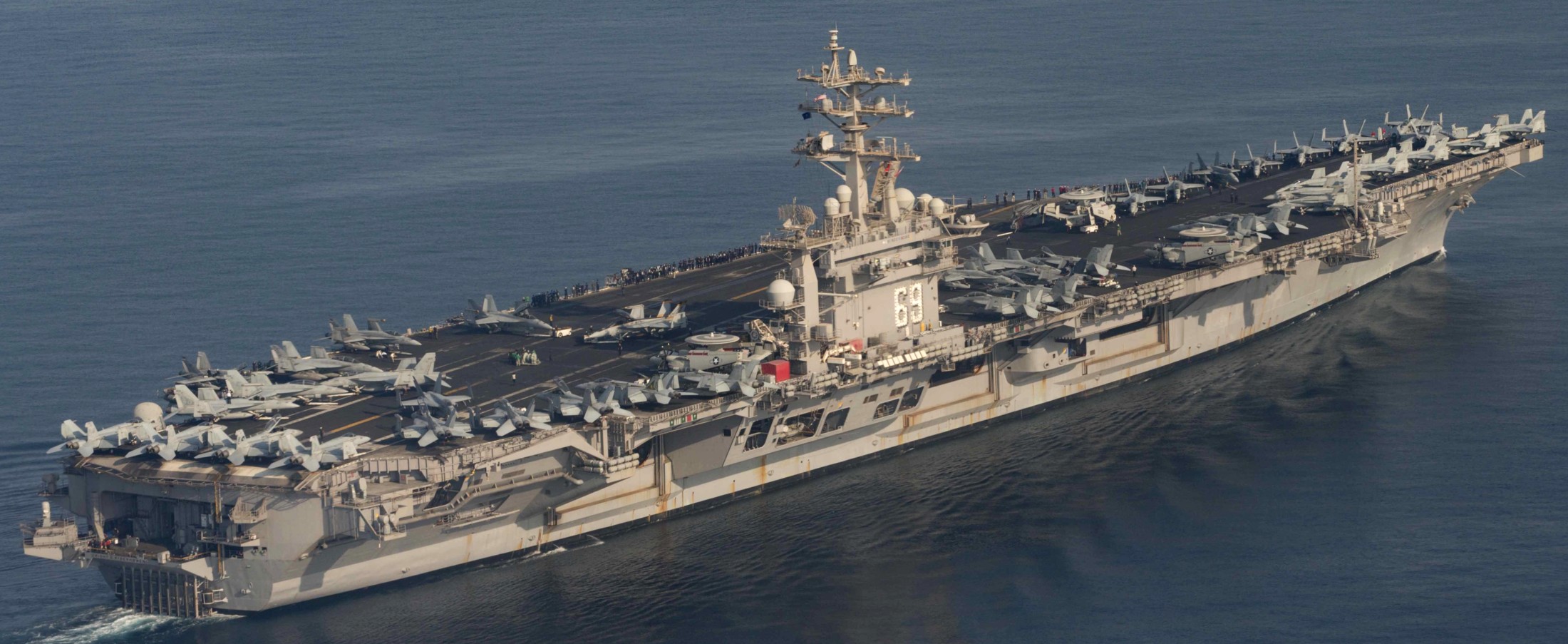 with CVW-3 embarked - Arabian Gulf - August 2016 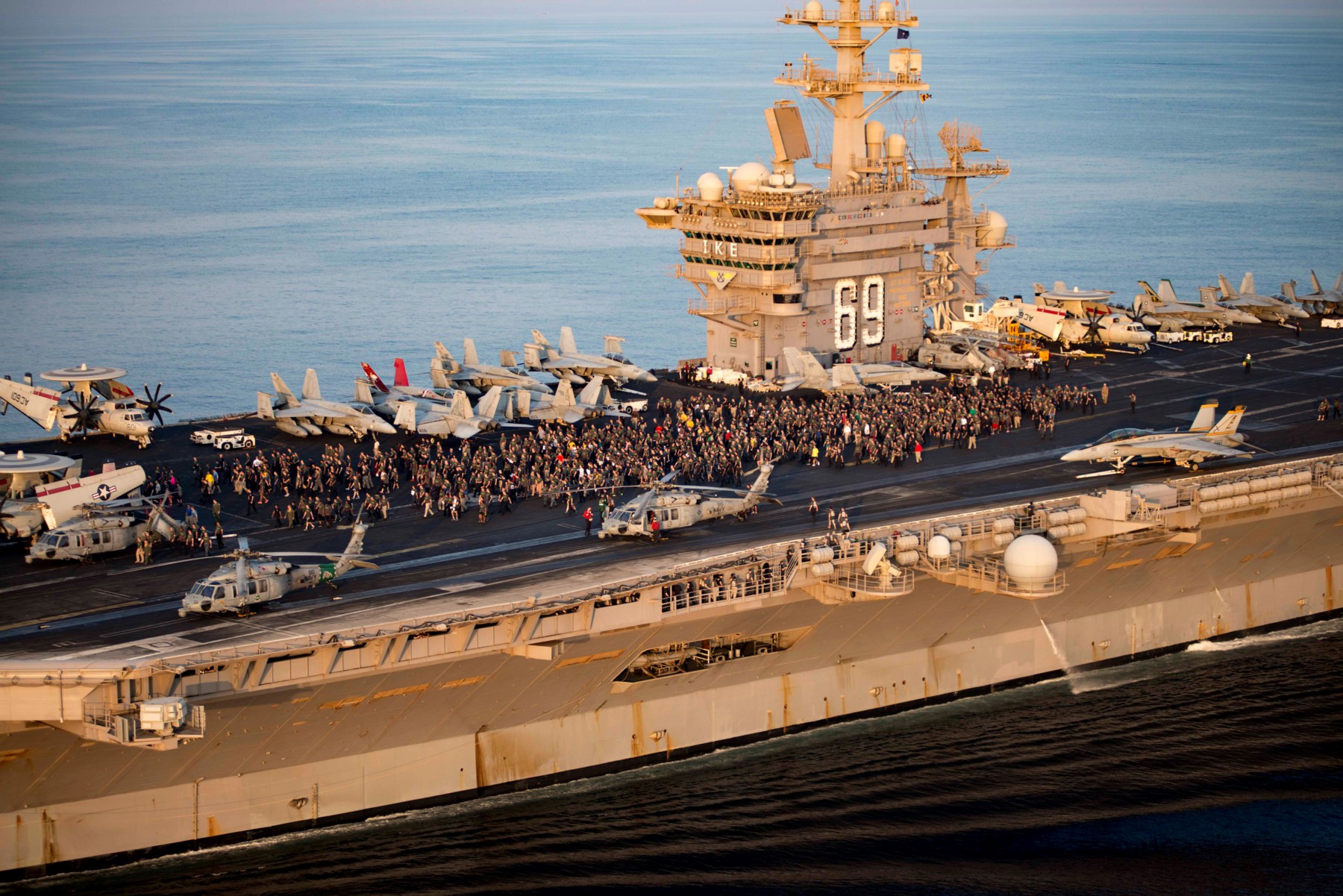 with CVW-3 embarked - Arabian Gulf - August 2016 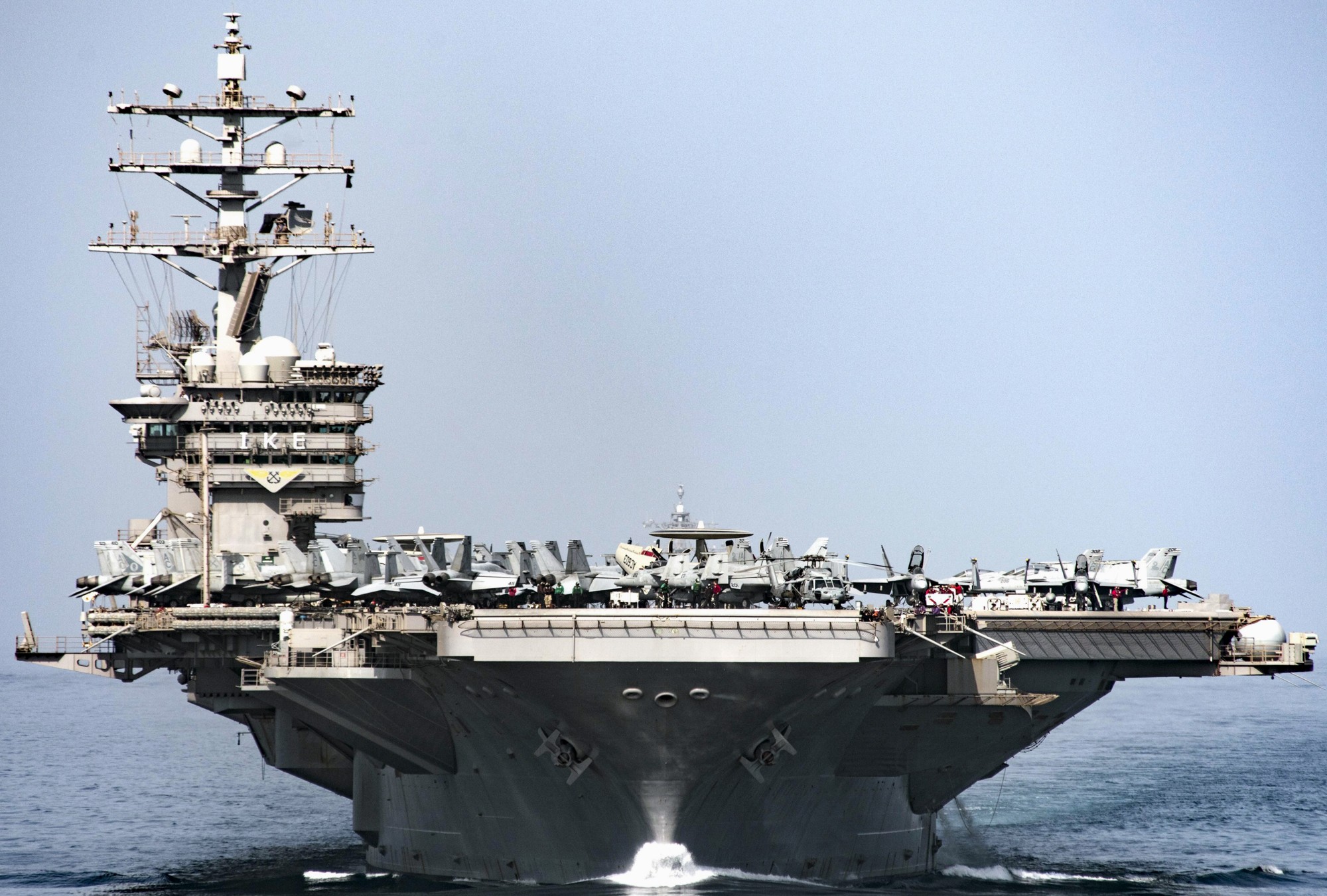 with CVW-3 embarked - Strait of Hormuz - July 2016  with CVW-3 embarked - Mediterranean Sea - July 2016  with CVW-3 embarked - off Naples, Italy - June 2016 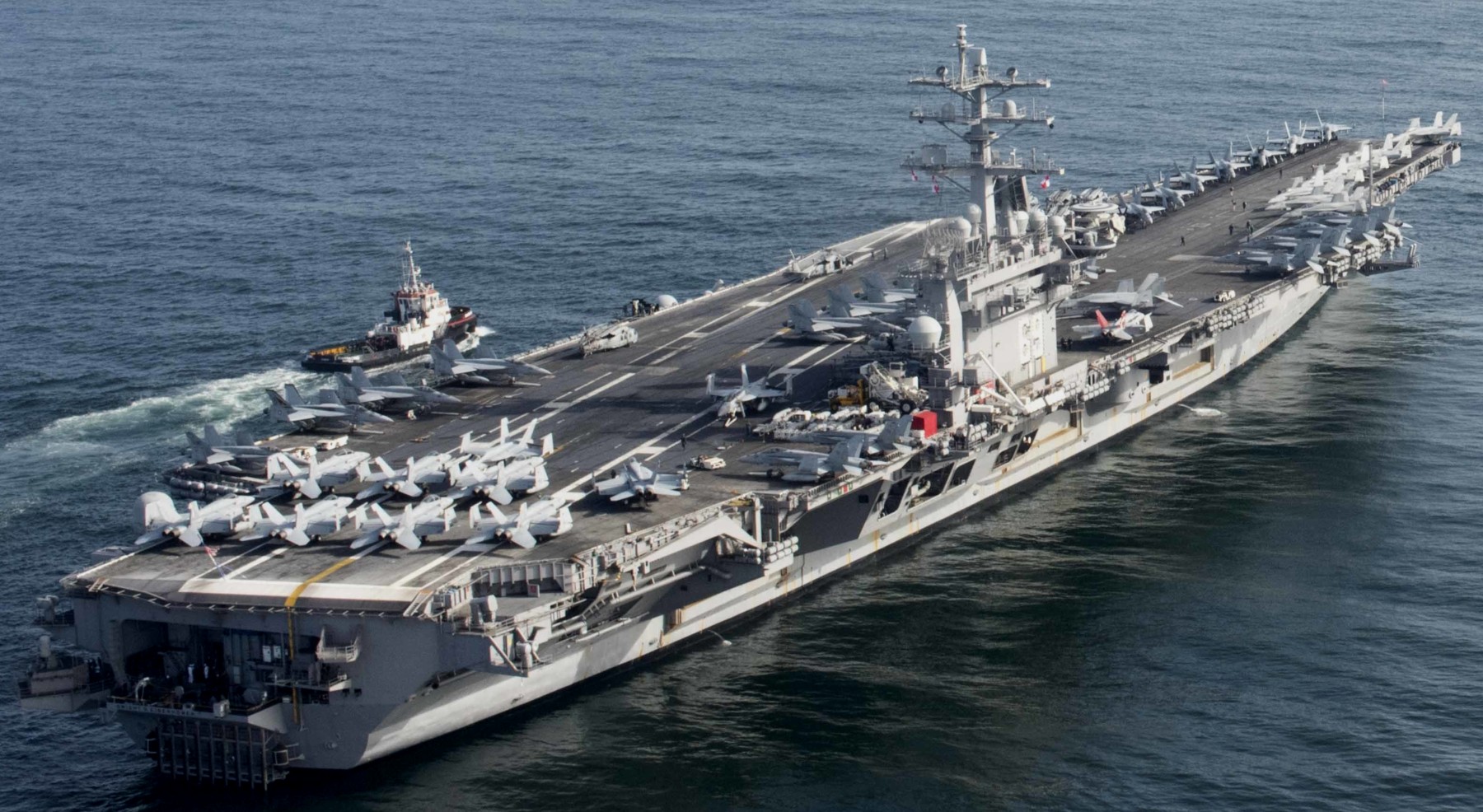 with CVW-3 embarked - off Naples, Italy - June 2016 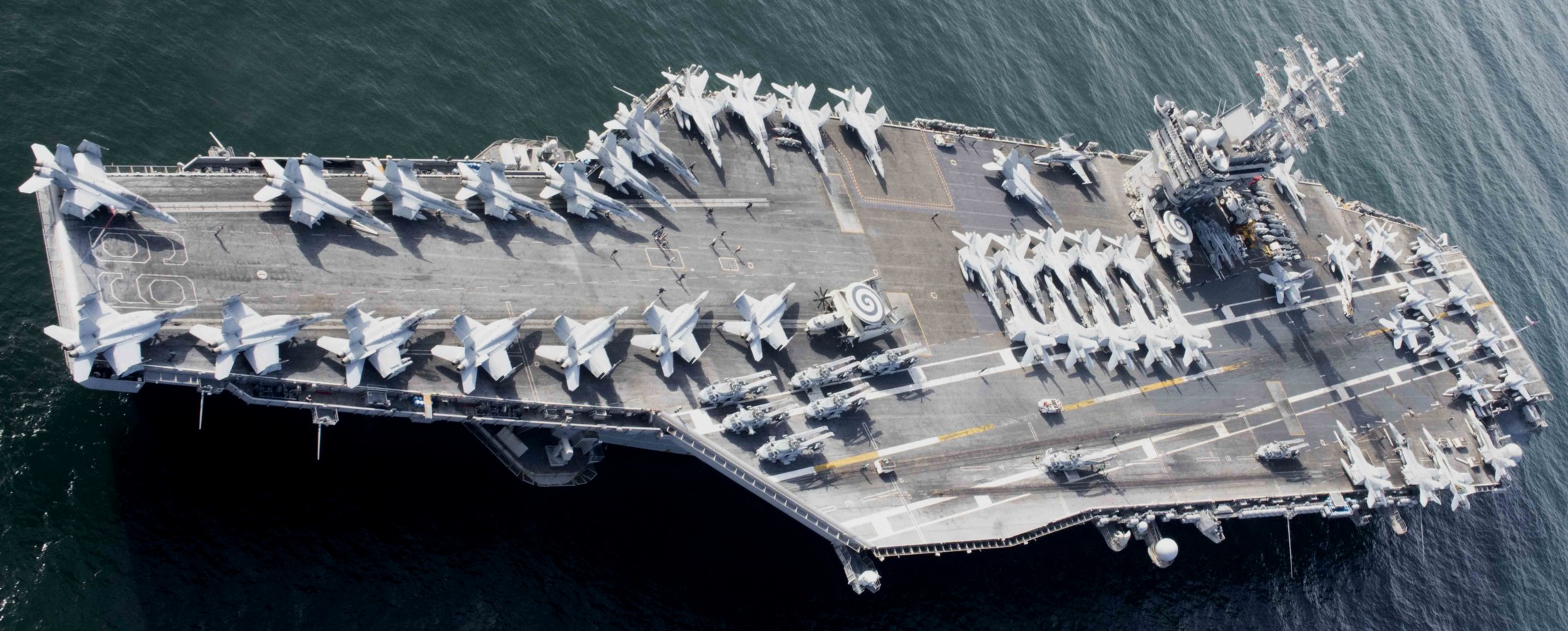 with CVW-3 embarked - off Naples, Italy - June 2016 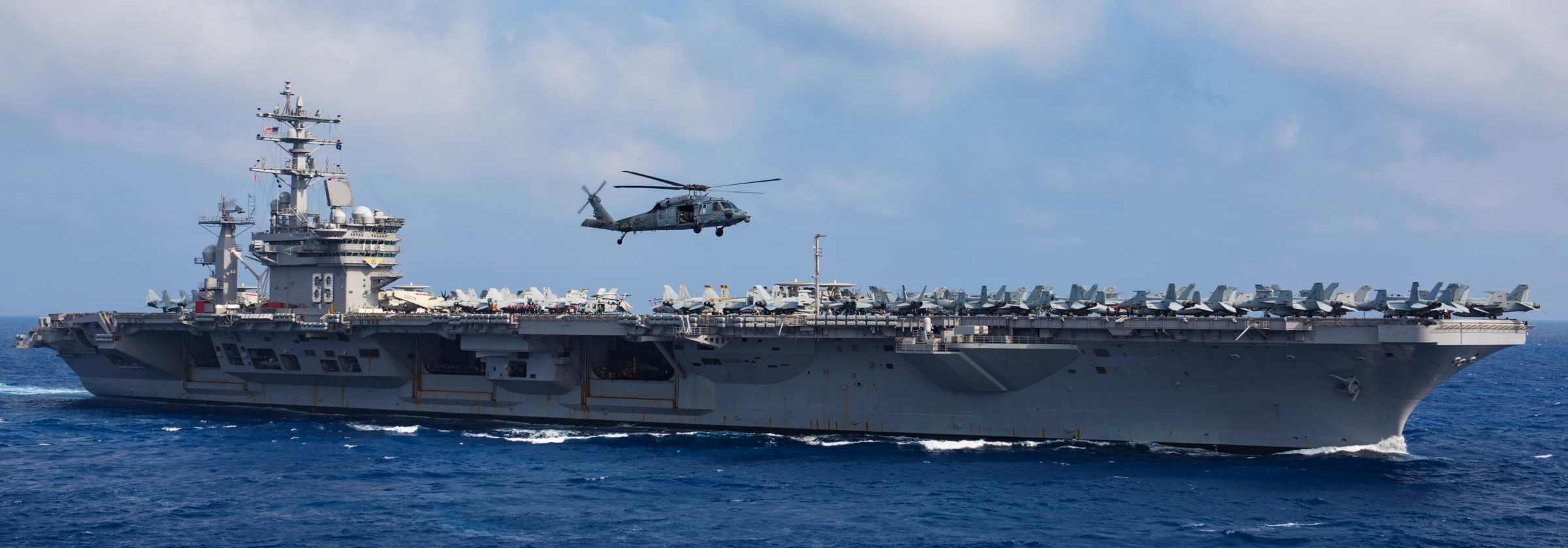 with CVW-3 embarked - June 2016 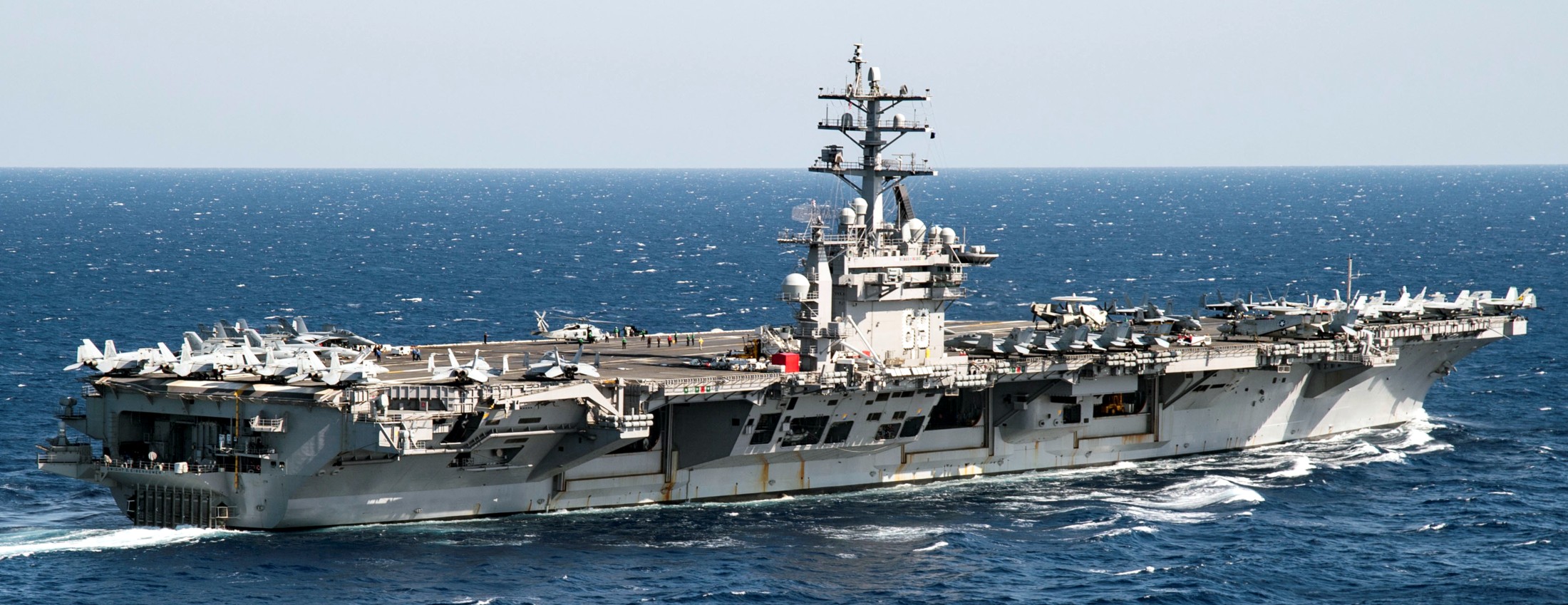 with CVW-3 embarked - Atlantic Ocean - April 2016 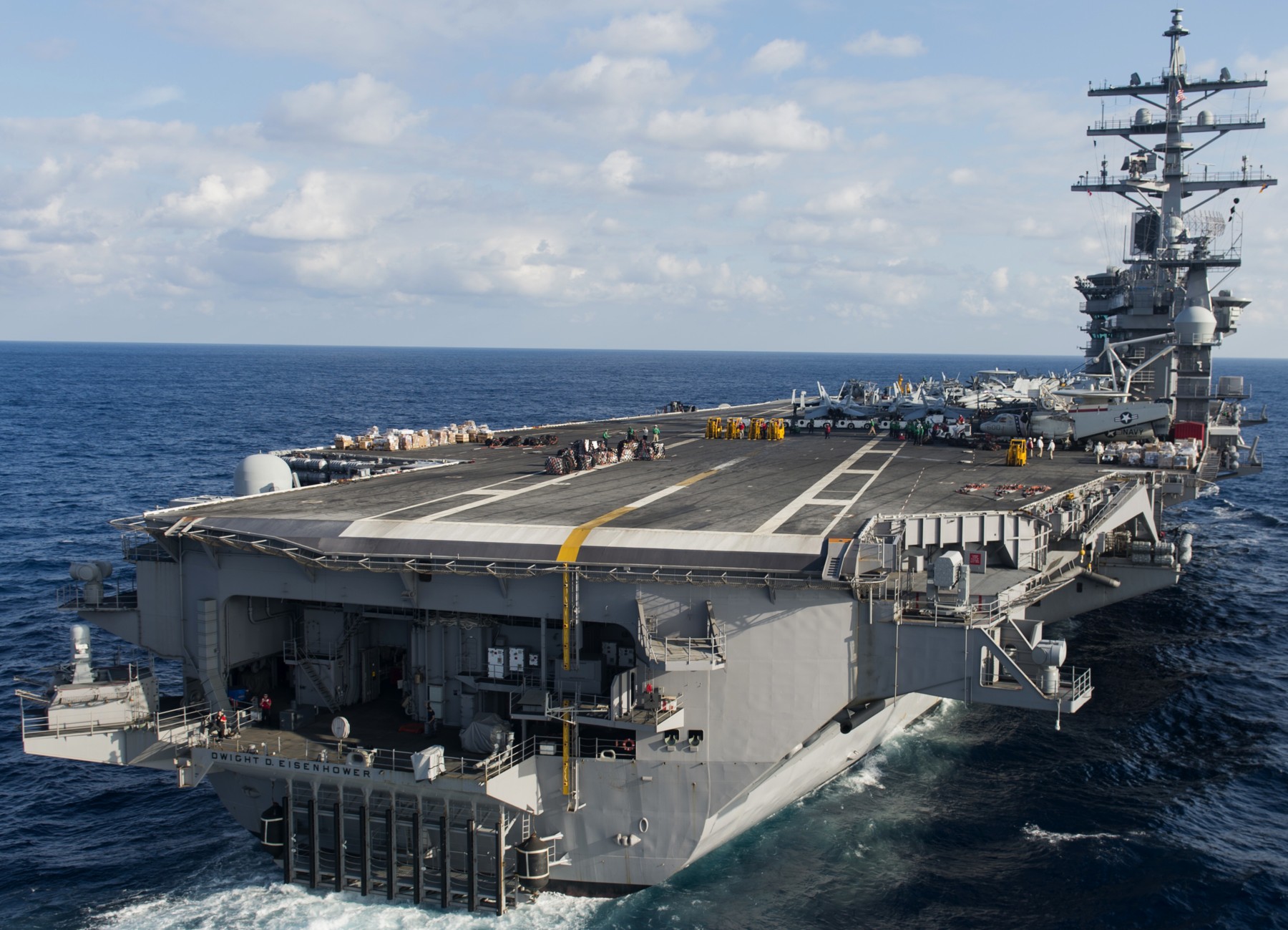 with CVW-3 embarked - COMPTUEX - Atlantic Ocean - March 2016 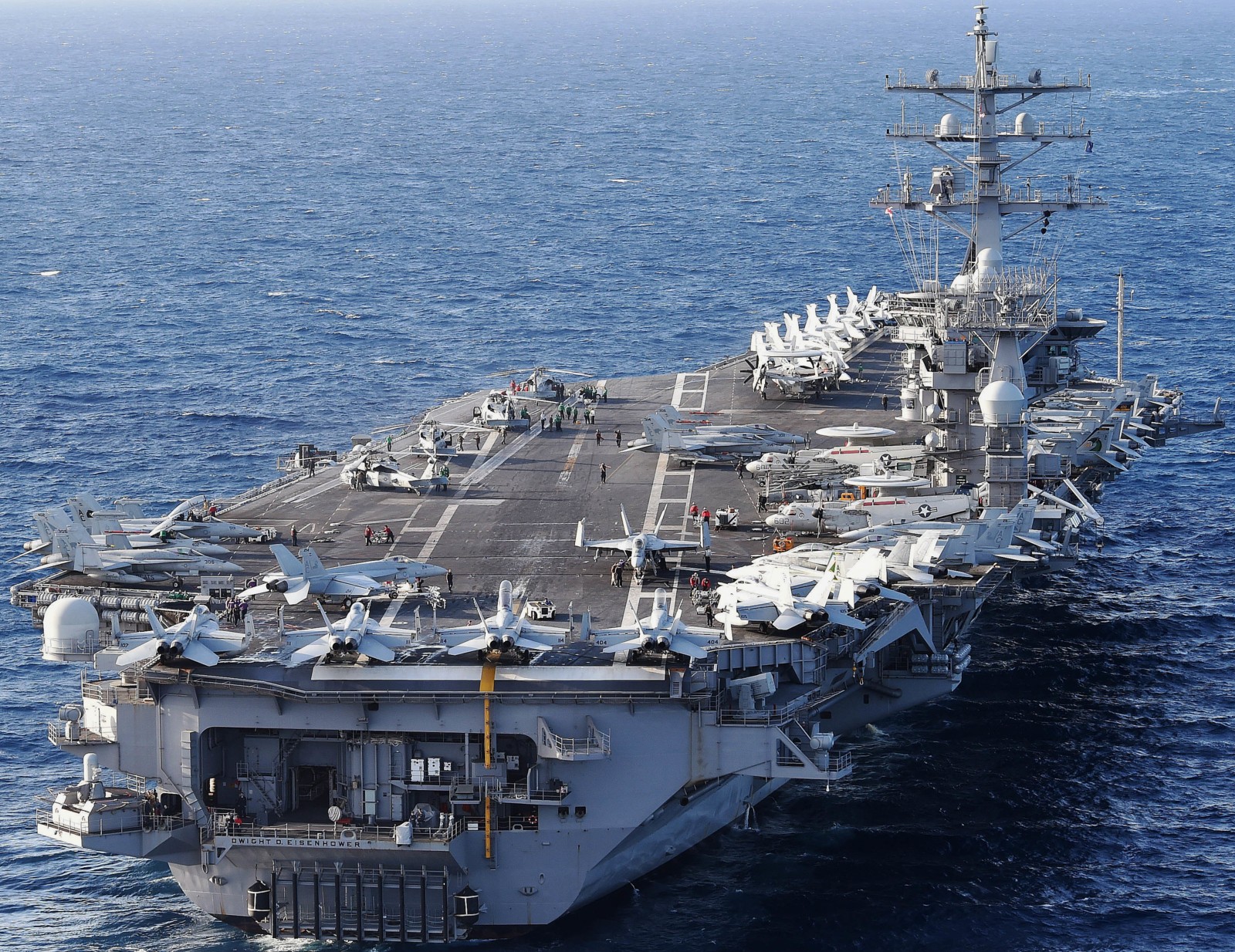 with CVW-3 embarked - COMPTUEX - Atlantic Ocean - March 2016 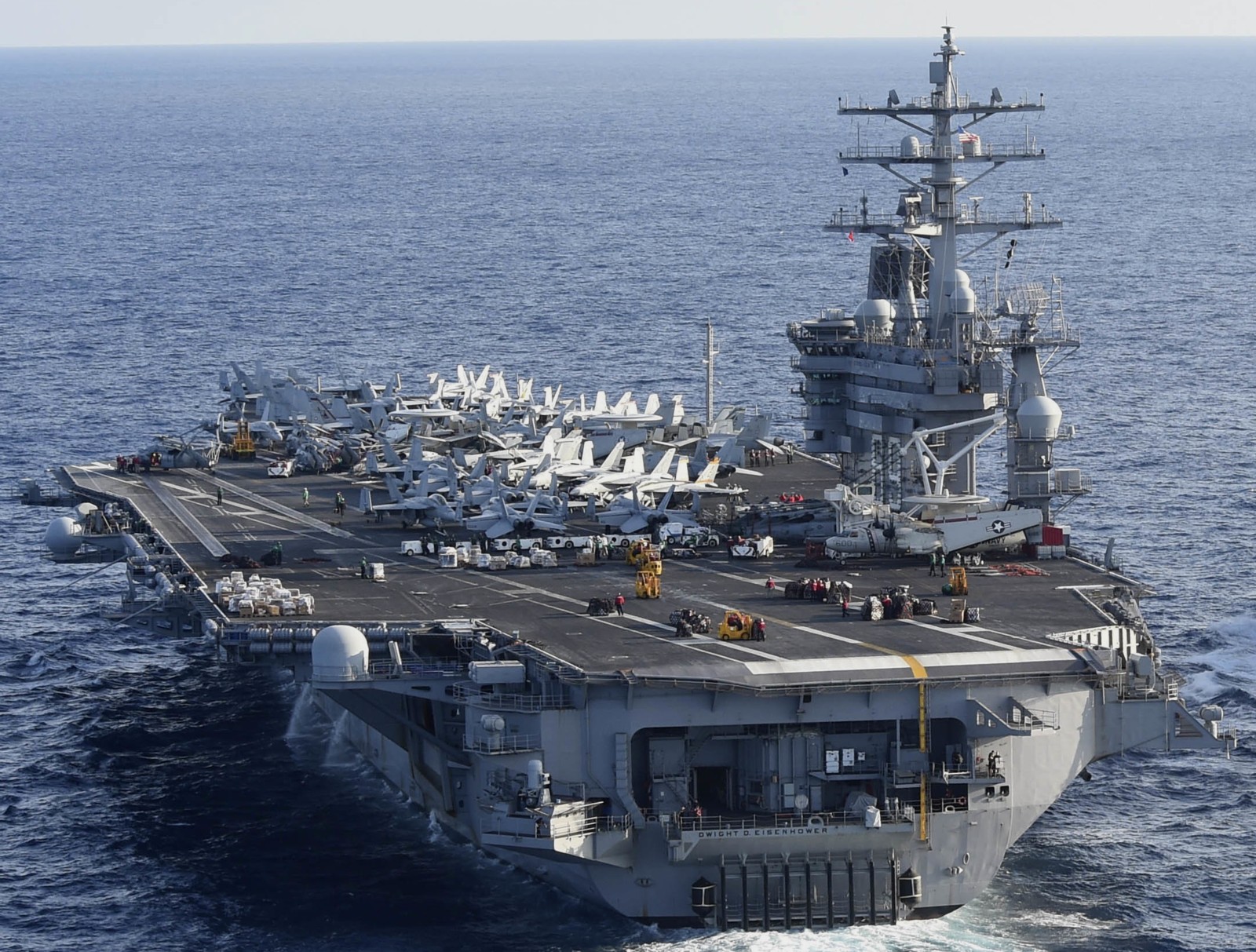 with CVW-3 embarked - COMPTUEX - Atlantic Ocean - March 2016 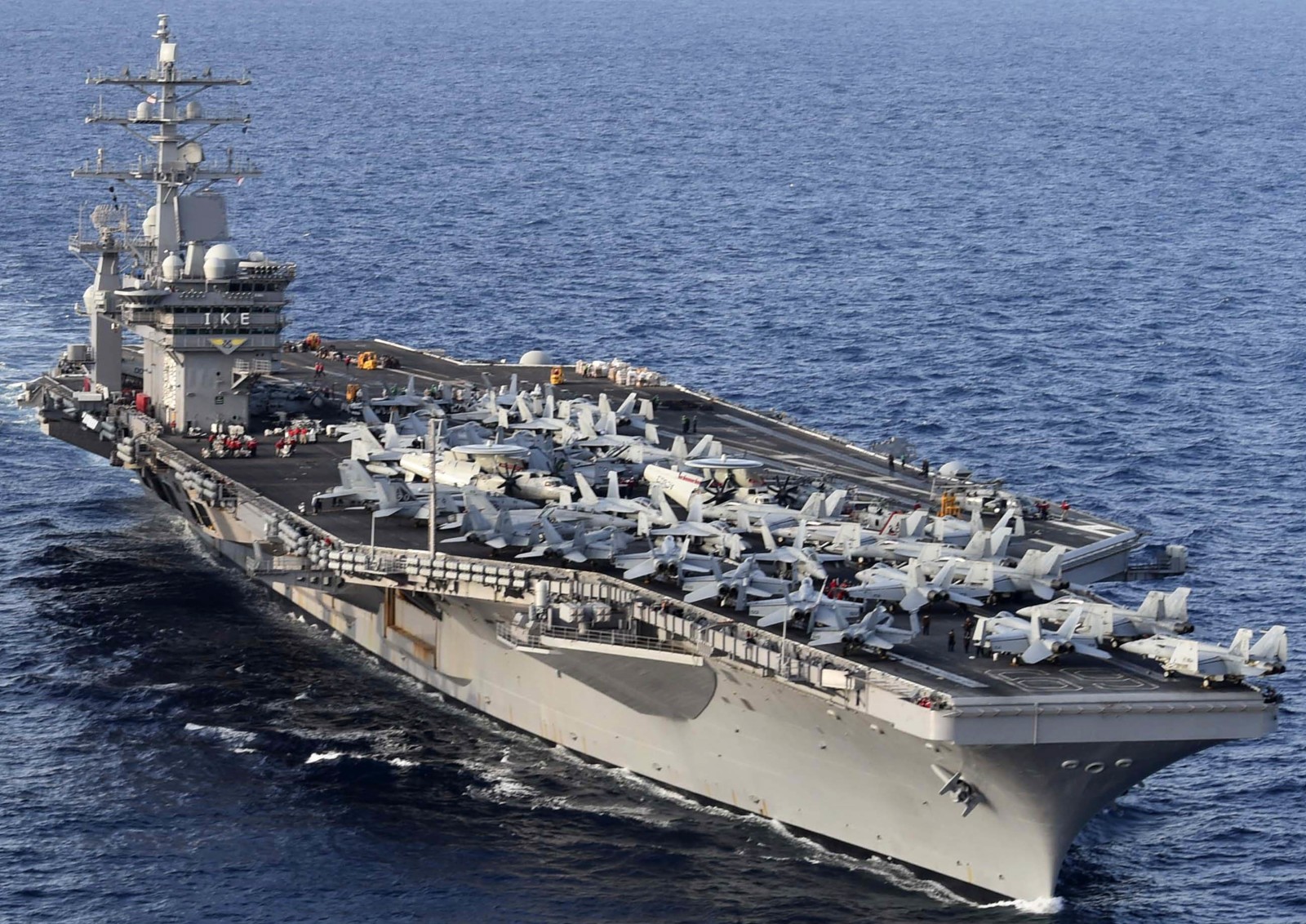 with CVW-3 embarked - COMPTUEX - Atlantic Ocean - March 2016 > continue - CVN 69 image page 2 < > continue - CVN 69 image page 3 < |
||
Dwight D. Eisenhower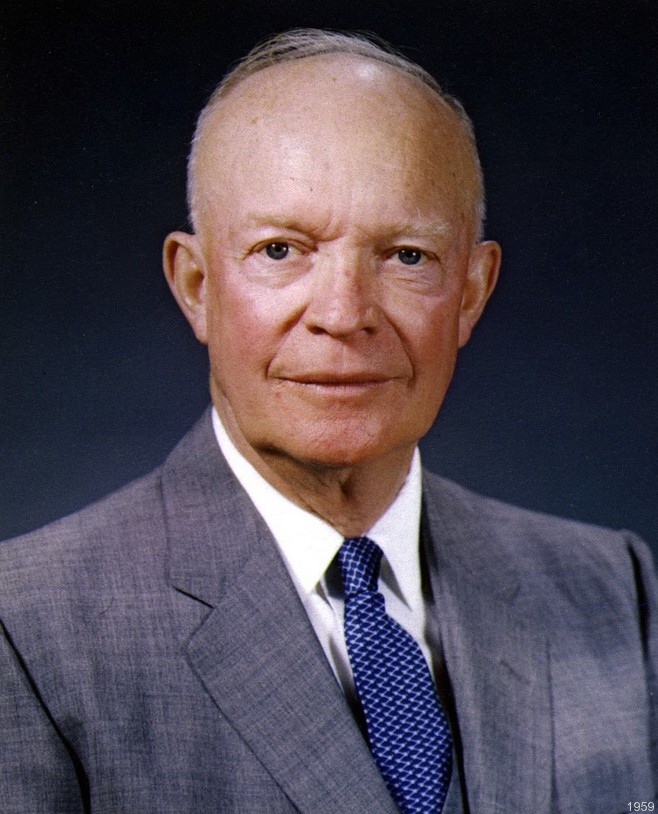 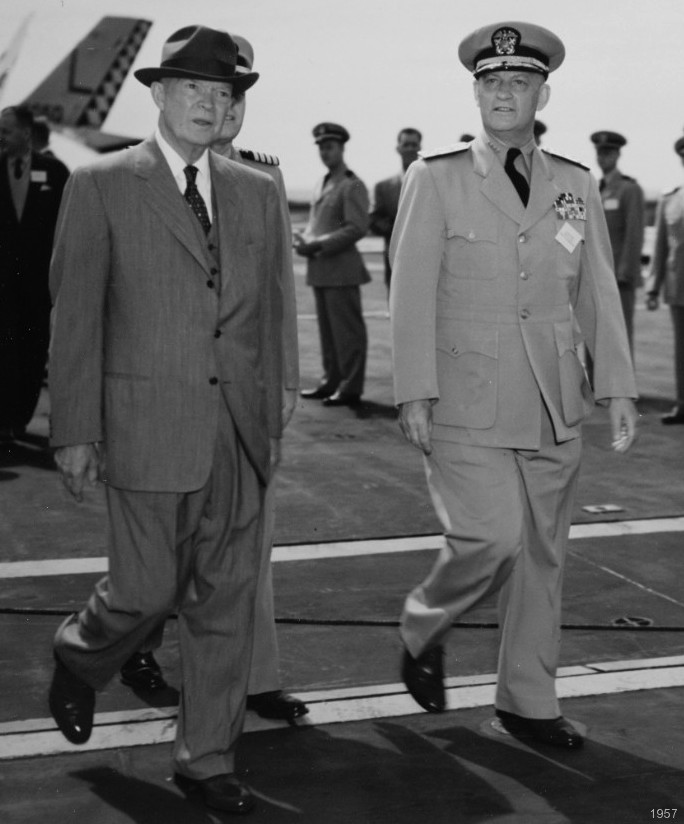 with Admiral Arleigh Burke 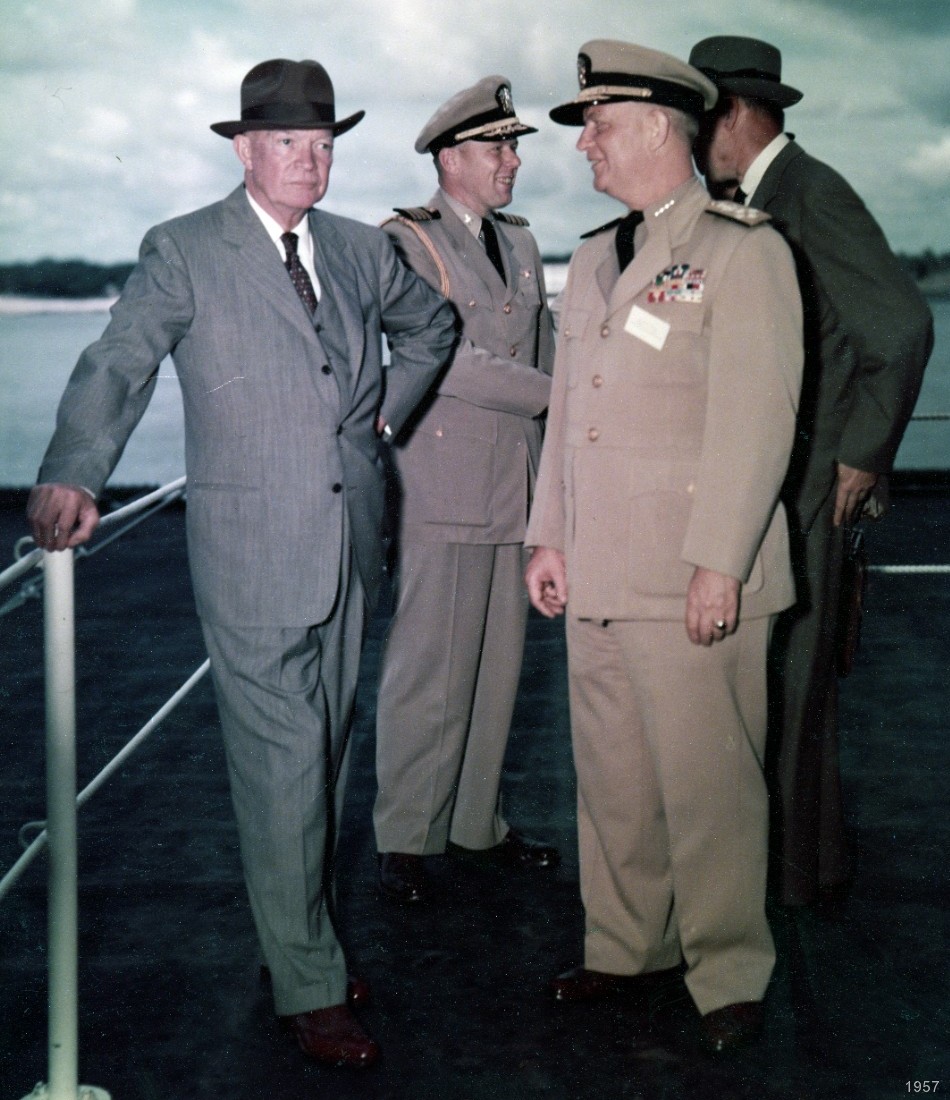 with Admiral Arleigh Burke 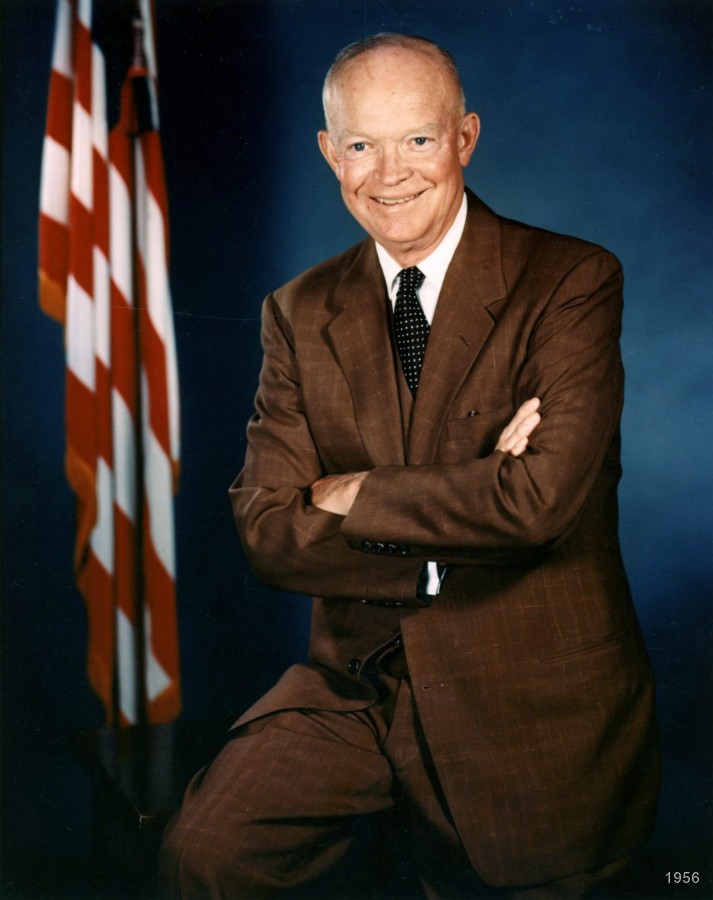 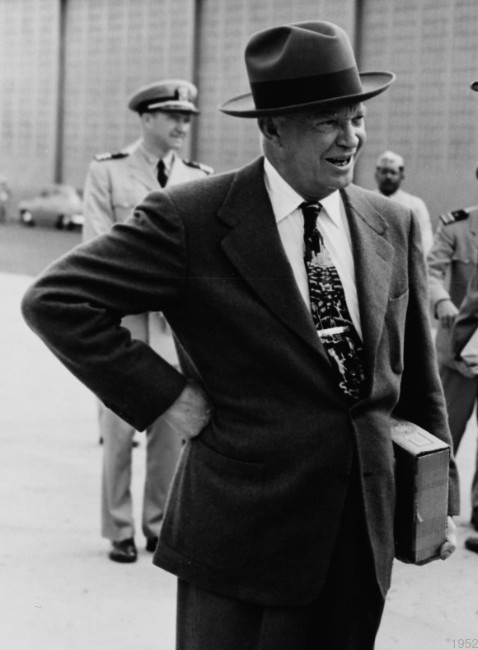 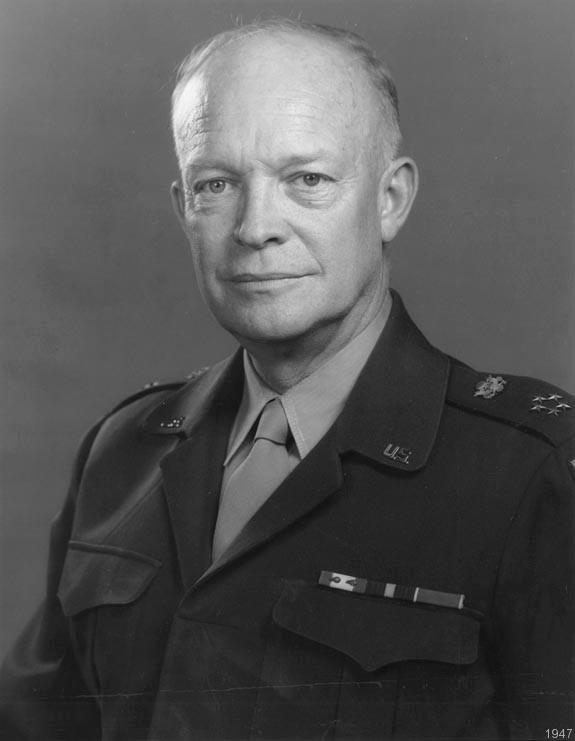 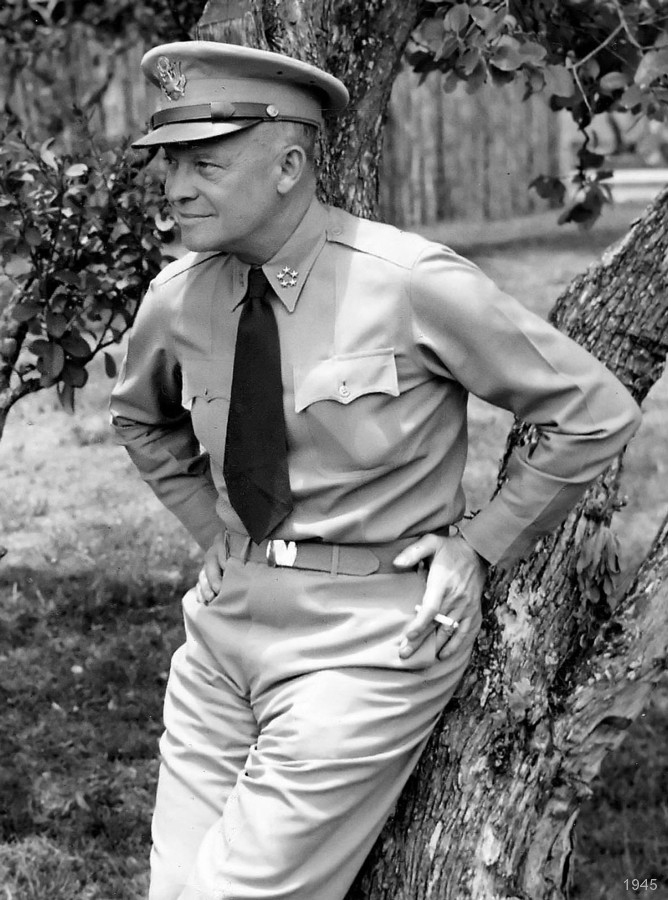 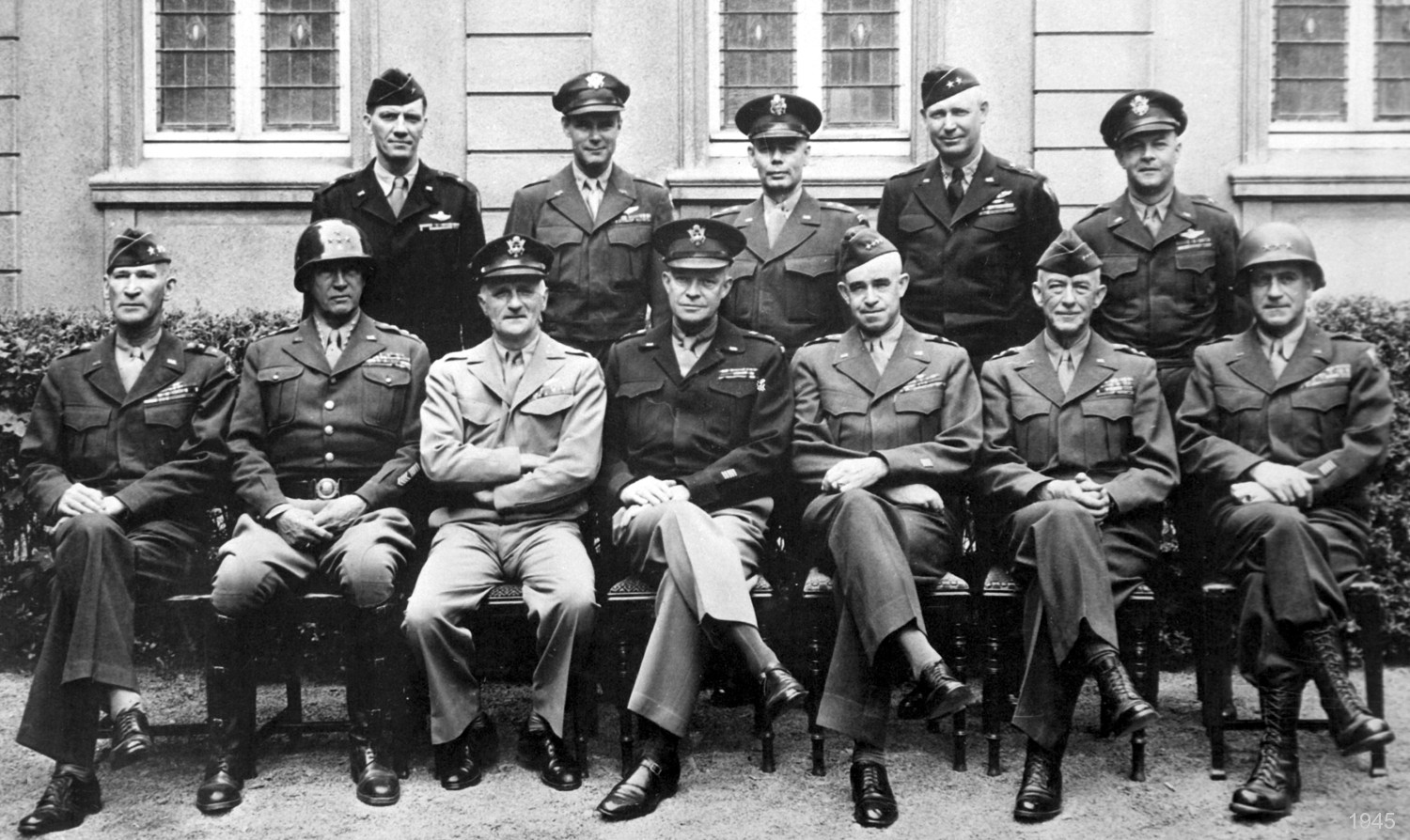 center 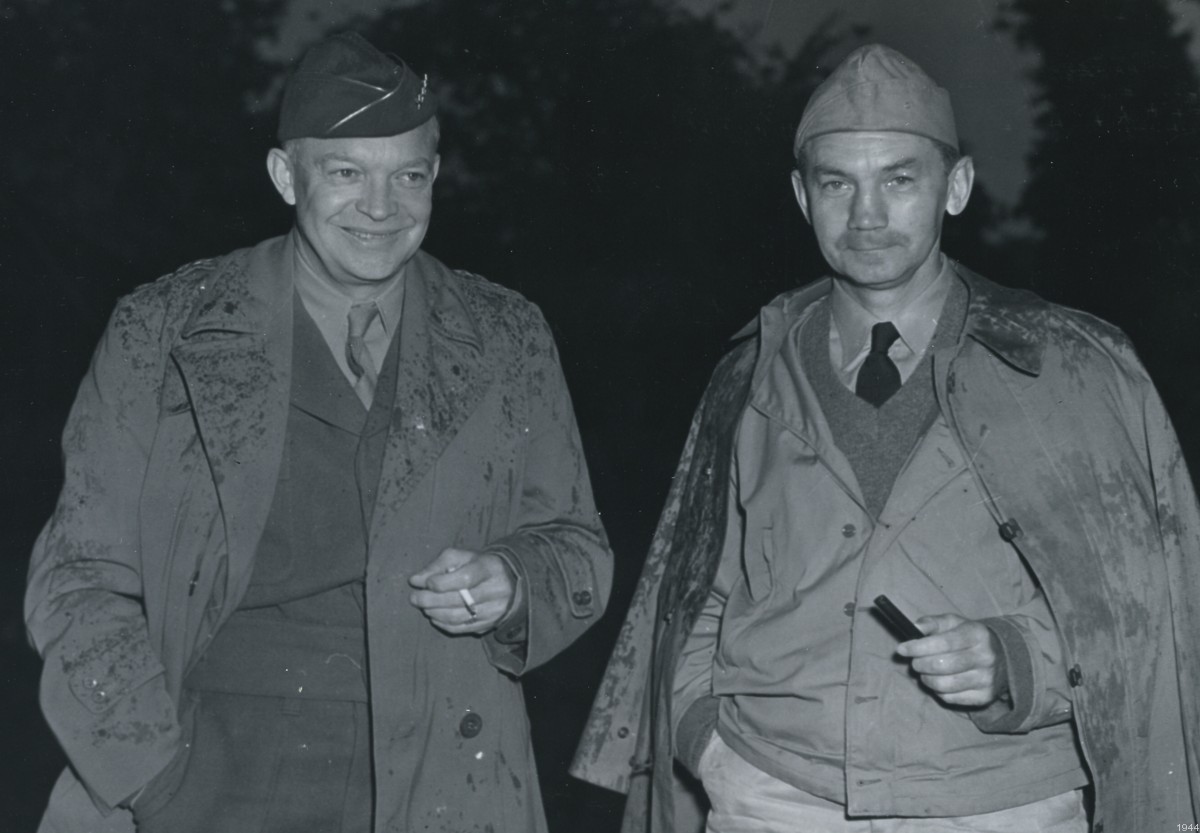 with Secretary of the Navy James Forrestal 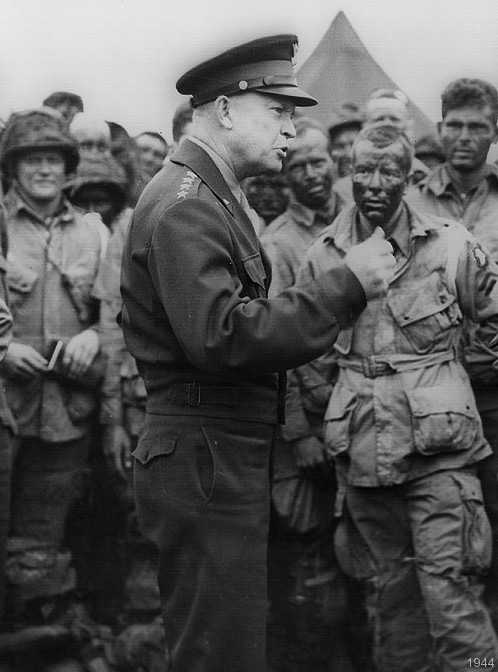 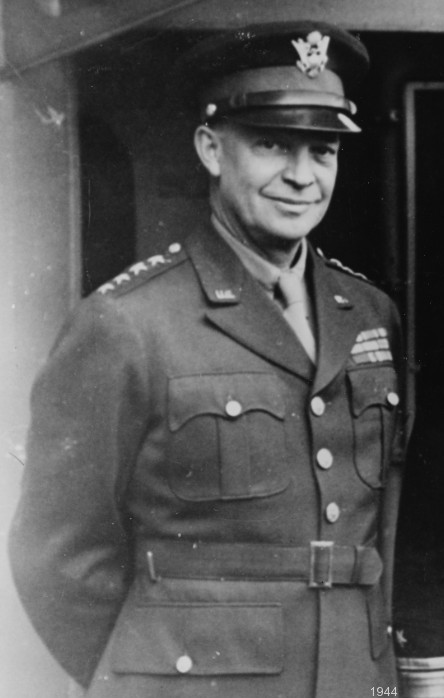 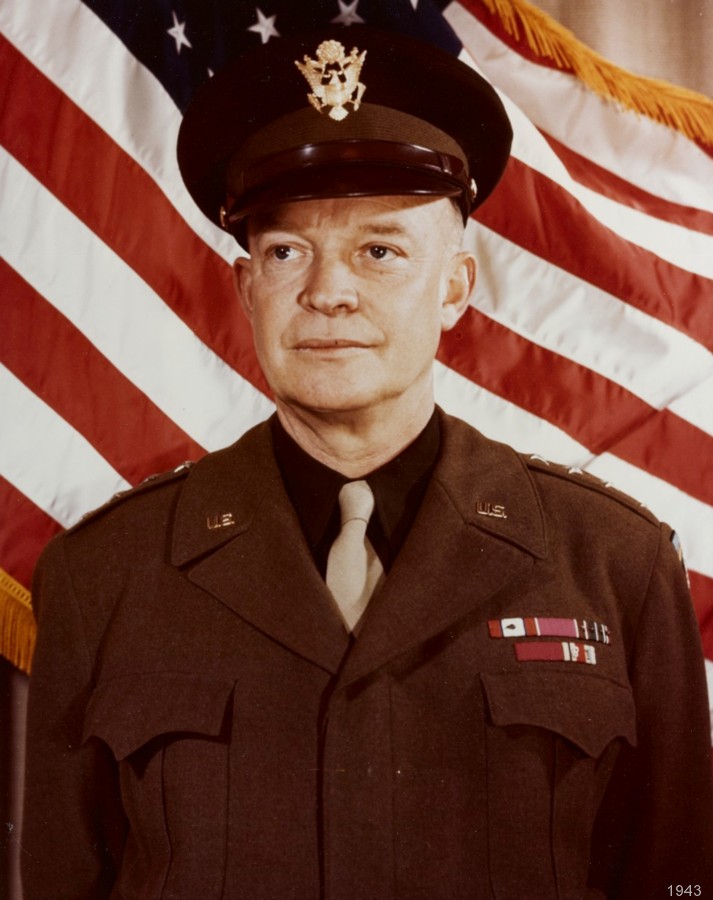 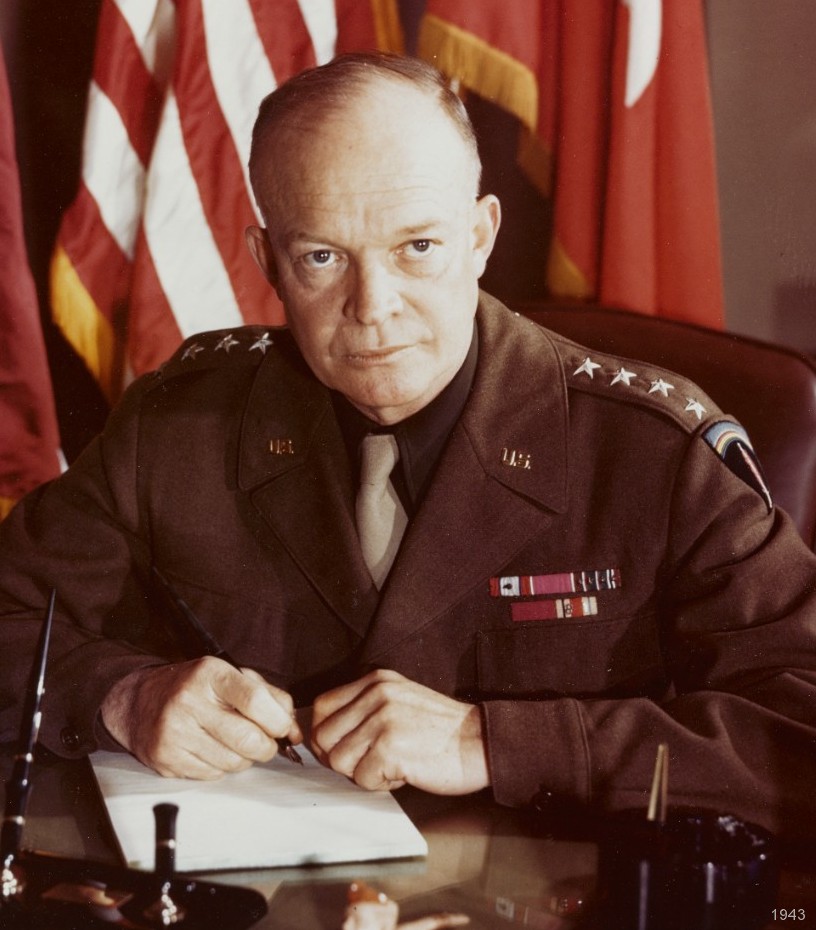 |
||
|
Dwight David "Ike" Eisenhower (October 14, 1890 - March 28,
1969) ... was a five-star general in the United States Army and the 34th President of the United States, from 1953 until 1961, and the last to be born in the 19th century. During World War II, he served as Supreme Commander of the Allied forces in Europe, with responsibility for planning and supervising the successful invasion of France and Germany in 1944-45, from the Western Front. Born in Texas and raised in Abilene, Kansas, Eisenhower enrolled at the United States Military Academy at West Point in June 1911. His parents, who were against militarism, did not object to his entering West Point because they supported his education. Eisenhower was a strong athlete and enjoyed notable successes in his competitive endeavors. Eisenhower graduated in 1915. He served with the infantry until 1918 at various camps in Texas and Georgia. During World War I, Eisenhower became the #3 leader of the new tank corps and rose to temporary (Bvt.) Lieutenant Colonel in the National Army. During the war he trained tank crews at "Camp Colt" - his first command - on the grounds of "Pickett's Charge" on the Gettysburg, Pennsylvania Civil War battle site. Ike and his tank crews never saw combat. After the war, Eisenhower reverted to his regular rank of captain (and was promoted to major a few days later) before assuming duties at Camp Meade, Maryland, where he remained until 1922. His interest in tank warfare was strengthened by many conversations with George S. Patton and other senior tank leaders; however their ideas on tank warfare were strongly discouraged by superiors. Eisenhower became executive officer to General Fox Conner in the Panama Canal Zone, where he served until 1924. Under Conner's tutelage, he studied military history and theory (including Karl von Clausewitz's On War), and later cited Conner's enormous influence on his military thinking. In 1925-26, he attended the Command and General Staff College at Fort Leavenworth, Kansas. There he graduated first in a class of 245 officers. He then served as a battalion commander at Fort Benning, Georgia until 1927. World War II After the Japanese attack on Pearl Harbor, Eisenhower was assigned to the General Staff in Washington, where he served until June 1942 with responsibility for creating the major war plans to defeat Japan and Germany. He was appointed Deputy Chief in charge of Pacific Defenses under the Chief of War Plans Division (WPD), General Leonard T. Gerow, and then succeeded Gerow as Chief of the War Plans Division. Then he was appointed Assistant Chief of Staff in charge of the new Operations Division (which replaced WPD) under Chief of Staff General George C. Marshall, who spotted talent and promoted accordingly. At the end of May 1942, Eisenhower accompanied Lt. Gen. Henry H. Arnold, commanding general of the Army Air Forces, to London to assess the effectiveness of the then-theater commander in England, Maj. Gen. James E. Chaney. He returned to Washington on June 3 with a pessimistic assessment, stating he had an "uneasy feeling" about Chaney and his staff. On June 23, 1942, he returned to London as Commanding General, European Theater of Operations (ETOUSA), based in London, and replaced Chaney. In November, he was also appointed Supreme Commander Allied (Expeditionary) Force of the North African Theater of Operations (NATOUSA) through the new operational Headquarters A(E)FHQ. The word "expeditionary" was dropped soon after his appointment for security reasons. In February 1943, his authority was extended as commander of AFHQ across the Mediterranean basin to include the British 8th Army, commanded by General Bernard Law Montgomery. The 8th Army had advanced across the Western Desert from the east and was ready for the start of the Tunisia Campaign. Eisenhower gained his fourth star and gave up command of ETOUSA to be commander of NATOUSA. After the capitulation of Axis forces in North Africa, Eisenhower oversaw the invasion of Sicily and the invasion of the Italian mainland. In December 1943, Roosevelt decided that Eisenhower - not Marshall - would be Supreme Allied Commander in Europe. In January 1944, he resumed command of ETOUSA and the following month was officially designated as the Supreme Allied Commander of the Allied Expeditionary Force (SHAEF), serving in a dual role until the end of hostilities in Europe in May 1945. In these positions he was charged with planning and carrying out the Allied assault on the coast of Normandy in June 1944 under the code name Operation Overlord, the liberation of western Europe and the invasion of Germany. A month after the Normandy D-Day landings on June 6, 1944, the invasion of southern France took place, and control of the forces which took part in the southern invasion passed from the AFHQ to the SHAEF. From then until the end of the War in Europe on May 8, 1945, Eisenhower through SHAEF had supreme command of all operational Allied forces, and through his command of ETOUSA, administrative command of all U.S. forces, on the Western Front north of the Alps. As recognition of his senior position in the Allied command, on December 20, 1944, he was promoted to General of the Army, equivalent to the rank of Field Marshal in most European armies. In this and the previous high commands he held, Eisenhower showed his great talents for leadership and diplomacy. Although he had never seen action himself, he won the respect of front-line commanders. He dealt skillfully with difficult subordinates such as Patton, and allies such as Winston Churchill, Field Marshal Bernard Montgomery and General Charles de Gaulle. He had fundamental disagreements with Churchill and Montgomery over questions of strategy, but these rarely upset his relationships with them. He negotiated with Soviet Marshal Zhukov, and such was the confidence that President Franklin D. Roosevelt had in him, he sometimes worked directly with Stalin, much to the chagrin of the British High Command who disliked being bypassed. In 1951, he became the first supreme commander of NATO. A Republican, Eisenhower entered the 1952 presidential race to counter the non-interventionism of Sen. Robert A. Taft, and to crusade against "Communism, Korea and corruption". He won by a landslide, defeating Democrat Adlai Stevenson and ending two decades of the New Deal Coalition holding the White House. As President, Eisenhower concluded negotiations with China to end the Korean War. He maintained pressure on the Soviet Union during the Cold War, gave priority to inexpensive nuclear weapons and reduced the other forces to save money. He had to play catch-up in the Space Race after the Soviets launched the Sputnik satellite in 1957. On the domestic front, he helped remove Joseph McCarthy from power but otherwise left most political actions to his Vice President, Richard Nixon. Eisenhower did not end New Deal policies, and in fact enlarged the scope of Social Security, and signed the Federal-Aid Highway Act of 1956. He was the first term-limited president in accordance with the 22nd Amendment. His two terms were mainly peaceful, and generally prosperous except for a sharp economic recession in 1958-59. Historians typically rank Eisenhower among the ten greatest U.S. presidents. Post presidency: Eisenhower retired to the place where he and Mamie had spent much of their post-war time, a working farm adjacent to the battlefield at Gettysburg, Pennsylvania. In 1967, the Eisenhowers donated the farm to the National Park Service and since 1980 it has been open to the public as the Eisenhower National Historic Site. In retirement, he did not completely retreat from political life; he spoke at the 1964 Republican National Convention and appeared with Barry Goldwater in a Republican campaign commercial from Gettysburg. Death and funeral Eisenhower died of congestive heart failure on March 28, 1969, at Walter Reed Army Hospital in Washington D.C. The following day his body was moved to the Washington National Cathedral's Bethlehem Chapel where he lay in repose for twenty-eight hours. On March 30, his body was brought by caisson to the United States Capitol where he lay in state in the Capitol Rotunda. On March 31, Eisenhower's body was returned to the National Cathedral where he was given an Episcopal Church funeral service. That evening, Eisenhower's body was placed onto a train en route to Abilene, Kansas. His body arrived on April 2, and was interred later that day in a small chapel on the grounds of the Eisenhower Presidential Library. Eisenhower is buried alongside his son Doud who died at age 3 in 1921, and his wife, Mamie, who died in 1979. Richard Nixon, by this time himself President, spoke of Eisenhower's death, "Some men are considered great because they lead great armies or they lead powerful nations. For eight years now, Dwight Eisenhower has neither commanded an army nor led a nation; and yet he remained through his final days the world's most admired and respected man, truly the first citizen of the world." source: CVN-69 website |
||
|
Chronology and Significant Events: 21 Feb 1970: Secretary of the Navy John H. Chaffee assigned the name Eisenhower to CVAN-69. 25 May 1970: Secretary of the Navy Chaffee changed the ship’s name from Eisenhower to Dwight D. Eisenhower. 15 Aug 1970. Dwight David Eisenhower, II, the former President’s grandson, authenticated the keel of Newport News Shipbuilding and Dry Dock Company’s Hull No. 599 in Shipway No. 11. A quote from the ship's namesake highlighted the ceremony: Until war is eliminated from international relations, unpreparedness for it is well nigh as criminal as war itself. 6 Aug 1975: The Navy established Precommissioning Unit (PCU) Dwight D. Eisenhower (CVN-69) at Newport News. During her construction the men of the unit berthed ashore at the "Ike Building." CWO2 Garry C. Garren became the first officer of the ship's company to report on board, followed by DT2 Robert A. Odum, her initial enlisted sailor. CAPT William E. Ramsey and CDR Edward W. Clexton, Jr. (who would later become her fourth CO), Dwight D. Eisenhower's first commanding and executive officers, respectively, arrived on 10 October. Thirty officers and 282 enlisted sailors reported on board by the end of 1975. 11 Oct 1975: At 1111 Dwight D. Eisenhower slid down the ways and entered the water, at which point eight tugs assisted her across the James River to Pier 2 at the shipyard. Vice President Nelson A. Rockefeller addressed the crowd of over 8,000 at one point in the ceremony, and dignitaries in attendance included Secretary of the Navy J. William Middendorf II, ADM James L. Holloway, III (Chief of Naval Operations), ADM Hyman G. Rickover (Navy Nuclear Propulsion Director), ADM Isaac C. Kidd, Jr. (Commander-in-Chief, Atlantic Fleet) former Ambassador John S.D. Eisenhower, son of the late President, Virginia Governor Mills E. Godwin, Jr., and CAPT Ramsey. The vice president warned the audience that Dwight D. Eisenhower should help them to recognize that the Republic could not fall behind East Bloc expansion to become -the second greatest seapower. 3 May 1976: VADM Howard E. Greer, Commander Naval Air Force, Atlantic Fleet, announced that a six-member committee had approved the ship’s insignia (see above for image) from among 28 proposed designs. 11 Apr 1977: The PCU moved on board. 15 Jul 1977: Dwight D. Eisenhower placed in service, reflecting her status as a “sea-duty command. 23-28 Jul 1977: Dwight D. Eisenhower completed her first fast cruise (simulating getting underway without actually leaving the pier) to test equipment and systems. 30 Jul-1 Aug 1977: Dwight D. Eisenhower conducted builder-s sea trials off the Virginia capes , her first time underway at sea. LT David L. Hallanbeck of Helicopter Combat Support Squadron (HC) 6 accomplished the first aircraft landing on board in a Sikorsky VH-3A Sea King at 1403 on the 30th. "We thrill to Ike's majesty and mastery of the sea," intoned CAPT Billy J. McKee, senior chaplain, during Dwight D. Eisenhower's first Navy prayer at sea on that date. The ship returned with a broom tied to her masthead, the traditional symbol of victory at sea, proclaiming a "clean sweep." 23-24 Aug 1977: Dwight D. Eisenhower completed her acceptance trials off the Virginia capes. 12 Sep 1977: The shipyard delivered the ship to the Navy, after which the crew welcomed their families on board for their initial dependent’s cruise into Chesapeake Bay. Dwight D. Eisenhower returned to her new home port at Pier 12 , Naval Station (NS) Norfolk , Va. 15 Sep 1977: With "perfect weather" cooperating, CAPT Ramsey made the ships first aircraft launch in COD 69, Dwight D. Eisenhower's Grumman C-1A Trader, known affectionately by the crew as Mamie, at 1519, manned by CDR Richard J. Palma, Chief Joe Severns, ADR1s David H. Sevener and Joe V. Hutchenson, AE2 Kenneth R. Baird and Dr. William N. Houk. The CO made 10 more launches and traps, bringing his career total to 900 arrested landings. 16 Sep 1977: Dwight D. Eisenhower completed her initial underway replenishment by coming alongside oiler Marias (T-AO-57). The carrier experienced a sudden engineering problem during the evolution, forcing her to perform an "emergency breakaway" to avoid a potentially dangerous accident. 18 Oct 1977: "Break the commissioning pennant," ordered CDR Clexton at 1111, exactly two years and seven days to the minute since her christening, as the Navy commissioned Dwight D. Eisenhower at Pier 12 at Norfolk . Secretary of Defense Dr. Harold Brown, ADMs Holloway and Kidd, VADM Greer, and Mamie and John Eisenhower were among the crowd of thousands gathered beneath “a cloudless blue sky. 20-28 Oct 1977: During the afternoon watch on the 20th, CDR Gary F. Wheatley, Commander Carrier Air Wing (CVW) 1, accomplished the first jet landing on board in AB 302, a Ling-Temco-Vought A-7E Corsair II from Attack Squadron (VA) 46. Meanwhile, Naval Air Test Center (NATC) Patuxent River, Md., people tested the arresting gear, catapults and automatic carrier landing system using specially instrumented aircraft, completing Dwight D. Eisenhower's first aerial operations. In addition, the ship fired her Basic Point Defense Missile System (BPDMS) for the first time, hitting six of six Ryan (Teledyne) BQM-34E Firebee II drones. LCDR David L. Newton and LT David Anderson of the Strike Aircraft Test Directorate accomplished the first jet catapult launch in a Grumman A-6E Intruder from catapult No. 1. LCDR Frederick C. Lentz of that command followed them with the ship’s first automatic carrier landing, in an A-7A Corsair II.on the 21st. 6 Nov-13 Dec 1977: Dwight D. Eisenhower completed refresher training and carrier qualifications off Guantánamo Bay, Cuba, followed by missile testing at the Atlantic Fleet Weapons Range at Puerto Rico. During the later, VF-32 participated with Air Test and Evaluation Squadron (VX) 4 in the operational evaluation of AIM-7F Sparrow air-to-air missiles. Fighter Squadron (VF) 14 and VF-32, VA-34, VA-46 and VA-72, Air Antisubmarine Squadron (VS) 32, Airborne Early Warning Squadron (VAW) 125 and Helicopter Antisubmarine Squadron (HS) 11 embarked with CVW-1. 3 Dec 1977: AB 405, a Corsair II, LCDR Harold “Hal” Andersen of VA-72, suffered a mechanical malfunction and crashed shortly after launching from catapult No. 4. Andersen ejected and the ship launched a motor whaleboat, assisted by a Sikorsky SH-3D from HS-11, to recover him. The Sea King crew dropped a swimmer to retrieve the pilot, but Andersen apparently had become entangled in his parachute and he died from his injuries, most likely from drowning. The rescuers could not recover AB 405. 5 Dec 1977: VADM Greer and golf pro Arnold Palmer visited the ship. 7 Dec 1977: Two Soviet Tupolev Tu-95D Bears reconnoitered the ship, but Grumman F-14A Tomcats from VF-14 and VF-32 intercepted the snoopers at 100 nautical miles and escorted them out of the area. 9 Dec 1977: Two Bears en route to Cuba overflew Dwight D. Eisenhower on her return to Norfolk . Tomcats again intercepted the Russians and escorted them away from the ship. 5-31 Jan 1978: During a cruise in the Caribbean to conduct flight operations and damage control training Dwight D. Eisenhower visited her first port outside of the continental U.S., St. Thomas,Virgin Islands (21-23 January). 22-27 Feb 1978: The crew completed their Improved Rapid Rearming Program Evaluation, designed to test their ability to deliver ordnance to aircraft and launch them in a series of simulated wartime exercises. 1 Mar 1978: Although elements of CVW-7 had operated from the ship previously, the Navy did not assign the wing per se to Dwight D. Eisenhower until this date. During the first dog watch a Boeing HH-46A from HC-16 (BuNo 150950) encountered mechanical difficulties while in the plane guard position about 100 yards off Dwight D. Eisenhower-s starboard quarter, about 60 miles southeast of Jacksonville, Fla., at 29-54-N, 80-16-4-W. The weather was calm with clear visibility, as the Sea Knight suddenly rolled rapidly to the right, crashed into the water tail first and sank, inverted, disappearing from view in barely 30 seconds. “Helo in the water” announced the ship’s 1-MC speaker at 1652 as the ship lowered a motor whaleboat, whose crew recovered LT(JG) Howard M. Tillison and AD2 Richard L. Dolick. LT(JG) Frederic L. Bell and ADC John R. Bazan, however, the other two crewmen, died in the mishap. Helo Nos 404 and 411 from HC-16 participated in the rescue. An investigation determined that the most probable cause of the accident was a “catastrophic failure” of an upper aft flight control assembly on the Sea Knight, resulting in severe movements of the aft rotor head, including a reduction in blade pitch and loss of lift. 17 Mar 1978: At 1230, President James E. "Jimmy" Carter and his wife Rosalynn stepped out of their helo onto the flight deck. “I’m still one of you,” noted the President, referring to his naval service. He later joined the crew for lunch on the mess decks. National Security Advisor Dr. Zbigniew Brzezinski, Secretary of Defense Brown, Secretary of the Navy W. Graham Claytor, Jr., and ADM Holloway accompanied the President and the First Lady during Operation Shamrock. The presidential party viewed Combined Weapons Training exercise involving Dwight D. Eisenhower and CVW-7, aircraft carrier John F. Kennedy (CV-67) and CVW-1, guided missile cruiser Virginia (CGN-38), destroyer Peterson (DD-969) and frigate Ainsworth (FF-1090). VADM Wesley L. McDonald, Commander, Second Fleet, acted as Battle Force Commander; CAPT Ramsey commanded all air elements. 27 Mar 1978: A dense fog blanketing the area forced cancellation of a brief trip across Chesapeake Bay for their families and friends, so the crew held an “Open House” on board, hosting almost 10,000 visitors. 28 Mar 1978: Dwight D. Eisenhower eased down the Elizabeth River from Norfolk to the Norfolk Naval Shipyard, Portsmouth , Va. , for post shakedown availability. 8 Apr-3 Jun 1978: The ship received underwater hull modifications and repairs to spaces and equipment while drydocked at Norfolk Naval Shipyard. 18-26 Sep 1978: While type training off Roosevelt Roads, Puerto Rico, Dwight D. Eisenhower embarked CVW-7, including several new squadrons to the wing: VF-142 and VF-143 and Tactical Electronics Warfare Squadron (VAQ) 138. 18 Oct 1978: During a ceremony marking Dwight D. Eisenhower's first year of commission, 69 men of the ship’s company and air wing reenlisted on the flight deck, “a fitting match,” noted her command historian “for the ship’s hull number.” 14 Nov-4 Dec 1978: Under the command of RADM Robert L. Walters, Commander Cruiser Destroyer Group 8, Dwight D. Eisenhower participated in Gulf-Ex 79, a task force readiness exercise in the western Caribbean that involved over 20,000 U.S. and British servicemembers, 36 ships, two submarines and more than 300 aircraft. Dec 1978: ABE3 Ralston J. Carey, AN Charles L. Sherron and ABEAA William V. Becker saved three shipmates trapped inside a burning vehicle ashore. All three men later received the Navy Marine Corps Medal for Heroism for their prompt and bold actions. 16-27 Jan 1979: Heavy seas pounded the ship during her first voyage toward the Mediterranean. 27-30 Jan 1979: Dwight D. Eisenhower entered the Sixth Fleet’s area of responsibility. The ship arrived at Rota, Spain, to relieve John F. Kennedy over the 27th-29th, following which she passed through the Strait of Gibraltar during the early morning hours of the 30th, and into the Mediterranean for the first time. Two Algerian Mikoyan Gurevich (MiG)-21F-13 Fishbeds attempted to investigate Dwight D. Eisenhower on that date, but a pair of Tomcats from the ship intercepted them outside of effective strike range and forced the MiGs to return to their Algerian field. Through most of the deployment, guided missile cruisers South Carolina (CGN-37) and Virginia sailed with the carrier; often arrayed against them were a host of submarines: Sculpin (SSN-590) and Silversides (SSN-679), the French La Praya (S-622), Spanish Delfin (S-61) and Italian Livio Piomarta (S-515), who made repeated attacks against the carrier simulating Soviet boats. During ports of call, Dwight D. Eisenhower established a concession stand ashore for liberty parties, which the crew named “IkeDonalds” after the popular food chain. 16-18 Feb 1979: Southeast winds approaching 35-40 knots over the Ionian Sea combined with North African dust and haze blowing out to sea to force the ship to cancel her final three flights on the 16th and the last two on the 18th, due to near zero visibility and seas raging up to 12 feet. 26 Feb-4 Mar 1979: Dwight D. Eisenhower operated in National Week XXVI/Sardinia 1-79, a combined task force exercise involving over 50 ships and 300 aircraft from various NATO countries, designed to test the strength of amphibious forces in the Mediterranean . Dwight D. Eisenhower swept ahead of the Orange (friendly) forces and acted as a decoy to lure opposing forces’ submarines away from the landings. 18 Mar 1979: Heavy fog blanketed the carrier in the Ionian Sea , forcing Dwight D. Eisenhower to cancel flight operations later in the day. 20 Mar-2 Apr 1979: A "strong" southwestern wind swept across the Tyrrhenian Sea, causing heavy weather wind gusts up to 52 knots and swells approaching 11 feet at one point that consistently imperiled operations. 22-28 Apr 1979: Dwight D. Eisenhower participated in MultiplEx 1-79, a "multi-dimensional warfare" exercise involving dual battle group training with aircraft carrier America (CV-66), in the Ionian Sea. 10 May 1979: Dwight D. Eisenhower performed an air power demonstration for an Israeli delegation led by President Yitzhak Navon, Prime Minister Menachem Begin and Defense Minister Ezer Weizman, off Haifa , Israel. 17-24 May 1979: Dwight D. Eisenhower took part in the final two phases of the three phase maritime support Operation Dawn Patrol-79. Eighty other NATO vessels participated in the huge exercise, including America and the French aircraft carrier Clemenceau (R-98), the three carriers comprising NATO Task Force 502. Dwight D. Eisenhower provided close air support against the Vatika Target in Greece and simulated strike support at Gioia Del Colle Target in Italy. Upon the conclusion of Dawn Patrol-79 the ship steamed westward through the Strait of Messina to launch strikes against Capo Frasca Target in Sardinia. 14 Jun 1979: Secretary of the Navy Claytor visited the ship. 22 Jun 1979: RADM James R. Sanderson relieved RADM Robert F. Schoultz as Commander Battle Force Sixth Fleet/Commander Carrier Group Two, on board. 6 Jul 1979: Dwight D. Eisenhower conducted a "blue water" turn over with aircraft carrier Independence (CV-62) north of the Azores. While in the Mediterranean, Dwight D. Eisenhower conducted 79 days of flight operations, logging 19,674 hours, 8,580 arrested landings and 852 helo landings. En route to the U.S., the crew did not detect Soviet aircraft or vessels monitoring their movements, though they did note Russians shadowing Independence, by then more than 700 nautical miles to the east. 15 Apr 1980: Between the autumn of 1979 and the spring of 1980, Iran ’s pro-Western government had collapsed, forcing the Shah into exile in the U.S. Ensuing tensions among opposition groups produced a state of near-anarchy. One of the more radical groups, “Students Following the Imam’s Line,” blamed the U.S. for the discord, and sought to mobilize support for their policies by seizing the U.S. Embassy in Teheran, on 4 November 1979. Receiving tacit approval from the Ayatollah R. Khomeini, the extremists continued to hold 52 American hostages. America was outraged by the act, and the government responded by ordering naval forces including Dwight D. Eisenhower to the region. Embarking Carrier Group 4, RADM Byron R. Fuller, commanding, she deployed from Pier 12 at Norfolk for the 12,000 mile voyage around the Cape of Good Hope to the Indian Ocean. 29 Apr 1980: En route to the Indian Ocean, Dwight D. Eisenhower crossed from the Atlantic to the Pacific Fleets. 7-8 May 1980: Dwight D. Eisenhower, South Carolina and Virginia relieved aircraft carrier Nimitz (CVN-68) and her group, including guided missile cruisers California (CGN-37) and Texas (CGN-39), after Nimitz-s crew endured 108 days on station. CAPT James H. Mauldin established an almost weekly "CO's Day" to allow the men to take time off and participate in "Flight Deck Olympics" and picnics. In addition, the Navy authorized a special ration of six cans of beer per man, which the captain dispensed in increments over a 60 day period. Dwight D. Eisenhower crossed the equator during this month, allowing shellbacks among the crew to cleanse over 5,000 pollywogs of "their dreaded condition." Constant Russian surveillance in the Gulf of Oman forced the launch of two Lockheed S-3A Vikings from VS-31 and two A-6Es from VA-65 for three and a half hour sorties to work the “coastline or littoral regions.” During this deployment VS-31 discovered and tracked two Soviet Echo II-class submarines and a Foxtrot-class sub shadowing the carrier, intercepted over 50 Soviet aircraft of various types (in addition to15 Iranian Lockheed P-3F Orions), and maintained surveillance of an Iranian Saam-class guided missile frigate that loitered in the vicinity. The “added tension” of the Persian Gulf War between the Iranians and Iraqis exacerbated the strain on the crew, forcing them to be ever vigilant. The large number of flight hours produced an unusual number of AIM-9L Sidewinder air-to-air missile failures, however, prompting concerns about the missile's reliability. Men requiring emergency leave had to fly to al Masirah Island, Oman, and thence to Diego Garcia, British Indian Ocean Territory, where USAF Lockheed C-141 Starlifters and C-5 Galaxies flew them on to Clark AFB, Philippines , where they embarked for other destinations, an exhausting series of flights. During the southeast monsoon that swept through the northern Indian Ocean during the late summer, sea surges increased to 11 to 13 feet, causing problems during station keeping and flight operations. Submarine tender Emory S. Land (AS-39) operating off Diego Garcia provided calibrating capabilities to the Avionics Division. 8-9 Jul 1980: The ship participated in exercise Gonzo 4-80/MultiplEx 1-80 in the northern Arabian Sea. 17-22 Jul 1980: Dwight D. Eisenhower put into Singapore, the first liberty for her crew after 254 grueling days at sea. The ship then returned to the northern Arabian Sea via the Strait of Malacca. The readiness of other mariners to obey rules of the road during her transits of the busy waterway surprised the ship-s navigation team, allowing them to maintain an average speed of 15-18 knots amid the crowded shipping with enough room to maneuver out of vessels passing close aboard. 18 Aug 1980: Miss America 1980 Cheryl Prewitt visited the carrier. 14-17 Sep 1980: The ship took part in exercise Gonzo 5-80 in the northern Arabian Sea. Oct 1980: A Douglas EA-3B from Fleet Air Reconnaissance Squadron (VQ) 2, unable to lower its tailhook during landing, had to emergency divert ashore to Masirah. An SH-3H flew “troubleshooters” out to the island, who repaired the Skywarrior. Both aircraft returned that evening. 3 Oct 1980: GEN David C. Jones, USAF, Chairman of the Joint Chiefs of Staff, visited the ship. 8-9 Dec 1980: Dwight D. Eisenhower turned over with Independence at sea. The next day she departed the Pacific Fleet and returned to the Atlantic Fleet. 18 Dec 1980: The "renewed presence of pollywogs" on board forced her shellbacks to perform another cleansing ceremony as the ship crossed the equator. 19 Dec 1980: ADM Thomas B. Hayward, Chief of Naval Operations, visited the ship. 20 Aug-7 Oct 1981: Deploying to the North Atlantic, Dwight D. Eisenhower participated in Magic Sword, Ocean Venture -80 and -81 and Ocean Safari, collectively billed as NATO’s largest joint maritime exercises in 25 years, operating with British, Canadian, Danish, Dutch, French, Portuguese and West German naval and air forces, including 83 ships and submarines. During Ocean Venture Phase Four, the ship opposed Canadian and Coast Guard forces, and then waged a "carrier vs. carrier war" against her counterpart, aircraft carrier Forrestal (CV-59). Both carrier battle groups then merged and made speed into the Norwegian Sea to defeat a simulated Warsaw Pact thrust into Western Europe. Soviet Bears and Badgers intruded at least 80 times during these operations, as did nine shadowing warships, including helicopter cruiser Moskva, and numerous submarines. A Grumman E-2C Hawkeye crew from the ship directed a pair of British Aerospace FRS.1 Sea Harriers from No. 801 Squadron Detachment 1, deployed on board aircraft carrier HMS Invincible (R-05), to intercept and shadow a Tu-95D on 28 August, a first for both allied fleets. Dwight D. Eisenhower shrewdly crafted deception measures to thwart Soviet surveillance but media allegations emerged that Russian submarines penetrated the carrier’s screen, generating heated controversy. The ship completed Magic Sword North by launching simulated strikes into Norway to support allied forces making amphibious landings, after which she rendezvoused with a huge combined force of 19,000 men, 60 ships and 280 aircraft for Ocean Safari. Dwight D. Eisenhower-s share of this final exercise ranged from fighting a cross-Atlantic convoy through to Portugal , to attacking advancing East Bloc armored columns in southwestern West Germany. 5-6 Jan 1982: Secretary of the Navy John F. Lehman, Jr., a former Naval Aviator, toured the ship. 16-30 Jan 1982: Nimitz turned over to Dwight D. Eisenhower at Tangiers , Morocco . The ships accomplished a cross deck of staffs from Commander, Cruiser Destroyer Group 12, to RADM James E. Service, Commander, Battle Force, Task Force 60 and Sixth Fleet, who broke his flag in Dwight D. Eisenhower on the 17th. Guided missile cruisers Mississippi (CGN-40), South Carolina , Texas and Virginia also entered Tangiers harbor with the carriers, who afforded the people of that city the "unforgettable spectacle" of six nuclear powered ships greeting them as they awoke. Both carrier battle groups then participated with the John F. Kennedy group in multi threat exercise National Week XXXI, with Nimitz leading the Orange forces to attack the other carriers. ADM Hayward, CNO, also visited the ship on the 17th. 19-20 Jan 1982: Crown Princess Sonja of Norway visited the ship. 20-21 Feb 1982: Moroccan Crown Prince Sidi Mohammed and Prince Moulay Rachid ben al-Hassan paid a visit to Dwight D. Eisenhower. 2 Apr 1982: COD 69, Dwight D. Eisenhower’'s C-1A Mamie (BuNo 136787), launched during the afternoon watch on a logistics flight, bound for Naval Support Activity (NSA) Souda Bay, Crete. A gentle breeze touched the ship, however, when COD 69 arrived overhead the island an overcast sky with visibility of only two to three miles and an “obscured” horizon ensured that the crew flew in instrument meteorological conditions. Mamie crashed shortly after 1614, though investigators could not determine the cause due to the lack of information. Low ceilings and poor visibility hampered rescuers, who finally discovered the wreckage strewn across the northeast side of a 1,400 foot mountainside about four miles from Souda Bay ’s navigational beacon. Eleven men died: CDR Richard W. Beiser, LCDR Bruce L. Cook, AD1 Carter C. Kriz, MM2 Michael W. Davis, MM2 John C. Shabella and AMHAN Brian E. Haley of the ship’s company; and AT1 Brian D. Lafferty of VAQ-132, AZ1 David E. Newbill of VS-31, AE1 Michael A. Nichols of HS-5, AME2 Kenneth R. Sorby of VS-31 and AMH3 Miles T. Glover of HS-5. 12 May 1982: Secretary of the Navy Lehman again visited the ship. 21 May 1982: MGEN James M. "Jimmy" Stewart, USAFRES, and William Wilson, the President's personal representative to the Holy See, visited the ship. 24 Jun 1982: Dwight D. Eisenhower participated in the evacuation of U.S. embassy staff and civilians from Beirut, as Lebanon descended into civil war. American helicopters carried more than 1,200 people and 380,000 pounds of cargo out to ships offshore. 29 Jun 1982: Independence relieved Dwight D. Eisenhower in the Mediterranean. 16 Aug-30 Oct 1982: Dwight D. Eisenhower completed a selected restricted availability at Norfolk Naval Shipyard. 30 Oct-3 Nov 1982: The ship conducted sea trials off the Virginia capes. 3-4 Dec 1982: Secretary of the Air Force Verne Orr toured the ship. 26-27 Jan 1983: A McDonnell Douglas F/A-18A from the Naval Air Test Center at NAS Patuxent River , Md. , conducted the first Hornet operations on board. A McDonnell Douglas RF-4B from Marine Tactical Reconnaissance Squadron (VMFP) 3 used to obtain aerial photography of the Hornet also was "on deck." The Hornet completed automatic carrier landing system certification, begun on board America , and remained overnight to permit closer inspection. Mar 1983: During hot refueling of two Tomcats from VF-142 near the starboard foul line, the starboard wing of a Viking from VS-31 struck one of the F-14As, ripping its probe from the S-3A. Fuel immediately began streaming from the Tomcat over the crowded flight deck, quickly spreading under aircraft with engines turning over and live missiles attached. ADC Raymond L. Goodwin, the VF-142 line supervisor, seeing a potential disaster unfolding, immediately directed a tow tractor to the stricken aircraft. Climbing atop it, he stopped the flow of fuel as the volatile liquid cascaded over him. Chief Goodwin’s rapid and spontaneous reaction prevented what would most certainly have erupted into a catastrophic fire, buying the ship precious moments as the crash and salvage team responded. 17 Mar 1983: Aircraft No. 210, an F-14A, CDR John M. Sumnick, squadron CO, and LT(JG) Christopher U. Browne from VF-142, suffered a hydraulic failure, caught fire and crashed at sea, while the ship completed Type Training Phase III off Puerto Rico. Rescue crews recovered both men with minor injuries during the mid watch, though they could not retrieve the Tomcat. During the same exercise two more Tomcats, Taproom 107, LT William G. "Juma" Welch, and LT(JG) Wolfgang E. "Wolf" Thiel from VF-143, and Dakota 205, LCDR Kenneth W. Pritchard and ENS Daniel P. Hummel from VF-142, collided. An SH-3D from HS-5 recovered Welch and Thiel, but Pritchard and Hummel perished during ejection. 8-9 May 1983: Dwight D. Eisenhower entered the Sixth Fleet-s area of responsibility and relieved Nimitz as flagship for Commander Battle Force, Sixth Fleet, as the latter carrier departed from the Mediterranean. 13 May 1983: RADM Jerry O. Tuttle, Commander Task Force 60, relieved RADM Edward H. Martin in a ceremony on board off Naples, Italy. ADM William J. Crowe, Jr., Commander-in-Chief Allied Forces, Southern Europe , was among the guests. 16-27 May 1983: Dwight D. Eisenhower participated with British, Canadian, French, Italian and Turkish forces in Distant Drum -83, a NATO "control of the seas" exercise in the Mediterranean and Ionian Seas, her a ircrew pitted their expertise against Italian Lockheed F-104 Starfighters, Fiat G-91s and PD-808s, together with French LTV F-8 Crusaders and Dassault-Breguet Super Etendards from aircraft carrier Foch (R-99). Tomcats acquired the first Tactical Air Reconnaissance System (TARPS) imagery of Soviet aircraft carrier Novorossiysk and guided missile cruiser Slava when the Russians entered the Greek anchorage of Kíthira. Tomcats also intercepted a pair of inbound Soviet Ilyushin Il-38 Mays staging out of Libya on the 24th. Intrusive Mays shadowed the carrier several more times during this deployment. 9-16 Jul 1983: Dwight D. Eisenhower conducted dual carrier operations with aircraft carrier Coral Sea (CV-43) in the central and western Mediterranean. 21 Jul-14 Aug 1983: Continuing fighting in Chad and Sudan between separatists and Libyan invaders combined with Libyan threats against the Egyptians exacerbated a crisis in Equatorial and North Africa. Libyan strongman COL Muammar al-Qadhafi vowed to turn the Gulf of Sidra into a “red gulf of blood” if the ship should enter the area claimed by the Libyans, and singled out Dwight D. Eisenhower by name for destruction. The ship stood out of Livorno, Italy, for routine operations in the central and eastern Mediterranean, but rising tensions with Libya forced her to again come about and put on speed for the Gulf of Sidra. On 2 August, a Tomcat flown by LT Randolph W. “Fat Jack” Horner and LT(JG) Scott C. “Grundy” Grundmeier of VF-143 intercepted two Libyan MiG-23 Floggers approaching the ship, that veered away and returned to their fields without further challenging the Americans. On the 5th, CDR Joseph W. "Dog" Prueher and LCDR Larry H. "Stick" Schmidt, and CDR David E. "Micro" Lovelady and LT(JG) Nelse C. "Nels" Petersen of that squadron intercepted a pair of Libyan Dassault-Breguet Mirage Vs, that also disengaged. Diplomatic measures, however, gradually defused the crisis by mid August. 15-26 Aug 1983: Dwight D. Eisenhower participated in exercise Bright Star 83 with USAF and Egyptian forces, pitting her aircraft against Egyptian MiGs and her Tomcats intercepting three Boeing B-52H Stratofortresses flying from Minot AFB, North Dakota, to Cairo , Egypt (simulating Soviet bombers) 1,050 nautical miles from the ship. Secretary of the Navy Lehman visited her (21-22 August), participating in a bombing run against an Egyptian range as a bombardier/navigator, and highlined over to guided missile destroyer Mahan (DDG-42) to visit her crew, returning via helo. "I've found," observed Secretary Lehman, "that Ike has a way of setting the standards." 26 Aug-5 Oct 1983: Beginning in 1982, a multinational peacekeeping force, including U.S. Marines, had worked to maintain an uneasy truce between Lebanon’s warring factions. Terrorist attacks against the Marines inflicted a growing list of dead and wounded Americans, however, and the Navy dispatched Dwight D. Eisenhower to render assistance. The ship's arrival off Beirut on 26 August, was clearly visible to people trapped within the devastated city and brought a welcome respite to the Marines ashore. During the following days, Dwight D. Eisenhower aircraft flew 39 reconnaissance missions over Lebanon to identify frequently shifting artillery batteries that fired sporadically at peacekeepers. The data these crews bravely gathered during their dangerous flights proved “invaluable” to ships offshore providing naval gunfire support to the Marines. During the morning watch on 3 September, however, sailors discovered Technical Representative William B. Hewitt of Texas Instruments, Inc., dead in Storage Compartment No. 1-44-2-Q. The Navy did not identify an apparent cause of the accident. Also during this sad day, AMS3 Steven E. Alger of VS-31 fell from the third deck of barracks at NAS Sigonella, Sicily , where he had temporarily flown ashore from the ship. Alger died at Guiseppe Garibaldi Hospital in Catania from the multiple skull fractures, concussion and spinal injuries he incurred during his fall. 17 Sep 1983: A Sea King from HS-5 rescued a downed Lebanese Air Force pilot. 23 Sep 1983: A Sea King from HS-5 surprised a Soviet Foxtrot class submarine sailing on the surface and tracked her for 12 hours. 25 Sep 1983: VADM Martin, now Commander, Sixth Fleet, led a delegation from the House Armed Services Committee on board to observe operations. 6-10 Oct 1983: Dwight D. Eisenhower took part in Display Determination -83 with the British and Turks in the Aegean Sea. 11-20 Oct 1983: Dwight D. Eisenhower returned to Lebanese waters, where her crew continued to support the Marines and to monitor the fighting ashore. On her 90th day at sea on the 17th, CAPT Clexton announced to the crew that they would be coming about for Naples , Italy , where the ship dropped anchor on the 21st. By that point her men launched 5,400 sorties, aircrew flew 14,500 hours and she steamed 23,000 miles. 23-26 Oct 1983: At 0622 on Sunday the 23rd, a suicide bomber identified with the Free Islamic Revolutionary Movement, a group affiliated with Hezbollah, drove a five-ton Mercedes truck loaded with explosives into the Marine barracks at Beirut, Lebanon, killing 241 Marines and sailors assigned to the 1st Battalion, 8th Marines, 24th Marine Amphibious Unit. A second bomber drove a vehicle into the nearby French barracks, killing 56 paratroopers. During this crisis the ship prepared to sail with 12 hours notice. On the 25th, the Navy ordered Dwight D. Eisenhower to make speed for the eastern Mediterranean and the ship issued an emergency recall of all hands, standing out of Naples early the following morning. Thorough planning ensured that less than one percent of the crew missed her departure, and her aircraft flew those men out to the ship within 36 hours. 1-20 Nov 1983: Dwight D. Eisenhower, John F. Kennedy and Independence all operated off Lebanon. Originally scheduled to relieve Dwight D. Eisenhower, Independence responded to Operation Urgent Fury, launched to protect Americans-primarily medical students-trapped within Grenada as that Caribbean country erupted into chaos due to tensions generated by Marxist-Leninist rebels supported by Cuban troops, and did not arrive until 18-20 November, which then enabled ADM Tuttle to transfer his flag and staff to Independence. 24 Nov 1983: Dwight D. Eisenhower transitioned from the Sixth to the Second Fleets. 2 Dec 1983: RADM Ramsey, the carrier-s first CO, was among those on hand at Pier 12 at Norfolk to greet the crew upon their return on a cold and rainy day. 8-18 May 1984: Soviet Tu-95 Bears flying out of Cuba repeatedly reconnoitered the ship while she conducted refresher training off Guantánamo Bay, Cuba, forcing Tomcat alerts around the clock to provide “timely intercepts.” 30-31 May 1984: Portuguese Navy Chief of Staff ADM Sousa Leiato visited the ship while she sailed from Lisbon, Portugal, to Portsmouth, United Kingdom, during her "Northern European Midshipman Cruise." 6-7 Jun 1984: Dwight D. Eisenhower sailed off the coast of Normandy to participate in the 40th anniversary commemoration of the D-Day landings of World War II. Her aircraft flew over President Ronald W. Reagan and his entourage during the President's address. 10 Sep 1984: NATO Secretary General Lord Carrington, ADM Wesley L. McDonald, Commander in Chief Atlantic Fleet, and VADM Robert F. Dunn, Commander Naval Air Forces Atlantic Fleet, visited the ship at Norfolk. 12-14 Sep 1984: Dwight D. Eisenhower emergency sortied from Norfolk to evade Tropical Storm Gustav and Hurricane Fran. 10-23 Oct 1984: Hurricane Josephine hampered Dwight D. Eisenhower’s eastward voyage into the Mediterranean. The longest-lived named Atlantic storm since 1980, Josephine’'s strong winds and heavy seas mercilessly battered the ship. Twenty foot seas smashed into her on the 12th and swept AD3 Charles D. Elliott of VA-66 overboard to starboard, at 1344 at 36º8’19”N, 74º27’83”W. A Sea King from HS-5 searched for Elliott but could not locate him in the maelstrom. 26-27 Oct 1984: Dwight D. Eisenhower relieved America at Augusta Bay, Sicily. 28 Oct 1984: RADM James H. Flatley, III, Commander Carrier Group 8, embarked, assumed responsibility as Commander Battle Force, Sixth Fleet. 1-20 Nov 1984: Dwight D. Eisenhower operated in the eastern Mediterranean, conducting dual operations with Independence from the 3rd to the 4th. She then participated in Sea Wind, a joint air defense exercise with Egyptian forces, from the 5th to the 7th. Guided missile cruiser Josephus Daniels (CG-27), guided missile destroyer John King (DDG-3), destroyer Hayler (DD-997), guided missile frigate Estocin (FFG-15), frigate McCandless (FF-1084), ammunition ship Santa Barbara (AE-28) and oiler Platte (AO-186) steamed with Independence, while guided missile cruisers Wainwright (CG-28) and Mississippi, guided missile destroyers Coontz (DDG-40) and Sampson (DDG-10), destroyer Spruance (DD-963) frigates Elmer Montgomery (FF-1082), Koelsch (FF-1049) and Voge (FF-1047), ammunition ship Butte (AE-27) and replenishment oiler Savannah (AOR-4) accompanied Dwight D. Eisenhower. 11-12 Dec 1984: Israeli Minister of Defense Yitzak Rabin and Deputy CNO COMO Ben Shoshan led a delegation on board at Haifa. Mid-Dec 1984: Sea Kings from HS-5 and Vikings from VS-31 tracked a Soviet Charlie II -class sub over five days while she shadowed Dwight D. Eisenhower in the eastern Mediterranean . Aircrew spotted the boat at 200 nautical miles from the carrier, observing that the aggressive Russians sailed "anywhere from max missile range to in the wake" as they jostled with the Americans. 7-12 Jan 1985: Dwight D. Eisenhower operated with NATO Boeing E-3A airborne warning and control Sentries (AWACS), followed by an antisubmarine exercise with Wainwright from the 11th to 12th. 26-31 Jan 1985: Dwight D. Eisenhower participated in Med-1-85, National Week XXXIII and Dasix, multi-national exercises that “spanned the entire Mediterranean and all warfare areas” operating with large numbers of NATO ships and aircraft, including Independence. Tomcats flew dissimilar air combat maneuvering vs. French F-1C Mirages. Both Russian and Libyan aircraft and vessels monitored the exercise. Intelligence analysts discovered information that terrorists planned to utilize “Killer Cessna” suicide aircraft against the ship so she increased precautions accordingly and no attacks occurred. French VADM Claude Gagliardi, Commander Naval Forces Mediterranean, visited on the 30th. 1-10 Feb 1985: Dwight D. Eisenhower visited Toulon, France. Five Tomcats flew ashore to Orange-Caritat AB for exercises with the French Air Force’s 1/5, 2/5 and 3/5 Squadrons, equipped with F-1B/C Mirages. Their French counterparts, the Americans observed, proved to be “gracious hosts and aggressive adversaries.” 12-17 Feb 1985: Dwight D. Eisenhower operated with Dutch, French, German and Italian forces, including NATO AWACS aircraft. 7 Mar 1985: Dwight D. Eisenhower emergency sortied from Palma de Mallorca , Spain. 16-29 Mar 1985: Tomcats from VF-143 flew dissimilar air combat training against Royal Air Force Phantom IIs flying out of Akrotiri, Cyprus. The Americans noted that their confident British opponents used their AIM-7F Sparrow and AIM-9L Sidewinder air-to-air missiles to their "absolute max and min ranges." Mar-Apr 1985: Due to rising tensions resulting from the Lebanese Civil War, HS-5 dispatched their SH-3D (BuNo 152709) from the ship to operate for 14 days from Mississippi and Spruance in the eastern Mediterranean, to stand ready for the potential evacuation of U.S. civilians from the devastated country before returning to the ship. The squadron considered this Sea King to be a strong asset due to its "three fold" passenger and cargo capacity, which enabled the men to concentrate upon hunting submarines with their other helos. 21 Mar-30 Apr 1985: Russian aircraft carrier Kiev and her group transited through the Bosporus and the Strait of the Dardanelles and entered the Mediterranean via the Aegean Sea. Kiev's crew behaved very boldly toward Dwight D. Eisenhower and at one point conducted a strike exercise in proximity to the Americans. The latter noted, however, that although Soviet Yakovlev Yak-36 Forger [Freehand] pilots flew practice strafing and bombing runs against Kiev-s wake, they never flew more than 50 nautical miles out of range from their carrier, demonstrating a lack of expertise in comparison to U.S. aircrew. 6-13 Apr 1985: Soviet Il-38 Mays monitored the ship while she conducted around the clock antisubmarine operations, though Tomcats intercepted the Russians. 14 Apr 1985: Aircraft No. 307, an A-7E Corsair II (BuNo 160719), LT Kevin J. Rooney from VA-66, suffered an engine failure and crashed in the eastern Mediterranean, but an SH-3H from HS-5 recovered Rooney. 307 became the ship-s only aircraft loss during the deployment. 21-23 Apr 1985: Dwight D. Eisenhower turned over to Nimitz, anchored in Augusta Bay, Sicily. 27 Apr 1985: Dwight D. Eisenhower departed the Sixth Fleet en route her return to the U.S. 8 Jul-22 Aug 1985: The ship operated in the Caribbean, including participation in ReadiEx 2-85, a war at sea, long range strike and antisubmarine exercise with aircraft carrier Saratoga (CV-60). Tomcats intercepted two pairs of Russian Tu-95D Bears transiting to and from Cuba toward the end of the evolution. Due to heightened tensions resulting from fighting against Marxist rebels in the region, Dwight D. Eisenhower also steamed off the eastern coast of Guatemala and Honduras for U.S. Naval Presence Operations. 27 Aug-3 Sep 1985: Dwight D. Eisenhower participated in Ocean Safari with numerous U.S. and NATO ships, including America and Saratoga , and submarines. One of the largest allied exercises of the year, Ocean Safari pitted Dwight D. Eisenhower against manned raids, antisubmarine warfare, antiair warfare, war at sea scenarios and airborne early warning against USAF aircraft. The “constant Soviet presence added to Ocean Safari-s viability. 27 Sep-1 Oct 1985: To avoid Hurricane Gloria, the ship transited “deadstick” over to the Norfolk Naval Shipyard, due to the latter’s more sheltered berths. 26 Oct 1985-26 Apr 1987: Dwight D. Eisenhower completed a complex overhaul at Newport News Shipbuilding and Drydock Co., during which time some 1,100 crewmembers lived on board berthing vessel General William O. Darby (IX-510), in addition to 300 duty section watchstanders who lived on board each night. General William O. Darby participated in an experiment as the first Naval vessel to have satellite television installed. 27 Jun 1986: The shipyard flooded the drydock to a depth of 25 feet, floating the ship four days later. 12 Jul 1986: Dwight D. Eisenhower undocked. 17 Nov-3 Dec 1986: The crew moved back on board. 5 Dec 1986: The crew transferred General William O. Darby to America as the latter began an overhaul. 29 Jan 1987: The ship's Marine security detachment reactivated. 19 Feb 1987: VADM Dunn toured the ship and announced to the crew their award of the Battle Efficiency "E" for 1985. 30-31 Mar 1987: Dwight D. Eisenhower conducted dock trials, simulating at sea conditions without leaving the shipyard. 23-25 Apr 1987: Dwight D. Eisenhower completed sea trials. 30 Apr 1987: Greek Chief of the Hellenic Navy General Staff VADM Leonidas Vassilikopoulos visited the ship. 14 May 1987: Chinese President of the National Defense University GEN Zhang Zhen toured the ship. 21 May 1987: Indian Chief of Naval Staff ADM Radhakrishin H. Tahiliani toured Dwight D. Eisenhower. 4 Jun 1987: A civilian contractor fell 60 feet from the ship to a camel alongside. Although ship’s medical crewmembers rushed the victim to the hospital, he died two months later of his injuries. 20 Jun 1987: While underway off the Virginia capes Dwight D. Eisenhower refueled guided missile patrol combatant (hydrofoil) Hercules (PHM-2), the first such event for both ships. 28 Jun 1987: Dwight D. Eisenhower fired her first RIM-7M Sea Sparrows. Five of the six missiles guided successfully, but the sixth suffered a fin failure and crashed into the sea. During the same exercise the ship also conducted her first Mk 15 Mod 1 Phalanx Close-In Weapon System (CIWS) firings, hitting all three towed targets. 21 Jun-22 Jul 1987: Dwight D. Eisenhower accomplished Shakedown -87. 20 Aug 1987: Dwight D. Eisenhower logged her 100,000th arrested landing. 22 Sep 1987: Algerian Minister of Defense GEN Moustapha Cheloufi toured the ship. 19 Jan 1988: ADM Frank B. Kelso, II, Commander-in-Chief Atlantic Fleet, visited the ship and addressed the crew via their closed circuit television system. 29 Feb 1988: The ship deployed with many newly installed features and systems following her complex overhaul, in particular, the Advanced Combat Directional System (ACDS). Equipped with improved operator consoles, automated displays and computer software, ACDS enabled her Combat Information Center (CIC) team to quickly and efficiently process and analyze data. 12 Mar 1988: Dwight D. Eisenhower transited the Strait of Gibraltar and entered the Mediterranean. Due to the terrorist threat while the ship passed through the narrow chokepoint her crew manned their stations at “full bore,” with gunners standing ready at .50 cal. machine gun mounts to defend the carrier against small suicide craft. While deployed to the Med in ensuing weeks, the ship would participate in exercises with Belgian, British, Dutch, French, West German, Israeli, Italian, Norwegian, Portuguese, Spanish, Tunisian and Turkish forces. Certain allied vessels were integrated into the carrier’s battle group, including Greek destroyer Kanaris (D-212), Turkish destroyer Anittepe (D-347) and submarine Batiray (S-349). Soviet ships monitored the exercises and in some instances stood into danger by maneuvering close aboard, among them aircraft carrier Baku and guided missile destroyers Vitse Admiral Kulakov and Komsomolets Ukrainy. VS-31 Vikings tracked one Charlie II, one Echo II, two Soviet Mod Echo II, one Foxtrot and one Victor I class submarines. 10-18 Apr 1988: CVW-7 deployed 10 aircraft (four Tomcats, two Intruders and four Corsair IIs) ashore to Hyeres, France, to fly coordinated strikes and dissimilar air combat training with 10 French Super Etendards and three Crusaders from Landivisiau. The climatic culmination of the exercise pitted 20 American planes against 10 French Air Force Mirage 2000s, who defended their airfield near Dijon against a simulated strike which the Americans flew daringly through the Alps. 1-14 May 1988: Dwight D. Eisenhower participated in Dragon Hammer 1-88 Phases I-III in the Mediterranean, Aegean, Tyrrhenian and Ionian Seas. Involving sizeable NATO air, land and naval forces, Dragon Hammer 1-88 included scenarios to defend the Italy and Turkey from a simulated Warsaw Pact attack. Dwight D. Eisenhower's aviators matched their skills against Belgian General Dynamics F-16 Fighting Falcons, British Sea Harriers from aircraft carrier HMS Illustrious (R-06), Italian Starfighters and Turkish Phantom IIs and Northrop F-5 Tiger IIs, bombing Italian ranges as far apart as Capo Frasca, Capo Teulada, Pachino and Solenzara, as well as the Turkish range at Konya. In addition, two Intruders and a pair of Corsair IIs experienced the unique opportunity of reseeding a minefield just west of the Strait of Messina with eight MK-52 mines during Damsel Fair, one of the few aerial minelaying operations accomplished since the Vietnam War. LCDR J. Andrew Ingram of VA-72 led two Corsair IIs ashore to operate from the Turkish airfield at Eskisehir from the 9th to the 14th. Six diesel subs from different nations (in addition to one U.S. boat) proved to be “formidable opponents” to Dwight D. Eisenhower. Department of Defense Inspector GEN June G. Brown inspected the crew as a microcosm of the operational Navy over the 1st and 2nd. 30 May-3 Jun 1988: Dwight D. Eisenhower participated in Poopdeck, a multi-force exercise in the eastern Mediterranean. Spanish McDonnell Douglas AV-8A Matadors flying from aircraft carrier D-dalo (R-01) [the former small carrier Cabot (CVL-28/AVT-3)] provided naval air opposition. 7-8 Jun 1988: During Phiblex -88 the ship operated with Tunisian F-5s and ground troops in an amphibious exercise off Cap Serrat and the range at Ras Engelah. 9 Jun 1988: Greenpeace flagship Sirius interfered with Dwight D. Eisenhower during the carrier’s second visit of the deployment to Palma de Mallorca, the activists repeatedly positioning their Zodiac boats between the ship and her anchorage. When a Zodiac rammed the carrier's anchor, however, the carrier’s crew countered with Operation Waterfall, aiming salt water hoses from her weather deck to drive off the troublemakers. While European media seized upon the incident to criticize the ship’s arrival as an example of U.S. abuse of nuclear power, the crew took it in stride, one wag declaring: “next time they will pick on someone their own size!” 12-14 Jul 1988: The ship participated in Juniper Falconry, a bilateral exercise over the desert. 19 Jul 1988: Israeli Minister of Defense Rabin visited the ship. 16 Aug 1988: John F. Kennedy relieved Dwight D. Eisenhower in the Mediterranean, one day after the latter departed Cannes , France. 19 Aug 1988: Dwight D. Eisenhower passed through the Strait of Gibraltar and entered the Atlantic. While heading home she assumed the role of battlegroup oiler and replenished 10 ships in just six days, an exhausting schedule. 29 Aug 1988: Secretary of the Navy William L. Ball and VADM Richard M. Dunleavy, Commander Naval Forces Atlantic, flew out to the ship as she stood up Chesapeake Bay to greet the crew upon their return to Norfolk . While entering Hampton Roads at 0820, however, Dwight D. Eisenhower collided with the 897-foot Spanish bulk carrier Urdulitz of 53,728 gross tons. The carrier began to come left 10º rudder to 225º and drop from five to three knots, which was not enough to compensate for the wind, which swept in from 150º at 20 knots, or the current, which flowed from 240º at 1.5 knots. The elements collectively brought the ship about 400 yards right of her intended track. The Spanish vessel lay anchored at Berth Z, Anchorage A, adjacent to the Entrance Reach Channel, waiting to gain access to the coal loading piers at Lamberts Point, Norfolk. A total of 38 Spaniards were on board; 36 crewmembers and two additional people. Several hundred “Tigers”–male dependents of the crew– were on board Dwight D. Eisenhower, having embarked two days previously at Bermuda. Dwight D. Eisenhower slammed into the bow of Urdulitz between the aircraft carrier's Nos 1 and 2 aircraft elevators. Although CAPT Gary L. Beck ordered all stop, the mighty ship still had way and caught Urdulitz’'s bow under the overhang of the flight deck, dragging the merchantman along 175 feet of the carrier’s starboard side and altogether almost 1,000 yards out of their berth before coming to a halt. Both ships remained joined until 13 minutes later, when they drifted apart. Although there were no reported injuries on board either vessel, the accident resulted in an estimated $2 million damage to the aircraft carrier and $317,128 damage to Urdulitz. Dwight D. Eisenhower suffered damage to her starboard side between 50-65 feet above the waterline, along the underside of the flight deck. The ship's wounds extended from about midpoint between Nos 1 and 2 aircraft elevators, aft to a point about midway under the flight deck level of the island superstructure. The impact smashed and tore away walkways and safety nets from the underside of the flight deck, together with extensively damaging the captain's cabin, and dislodged 23 inflatable life rafts from their stowed positions into the water, though the Coast Guard recovered a number of them. Damage to Urdulitz’s hull was confined to the bow above the waterline; the collision crushed and tore the forecastle bulwark and deck for about 12 feet aft of the stem on the centerline, and pushed in and holed the bow into the forecastle. The Spaniards repaired their ship at the Bazan de Construcciones Navales Militaires shipyard at El Ferrol , Spain , from 22–30 September 1988. As a result of her time out of service Naviera Vizcaina S.A. of Bilbao , Spain , the owners, incurred an additional $341,587 in losses. The National Transportation Safety Board determined that the navigation team's "delayed and insufficient action" to correct Dwight D. Eisenhower's deviation from her intended track due to their inexperience in piloting the huge ship through the restricted channel, and failure to compensate for the wind and tide, were the principal causes of the collision. In defense of the men involved, however, the Board also noted that noise from orders, three radio channels, internal vessel telephones, flight operations, conversations between dozens of people on and entering and leaving the pilothouse, from the navigation team to Tigers to media representatives, lookout reports, visual bearing reports and additional sounds impeded operations and generated confusion, providing a glimpse at the dangerous life on board ships of war even during peacetime. 27 Sep 1988: Based upon its findings concerning the Urdulitz incident, the Navy assigned CAPT Joseph J. Dantone, Jr., to relieve CAPT Gary L. Beck of command of the ship. 3 Oct 1988-3 Mar 1989: Dwight D. Eisenhower completed a selected restricted availability at Norfolk Naval Shipyard. Repairs to the ship, especially to No. 2 aircraft elevator, resulting from the collision with Urdulitz, required considerable additional work. The ship also gained the capability to operate F/A-18 Hornets. 9-13 Mar 1989: Dwight D. Eisenhower completed sea trials. 16 Mar 1989: Danish Crown Prince Frederick [Frederik A.H. Christian] toured the ship. Apr 1989: The Navy installed automated teller machines on board, eliminating time consuming pay lines for the crew. 10 Apr 1989: British Commander United Kingdom Army LGEN Sir David Ramsbotham visited the ship. 17-28 Apr 1989: The Navy evaluated F-14A-plus Tomcats with VF-142 and VF-143 while the ship steamed off the Virginia capes . Dwight D. Eisenhower became the first ship to provide air traffic control services to the improved Tomcats. 3 May 1989: The crew hosted a reunion by more than 500 members of the Defenders of Bataan and Corrigedor. 4-19 May 1989: Dwight D. Eisenhower participated in joint exercise Solid Shield 89 off the South Carolina coast. Jun 1989: Workers at Norfolk Naval Shipyard and Newport News Shipbuilding and Dry Dock Co., assisted the crew in lifting Nos 1 and 2 Main Engine high pressure turbine casings. The massive project began during Solid Shield 89 when the crew noted small casing steam leaks, as neither engine's casing had been lifted since her initial construction. 10 Jun 1989: Dwight D. Eisenhower hosted a reunion of 75 former crewmen of aircraft carrier Hornet (CV-8). 21 Aug 1989: A Navy Imaging Command camera team began production of a hanger deck fire training film. The sailors remained on board for two weeks while the ship berthed in port, and embarked again in October to shoot clips underway for the important training movie that circulated throughout the Fleet. 29 Sep 1989: The Aviation Intermediate Maintenance Department completed the full transition to F/A-18 Hornet avionics and engine support. 6 Oct-2 Nov 1989: Dwight D. Eisenhower completed Advanced Phase, a multi force exercise, in the Cherry Point Operating Area off the North Carolina coast, punctuated by a brief visit to Port Everglades, Fla., from the 20th-23rd. During the midwatch on Halloween, however, a rogue wave swept over No. 2 elevator, washing AO2 Dave Walker, AOAN Craig A. Harris and AN Carroll A. Washington, 38 air-to-air missiles and two ammunition transports overboard, approximately 90 miles southeast of Cape Hatteras, N.C. Heavy rain showers blanketed the area, the sea rolled with swells ranging from 12 to 20 feet and the wind increased to 45 knots. Operating under instrument meteorological conditions, Aircraft No. 614, an SH-3H, LT John J. Reape, Jr., LT(JG) Brent W. Bateman, AW1 Joseph W. Turner, II, and AW3 Scott M. Pierce, from HS-5, launched at 0120 and sped to the scene, arriving overhead of smoke and three strobes 10 minutes later. Despite the appalling weather conditions, that reduced visibility and caused numerous aircraft systems problems, including preventing the men from holding a steady hover over their shipmates, the crew of 614 persevered. With waves crashing over the heads of the men in the water as they struggled, Pierce, the rescue swimmer, entered the water and helped the survivors aloft. At one point Pierce himself vanished from sight and almost succumbed to the elements but he bravely pressed on and the crew recovered Walker and Washington. Although the ship and aircrew conducted an 11-hour search covering 400 square miles, they could not locate Harris. Aircraft No 611, another SH-3H, LCDR Michael F. Wanjon, LT(JG) Glenn L. Jimenez, AW1 S. Brinkman and AW3 Robert J. Jacobowitz (HS-5), volunteered to back up 614. Aircraft No. 616, the third Sea King involved in this large rescue effort, LT Mark M. Huber, LT G. Hansen, AW1 H.G. Aponte, AW3 W. Lewis and AWAN T. Pratt, HS-5, relieved 614 and 611 after low fuel forced them to return. 2 Feb 1990: Secretary of the Navy H. Lawrence Garrett, III, visited the ship. 25 Jan-10 Feb 1990: Dwight D. Eisenhower participated in Fleet Exercise 1-90. 8 Mar 1990: Dwight D. Eisenhower deployed from Norfolk to the Mediterranean and Red Seas . The crew dubbed this deployment the "Ike Centennial Cruise" in honor of the 100th anniversary of the birth of the ship's namesake. Director of the Mint Donna Pope visited the carrier to present special edition Eisenhower Centennial Silver Dollars to selected officers including CAPT Joseph J. Dantone, Jr. This also was CVW-7’s first deployment with F-14A(Plus)s, F/A-18As, S-3Bs and AGM-84E Standoff Land Attack Missiles (SLAMs). While the performance of the 20 Tomcats “exceeded expectations,” the 22 Lot-7 Hornets suffered repeated material failures due to airframe aging. 17 Mar 1990: Over 1,000 sailors gathered on the flight deck for Operation Spellex, forming five stars and the numbers 1890-1990 in honor of the centennial celebration of President Eisenhower's birth. 19 Mar 1990: Dwight D. Eisenhower entered the Mediterranean under the command of the Sixth Fleet. While in the Med , she maintained an average of two F-14A(Plus)s and two S-3Bs ashore at NAS Sigonella for operational training. 20-27 Mar 1990: Dwight D. Eisenhower participated with Forrestal in maritime threat scenarios as part of National Week 90B. 28 Mar 1990: Dwight D. Eisenhower dropped anchor in Augusta Bay to relieve Forrestal. 31 Mar 1990: An F/A-18A, LCDR William J. Henderson from Strike Fighter Squadron (VFA) 136, experienced a “catastrophic” left engine failure followed by loss of flight controls and crashed into the sea at about 1610. A Sea King from HS-5 rescued Henderson in barely 10 minutes. The rescue prove unique in that Henderson maintained radio contact the entire time with a nearby VS-31 Viking that vectored the helo in for the recovery although it's crew never actually spotted the pilot, who suffered minor injuries. 10 Apr 1990: Gunstar 302, an F/A-18A, LCDR Randolph E. "Claw" Causey of VFA-136, logged the one millionth Hornet flight hour when he landed on board at 1415. The trap also was Causey's 1,000th hour in Hornets. 14-21 Apr 1990: The ship participated in joint exercise Distant Thunder 90-1 with British and Turkish forces. Tomcats and Hornets flew dissimilar air combat training against British Panavia GR. Mk 1 Tornadoes flying out of Akrotiri. Israeli Air Force Commander MGEN Avihu Ben-Nunn visited the ship on the 20th, and took the opportunity to have a flight in a VF-143 Tomcat. 22-29 Apr 1990: During Dwight D. Eisenhower-s visit to Haifa, Israel, RADM Michael Ram, that nation-s naval Commander-in-Chief, toured the ship. 29 Apr-15 May 1990: Dwight D. Eisenhower participated in Dragon Hammer 90, consisting of combined operations, coordinated air defense, and maritime and amphibious training, pitting her Tomcats against British Tornados, French and Spanish Mirages and Spanish Harriers. 7 May 1990: Vice President J. Danforth “Dan” Quayle visited the ship. The Vice President observed flight operations and met crewmembers in Hanger Bay No. 2, where he reenlisted 19 sailors. 20-24 May 1990: Four Hornets deployed to Sidi Ahmed Airfield, Tunisia, to conduct dissimilar air combat training with 14 F-5E and F Tiger IIs of the 15th Tunisian Air Unit. 2-6 Jun 1990: Dwight D. Eisenhower took part in Journey to Victory, a commemoration of the Allied landings in Normandy . John S.D. Eisenhower, U.S. Ambassador to France Walter J.P. Curley, Jr., and American and British D-Day veterans were among those who embarked on the 5th. Tomcats from VF-142 and VF-143 flew a “missing man” formation over Omaha Beach the next day in honor of the men who fell seizing that crucial beachhead on D-Day in 1944. 2-8 Aug 1990: Iraqi tanks and troops poured across the borders from Iraq into Kuwait as Saddam Hussein seized the tiny country, his troops raping and looting helpless Kuwaitis; sailors on board guided missile frigate Robert G. Bradley (FFG-49), patrolling in the Persian Gulf barely 50 miles offshore, could hear the victims’ pleas for help via their bridge-to-bridge radio, “over and over again,” but restrictive rules of engagement constrained the crew until the U.S. responded by forming a coalition of 29 nations, that rushed reinforcements to the region during Operation Desert Shield, designed to protect the region from Iraqi aggression. “Saddam Hussein won the toss, “ noted CAPT Lyle G. “Ho Chi” Bien, Commander CVW-15, detailed to Central Command as the Navy’s senior strike planner, “and elected to receive.” The cancellation of their planned participation in exercises Flashing Scimitar and Juniper Hawk permitted Dwight D. Eisenhower, guided missile destroyer Scott (DDG-995), guided missile frigate John L. Hall (FFG-32), oiler Neosho (AO-143) and ammunition ship Suribachi (AE-21) to transit the Suez Canal southbound on the 8th. As some of the first coalition forces to arrive in the area, the ships formed the Red Sea Battle Group, maintaining station in that sea to defend Saudi Arabia should Hussein chose to continue his aggression. A“comprehensive strike plan” provided a 720 nautical mile strike radius for battlefield air interdiction and close air support to stop Iraqi tanks, mechanized infantry and personnel carriers. Initial planning focused on launching supportable strike packages carrying enough ordnance over targets as distance and tanking constraints would allow. The plan called for extensive tanker, airborne early warning and Air Force fighter support. The Air Force requirement for its McDonnell Douglas KC-10A Extenders to refuel strategic airlifters during the build up of reinforcements, however, resulted in the substitution of Boeing KC-135 Stratotankers out of Jiddah, Saudi Arabia , reducing fuel off-loads. Hawkeyes and Vikings began flying around the clock intelligence-gathering and surveillance operations. As planners acquired additional intelligence, they developed a high value target list for waging a “rollback” campaign against the Iraqis. Independence also responded to the crisis by steaming into the Gulf of Oman . The combined groups of the two carriers brought over 130 aircraft to bear against Hussein and his troops in Kuwait and southern Iraq, and protected airfields in the Arabian Peninsula close to vital sea routes. All hands endured tense days and encountered communication and identification problems operating with other U.S. and allied forces. “If we were directed by LGEN Horner [Central Command forward] to attack Iraqi forces headed south into Saudi Arabia during those first few weeks with U.S. Navy air forces,” RADM William M. Fogarty, Commander, Dwight D. Eisenhower Battle Group, reflected later, “the danger of ‘blue on blue’ [accidental attacks on friendly troops and sailors] was sobering to say the least.” Keeping the ship supplied proved especially challenging and required constant flights by two CH-53Es and two C-2s, in addition to replenishment ships. High temperatures prevailed in the Red Sea, averaging 95° F. during the daytime, as did hazy weather and dust that often reduced visibility to barely three miles. Guided missile destroyer Tattnall (DDG-19) and destroyer John Rodgers (DD-983) rendezvoused and operated with the Red Sea Battle Group during this period. 16-18 Aug 1990: The Navy augmented the Red Sea Battle Group's mission to include maritime interception operations to enforce UN Security Council Resolution 51, which imposed an embargo upon ships entering or leaving Iraqi-occupied Kuwaiti and Iraqi ports. Interceptions began on the 16th and led to a flurry of activity. John L. Hall, which would average 10 interceptions daily, made the first challenge of a merchantman. Two days later, guided missile frigate Reid (FFG-30) fired nine warning shots across the bow of Iraqi tanker Khanaqin, whose master stubbornly refused to alter course after being ordered to do so, the first naval shots of Desert Shield. Robert G. Bradley fired three rounds from a 25 mm chain gun at Iraqi tanker Babr Gurgr when she also refused to come about, however, the Iraqis continued on their way, and guided missile frigate Taylor (FFG-50) relieved Robert G. Bradley of her charge. A boarding party from guided missile cruiser England (CG-22) carried out the first boarding by inspecting the cargo and manifest of Chinese freighter Heng Chung Hai. Destroyer Scott of the carrier-s screen then ordered Cypriot merchantmen Dongola away from al-Aqabah, Jordan , after Dongola-s master confessed to carrying cargo bound for Iraq . Dwight D. Eisenhower aircraft covered many of those ships as they made these interceptions, that continued during the anxious days following. Secretary of Defense Richard B. Cheney also embarked in Dwight D. Eisenhower and Scott on the 18th. 23-24 Aug 1990: Saratoga relieved Dwight D. Eisenhower of her Red Sea watch, enabling the carrier to steam northward and pass through the Suez Canal into the Mediterranean. The latter's aircrew had logged 2,833 flight hours during Desert Shield. 1 Sep 1990: John F. Kennedy and her screen relieved Dwight D. Eisenhower and guided missile cruiser Ticonderoga (CG-47) at Augusta Bay. 3 Sep 1990: Dwight D. Eisenhower and Ticonderoga steamed from the Sixth to the Second Fleets. Spanish ADM Pedro Regalado, that fleet's commander, embarked briefly. 19 Oct 1990-15 Jan 1991: The ship completed a selected restricted availability while moored to Pier 5 Berth 3 at Norfolk Naval Shipyard. 13 Oct 1991: Dwight D. Eisenhower passed southward through the Suez Canal to relieve aircraft carrier Abraham Lincoln (CVN-72) in the Persian Gulf . While deployed to that theater the crew performed aimpoint selection desired time(s) to targets and estimated number of missiles for R/UGM-109 Tomahawk Land Attack Missile (TLAM) strikes. In addition, they discovered AGM-62 Walleye guided glide bombs to be “irreplaceable” as viable standoff weapons against large Iraqi industrial and hardened targets. 26-27 Oct 1991: When CVW-7 began Omani PassEx, an air exercise with the Omanis, it discovered that their hosts could not fly opposing missions due to having just completed exercise Beacon Flash. Undaunted, CVW-7 flew 108 sorties over southern Oman , including low level passes at the new Omani range at Aqzayl. 11-21 Nov 1991: Dwight D. Eisenhower participated in Eager Mace, an amphibious exercise with the 22nd Marine Expeditionary Unit and the Kuwaitis, logging 160 day and night close air support, KA-6D tanking for Marine McDonnell Douglas AV-8B Harrier IIs, TARPs electronic support measures and combat air patrol/air intercept training sorties. On the 13th, Dakota 205's radome separated from the F-14B, LCDR Joe F. “Reb” Edwards, Jr., and LT(JG) Scott C. “Grundy” Grundmeier of VF-143. The radome impacted the front of the canopy, fracturing Edwards’s clavicle and severely cutting his right eye. “It sounded like an explosion,” Grundmeier explained later, “I thought the canopy blew off...I couldn’t see anything out of the front because of the damage to the cockpit.” Unable to ascertain Grundmeier’s condition due to a communications failure (although Grundmeier, the radar intercept officer in the back seat, could not contact the pilot he attempted to reach the ship), Edwards chose to recover on board, rather than risk flying 125 miles to the nearest divert field. “The most important thing was the safety of the ship,” recalled Edwards, “That was a pretty tough load to carry.” The ship turned into the wind as the two men, flashing hand signals back and forth trapped on board, despite “marginal” visibility due to the cracked windscreen and Edwards’ injuries, for which they evacuated him to the International Hospital at Bahrain for eye surgery. Both men received the Distinguished Flying Cross for their daring recovery, and NASA selected Edwards as an astronaut in December 1994. 2-14 Jan 1992: Dwight D. Eisenhower transited the Strait of Hormuz outbound for Red Reef III, a joint U.S. and Saudi naval exercise conducted in the Gulf of Oman and northern Arabian Sea (3-13 January), in which she conducted service sorties and missile shoots. Red Reef III was also significant as the first exercise involving Saudi vessels from both their East and West Flotillas. At the conclusion of the evolution, Dwight D. Eisenhower came about and returned to the Gulf via the crucial strait. 20-26 Jan 1992: Dwight D. Eisenhower deployed five F-14Bs to Shaikh Isa , Bahrain , for Neon Arrow, a joint aerial exercise with the Bahrainis. 27-30 Jan 1992: Dwight D. Eisenhower participated in Eager Archer, a joint strike exercise with the Kuwaitis. Hornets, Intruders and Prowlers executed “mini-strikes” of up to nine aircraft against al-Udairi range, opposed by up to seven Kuwaiti F-1 Mirages controlled by a Hawkeye. Following the strikes a flight of four Hornets would land at Kuwait International Airport for debrief and afternoon events, then completed strikes while both Mirages and Skyhawks opposed them, and then recovered. 4 Feb 1992: Dwight D. Eisenhower passed through the Strait of Hormuz outbound. 8-13 Feb 1992: Accompanied by Ticonderoga, guided missile cruiser Fox (CG-33) and oiler Joshua Humphreys (AO-188), Dwight D. Eisenhower participated in Beacon Flash with the Omanis in the northern Arabian Sea. Omani SEPECAT Jaguars and Hawker Hunters attacked the carrier, tangling with Hornets and Tomcats in “2v2 "engagements," while U.S. planes flew strikes against Thumrait Airfield, the latter defended by Jaguars and Rapier Short Range Air Defense missiles. The Americans observed the Omani pilots to be “excellent visual fighters, demonstrating outstanding awareness of own aircraft capabilities and using flares/chaff effectively.” 15 Feb 1992: Dwight D. Eisenhower sailed across the Gulf of Aden and through the Bab el Mandeb by westerly and northerly courses and entered the Red Sea. 16-19 Feb 1992: Dwight D. Eisenhower participated in Indigo Anvil and South Thunder with the Saudis in the south central Red Sea, launching strikes against Saudi forces defending Bisha, Khamis Mushait and Taif. Saudi McDonnell Douglas F-15 Eagles and Tornados opposed the Americans, whose Hawkeyes and Prowlers “impressed” the Saudis by neutralizing many of their systems, enabling accurate strikes to penetrate to their targets. 26-28 Feb 1992: America relieved Dwight D. Eisenhower on the 27th, enabling her to come about from the Central Command area of responsibility and transit the Suez Canal northbound. While steaming westward across the Mediterranean the ship maintained a high alert posture due to possible tensions with the Libyans as they made for the Strait of Sicily. 7 Mar 1992: The ship passed through the Strait of Gibraltar westbound. 10 Mar-21 Mar 1992: Hampered by high winds, heavy seas and poor flying conditions, Dwight D. Eisenhower participated in Teamwork 92, a huge NATO exercise off southern Scotland, exercises that postponed her own scheduled homecoming by a week, but allowed Saratoga to return home sooner, a disappointment to the former’s crew as they neared home and loved ones. “"Swiping the Eisenhower out for the Saratoga in Teamwork makes perfect sense," explained LT Isaac N. "Ike" Skelton, a Navy spokesman. "It saves about 250 ship days at sea for the Sara while adding only six and a wake-up to Ike's." Teamwork 92 consisted of three phrases: Freeplay, involving initial wing strikes; Frohavet, comprising long range anti-ship missions and TARPs runs supporting amphibious landings; and Vestfjord, including antisubmarine warfare, fjord antisurface operations, and engagements with a Dutch surface action group. Appalling weather, including heavy snow squalls that reduced visibility to “near zero,” forced all hands topside to don cold weather gear but kept Russian ship interference to a minimum, though they did monitor operations. Aircrew flew a 600 nautical mile radius TARPs mission on the 13th, spotting an Ivan Rogov class amphibious assault ship and two Ropuchka class tank landing ships. Concerns that Russian submarines would take advantage of the foul weather to infiltrate the carrier-s screen, which included Ticonderoga and German guided missile destroyer Rommel (D-187), however, prompted sub hunting S-3Bs to fly extended missions in the bitter conditions. The Vikings' range and sensors "proved vital" as they generated seven out of nine submarine contacts via sensors, radar and forward-looking infrared equipment. In addition, Sea King crews discovered a further four submarine contacts, and an A-6E Intruder crew located a fifth. Seven F/A-18C Hornets experienced hard landings, mostly due to the flight deck pitching as much as 35 feet during rolls. While steaming off Norwegian waters on the 13th, Dwight D. Eisenhower also launched a pair of Intruders and a Viking for a long range (550 nautical miles) strike against a multinational NATO convoy protected by a German surface action group, off northern Scotland . Using organic tanking the Americans surprised and blasted the convoy with 10 AGM-84 Harpoon air-to-surface missiles, scoring numerous hits and effectively disrupting the ships. A covert strike rescue mission to insert a Sea-Air-Land (SEAL) element to rescue two downed aviators added a unique dimension to the exercise. For the ship’s final event on the 21st, she launched 23 aircraft, which combined with three Norwegian F-16s to pummel a Dutch task group. 2 Apr 1992: The ship returned to Norfolk . During this deployment aircrew flew 20,151.9 hours, completed 9,716 sorties-3,762 of them at night and accomplished 8,929 traps. 9 Oct 1992: Forty-two veterans of The Flying Tigers Association visited the ship as part of their annual convention in Norfolk . Anna Chennault, the widow of the group-s founder, MGEN Claire L. Chennault, was the guest of honor. 14 Oct 1992: Portuguese LGEN Castelo Branco, the Commandant of the NATO Defense College, led an entourage through the ship. 15 Nov 1992: Polish Minister of Defense Dr. Janusz Onyszkiewicz toured the carrier. 6 Jan-28 Apr 1993: The ship completed a drydocking selected restricted availability at Norfolk Naval Shipyard, undocking on the 21st. 18 Feb-Aug 1993: Dwight D. Eisenhower terminated her nuclear weapon security mission in response to the Strategic Arms Limitation Talks (SALT) II, and the changing global political environment following the dissolution of the East Bloc. The Marine Corps initially approved a restructured shipboard detachment of two officers and 46 enlisted Marines, however, additional reductions ensued as the Marines turned over many security functions to Navy masters-at-arms and gunner’s mates, and in May authorized the size of the detachment at one officer and 25 enlisted (through 1994 the strength of the detachment actually stood at one officer and 29 enlisted). During general quarters the detachment reduced from four to two the number of gun crews the Marines manned, and stretcher bearers from 16 (or more) to eight. The Marines trained extensively in fast roping and rapelling in preparation for possible Visit, Board, Search and Seizure (VBSS) operations, and spent most of August working with Foxtrot Platoon, SEAL Team 8. 4 Feb 1994: French ADM Francois Deramond, Commander, Atlantic Command, visited the ship. 10 Mar 1994: LT Deanna L. Reiber, the first woman permanently assigned to Dwight D. Eisenhower, reported on board. 24 Jun 1994: Under Secretary of the Navy Richard Danzig toured the ship. 13 Sep 1994: ADM Paul D. Miller, Commander Atlantic Command, VADM Richard C. Allen, Commander Naval Air Forces Atlantic Fleet, and GEN Gordon R. Sullivan, Army Chief of Staff, visited the ship. 8-12 Sep 1994: Dwight D. Eisenhower participated in major fleet exercise JTF-EX 95-1 off the Virginia capes. 14-24 Sep 1994: After Haitian Army officers overthrew that country’s President Jean-Bertrand Aristide in a coup d’état in September 1991, a succession of governments repressed the Haitian people and led to sectarian violence, culminating in a crisis when the Haitian Army imposed Supreme Court Justice Emile Jonassaint as the third provisional president in as many years, in May 1994. The United Nations responded by increasing economic sanctions and authorizing force to remove the military regime and restore order and freedom to the troubled land. The U.S. initiated Operations Support and Uphold/Restore Democracy-Uphold Democracy for a peaceful entry into Haiti and Restore Democracy in the event of resistance from primarily disparate Army renegades and roving gangs-to carry out the United Nations- mandate. A multinational force including Dwight D. Eisenhower and America , the former forced to cut short her operations in JTF-EX 95-1, responded to the crisis. Secretary of Defense William J. Perry and ADM Henry H. Mauz, Jr., Commander Atlantic Fleet, visited the crew just before they got underway on the 14th. The unique operation included "adaptive force packaging"; the embarkation of almost 2,000 soldiers of the Army's XVIII Airborne Corps, including troops from the 10th Mountain Division and the Joint Special Operations Task Force (including SEALs and troops from the 16th USAF Special Operations Wing, the Army's 75th Ranger Regiment, 3rd Special Forces Group, 1st Special Forces Operational Detachment-Delta and 160th Special Operations Aviation Regiment) on board Dwight D. Eisenhower. HC-2, Helicopter Combat Support Special Squadron (HCS)-4 and HS-7 combined with dozens of Army helo crews at various times onto the crowded flight and hanger decks. HCS-4 deployed two detachments within 48 hours of notification: Detachment 1, which augmented HS-3 on board America, dock landing ship Ashland (LSD-48) and Naval Station, Guantánamo Bay, with a total of two SH-60Fs and four HH-60Hs from both squadrons for enhanced day/night combat search and rescue, operational flight and logistics support and plane guards for JTF-188, and did not complete their deployment until 22 October; and two HH-60Hs from Detachment 2, initially assigned to Dwight D. Eisenhower for combat search and rescue and special warfare missions for Joint Task Force (JTF)-185, and then separate detachments conducting "split" single-helo operations by cross decking to guided missile cruiser Vicksburg (CG-69) and destroyer Comte de Grasse (DD-974). Army helos flew 113 flight hours from the ship and made 480 landings. Supporting Army operations required sailors to develop imaginative innovations: manufacturing and welding 17 M-60 machine gun mounts, which had to pass weight tests of 10,000 pounds, as well as Browning M2 .50 caliber machine gun mounts for High Mobility Multipurpose Wheeled Vehicles, better known as HMMWVs, external drop tank bushings for Sikorsky UH-60 Black Hawks, night vision sight mounts, grappling hooks and pilot helmet gun sight shims. Secretary of the Army Togo D. West, Jr., visited Dwight D. Eisenhower two days out. The medical department shifted from supporting flight operations to sustaining troops ashore to act as primary casualty receiving. The ship's Marines provided a security force for combat search and rescue. The Haitians agreed to allow the Americans to land peacefully and the emergency resolved as U.S. troops occupied key positions to enable the return of Aristide, who restored his legitimate presidency on 15 October. The U.S. transferred peacekeeping functions to international forces on 31 March 1995. This was the first deployment operationally of Army helos on board a carrier in lieu of most of the air wing. LT Brenda F. Bradley, the ship-s first female chaplain, also reported on board on the 24th. 6 Oct 1994: President William J. Clinton visited the ship, which provided national level command and control for the chief executive during his visit. 20-30 Oct 1994: ADM William J. Flanagan, Jr.,Commander Atlantic Fleet, toured the ship prior to her deploying from Norfolk . Over 400 women sailed during the carrier's first deployment with female crewmembers. Originally scheduled to operate in the Mediterranean and Adriatic Seas , a burgeoning crisis with the Iraqis forced Dwight D. Eisenhower to make a high speed transit of the Atlantic and through the Strait of Gibraltar into the Mediterranean en route to the Indian Ocean. VA-75 deployed with the first fully night capable A-6E Intruders to operate from the ship during a deployment. Her sailors also established their initial satellite reporting and coordination net in the area with Commander Sixth Fleet and with amphibious assault ship Nassau (LHA-4). This became Dwight D. Eisenhower-s initial deployment utilizing the Conventional Ammunition Integrated Management System (CAIMS) with secure E-Mail, which provided the crew with real time inventory of battle group ships, and with Cooperative Engagement Capability (CEC), a system integrating antiair warfare sensors and weapons systems of ships and aircraft considered to be crucial for theater ballistic missile defense. The most popular system with her crew, however, proved to be "Sailor Phones." A joint venture between the Navy and MCI, satellite capable phones installed in the library, first class petty officer's mess, chief petty officer's mess, flag mess and wardroom, enabled sailors to call home for the comparatively affordable rate of $1.00 per minute. They also worked in reverse as AK3 Alex Saldana of VFA-37 and SN Ryan Crawford of the ship's company discovered when President Clinton called them on two separate occasions. 5-6 Nov 1994: Dwight D. Eisenhower relieved aircraft carrier George Washington (CVN-73) in the Mediterranean, then passed through the Suez Canal southward. 12 Nov-6 Dec 1994: Dwight D. Eisenhower sailed through the Strait of Hormuz and entered the Arabian Gulf, beginning her participation in Operation Southern Watch on the 15th. The U.N. had established a no-fly zone along the 32nd parallel after the Iraqis renewed attacks against Shiite Muslims in August 1992, and the coalition began patrolling the zone, involving dangerous long range missions deep into Iraq. The ship also supported Vigilant Warrior, a planned operation to enforce the American ultimatum to the Iraqis to withdrawal threatening armored columns from the Kuwaiti borders. The Iranians (apparently) considered Vigilant Warrior to be a possible cover operation for a U.S. attack against that country, and reinforced their garrisons on Abu Mus and the Tunb Islands , including cruise missiles that endangered Dwight D. Eisenhower. In addition, the carrier conducted maritime interception operations (both the Iraqis and the Iranians interfered with operations) and her Marines provided airborne marksmen for daily helo patrols, a grueling pace for the crew. Between 1 to 6 December, three joint SEAL and Marine teams boarded three merchantmen suspected of violating UN sanctions imposed against the Iraqis. Upon discovering that the ships were engaged in smuggling activities, the teams diverted them to Bahrain for additional inspections and detention. Meanwhile, Marines and SEALs from Foxtrot Platoon, SEAL Team 8, boarded a pair of Iraqi ships also suspected of smuggling, on the 2nd, however, upon closer inspection the men discovered them to be "clean" (carrying authorized cargoes) and allowed the vessels to proceed. Aircrew flew nearly 2,600 combat missions, including 33% at night, out of 8,249 sorties during this deployment. Some of her sailors exchanged with their British and French counterparts from HMS Invincible and FS Foch, respectively. French F-8 Crusaders and Super Etendards from Foch performed "touch and go's," and "Virtually every type of helo in the NATO inventory landed on our deck at some point during the cruise" reported the crew. VADM John S. “Scott” Redd, Commander Naval Forces Central Command, visited Dwight D. Eisenhower on the 14th, LGEN John P. Jumper, USAF, Commander Joint Task Force-Southwest Asia did so on the 18th, and ADM Jeremy M. “Mike” Boorda, Chief of Naval Operations, visited on the 23rd. The carrier passed through the Strait of Hormuz outbound on 6 December. 13-14 Dec 1994: Dwight D. Eisenhower sailed through the Suez Canal northbound, and VADM Joseph W. Prueher, Commander Sixth Fleet, visited her the next day. As the carrier returned to the Mediterranean, six pilots and four Hornets from VFA-37 flew ashore to Dhahran, Saudi Arabia, for a unique experimental forward deployed "fast reaction" detachment, demonstrating the feasibility of sending aircrew ashore while carriers steamed to get into position to counter Iraqi aggression. 15-31 Dec 1994: Due to the deteriorating situation in the Balkans as Yugoslavia collapsed, Dwight D. Eisenhower participated in several operations in the Adriatic, Deny Flight, Sharp Guard and Provide Promise, her crew making a quick transition from the heat and sand of Iraq to the snow-covered mountains of Bosnia . During Deny Flight from 12 April 1993 to 20 December 1995, Implementation Force (IFOR) assumed responsibilities for military aspects of the peace agreement on Bosnia-Herzegovina. Despite enemy resistance including heavy and accurate ground fire and occasional brushes with determined aircrew, combined with logistics, weather and international problems during more than 100,000 sorties over Deny Flight's 983 days, the campaign prevented warring factions from effectively using their air power. In the weeks preceding the ship-s arrival the Bosnian-Serbs fired anti-aircraft artillery and surface-to-air missiles against reconnaissance aircraft, prompting NATO commanders to assign escorts to such flights. On 23 November 1994, Bosnian-Serb air defense crews at Dvor and Otoka illuminated NATO aircraft with their radars, and allied aircrew retaliated against the nearby missile batteries. The Bosnian-Serbs continued their aggressive actions and hit a French Super Etendard IV P in the tail on 17 December, though the pilot recovered on board FS Foch. Dwight D. Eisenhower provided Prowlers from VAQ-130, at certain times the only electronic warfare aircrew present to counter enemy air defenses with their sophisticated electronic systems and AGM-88 High Speed Antiradiation Missiles (HARMs), ready to fire HARMs at offending sites. Sharp Guard enforced UN resolutions by inspecting or diverting violators, and could become very treacherous, as when NATO sailors seized Maltese-registered tanker Lido II on 1 May 1994 while she attempted to violate the maritime embargo, and tangled with Yugoslav naval forces, which they drove off as they brought Lido II into Italian waters. Provide Promise involved air transport and air drops of relief supplies to the people of Bosnia-Herzegovina. Dwight D. Eisenhower only interrupted operations for a brief port visit in Cannes , France , from 21 to 27 December. 6 Feb-17 Mar 1995: Dwight D. Eisenhower operated in the eastern Mediterranean , including participating in Juniper Falconry III with the Israelis. She called briefly at Haifa (16-21 February), Antalya, Turkey ( 6-10 March) and Rhodes, Greece, following the exercises (18-21 March). On 10 February Austrian Minister of Defense Werner Fasslabend toured the ship, and VADM Allen visited overnight from the 26th to 27th. Dwight D. Eisenhower also combined with Anzio (CG-68) and Cape St. George (CG-71), two guided missile cruisers making their maiden deployments, together with guided missile destroyer Kidd (DDG-993) for a joint theater missile defense demonstration with a Phased Array Tracking Intercept of Target (Patriot) air defense missile battery from the Army-s 32nd Air Defense Command. BGEN Joseph G. Garrett, III, the 32nd-s commanding officer, embarked for part of the exercise to coordinate operations. 5-6 Apr 1995: Aircraft carrier Theodore Roosevelt (CVN-71) relieved Dwight D. Eisenhower in the western Mediterranean, after which the latter sailed through the Strait of Gibraltar steering westerly courses. 11 Oct 1995-26 Jan 1997: Dwight D. Eisenhower completed a complex overhaul at Drydock No. 11 at Newport News Shipbuilding and Dry Dock Company, making a “dead stick” transit to the yard. During this largest overhaul to date in her history, the Combat Systems Department stood up on 1 May 1996, and the crew began moving back on board on 16 September of that year, completing their move by early November. The crew traditionally assisted with humanitarian projects in and around the Eisenhower family farm near Gettysburg , Penn. While on a trip to paint the family’s Show Barn, however, the “Ike Away Team” received more than they bargained for as 12 inches of rain fell in the area in barely four hours, causing massive flooding overnight (18-19 June 1996). The blaring of the Gettysburg Fire Station’s alarm awoke sailors staying there at 0130, who accompanied firefighters rushing to an apartment building as the rising flood waters collapsed the structure. The combined teams assisted residents stranded there into the next day, following which they continued on to work at the Federal Communication Commission facility, which was “completely flooded,” and to the farm, to repair extensive damage there from flood debris. Dwight D. Eisenhower began easing out of the dry dock the next week at 0830 on the 29th, as tugs pushed her across the James River to Pier No. 2 at the shipyard. Famed NASCAR driver Richard A. "Ricky" Craven met some of the crew on 5 September. The ship accomplished her combat systems trials over the 4th to 10th of December of that year. In addition to completing training and providing support to a number of ships, including aircraft carriers John C. Stennis (CVN-74), John F. Kennedy and Theodore Roosevelt, and to Nassau, CVW-1, CVW-8 and CVW-17 and various shore establishments, her crew also helped repair the Rudder Order and Rudder Angle Indicators for destroyer Thorn (DD-988). The Supply Department introduced CAF-69, novel messing including seafood dinners, "crawfish boil pickin," crab leg feasts and ice cream socials. The ship also uniquely renovated her chapel as "an inner sanctum where God's fullness can be found." CDR Howard Serlick, a specialist in 18th century restorations, was the project designer, whose vision "was to take you to a very different place, to a chapel that didn't look like it was part of a ship." Dwight D. Eisenhower completed flight deck certification from 10 to 15 March 1997. 27-29 Jan 1997: ADM Frank L. “Skip” Bowman, Director Naval Nuclear Propulsion, embarked during sea trials off the Virginia capes. 20 Mar-25 Jul 1997: During five separate underway periods the crew accomplished 74 days of carrier qualifications and set a ship record to date of 259 traps on a single day, a demanding cycle. In order to maximize flight deck training opportunities they opened Dwight D. Eisenhower's flight deck up to instructor pilots for proficiency landings. Altogether, the ship conducted over 8,600 arrested landings during 1997, and participated in three significant exercises: ZipperEx 97, multi-national MarCot -97 and Bear Trap -97. At various times the ship also hosted both civilian and Navy representatives of the next generation aircraft carrier (CVX) and the Joint Strike Fighter (JSF) programs. May 1997: Secretary of the Navy John H. Dalton and his wife toured the ship during Fleet Week in New York , later in the month. Sep 1997: RADM Paul E. Tobin, Jr., Oceanographer of the Navy, visited the ship’s meteorological and oceanographic center. Nov 1997: While visiting Nassau in the Bahamas, the ship was forced to emergency sortie with only her duty sections manned, and then performed a dangerous navigational detail as she returned during darkness. 1998: The crew coordinated with the Naval Air Warfare Center at NAS Point Mugu, Calif., to develop a prototype CVN site for the Multi-Service Electronic Combat Bulletin Board System, to provide worldwide access to electronic countermeasures data and facilitate the reprogramming of aircraft electronic countermeasures systems with the most current threat data while deployed. During the year, the ship accomplished 13,463 arrested and 1,750 helicopter landings. The advantages of electronic networking can also prove exasperating as the crew discovered when their unclassified IT-21 local area network (LAN) crashed from a complete system failure. Working over 56 hours her sailors restored six servers and associated databases, re-hosted more than 400 workstations to a new domain, and manually synchronized 4,320 e-mail accounts to proper user accounts. 10 Jun-10 Dec 1998: During this deployment, Dwight D. Eisenhower participated in Operations Deliberate Forge and Southern Watch. Allied planners developed Deliberate Forge principally to support NATO air operations for Stabilization Force (SFOR) in the war-torn Bosnia-Herzegovina region. The Navigation Department utilized the Electronic Chart Display Information System to illustrate the operational impact of limitations including stand off distances, hazards to navigation and air space elements, to affect the useful size of carrier operating areas in the Adriatic Sea, which the Navy circulated fleet wide. In addition, Dwight D. Eisenhower participated in exercises Dynamic Mix (5-13 October 1998), Fancy (23-27 September) and Matador (21-27 July), providing “submarine water space and operating area deconfliction” for U.S. and allied subs. She flew a detachment of six Hornets ashore to Tunisia for Manar 98-3 (6-12 September), and conducted emergency sorties twice (14-19 August from Corfu, Greece, and 9-14 September from Cartagena, Spain, the latter due to the emergency in Kosovo). Dwight D. Eisenhower also visited Naples , Antalya , Rhodes, Marseilles and Cannes , France , and Jebel Ali in the United Arab Emirates. 23 Oct 1998: Dwight D. Eisenhower passed through the Suez Canal southbound. Upon entering the Arabian Gulf she became Commander Fifth Fleet Strike Control Platform while supporting Southern Watch. When "real-world contingency operations" erupted in the region due to Iraqi machinations, the Weapons Department assembled and loaded 244 precision guided munitions and 80 missiles for impending strikes against the recalcitrant Iraqis. With tensions mounting President Clinton cancelled Operation Desert Thunder II on 14 November, with strike aircraft being readied to launch and B-52Hs in the air and “within 20 minutes of attack,” just as Hussein agreed to allow UN inspectors back into his country to search for Iraqi violations. 22-24 Nov 1998: Dwight D. Eisenhower transited the Strait of Hormuz outbound. Aircraft carrier Enterprise (CVN-65) relieved her the next day, steaming alongside of the latter for four hours while conducting turnover. Shortly after she came about for home then the region erupted into another crisis as coalition forces blasted Iraqi troops during Operation Desert Fox (16-20 December). Planners on board provided key data to their reliefs to facilitate strikes during Desert Fox. 28 Nov 1998: Dwight D. Eisenhower sailed through the Suez Canal northbound. Winter 1998: Dwight D. Eisenhower qualified 32 fleet replacement pilots during carrier qualifications while experiencing difficult weather conditions. Dec 1998: A low pressure system over the North Atlantic produced 10-14 foot swells that pounded the ship and her crew while they off loaded ammunition. 1999: Throughout the year Dwight D. Eisenhower logged 10,400 launches and arrested landings and 800 helo landings. The ship also initiated IKENET, a “robust” intranet that hosted command wide publications, applications and databases, including the plan of the day, weather reports, CO’s suggestion box, command calendar and the air plan. The crew continued to suffer, however, from a lack of logistic support for their IT-21 LAN. The ship became certified to deploy with Joint Direct Attack Munitions (JDAMs), AGM-154A Joint Standoff Weapons (JSOWs) and BLU-116 penetrators with GBU-24 guidance systems. Aircrew began relying upon JDAMs (air-to-surface weapon kits produced by the Boeing Company designed to be compatible with most U.S. strike aircraft in inventory) in combat for their accuracy, lethality, comparative simplicity and reduced cost. The munitions eventually evolved into three configurations: Mk 83 1,000 pound and Mk 84 2,000 pound low-drag general purpose fragmentation bombs, and BLU-109 2,000 pound hard target penetrators. 4 Feb-3 Jun 1999: Dwight D. Eisenhower completed a planned incremental availability at Norfolk Naval Shipyard, accomplishing her sea trials in June. Aug–Sep 1999: The Atlantic hurricane season proved an especially active one and two hurricanes, Dennis and Floyd, passed within 90 nautical miles of Hampton Roads. The ship received orders to prepare to emergency sortie during both Dennis and Floyd, however, despite gale force winds Dennis did not develop into a significant enough threat to warrant standing out of the area and the Navy cancelled the orders. Floyd wreaked havoc across its path, however, and Dwight D. Eisenhower joined other Second Fleet vessels capable of escaping from the hurricane. Floyd slammed 21 foot seas and 45 knot winds into the ship as she rode it out. Dwight D. Eisenhower operated as the meteorological forecasting guard ship for Task Group 183.1 before receiving the recall order four days out to return to port as Floyd continued on its destructive path. Dec 1999: Dwight D. Eisenhower participated in exercise JTFEx 00-1. Although the primary winter storm track positioned itself further north, morning fog and low strata over target areas in Florida impacted operations. Nonetheless, the ship prosecuted four separate submarine contacts representing opposing force subs attacking the carrier. 18 Feb 2000: During a cold and rainy day Dwight D. Eisenhower deployed to the Mediterranean and the Arabian Gulf with elements of two other groups. Anzio and Cape St. George, guided missile destroyers Laboon (DDG-58) and Mahan (DDG-72, her maiden deployment) and guided missile frigates Kauffman (FFG-59) and Samuel B. Roberts (FFG-58) sailed with the carrier. Guided missile destroyer Barry (DDG-52) and destroyer Arthur D. Radford (DD-968) deployed to the Middle East Force. The Wasp Amphibious Ready Group, comprising amphibious assault ship Wasp (LHD-1), dock landing ship Oak Hill (LSD-51) and amphibious transport dock Trenton (LPD-14) deployed with the 24th Marine Expeditionary Unit embarked. The cruise was unique due to ongoing controversy surrounding the crew-s readiness. Since 1941, the Navy trained at the range on Vieques Island , Puerto Rico , however, after USMC aircraft accidentally dropped two 500 pound bombs on an observation tower in April 1999, killing one person and wounding four others, protesters demanded an end to the exercises. While examining alternatives the Navy temporarily cancelled exercises using live ordnance on the range, forcing Dwight D. Eisenhower to deploy without the benefits of live fire training, which planners deem to be crucial toward crew readiness. 20-26 Mar 2000: Dwight D. Eisenhower participated in exercise Juniper Stallion. 27 Apr-9 May 2000: Dwight D. Eisenhower steamed in the Adriatic for Operation Deliberate Forge. The crew trained with SEALs over 27-28 April, whose crack special operators utilized four boats during their clandestine missions with the carrier. The ship then visited Dubrovnik, Croatia, before returning to sea for further patrols. 20 May 2000: Dwight D. Eisenhower passed through the Suez Canal southbound. 21 May-26 Jul 2000: While steaming at various times in the Arabian Gulf, Dwight D. Eisenhower supported Operation Southern Watch, bombing Iraqi air defense sites with 15 tons of ordnance. In addition, she provided primary staffing for maritime interception operations, and participated in a Naval Air Forces Atlantic Fleet study concerning experimental cooling vests to be introduced Navy-wide. During daily temperatures sometimes soaring to over 100º F., hundreds of sailors donned two types of vests: one designed to facilitate ventilation by being soaked in water, and one utilizing ice packs to cool core body temperatures. The vests “became a familiar sight,” noted one observer, “during the hottest part of the day. Not a single Sailor on the flight deck or hanger bay was treated for a heat related injury that was more severe than dehydration.” During her final week on station, Dwight D. Eisenhower participated in Indigo Anvil, an exercise with the Saudi Arabians. Shortly after 1000 on the 26th, a Tomcat from VF-11 crashed in the Saudi desert; a helo rescued both aircrew and flew them to Taif AB , where they recovered in good health. 28 Jul 2000: Dwight D. Eisenhower sailed through the Suez Canal northbound. 18 Aug 2000: Dwight D. Eisenhower returned to Norfolk, having participated in exercises Jack Howl and Noble Suzanne while deployed. She also served as Rescue Coordination Cell for two search and rescues that saved the lives of six sailors, as Sea Combat Commander for a total of 66 days, controlled 644 hours of live fighter intercepts, responded to 72 Sighting Team calls for documentation of vessels and increased the average ships track database from the Fifth Fleet norm of 30–70 tracks to 150–350 tracks, including assisting in the seizure of 16,409 metric tons of Iraqi crude oil smuggled by 19 “high interest” merchantmen suspected of violating UN sanctions, and logged a total of 10,500 arrested landings, 7,700 sorties and more than 15,000 flight hours, including over 300 combat flight hours. 17 Oct 2000: Dwight D. Eisenhower hosted the national memorial service to honor their shipmates on board guided missile destroyer Cole (DDG-67). During the forenoon watch on 12 October 2000, suicidal al Qaeda terrorists detonated a bomb on board a Zodiac type speedboat that damaged Cole while she lay refueling at Aden, Yemen, en route to a port visit in Bahrain during her deployment with the George Washington battle group. The explosion killed 17 sailors and wounded 42, and caused flooding in Cole's engineering spaces. Her crew’s heroic damage control efforts saved their ship; subsequently, amphibious assault ship Tarawa (LHA-1), guided missile destroyer Donald Cook (DDG-75), guided missile frigate Hawes (FFG-53), fast combat support ship Camden (AOE-2), amphibious transport dock Duluth (LPD-6), dock landing ship Anchorage (LSD-36) and fleet ocean tug Catawba (T-ATF-168), responded and provided repair and logistical support. President Clinton, GEN Henry H. Shelton, USA, Chairman of the Joint Chiefs of Staff, Secretary of the Navy Danzig and ADM Vern Clark, Chief of Naval Operations, joined thousands of sailors and Marines from across the area at Norfolk, who manned the ship’s rails 10 deep, to pay tribute to those lost. Chaplains from the ship’s Religious Ministries Department reached out to grieving families and RPCS Pasternack escorted family members and visiting dignitaries. Nov 2000: Following flight deck certification, Dwight D. Eisenhower offloaded remaining ordnance to Enterprise and fast combat support ship Detroit (AOE-4) before spending a day at sea with family and friends highlighted by an air show. 2 Dec 2000: Dwight D. Eisenhower successfully diverted an F-14D during night carrier qualifications after a ramp strike. 6 Dec 2000: AB700, an S-3B from VS-32, crashed at 1210 while performing a flight check in the mid-Atlantic about 46 miles off the Florida coast. A gentle breeze touched the otherwise calm sea. AB700 went into the water some 29 miles from Dwight D. Eisenhower. Being the closest search and rescue ship, she dispatched an SH-60F Seahawk, LT David H. Rios, LT Bryan S. Peeples, AWC Kevin W. Gregory and AW2 Todd J. Simpson from HS-11, to rescue the Viking's crew after they ejected. Spotting the green dye marker of the ejected aircrew on the ocean’s surface, Rios brought the helo in to hover over the crash site, allowing rescue swimmer Simpson to leap in and rescue all four aircrew. The pilot suffered second-degree burns on his face and neck, and another crewmen suffered slight neck injuries but all survived. “It’s a good feeling, knowing those guys are going to be able to go home and see their families,” Simpson reflected later, “It’s a really good feeling.” 2000: During the year Dwight D. Eisenhower completed 6,173 daytime and 3,463 nighttime traps. The crew also assisted with the installation of the Challenge Athena and the S-Band filters for the AN/SPS-48E air search radar, allowing the radar to radiate through its final stage for the first time in over 18 months. 22 Jan-7 Feb 2001: Fleet replacement and training aircrew made over 1,400 daytime traps and touch-and-go landings during operations off the east coast. NASA astronaut CDR Brent W. Jett, a Naval Aviator who commanded mission STS-97, International Space Station Flight 4A, on board space shuttle Endeavour (which delivered giant solar arrays to the international space station from 30 November-11 December 2000), joined over 1,600 visitors who thronged the ship when she moored to Pier No. 26 at Port Everglades at Ft. Lauderdale, Fla., on the 28th. 21 Feb 2001: A McDonnell Douglas (Boeing) T-45A Goshawk, LT Gregory S. Fulco of Training Squadron (VT)-22 and CAPT Justin Sanders, USAF, of that service's 33rd Training Squadron, crashed at 1618 about a mile from the ship while she conducted flight operations approximately 81 nautical miles from NS Mayport, Fla. The mishap killed both men, who were performing safety observer duties while en route to the ship from NAS Jacksonville, Fla. 22 May 2001-25 Jan 2005: Dwight D. Eisenhower accomplished a mid-life refueling complex overhaul, designed to ready her for another 25 years of service, at Northrop Grumman Newport News shipyard. The ship reported that “nearly every space and system on board was upgraded and overhauled” during this massive project. She deadsticked over to the yard during the morning of the 22nd, entering Drydock No. 11 two days later. Beginning on 5 March 2001, CAPT Mark T. McNally declared all crew berthing and workspaces, with the exception of Engineering and Reactor, "uninhabitable," and began moving the crew ashore. The shipyard provided Floating Accommodation Facility (FAF), a $20 million, 300 foot barge fitted with berthing, galleys, office space and medical facilities. In addition, the crew required seven other facilities, nine contracted apartment complexes and four barracks for accommodations. The ship also established a support equipment storage facility at the Cheatham Annex at Naval Weapons Station Yorktown, near Williamsburg , Va. Even with these additions the crew experienced housing congestion, but as Precommissioning Unit Ronald Reagan (CVN-76) proceeded toward their ship-s completion they vacated Huntington Hall and some contracted apartments in December 2002, enabling 175 crewmembers to relocate from Ft. Eustis to the hall. On 11 September 2001, al Qaeda terrorists hijacked four airliners shortly after take off and flew them into the twin World Trade Center towers in New York City, the Pentagon in Arlington, Va., and into the ground about 80 miles southeast of Pittsburgh, Penn. (during an apparent struggle with the hostages when the people on board heroically attempted to regain control of the plane), killing upwards of 2,981 people, all told, from as many as 86 nations. Within hours Dwight D. Eisenhower shifted to Threat Condition Delta, the highest level of force protection and readiness. Meanwhile, the ship’s Integrated Communications Advanced Network (ICAN) installation, training and technical rep + air team sailed on board Nimitz when the latter steamed round Cape Horn to her new home port of NAS North Island following her overhaul (21 September–13 November 2001). Over 300 cremembers attended a Patriot Day memorial service on 11 September 2002, to remember the victims of 9/11. Dwight D. Eisenhower shifted from Drydock No. 11 to Outfitting Pier No. 1, commencing the flooding of the drydock on 9 December 2002, and shifting berths on the 15th. When category 5 Hurricane Isabel threatened the Hampton Roads area with 51 knot winds, gusts up to 73 knots and an eight foot storm surge (18-19 September 2003), the crew manned line handling stations and posted watches on 13 mooring lines fore and aft to weather the storm, though Isabel knocked out the ship’s power for two days. The Department of Defense announced that it awarded Northrop Grumman a modification to the contract to extend the end date for the overhaul by another 11 weeks to 6 November 2004, on 15 December 2003. This raised the total cost of the overhaul from $1.36 billion to $1.49 billion. Additional delays later extended her completion beyond that date, and her cost to approximately $2.5 billion, collectively generating heated debate among the media and in the Congress. The carrier unveiled her uniquely redesigned antenna mast during 2003. The crew installed two additional rigid hull inflatable boats (RHIBs) for security, as they patrolled the James River. This proved to be fortuitous on 7 July 2004, when a RHIB crew saved 11 people in four different private boats in distress out on the river due to rough weather. The men and women of the ship completed crew certification and began moving back on board a few days later on the 12th, when they finished returning from FAF. At various times during the overhaul, her sailors served on board aircraft carriers Abraham Lincoln, Enterprise, Harry S. Truman (CVN-75), John F. Kennedy, Ronald Reagan and Theodore Roosevelt, amphibious assault ships Bataan (LHD-5), Kearsarge (LHD-3) and Saipan (LHA-2), guided missile cruiser Leyte Gulf (CG-55), dock landing ship Carter Hall (LSD-50), guided missile destroyer Winston S. Churchill (DDG-81), combat stores ship Saturn (AFS-8) and fast combat support ship Seattle (AOE-3), as well as ashore at stations across the U.S. and in Afghanistan, Bahrain, Columbia, England, Guantánamo Bay, Iraq, Saudi Arabia and Venezuela. Tugs towed the ship over to Norfolk on 25 January 2005. 25 Mar-5 Apr 2005: Dwight D. Eisenhower completed sea trials and the shipyard redelivered her to the fleet on the 25th. Three days later, CVW-7, including VFA-106 and VFA-131, VS-31, VAQ-140, VAW-121, VX-23 and HS-5, began flying on board for flight deck certification. 21 Apr 2005: VAW-123 operated on board for the first time with NP [New Propeller] E-2C Hawkeye 2000s, equipped with quieter eight bladed propellers that reduced fatigue and increased time on station for crews. 30 Apr-9 May 2005: Dwight D. Eisenhower accomplished her post overhaul shakedown cruise off the Virginia capes , during which she completed her 215,000th trap (4 May). 25 May 2005: While participating in Multi-National Maritime Exercise 05-1, Dwight D. Eisenhower worked with French aircraft carrier FS Charles de Gaulle (R-91), including French Hawkeyes and Dassault-Breguet Rafale Ms who operated on board. American aircraft landed on board the French carrier, the first time that F/A-18 Hornets had done so. 20 Oct 2005: Dwight D. Eisenhower completed sea trials and a four month post shakedown availability and selected restricted availability. 26-28 Oct 2005: Dwight D. Eisenhower completed her flight deck certification process. Seventeen aircraft from VFA-37 and VFA-105, VS-31, VAW-121 and HS-5 accomplished over 200 traps. 10 Nov 2005: GEN Lance L. Smith, USAF, assumed command of Joint Forces Command during an afternoon ceremony on board while the ship moored at Norfolk. 13-14 Dec 2005: Dwight D. Eisenhower completed combat systems ship qualification trials off the Virginia capes, firing two RIM-116A Rolling Airframe Missile (RAM) System missiles and seven NATO Sea Sparrows against drones launched from Wallops Island, Md., that simulated multiple anti-ship cruise missiles attacking the ship. 14 Feb-10 Mar 2006: Dwight D. Eisenhower accomplished her Tailored Ship's Training Availability with CVW-7 off the Virginia capes, the first time that the wing embarked in almost five years, logging 1,376 launches and recoveries, and qualifying 86 fixed wing and 18 rotary wing pilots. 21-28 Jul 2006: Over 16,000 servicemembers from five countries including the crew of Dwight D. Eisenhower participated in JTFEx 06-2 Operation Bold Step off the east coast, which presented U.S. and coalition forces with "realistic and dynamic exercise threats" that they could expect to encounter during deployments. "This exercise will not only test the Ike Strike Group," noted VADM Mark P. Fitzgerald, Commander Second Fleet, as the ship began Bold Step, "but also our command and control capabilities as a Joint Task Force." Theodore Roosevelt, Bataan, Wasp, guided missile cruisers Anzio, Cape St. George, Vella Gulf (CG-72) and Vicksburg, guided missile destroyers Mahan, Mason (DDG-87), Nitze (DDG-94), Ramage (DDG-61) and Roosevelt (DDG-80), guided missile frigates Doyle (FFG-39), Kauffman, McInerney (FFG-8), Samuel B. Roberts, Taylor and Underwood (FFG-36), attack submarine Newport News (SSN-750), fast combat support ship Arctic (T-AOE-8), Oak Hill, amphibious transport dock Shreveport (LPD-12), Marines from the 26th Marine Expeditionary Unit, soldiers from the 34th Division, Canadians from their 8th Brigade Group, French submarine Emeraude (S-604) and Columbian boat Tayrona (SS-29) joined Dwight D. Eisenhower. “We are ready for any mission, any time,” noted RADM Allen G. Myers, IV, Commander Carrier Strike Group 8. CAPT Harold F. “Bud” Bishop, III, Commander CVW-7, supported by Commander Destroyer Squadron 28, also embarked in Dwight D. Eisenhower. source: US Naval History & Heritage Command 3 Oct 2006: Dwight D. Eisenhower, with CVW-7 embarked, deployed to support "maritime security operations" to ensure that ships could "operate freely while transiting the world's oceans" during the Global War on Terrorism. REAM Allen G. Meyers, Commander Carrier Strike Group 8, broke his flag in the carrier. Anzio, Ramage, Mason and Newport News accompanied her. CAPT Cloyd noted that this deployment became the first for 70% of the crew. On 3 October 2006 with Carrier Air Wing 7 (CVW-7), Dwight D. Eisenhower returned to sea as the flagship of Rear Admiral Allen G. Myers, commanding Carrier Strike Group 8. CSG-8 also includes the guided-missile cruiser Anzio, guided-missile destroyers Ramage and Mason, and the fast-attack submarine Newport News. She visited Naples, Italy, and then Limassol, Cyprus, for three days in October 2006 before departing to the east. She entered the Persian Gulf in December 2006. On 8 January 2007, a U.S. AC-130 gunship based out of Djibouti was dispatched to target Al-Qaeda operatives located in Somalia. Eisenhower "was deployed in the Indian Ocean to provide air cover for the operation and, if needed, to evacuate downed airmen and other casualties". It joined other US and allied vessels from Bahrain-based Combined Task Force 150 The US spokesperson did not say what particular ships comprised the cordon, but the task force includes vessels from Canada, France, Germany, Pakistan, the UK and the US. US ships of Combined Task Force 150 include the Arleigh Burke-class destroyer Ramage and the Ticonderoga-class cruiser Bunker Hill. The aim of the patrols is to "... stop SICC leaders or foreign militant supporters escaping" Somalia. In March 2007, following the Iranian seizure of Royal Navy personnel, Dwight D. Eisenhower began battle group exercises off the Iranian coastline. The following month in April, the ship was relieved by Nimitz. On 4 October 2008 Dwight D. Eisenhower Petty Officer 2nd Class Robert Lemar Robinson was killed on the ship during training exercises off the coast of North Carolina. The sailor was killed after being struck by an airplane at 8:15 p.m. on the carrier's flight deck. On 21 February 2009, Dwight D. Eisenhower deployed for the Arabian Sea and environs rotating into the forward-deployed forces there. She served as the flagship of Carrier Strike Group 8 commanded by Rear Admiral Kurt W. Tidd. Also embarked were Carrier Air Wing 7 and the staff of Commander, Destroyer Squadron 28. Other ships of Strike Group 8 were Bainbridge, Halyburton, Scranton, Vicksburg, and Gettysburg. In addition to supporting Operations Iraqi Freedom and Enduring Freedom, the strike group conducted maritime security operations including anti-piracy operations. On 16 May, Dwight D. Eisenhower became the first Nimitz-class carrier to dock pierside in Manama, Bahrain. The last carrier to moor pierside in Bahrain was Rendova in 1948. On 30 July 2009, the Dwight D. Eisenhower returned to Naval Station Norfolk after almost a six-month deployment. On 2 January 2010, Dwight D. Eisenhower again deployed to the Middle East, the U.S. 5th and 6th Fleet areas of operations. She served as the flagship of Dwight D. Eisenhower Carrier Strike Group commanded by Rear Admiral Philip S. Davidson. While in theater, the strike group provided security cooperation, forward naval presence, maritime security, and crisis response. In addition to the Ike, the strike group was made up of Carrier Air Wing 7; Commander, Destroyer Squadron 28; the guided-missile cruiser Hué City; and guided-missile destroyers McFaul, Carney, and Farragut. On 28 July 2010, the Ike returned to her homeport in Norfolk. The ship was placed in a planned incremental availability at Norfolk Naval Shipyard through June 2011. On 22 February 2013, IKE and Strike Group 8 departed for another Mediterranean and Mid-East deployment. After pulling into Marseille, France in early March the German Sachsen-class frigate Hamburg became the first to fully integrate into an American Strike group. Hamburg was commanded by Cmdr. Ralf Kuchler and stayed with the strike while it operated with the 5th fleet. On 6 August the ship began an ammunition offload in preparation for an upcoming docked planned incremental availability (DPIA) at Norfolk Naval Shipyard. On 26 August 2014, the ship was moved to Berth 42-43 from Dry Dock #8 at Norfolk Naval Shipyard, and as of 4 February 2015, the DPIA is four months behind schedule, with the ship planned to remain in the yard until at least April, 2015. On 3 September 2015, the ship went back to sea. On 8 June 2016, Dwight D. Eisenhower and her Carrier Strike Group sailed the Atlantic Ocean into the U.S. 6th Fleet's area of operations (AoR) in support of U.S. national security interests in Europe. On 22 November 2016, Military Times reported that since June 2016, when the ship entered the Persian Gulf after launching strikes from the eastern Mediterranean, the carrier's Captain, Paul Spedero, reported that sorties from Dwight D. Eisenhower had dropped nearly 1,100 bombs on ISIS targets in Iraq and Syria. Ike returned to homeport Norfolk 30 December. On 18 March 2016, while she was sailing off the coast of Virginia, eight members of her deck crew were injured when the arresting gear cables failed and "came apart", during the routine landing of an E-2 Hawkeye aircraft. Six of the injured deck crew were flown by helicopter to nearby shore-based hospitals, while the other two remained and were treated aboard ship. None of the eight suffered life-threatening injuries. The Hawkeye immediately resumed flight and landed safely at Chambers Field, Norfolk Naval Station, with no reports of injuries to her crew or damage to the aircraft. In December 2016, the ship completed her 17th deployment to the Mediterranean and the Persian Gulf in support of Operation Inherent Resolve. On 13 January 2020, Dwight D. Eisenhower left Norfolk for her Composite Training Unit Exercise ahead of deploying. After exercising with Carrier Strike Group 10 until late February, Dwight D. Eisenhower immediately deployed to the Persian Gulf without returning to port, due to Dynamic Force Employment (DFE), a strategy to help make naval deployments less predictive. On 26 June 2020, the ship surpassed the USS Theodore Roosevelt's record of 160 consecutive days at sea without a port call by reaching its 161st day. This new mark is attributed to the COVID-19 pandemic and the ship's operational commitment to "remain clean" by avoiding any contact with ports that carried the potential of introducing the novel coronavirus into the crew. On 25 and 26 July 2020, the Hellenic Air Force (HAF) co-trained with USS Dwight D. Eisenhower southeast of Crete. On 3 March 2021, Dwight D. Eisenhower's Strike Group conducted Exercise Lightning Handshake with Royal Moroccan Navy frigate Tarik Ben Zayid and Royal Moroccan Air Force fighter jets. On 5 March, Italian frigate Luigi Rizzo underwent alongside her in the Strait of Gibraltar. On 2 April 2021, Dwight D. Eisenhower, with Carrier Air Wing 3 and her Carrier Strike Group, transited the Suez Canal into the Red Sea in support of Operation Inherent Resolve. USS Dwight D. Eisenhower (CVN 69) departed on a scheduled deployment on October 14, 2023. The strike group is scheduled to deploy to the U.S. European Command area of responsibility where it will engage with allies and partners in support of maritime statecraft, which encompasses naval diplomacy and national efforts to build comprehensive U.S. and allied maritime power. The flagship of Carrier Strike Group 2 (CSG 2 / IKECSG) will join guided-missile cruiser USS Philippine Sea (CG 58) and guided-missile destroyer USS Gravely (DDG 107), who departed Naval Station Norfolk, and guided-missile destroyer USS Mason (DDG 87), who departed Naval Station Mayport, October 13. Carrier Air Wing 3 (CVW-3): Squadrons of CVW-3 include the “Gunslingers” of Strike Fighter Squadron (VFA) 105, the “Fighting Swordsmen” of Strike Fighter Squadron (VFA) 32, the “Rampagers” of Strike Fighter Squadron (VFA) 83, the “Wildcats” of Strike Fighter Squadron (VFA) 131, the “Screwtops” of Carrier Airborne Early Warning Squadron (VAW) 123, the “Zappers” of Electronic Attack Squadron (VAQ) 130, the “Dusty Dogs” of Helicopter Sea Combat Squadron (HSC) 7, the “Swamp Foxes” of Helicopter Maritime Strike Squadron (HSM) 74 and the “Rawhides” of Fleet Logistics Support Squadron (VRC) 40. ----- Changes in armament and major systems (Weapons and radar/sonar equipment): 26 Oct 1985-26 Apr 1987, Complex Overhaul, installations: Three RIM-7M Basic Point Defense Missile System (BPDMS) NATO Sea Sparrow; three Mk 15 Mod 1 Phalanx Close-In Weapon System (CIWS). Developed in response to the ongoing threat poised by sea-skimmer and anti-ship cruise missiles, CIWS was a last-ditch “fast-reaction” defense system against those missiles, combining on a single mount fire control radars and a six barrel M61A1 Vulcan (Gatling) gun firing tungsten alloy projectiles at a rate of up to 4,500 rounds per minute; five Joint Operational Tactical Systems; two Prototype Ocean Surveillance Terminal Systems; Tactical Environmental Support System (TESS); Carrier Air Traffic Control Center Direct Altitude Identification Readout Technology System; Tactical Aircraft Mission Planning System; Integrated Carrier Antisubmarine Prediction System (ICAPS); Advanced Combat Directional System (ACDS); AN/SLQ-50 Battle Group Passive Horizon Extension System; and Mk-23 Target Acquisition System. Oct 1987: The crew installed, tested and removed the AN/SLQ-50 (XN-1) battle group passive horizon extension system on board for Fleet wide evaluation. 3 Oct 1988-3 Mar 1989, Selected Restricted Availability, installations: Capability to operate and support F/A-18 Hornets; MK 36 decoy launching system; Tomahawk Missile Display System; Tomahawk Central Communication Network and Advanced Combat Direction System; replacement: message processing and distribution system with NavMacs V5 processing/distribution system. 6 Jan-28 Apr 1993, Drydocking Selected Restricted Availability, installations: AN/SMQ-11 Meteorological Satellite Receiver allowing environmental support; Joint Maritime Command Information System (JMCIS) tested as an integrated afloat element. 11 Oct 1995-26 Jan 1997, Complex Overhaul, installations: AN/USM247(V) Versatile Avionics Shop Test (VAST) bench; AN/USM467 radio communications RF Interface Unit and Display Analyzer Simulator, enabling improved avionics support to Hawkeyes; AN/AQM24B Anti-Submarine Warfare Test Station; AN/SLQ-32(V)4; Communications Status Net; Multi Circuit Patch Panel; UMK-3 TESS (3.0); SMOOS (these latter two were tactical environmental support systems that received, analyzed and displayed atmospheric and oceanographic information); Joint Tactical Information Display Systems (JTIDS)/Link 16; SPS-48E 3D air search radar; USQ-125 Link 11 data terminal set; Q-70 color display tactical consoles; new command table; large screen display; Joint Services Imagery Processing System (JSIPS); Contingency Theater Air Planning System (CTAPS), which allowed the ship to interface with the Joint Forces Air Component Commander; upgrades: AN/SPS-49(V)1 to AN/SPS-49(V)5; Advanced Combat Direction System (ACDS) Block 0 to ACDS Block 1; Secure Brief Television (TV); Sea TV; DSS satellite; AN/WSC-6 SHF - 7 FT; high frequency radio group (URC-13); AN/SRC-55 Hierarchically Yet Dynamically Re-programmable Architecture (Hydra); ship-wide classified local area network (LAN); replacements: AN/SPN-42 with AN/SPN-46; AN/SPN-43B with AN/SPN-43C; AN/GRT-21/GRD-23 with AN/GRC-211; AN/VRC-46 with AN/SRC-54; SNAP I with SNAP III; and TACINTEL with TACINTEL II; conversions: three VAST benches to seven Consolidated Automated Support System (CASS) suites. 1999 (throughout the year), installations: digital photo laboratory AVID non-linear video editing suite; Joint Broadcast System (JBS); Global Command and Control System-Maritime 3.1.1B (two types: GCCS-M GENSER and GCCS-M SCI); Tactical Air Mission Planning System (TAMPS); CTAPS version 5.2.3; Theater ballistic Missile Core Systems (TBMCS); Special Warfare Mission Planning System (SWAMP); ACDS version 2.1.4; and NATO Initial Data Transfer System (NIDTS) to facilitate transmissions of NATO air tasking orders; removal: Mk 36 decoy launching system, consisting of eight Mk 137 launchers and eight Super Rapid Off Board Chaff (SRBOC) launchers. 22 May 2001-25 Jan 2005, Mid-Life Refueling Complex Overhaul, transitioned: LAN to metropolitan area network (MAN); message processing from NavMacs II to Personal Message Computer Terminal (PCMT); installations: RIM-116A Rolling Airframe Missile (RAM) System, a lightweight quick-reaction -fire-and-forget- missile designed to counter anti-ship missiles attacking in waves or streams; rearchitectured NATO Sea Sparrow missile system; Radio Communications Suite (RCS), providing external afloat communications in support of -real world missions.-; AN/SMQ-11; UMQ-12 Mini-Rawinsonde System; Integrated Communications Advanced Network (ICAN), which could distribute all navigation, communication and machinery controls; source: US Navy + wikipedia |
||
| patches + more | ||
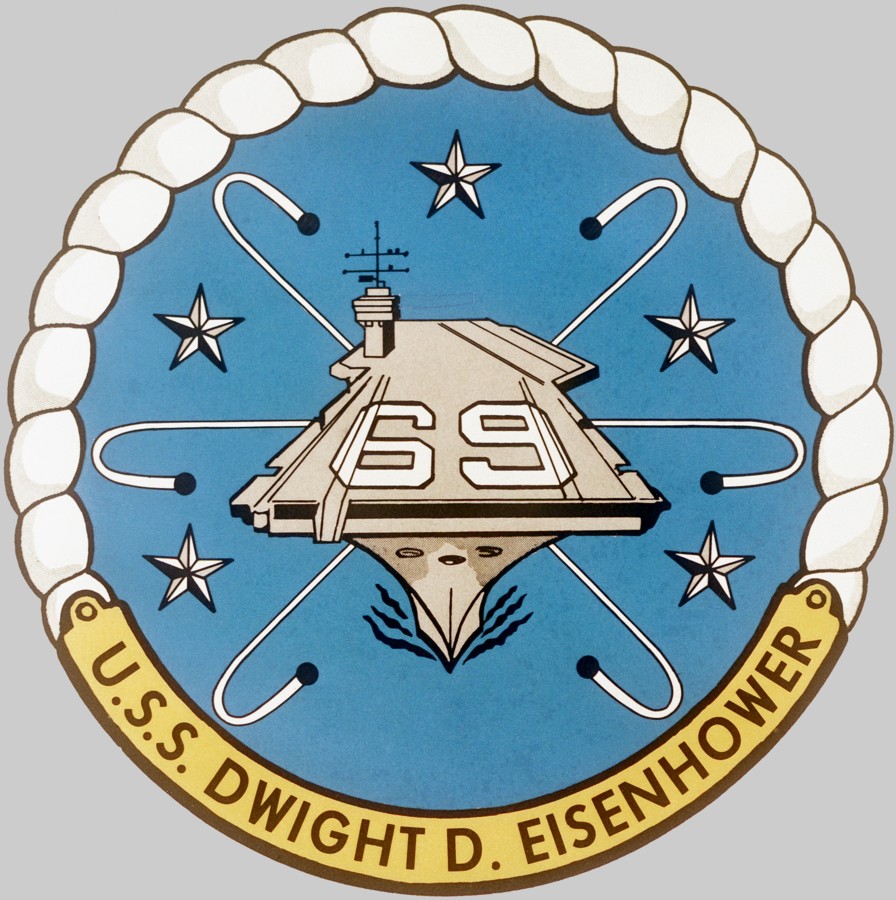 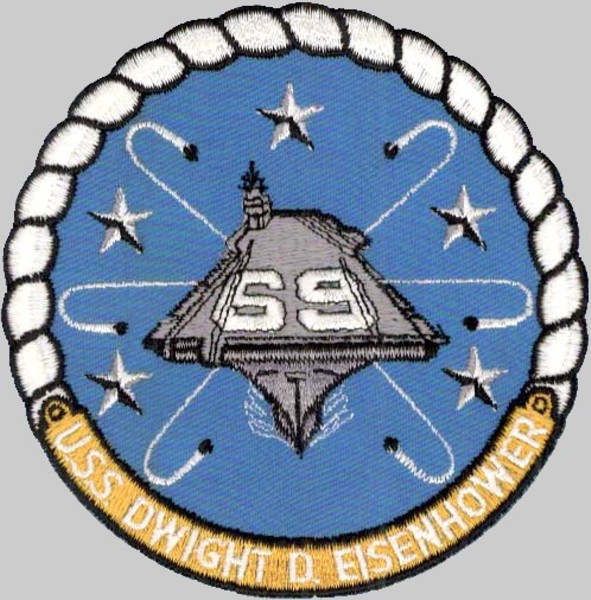 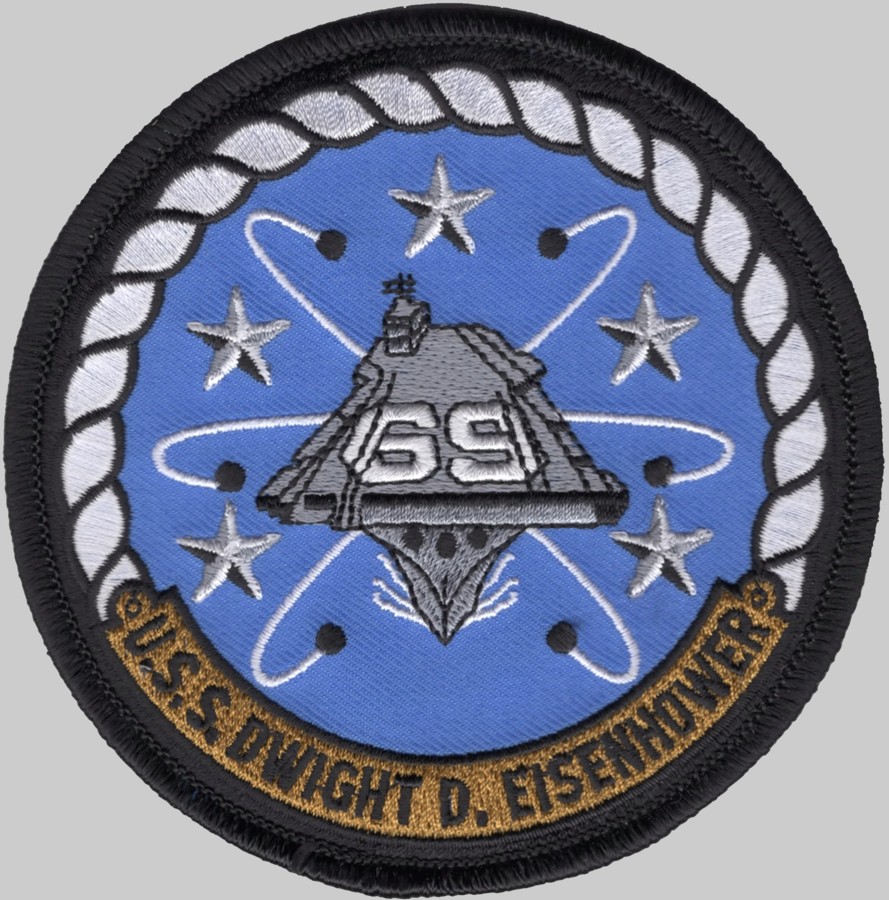 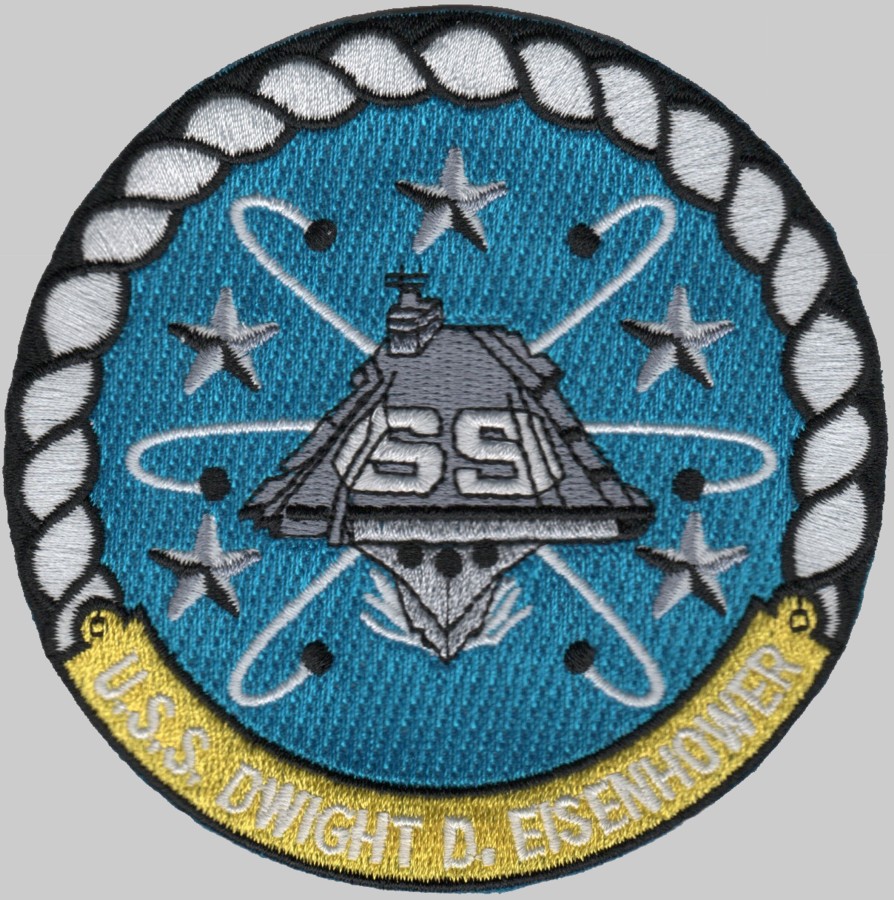 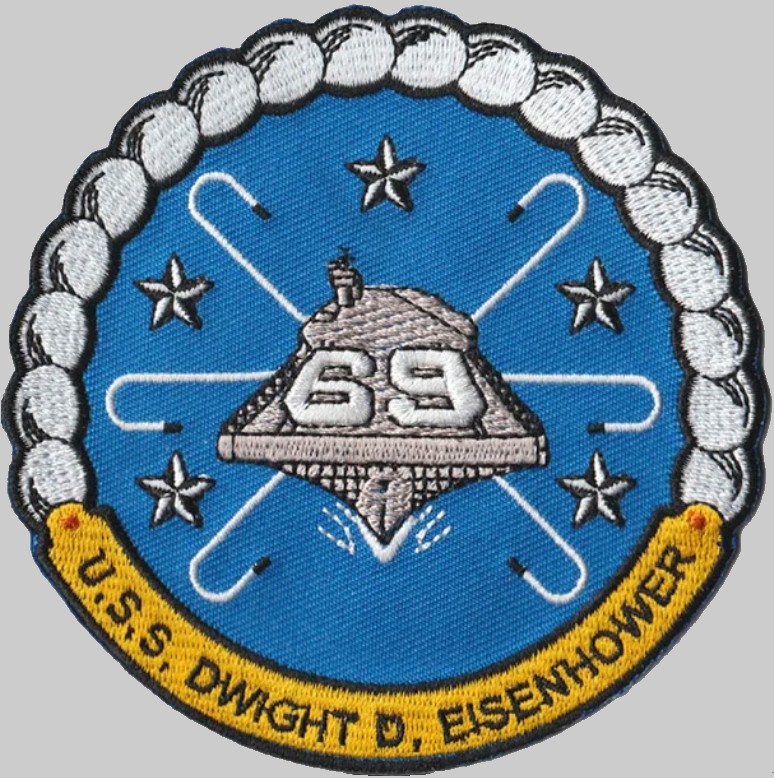 |
||
| | seaforces.org | USN ships start page | |